|
Newsletter
Seminar Material
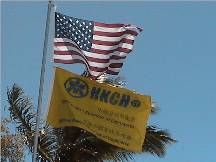



Biz:
China
Hong
Kong Hawaii


What people
said about us

China
Earthquake Relief
Tax &
Government
Hawaii Voter Registration
 Biz-Video
Biz-Video
 Hawaii's
China Connection Hawaii's
China Connection

 CDP#1780962
CDP#1780962

 Doing Business in
Hong Kong & China
Doing Business in
Hong Kong & China
| |
Biz Opportunities - China -
Partnership
with China Government Agencies
Do you know our dues
paying members attend events sponsored by our collaboration partners worldwide
at their membership rates - go to our event page to find out more!
 |
 |
Listen to MP3 “Business Beyond the Reef” to discuss
the problems with imports from China, telling all sides of the story and then
expand the discussion to revitalizing Chinatown -
Special Guest: Johnson Choi, MBA, RFC. President - Hong Kong.China.Hawaii
Chamber of Commerce (HKCHcc) and Danny Au, Manager, Bo Wah Trading |


 Shanghai World Expo 2010
http://www.expo.cn
http://en.expo2010.cn/
May 1 - Oct
31 2010 Share
Shanghai World Expo 2010
http://www.expo.cn
http://en.expo2010.cn/
May 1 - Oct
31 2010 Share



 Shanghai World Expo highlight Videos
on YouTube in Mandarin and Cantonese - it will give you a complete history of
World Expo including Shanghai World Expo Highlights - the information is very
helpful prior to your arrival in China
世博年漫遊長三角
Video#1A/1B
http://www.youtube.com/watch?v=chlK-rjWZVI
http://www.youtube.com/watch?v=vn6avEYY-qU
Video#2A/2B
http://www.youtube.com/watch?v=ZqStd1T0CVU
http://www.youtube.com/watch?v=nRK4mJQRvWg
Video#3A
http://www.youtube.com/watch?v=os7sk7c7PFQ
Video#4A/4B
http://www.youtube.com/watch?v=RDU7G4pFb8c
http://www.youtube.com/watch?v=U4qCs9_iMuc Video#5A/5B
http://www.youtube.com/watch?v=Zpn1nyDA5W4
http://www.youtube.com/watch?v=y4Fb30GW65o Video#6A/6B
http://www.youtube.com/watch?v=GdP-vGyNkHk
http://www.youtube.com/watch?v=s1Er_gD9iq0 Video#7A/7B
http://www.youtube.com/watch?v=x565IqgAlk4
http://www.youtube.com/watch?v=nBSOqiFAx2s Video#8A/8B
http://www.youtube.com/watch?v=7fkhSmwDRhg
http://www.youtube.com/watch?v=KgdKwJHhKRI Video#9A/9B
http://www.youtube.com/watch?v=MeR3F4PO980
http://www.youtube.com/watch?v=gzN00sgOax8 Video#10A/10B
http://www.youtube.com/watch?v=H-j7KCZUW0o
http://www.youtube.com/watch?v=FOkjesRMuH8 Video#11A/11B
http://www.youtube.com/watch?v=SEBZyeV3ydE
http://www.youtube.com/watch?v=a7nEgVBq6AQ Video#12A/12B
http://www.youtube.com/watch?v=l3WGE9eQj7A
http://www.youtube.com/watch?v=4rPPfmdjkJY
Video#13A/13B http://www.youtube.com/watch?v=5Ap8EFL6gjo http://www.youtube.com/watch?v=dR0nk6rCPUI Video#14A/14B http://www.youtube.com/watch?v=YVgbviB1Ueg
http://www.youtube.com/watch?v=JNWoygJAu5w
Video#15A/15B http://www.youtube.com/watch?v=yKlZi1MfvPo
http://www.youtube.com/watch?v=lzRFGDa4okU Video#16A/16B
http://www.youtube.com/watch?v=_AdFGwbwDc8 http://www.youtube.com/watch?v=veVq0Hv-8P4 Shanghai World Expo highlight Videos
on YouTube in Mandarin and Cantonese - it will give you a complete history of
World Expo including Shanghai World Expo Highlights - the information is very
helpful prior to your arrival in China
世博年漫遊長三角
Video#1A/1B
http://www.youtube.com/watch?v=chlK-rjWZVI
http://www.youtube.com/watch?v=vn6avEYY-qU
Video#2A/2B
http://www.youtube.com/watch?v=ZqStd1T0CVU
http://www.youtube.com/watch?v=nRK4mJQRvWg
Video#3A
http://www.youtube.com/watch?v=os7sk7c7PFQ
Video#4A/4B
http://www.youtube.com/watch?v=RDU7G4pFb8c
http://www.youtube.com/watch?v=U4qCs9_iMuc Video#5A/5B
http://www.youtube.com/watch?v=Zpn1nyDA5W4
http://www.youtube.com/watch?v=y4Fb30GW65o Video#6A/6B
http://www.youtube.com/watch?v=GdP-vGyNkHk
http://www.youtube.com/watch?v=s1Er_gD9iq0 Video#7A/7B
http://www.youtube.com/watch?v=x565IqgAlk4
http://www.youtube.com/watch?v=nBSOqiFAx2s Video#8A/8B
http://www.youtube.com/watch?v=7fkhSmwDRhg
http://www.youtube.com/watch?v=KgdKwJHhKRI Video#9A/9B
http://www.youtube.com/watch?v=MeR3F4PO980
http://www.youtube.com/watch?v=gzN00sgOax8 Video#10A/10B
http://www.youtube.com/watch?v=H-j7KCZUW0o
http://www.youtube.com/watch?v=FOkjesRMuH8 Video#11A/11B
http://www.youtube.com/watch?v=SEBZyeV3ydE
http://www.youtube.com/watch?v=a7nEgVBq6AQ Video#12A/12B
http://www.youtube.com/watch?v=l3WGE9eQj7A
http://www.youtube.com/watch?v=4rPPfmdjkJY
Video#13A/13B http://www.youtube.com/watch?v=5Ap8EFL6gjo http://www.youtube.com/watch?v=dR0nk6rCPUI Video#14A/14B http://www.youtube.com/watch?v=YVgbviB1Ueg
http://www.youtube.com/watch?v=JNWoygJAu5w
Video#15A/15B http://www.youtube.com/watch?v=yKlZi1MfvPo
http://www.youtube.com/watch?v=lzRFGDa4okU Video#16A/16B
http://www.youtube.com/watch?v=_AdFGwbwDc8 http://www.youtube.com/watch?v=veVq0Hv-8P4
 Shanghai World Expo Pictures
on Facebook
http://www.facebook.com/album.php?aid=108961&id=562941983&l=d01c8a8eda
Shanghai World Expo Pictures
on Facebook
http://www.facebook.com/album.php?aid=108961&id=562941983&l=d01c8a8eda
Thing to do in Shanghai
by our Director Yen Chun
http://www.hkchcc.org/shanghai.pdf
- information deemed reliable but
not guaranteed (the $ listed on the tour guide is Chinese $Yuan US$1 = 6.8
$Yuan)
http://www.b2bchinadirect.com/shanghaibiz.htm
 AmCham Shanghai launches latest Viewpoint - U.S. Export
Competitiveness in China - on the 2010 Washington, D.C. Doorknock - Please
download report in PDF format:
http://www.hkchcc.org/viewpointusexport.pdf
AmCham Shanghai launches latest Viewpoint - U.S. Export
Competitiveness in China - on the 2010 Washington, D.C. Doorknock - Please
download report in PDF format:
http://www.hkchcc.org/viewpointusexport.pdf
成功之道
武进制造 Wujin
- Changzhou - Jiangsu Province - China http://www.hkchcc.org/wujin.htm
 China President Hu Jintao USA State Visit
January 19 - 21 2011 http://www.b2bchinadirect.com/hujintaousavisit.htm China President Hu Jintao USA State Visit
January 19 - 21 2011 http://www.b2bchinadirect.com/hujintaousavisit.htm
 USCBC Special Report: Hu Jintao State Visit USCBC Special Report: Hu Jintao State Visit
November 15 2011 Share
Amy Tan on China, Then and Now - the divide between China and America through novels that examine the emotional minefields of families and the clashes that come from cultural misunderstandings
By Debra Bruno
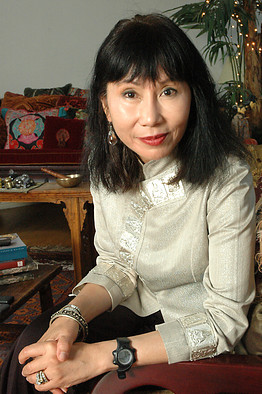
Novelist Amy Tan has spent most of her life examining the divide between China and America through novels that examine the emotional minefields of families and the clashes that come from cultural misunderstandings.
Now the writer — whose novels “The Joy Luck Club,” “The Kitchen God’s Wife” and “The Bonesetter’s Daughter” all tackle the conundrum of Chinese-American identity — is applying her perspective on that divide to this week’s U.S.-China Forum on the Arts and Culture.
Ms. Tan reflected on what she hopes will come of the forum, and what it means to be an American with emotional connections to China.
What do you think of China today?
It’s unbelievable. What strikes me as funny, though, is how many people in the U.S. still believe it’s so repressive that you can’t carry a camera around. I tell them the biggest danger is that someone will try to sell you a cheaper camera. They think it’s hard to do anything. They think of it as Shangri-la, with Byzantine ways to get around. They ask me, how do I come here? You take a flight. There’s a knowledge gap in the U.S.
What was it like the first time you visited China?
It was in 1987. Pudong and the Shanghai skyline were unbuilt. You look at the skyline now, it’s unbelievable. It’s a symbol of the degree and rapidity of change.
At a certain point, China seemed to have changed every six months. But I don’t come here often enough to keep abreast (of the changes). When I came in ’87, there were no private cars, just those for government officials. Everyone used a bicycle. The streets were just filled with bicycles and carts and these Stalinist-patterned trucks.
When I met my sisters (Tan’s mother had left children in China when she emigrated), they were wearing very bland blue suits, kind of a transition between the old blue uniforms. My uncle was wearing a nice tan wool Mao jacket; he looked very dignified.
Your mother plays such a large role in everything you write. What do you think your mother would think of today’s China?
She would say, “Maybe I could live here part-time.” She used to threaten me, “Maybe I go back to China — you don’t care.” When we were here together (in 1987), she focused on the cleanliness. She came and stayed for a couple of months. But now she would have been complaining about the prices.
Would you say you’ve spent your career bridging the gap between the U.S. and China?
At the beginning of my career as a writer, I felt I knew nothing of Chinese culture. I was writing about emotional confusion with my mother related to our different beliefs. Hers was based in family history, which I didn’t know anything about. I always felt hesitant in talking about Chinese culture and American culture.
Listen, I am an American, steeped in American values. But I know on an emotional level what it means to be of the Chinese culture.
You’re on a panel with Yo Yo Ma. What do you hope will come of the conversation?
I think it will be interesting to those of us with the forum, for one thing. We’ll have our eyes opened to how we view art and culture. But for the Chinese people on the panel and audience, it will be more, because they’ll open the eyes of the American side.
I think many in the States think Chinese people have no voice whatsoever, no means of expressing themselves. I think the forum participants are more knowledgeable, but I think they will be surprised at the degree of the individuality of the art.
Do you think the question of censorship will come up?
Chinese artists have been subversive over thousands of years, taking what they think of the government and embedding it in their art. There might be censorship of not going as far as they might.
But the thing that people don’t realize when they criticize the government is that the consequences are not necessarily good. They do not necessarily lead to positive change on this side. I’ve heard people say, “They must be listening to us because they just increased the sentence of an artist.” But that’s not a good outcome.
That’s why I’m happy to be part of a group like this. [Director of the Asia Society’s Center on US-China Relations] Orville Schell (one of the principal organizers of the conference) understands this; he said that the relationship has to move beyond a lack of trust and build on something more constructive. But it’s not starting with the most controversial or abrasive.
When I think of building relationships, I use my mother as a metaphor. If I disagreed with her, would yelling at her lead to any kind of change? No. Would building a relationship? Yes.
Speaking of your mother, we’re approaching the anniversary of her death. Do you mark the occasion?
We have the family over, and it’s always around Thanksgiving. We make potstickers and criticize them. We say, “no one could make them as she did.”
But for me, it’s not just once a year. She’s in my mind all the time. I hear her voice every day.
October 13 2011 Share
United State's reality gap on trade deficit - about US$10 to firms who assemble the iPhone in China
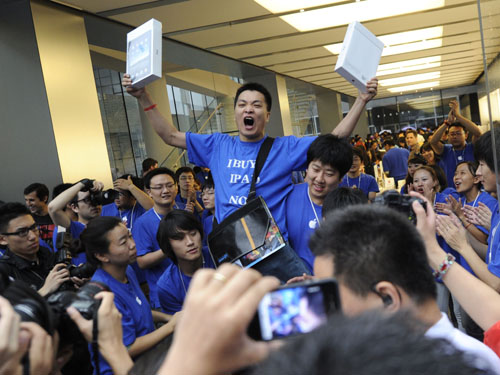
A student holds up Apple iPads outside Apple's flagship store in Beijing. The impact of the yuan on trade is under scrutiny.
Economic arguments may have little impact in Washington, but US efforts to put pressure on China are unlikely to create American jobs.
For every Apple iPad sold in the US, that nation's trade deficit with China increases by about US$275.
Yet by far the most value embedded in the device accrues to Apple and sustains thousands of well-paid design, software, management and marketing jobs in the United States.
By contrast, the value captured in China by the laborers who assemble Apple's products is only about US$10 or so, according to researchers led by Kenneth Kraemer of the University of California, Irvine, who collated the data.
Viewed through this prism, offshore manufacturing of electronic products such as the iPad is a solution, not a problem, for the US, and seeking to punish China for its purportedly undervalued exchange rate is wide of the mark.
"Without China, Apple could not be so successful and Apple products would not be so affordable," Yao Shujie, professor of economics at the University of Nottingham in England, said.
In the case of the iPad, China is the final assembly point for components imported from economies including South Korea, Japan, Taiwan, the European Union and the US. There are no Chinese suppliers for the iPad.
"China is sitting in the middle. It is processing goods for rich countries," Yao said. As such, he argued, it would be more accurate to allocate most of China's bilateral "iPad trade surplus" to those supplier countries.
Kraemer agreed that trade data could mislead as much as inform.
Statistical agencies are working on more accurate breakdowns of the origins of traded goods by value added, which would be attributed based on the location of processing, not on the location of ownership, he said.
"This will eventually provide a clearer picture of who our trading partners really are, but, while this lengthy process unfolds, countries will still be arguing based on misleading data," Kraemer and fellow authors Greg Linden and Jason Dedrick said in a recent paper.
Such economic niceties have little impact on US politicians. The US Senate on Tuesday passed a bill aimed at getting China to raise the value of the yuan in an effort to save American jobs. The legislation now heads for the House of Representatives, where its fate is uncertain.
The bill would allow the US government to impose duties on products from countries found to be subsidising their exports by undervaluing their currencies.
Fred Bergsten, director of the Washington-based Peterson Institute for International Economics, reckons a US$100 billion improvement in the US current account deficit would translate into 600,000 jobs.
But Fredrik Erixon, director of the European Centre for International Political Economy, a think tank in Brussels, said America's trade deficit had deep demographic and other structural roots. As such, even a substantial rise in the yuan would lead to only a marginal increase in US jobs.
"Multinational firms that think currency appreciation is going to have a big effect on their export capacity from China to the United States are going to shift to other countries, not to the United States," he said.
Indeed, manufacturers are already abandoning low-margin sectors in response to the steady rise in the yuan, which is up 30 per cent in nominal terms against the US dollar since 2005, plus fast-rising costs for labour, land, energy and other inputs.
Jonathan Anderson, chief emerging-markets economist for UBS in Hong Kong, said US and EU trade data showed that China's share of total low-end light manufacturing imports had peaked over the past 24 months and was falling outright in the US.
Gaining at China's expense were its even cheaper neighbours, including Vietnam, Bangladesh and Indonesia, as well as Mexico, Anderson said.
Strikingly, while overall US imports of apparel and furniture have continued to increase over the past two years, domestic production has plummeted. Foreigners have gained, not lost, market share.
Anderson said it made perfect sense that US workers were not the beneficiaries of rising Chinese wages.
"If US$300 per month for a 65-plus hour working week is too rich for, say, basic toy manufacturers, do they go to the US and pay US$1,200 a month plus benefits for a 40-hour week at the minimum wage, or do they go to Bangladesh or Cambodia, where workers put in Chinese-style hours for less than US$100 a month?" he wrote in a recent report.
Only by forcing a massive rise in the yuan or imposing implausibly high tariffs could such a cost gap be closed. The threat of trade and currency wars, which is likely to be a refrain at this weekend's meeting of Group of 20 finance ministers in Paris, could then become a reality.
"The gradual concentration of electronics manufacturing in Asia over the past 30 years cannot be reversed in the short to medium term without undermining the relatively free flow of goods, capital, and people that provides the basis for the global economy," Kraemer, Linden and Dedrick wrote.
They said they did not want to imply that there was no hope for US manufacturing, but it was design, computing and marketing, not snapping a moulded plastic case in place, that created high-wage jobs. In any case, Mexico could handle final assembly at a relatively low cost.
"Bringing high-volume electronics assembly back to the US is not the path to `good jobs' or economic growth," they wrote.
September 19 2011 Share
How foreign shores lost their luster? Many Chinese who have been educated and lived abroad return to the motherland - some affected by the September 11 attacks, others by the bad economy
By Ed Zhang in Beijing

Many Chinese who have attended graduate school and worked in the West are moving back to their homeland to start up their own enterprises or serve international companies. They are commonly called haigui, literally "sea turtles", or overseas returnees.
Some from the United States carry with them the memories of the September 11 terrorist attacks 10 years ago, as well as a deeper and more complex understanding of their former host country.
Eugene Sun, a corporate communications consultant, said that even though he and his family moved back to his hometown of Beijing six years ago, he still missed New York.
"That's why we got our apartment near the Chaoyang Park. It makes me feel as if we're overlooking Central Park," he said.
His return was partly because of September 11, Sun said, calling the US Patriot Act, passed a month after the attacks, "a reproach to democracy". The law led to a tightening of immigration controls in the US.
"To think that one man could screw up the strongest country in the world like this," he said, referring to Osama bin Laden.
Sun was a day trader back then. He was on a cigarette break with a Russian friend near their office a few blocks from the Empire State Building when they saw the first World Trade Centre tower collapse.
Xiao Yan agrees that September 11 changed everything. Xiao, who now works for an international financial services company on the mainland, said tighter immigration policies and cuts in financial aid made things difficult for foreign students for a time.
But Joe Xia - working for the New York edition of a Hong Kong-based Chinese-language newspaper at the time - said the damage from September 11 was only on the surface.
"It produced a great visual impact, an effective piece of propaganda work," said Xia, now working in the energy industry in Beijing.
"The aftermath was only brief, by which you could tell that [the US] was a very strong and resilient society - with strong industry and creative people."
In fact, he said, nothing had harmed the US more than the "reckless behavior of Wall Street" - referring to the toxic securities that led to a global financial meltdown and the subsequent government bailouts, in which the public paid for losses incurred by a few people.
Xia returned to China only recently, partly because of the rapid change in the media industry and partly because of the 2008 recession, he said.
In contrast, Daniel Hu made up his mind to return to work in China a long time ago.
"From the time of the Oklahoma City bombing [on April 19, 1995], I learned how they would treat foreigners, even in primary school," he said. "For days, people thought the suspect must be some sort of foreign die-hard, and even kids in our school were separated into different groups - American kids, Muslim kids, non-Muslim foreign kids.
"Then it turned out that the suspect was just a local man. And it turned me off so much. Anything happens, they blame foreigners. And bin Laden was just smart in using this to lure the US into fighting two costly wars and not attending to their own economy."
Hu is now between jobs after working for a state-owned company for three years.
For most Chinese returnees, the primary reason for coming home is economic opportunity. That was why the emigration wave did not crest right after September 11, but only after the economy showed danger signs.
There are two career tracks for the most successful returnees: They either work in universities, or for the China operations of a reputable international company.
Wang Shufeng, a chemical physicist, said he was satisfied with working at a top-notch university in China. He has a laboratory, students, assistants and grants from the government.
"I have no problem with any of these," he said, although he acknowledged that he was still at a loss in dealing with all of the red tape.
Among the 86 candidates listed this year for membership of the Chinese Academy of Science, 71 have had overseas educational and work experience and 30 obtained their doctorates at universities in other countries.
Xu Heng, who works for a leading international firm in Beijing, said that when she graduated in the US, it was obvious that the job market there had dried up and China still had plenty of opportunities. "The horizon for personal development looks much broader here," she said.
Partly because of the economic difficulties in the US, more than 80 per cent of returnees say they believe there are more business opportunities in China right now, according to
www.People.com.cn, a subsidiary of the official People's Daily.
Figures from mainland education authorities show that from 1978 to last year, 1.9 million students went abroad, in contrast to only 130,000 during the previous 106 years.
The number returning to China after their study overseas increased steadily in the mid-2000s, from fewer than 34,900 in 2005; to 70,000 in 2008; 100,000 in 2009; and 135,000 last year.
Because of relaxed student-visa policies and an increase in domestic household incomes in recent years, the number of outbound students has also seen a marked increase, from 229,000 in 2009 to 285,000 last year, official media reported.
For returnees, the welcome mat is out. The government is eager to recruit more overseas-trained professionals for its 12th five-year plan. It hopes to draw half a million or more returnees for the whole period, said Xia Wenfeng , an official familiar with "returnees' affairs" at the Ministry of Human Resources and Social Security, during a meeting of the Western Returned Scholars Association late last month.
The government aimed to recruit returned scholars for a few priority areas, including in new technologies, regional development, agriculture and social
programs.
September 9 2011 Share
Hiring employees from Hong Kong, Macau amd Taiwan for your China operation will save you 37% Social Security Tax
By Daniel Ren
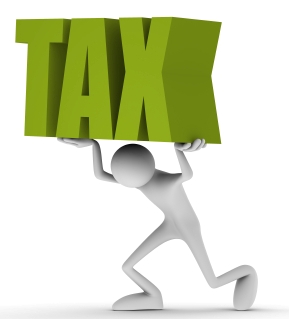
Hongkongers may dodge new tax after U-turn - Mainland bosses could be stung for 37 per cent of expat salaries but Chinese nationals from HK, Macau and Taiwan likely to escape social security payment.
Chinese nationals from Hong Kong, Macau and Taiwan are likely to be exempt from the mainland's new social security tax going into effect next month. But all expats from countries that have not signed bilateral agreements with Beijing will have to pay up to 11 per cent of their income to social security funds.
Employers will be required to pay an extra 37 per cent of a foreign employee's salary to the social security accounts under the rule published by the Ministry of Human Resources and Social Security.
The new rule represents an about-face by Beijing, which previously planned to apply the tax to residents from Hong Kong, Macau and Taiwan. Two people who saw a draft copy of the rule said the ministry deleted the clauses involving residents from the three places in the final version. The ministry could not be reached for comment yesterday. "It's not clear why the rule was revised to exempt the Hong Kong workers," said one corporate official who is close to the regulators.
"But the authorities have to clarify many details of the new policy since the impact will be huge on thousands of companies."
The rule will take effect on October 15.
It is unknown whether non-ethnic Chinese who obtained ID cards in Hong Kong are exempt from the tax.
At least 10 countries - including the United States, Japan and Russia - have lobbied Beijing to sign bilateral agreements so that the rule could contain a waiver for their passport holders.
The ministry did not mention which countries had already signed the pacts.
Before, foreigners and Hong Kong people working on the mainland could voluntarily pay social security tax to local accounts if they hoped to receive pension income from the mainland accounts after retirement. The new rule "is designed to protect the legal rights of the foreigners so that they can benefit from the domestic social security system", the ministry said.
However, businesses and individuals thought otherwise.
"It doesn't seem to be a well considered rule," said David Lore, an American journalist who has been working on the mainland for more than a decade. "My concern is that our money would go into somebody's pockets."
All of the company officials interviewed by the South China Morning Post (SEHK: 0583, announcements, news) were critical of the new rule and said they were confused about the motivations behind the policy.
"This is another fresh example of the Chinese government spoiling the business environment for foreign businesses," said a human resources officer with a British consultancy. "We would choose not to abide by it initially since there's no mention of a penalty in the rule."
Hu Jingjing, a corporate lawyer at state-owned recruitment firm China International Intellectual Shanghai, said: "The rule will certainly have a negative impact on both domestic and foreign companies."
September 6 2011 Share
China to Overtake Japan in Luxury Demand
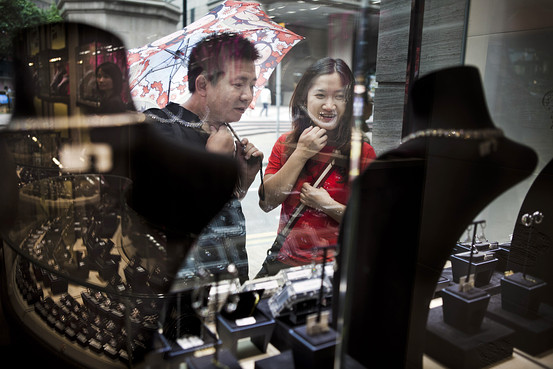
Shoppers look at an Emperor Watch & Jewellery display in Hong Kong.
China’s consumers are pushing the nation to the top once again.
It will overtake Japan this year to be the country with the biggest appetite for luxury goods, HSBC predicts in a research report issued late last week. The broker said that it expects China’s consumers to keep spending, even if their affluent counterparts in the West stop.
The reasons are, at least in part, cultural. “Displaying wealth has become a trend in China, and we think this will continue to translate into growing purchases of luxury goods for oneself, or as gifts,” HSBC said. “We think consumer habits may not necessarily always correspond to income levels due to the need to socially fit in and show off wealth.”
It added a historical note: “In Chinese and Russian communist societies, individual property was not allowed and private wealth was traditionally suspicious. With the liberalization of the economy, a new class system was created where your place on the ladder may depend on how much money one earns, and owning luxury goods can help display the level of one’s wealth.”
Social changes occurring around the world, such as people marrying later, women’s growing financial independence and increasing brand awareness, may also be fueling the growth in China, HSBC said.
Aug 31 2011
Hong Kong: China’s RMB Center
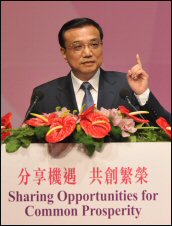
Speaking at a forum on China’s 12th Five-Year Program, China’s Vice Premier of the State Council Li Keqiang unveils new economic initiatives to strengthen Hong Kong’s developing role as the mainland’s renminbi
center
Beijing has unveiled a raft of new economic measures to boost Hong Kong’s status as an international financial centre, and help Hong Kong companies gain a stronger foothold into the Chinese mainland market. The mainland’s Vice Premier of the State Council Li Keqiang announced the latest Central Government initiatives during a visit to Hong Kong earlier this month.
Mr Li said it was in the interests of all concerned that Hong Kong continue “to bring out the unique advantages it has developed over the years and play its irreplaceable role in the mainland’s reform, opening-up and
modernization drive.”
The new initiatives will further open up the mainland market to Hong Kong’s services industry. It will also upgrade Hong Kong’s standing as an international financial capital, expanding Hong Kong’s role as an offshore renminbi centre.
Green Light for Mainland Equity Investors
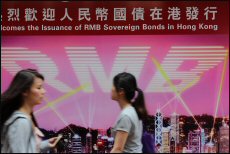
More mainland companies will be allowed to sell renminbi bonds in Hong Kong under new measures announced by the Central Government
Of the measures unveiled, 12 are related to financial services and the development of the offshore renminbi market. One will allow mainland investors to invest in Hong Kong stocks through the long-awaited index-tracking Exchange Traded Fund, which will be launched this year. Another scheme, allowing companies to settle trade in renminbi in 20 provinces, will be expanded nationwide.
More mainland companies will also be allowed to sell renminbi bonds in Hong Kong. Mr Li, during his visit, officiated at the launch of the third issuance of Rmb20 billion worth of mainland sovereign bonds in Hong Kong, the largest to date.
Industry representatives believe the move will reinforce Hong Kong’s role as China’s renminbi centre. “Encouraging more mainland enterprises to issue yuan bonds in Hong Kong will help diversify yuan-denominated products in the city,” Standard Chartered Bank (Hong Kong) Chief Executive Benjamin Hung was quoted in The Standard, a Hong Kong daily newspaper.
“China is speeding up its pace of internationalising the currency by these new measures,” Andrew Fung, head of treasury and investment at the Hang Seng Bank, told the South China Morning Post. “Most importantly, the Vice-Premier has confirmed Hong Kong’s role as an offshore yuan trading centre for China.”
Free Trade by 2015
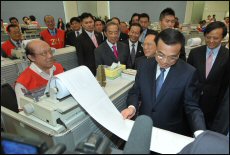
Vice Premier Li Keqiang checks out the day’s trading results during a visit to the Hong Kong Stock Exchange
In addition, the latest supplement of the Hong Kong-mainland Closer Economic Partnership Arrangement, expected to be signed in October, will broaden Hong Kong’s access to mainland services industries. “The target is to realise free service trade with Hong Kong by the end of the 12th five-year period,” Mr Li said at a Hong Kong forum on China’s 12th Five-Year
Program. Sectors to be opened up include banking and insurance, allowing Hong Kong companies to set up across the border.
“Taken as a whole, this comprehensive range of new measures will provide substantial opportunities across a wide spectrum of Hong Kong business activity,” said Hong Kong Chief Executive Donald Tsang. “This will help us maintain economic growth at a time when global economic conditions are fragile.”
Services Advantage
Financial Secretary John Tsang said that moves to open up the mainland services industry offer huge advantages to Hong Kong companies. He noted that Hong Kong’s services industry makes up 93 per cent of the city’s GDP.
“China lags far behind developed countries by 20 per cent, where the service industry on average accounts for about 70 per cent,” he said. “For those companies that want to tap the mainland’s market and help lift the industry standards higher, there is a huge and long-term opportunity for Hong Kong, as the services sector is one of our strengths.”
August 13 2011
New US envoy Locke aims to cement ties - Internet users amazed at low-key arrival in Beijing of first Chinese-American ambassador
By Zhuang Pinghui

America's new ambassador to China, the first Chinese-American to hold the critical post, has arrived in Beijing amid speculation on how the new envoy will promote mutual trust while handling the many differences between the two countries.
Speaking at Beijing airport (SEHK: 0694) late on Friday night, Gary Locke expressed his excitement at taking up his new assignment and was confident he would be good bridge between the two nations.
"I am very excited to be here as US ambassador to the great country of China. The whole family is excited," said Locke during an interview with China Central Television. "The US and China have many areas of co-operation and great opportunities to improve our relations."
He said he would present his credentials and visit schools yesterday.
Locke's flight to Beijing itself has become an online sensation, with many internet users amazed that one of America's most important diplomats was seen flying in economy class, with no bodyguard or entourage and carrying his own luggage.
An internet user at weibo.com, Tang Zhaohui , a technology businessman, said he was standing in queue for coffee behind Locke at Seattle airport when the ambassador, who was carrying a backpack, handed what appeared to be a voucher to the cashier who later told Locke it could not be used.
"He didn't give the ambassador any face at all," Tang said. "But the ambassador wasn't angry and paid with his credit card instead." Tang posted a photo Locke at the coffee lounge online.
Locke's family were also seen on television carrying their own luggage.
Almost 7,000 internet users left comments at Tang's photo, with most praising the Locke's down-to-earth style.
Some joked that the ambassador, previously the US secretary for commerce and a former governor of Washington state, looked more like a petitioner in Beijing than "a typical township official from China who would be taking a far more extravagant trip than this".
Some also warned about holding too high expectations of Locke that, despite his Chinese roots and appearance, was an American who would stand up for the interests of his country.
The state-owned media welcomed Locke with reports urging him to help "rebuild" America's financial reputation.
"Amid the concerns over the gloomy economic future of the US, it is Locke's responsibility to relieve anxiety in China towards US debt after the downgrade of US government's credit rating," reported China Daily, citing Zhou Qi, a top researcher at the Chinese Academy of Social Sciences.
By far America's largest foreign creditor, China held US$1.16 trillion in US debt in May.
Locke has his work cut out for him, but boosting the credibility and stability of US debt and minimising the side effects brought by the US' recent credit rating downgrade were certainly important.
August 2 2011
United States has much to gain from China: Gary Locke - the new US ambassador to China
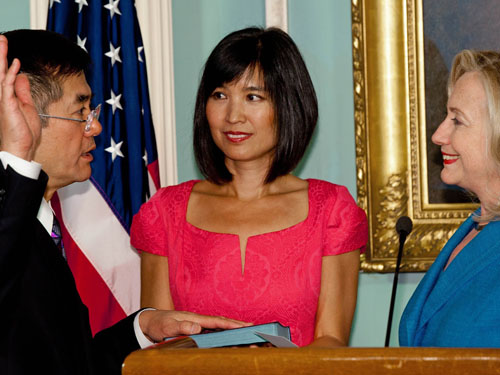
Hillary Rodham Clinton swears in former commerce secretary Gary Locke as the first Chinese-American US Ambassador to China
Gary Locke on Monday formally resigned as United States commerce secretary and became the new US ambassador to China, promising to reap benefits from a difficult and sensitive bilateral relationship.
Sworn in by US Secretary of State Hillary Rodham Clinton, who alluded to the challenges he will face, Locke, the first Chinese-American to hold the prestigious post, said both countries had much to gain from each other.
Locke said he would continue co-operative work to curb climate change, seek cleaner sources of energy and stop nuclear proliferation, as well as efforts he pursued as commerce secretary to open Chinese markets to US goods and services.
The new envoy succeeds Republican former Utah governor Jon Huntsman, who left Beijing three months ago to run against former boss, US President Barack Obama, in next year's election.
Locke also vowed to manage areas where he said the two countries have "differences" or "serious disagreement". These include Beijing's export-driven economic policies, and growing military spending.
Locke, 61, takes over at a time of tensions in U.S.-China relations, which have been fraught over a range of disputes including Beijing's export-driven economic policies, growing military spending and human rights record.
The two countries also have differences over U.S. arms sales to Taiwan, U.S. support for Tibet and China's pursuit of claims over potentially resource-rich islands in the South China Sea.
“I will work to keep the lines of communication open, to convey the administration's positions clearly and to engage with Chinese government officials at the highest levels,” Locke said, referring to “sensitive” areas.
He also hoped “to do more to communicate directly with the Chinese people to improve understanding between our two great nations.”
In May, Obama nominated John Bryson to serve as the next commerce secretary. Pending his confirmation, acting deputy commerce secretary Rebecca Blank will serve as acting commerce secretary.
In a Commerce Department statement announcing his resignation as commerce secretary, Locke touted what he said were increased exports, a reduced backlog for patent applications and a first step toward reforming export controls.
July 27 2011
Branding on the Mainland China

Alex Lau, Manager of the Intellectual Property Center at the Federation of Hong Kong Industries, is an IP advisor to the Hong Kong Trade and Industries Department. He recently spoke at a China Business Workshop,
organized by the Hong Kong Trade Development Council, on how to brand on the Chinese mainland.
What are the first steps for an enterprise that wants to set up on the Chinese mainland?
If you want to do business on the mainland, the first thing is to get a registered trademark and a registered domain name. The three: product, brand and trademark, should be one.
Companies should think of developing different brands if one brand has already been well accepted. Doing so increases the chance of being remembered and helps the company gain market share. It also raises the bar for other companies entering the market. Many such examples abound, including P&G, which has developed different hair-care brands under the names: Rejoice, VS Sassoon, Pantene Pro-V, Head & Shoulders, Wella and Clairol, to meet the diverse needs of consumers and to target different customers.
When does trademark ownership take effect on the mainland?
The protection of intellectual property is such an important issue including on the mainland. Due to different rules and regulations, trademark ownership is decided based on the time the brand was registered. In Hong Kong, trademark useage takes effect immediately. You are allowed to use the trademark before registering it. But on the mainland, a trademark is allowed to be used only after registration and if no other companies have registered the trademark before.
It also usually takes three months for a trademark to get registered in Hong Kong whereas on the mainland, it could take up to three years. If a company has no trademark, the brand name should be unique enough to stand out from others. Names such as Kodak and Revlon were especially designed in order to create brand awareness in a shorter period of time.
What are some of the little-known details businesses should be aware of when registering a trademark on the mainland?
The Nice Agreement is a classification of goods and services for the purpose of trademark registration, which has become international
practice since 45 classes were identified in France in 1957. It’s extremely important for applicants to specifiy what classes their trademarks belong to when planning to register.
Sometimes you get a situation when company A registers a trademark for classes 1 to 10, and company B registers the same trademark for classes 11 to 20. If that’s the case, it takes a great amount of time for the companies to succeed in the market. That’s why a trademark should always come with a suitable market strategy for brand promotion.
What are some of the pitfalls?
Businesses on the mainland should stay vigilant to all the products they sell under the trademark because they would be held accountable if there are quality concerns even in just one of the products.
A successful brandname does not come overnight. For example, McDonald’s slogan “I’m loving it” did not take off until 2006 after a three-year advertising campaign. And it took nearly a decade for Nokia’s “Connecting People” and Apple’s iPhone to start becoming household names.
What specific advice do you have for would-be franchisers and licensors?
Franchising and licensing are common strategies for companies to expand on the mainland. A franchisor or a licensor would be responsible for the quality of the products sold by their franchisees or licensees, which is clearly stated by mainland rules and regulations. However, these rules do not apply to franchisors or licensors in Hong Kong. The Chinese Trademark Law has clear provisions regarding this. There are other relevant provisions on other aspects regarding quality inspection and control, consumer protection and fair competition.
Are there any other unique rules specific to trademark registration?
Language is important. It is crucial to assign a Chinese name for an English brand when it comes to registration, because there could be homophonic Chinese names already in use.
Companies also need to pay attention to time limits on the mainland. For instance, a company might lose a registered trademark if it has been inactive for three consecutive years; and companies with a well-known trademark can’t sue a similar trademark for infringement if no action was taken within five years.
July 19 2011
Trading Progress With Beijing - The global trading system incentivized China to drop its "indigenous innovation."
If there's one bright spot in a financially unstable world, it's that the international trading system is proving more resilient. China won a World Trade Organization Appellate Body ruling on EU-imposed antidumping measures last week. And earlier this month Beijing avoided a possible WTO complaint and voluntarily rolled back measures that restricted foreign competition in its domestic markets.
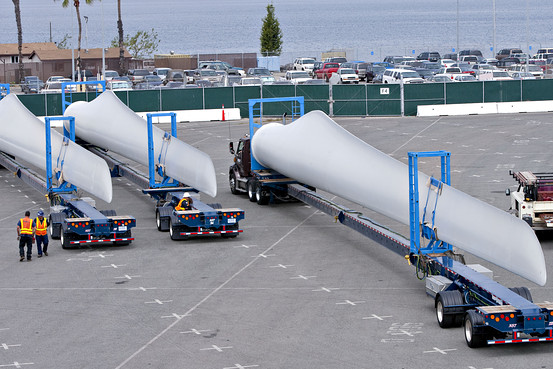
Blades for wind turbines manufactured for Tang Energy Group in China are off-loaded for delivery to Tooele Army Depot in Tooele, Utah, at the Port of Long Beach, California, U.S., in 2010.
China eliminated three "indigenous innovation" rules that gave domestic companies preferential treatment to government contracts. During his visit to Washington in January, President Hu Jintao pledged to eliminate the protectionist rules, and Beijing carried through on that promise. However, the true test of whether this protectionist episode is in the past will be how the new policy is implemented at the local level.
The idea of promoting indigenous innovation surfaced in 2006, as Beijing directed several government agencies to come up with laws which would promote domestic products and technologies. This expanded into a regulatory framework that gave those domestic companies deemed sufficiently innovative access to tax benefits, financing, priority in receiving government contracts and other forms of preferential treatment.
The biggest component of "indigenous innovation" policies deals with the government procurement market. The American and European Chambers of Commerce in Beijing complained these polices shut out foreign companies from business with government at all levels. With three of the most irritating rules removed, foreign businesses are encouraged but warn not all their concerns have been allayed.
Among the biggest questions is how local governments will respond. City and provincial governments account for the bulk of the government procurement market. While the central government's Ministry of Finance has directed the changes at them, local government bureaucrats and politicians may still favor local companies when making purchasing decisions.
Many local governments have set up product catalogues which determine what they can buy, and these catalogues are now made up almost entirely of domestic products. The US-China Business Council found that of 523 products listed in Shanghai's "indigenous innovation" catalogue, just two were made by foreign companies. China has yet to direct local governments to eliminate these catalogues, which constitute a major barrier to foreign companies obtaining access to the government procurement market.
The Commerce Ministry expressed its satisfaction Saturday with its antidumping win at the WTO. That victory is a reminder that respect for trade agreements benefits all countries, but arguably none more than China. Beijing has plenty of incentive to make sure local governments live up to Mr. Hu's promises, and not to embark on more programs that let the protectionist genie out of the bottle.
July 18 2011
How to Marry Rich in China By Robert Frank
With wealth comes gold-diggers, and China now has a bounty of both.
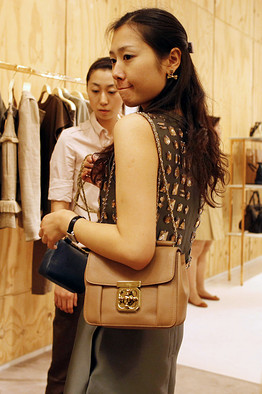
Chinese now can learn how to shop for millionaires and billionaires.
A new school called in Beijing called the Moral Education Center for Women is offering courses in how to snag a billionaire or millionaire. The 30-hours of training, which costs $3,000, teaches them everything from proper make-up application to conversational skills and traditional tea-pouring techniques, according to this Reuters article. They also learn how to read a man’s character and status. (China has yet to launch an equal-opportunity school for male gold-diggers.)
The school has attracted 2,800 women.
As one student explained: “I thought to myself, if I can marry a rich man, at least I won’t have any worries.”
The school also serves as matchmaker between the gold and diggers. Rich bachelors can pay $4,500 for an “introductory fee” to the students.
July 13 2011
China’s Regional Boost
Spurred by galloping production of electronics goods in the Chinese mainland’s coastal regions – the traditional engine of mainland manufacturing over the past three decades – demand has grown for electronics production in the country’s central and western regions, forming new manufacturing and supply clusters.
The trend is expected to accelerate as development of the inner regions kicks off under the 12th Five-Year Programme (FYP). The FYP sets out to improve the inland region’s investment environment, through policy support,enhanced infrastructure, and by helping relocate supply chains inland. The moves are expected to draw foreign electronics investment from the coastal regions and overseas to the mainland’s inland region, where there’s an abundant supply of workers and technical personnel. The goal is to wean investors away from the coastal regions where labour shortages have become dire. The upside is that there are new domestic markets to explore and skilled workers are available.
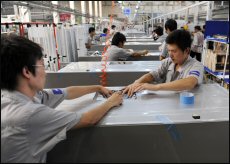
While still based in the coastal province of Shandong, China’s largest home-appliances maker, Haier, produces electrical goods in inland Hubei province to tap the local and nearby markets
Chengdu, Chongqing and Xian, as well as the central provinces of Hubei and Hunan, make up the western regional triangle representing models for the gathering trend.
Electronics plants have been moving inland to meet the increasing input demand on the mainland. For example, Taiwan’s Foxconn, the largest producer of Apple’s iPhone and iPad, along with its parts and components suppliers, has been setting up production facilities in the central and western regions. Local giants such as Midea and Haier are more interested in expanding their production capacity in central China in order to capitalise on the logistics infrastructure there. Other multinationals are studying how to make the most of the western region’s skilled labour and engineering personnel.
The low export-to-sales ratios illustrate how industries in the inland regions rely heavily on domestic sales, with enterprises largely producing parts and semi-manufactures for further processing in coastal regions. These manufacturers have therefore benefited from the keen input demand on the mainland over the past few years. The number of manufacturers are expected to grow further during the FYP period, with the mainland determined to develop inland economies and industries.
Tapping Western China’s Advantages
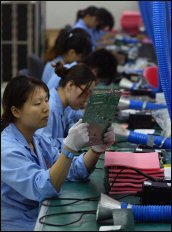
Western China has nurtured a large number of electronics engineers and related technology personnel (photo: EPN)
To serve their global business needs, multinationals are increasingly “going west” to capitalise on western China’s advantages. Intel, for example, relocated its Shanghai production lines to Chengdu a couple of years ago. Half of its chips produced worldwide are now tested and packaged in its Chengdu plant, which flies against the general perception that western China is not a convenient export base.
Intel air-freights the wafers from its fabrication plants in the United States, Israel, Ireland and Dalian to Chengdu, and sends the packaged chips from Chengdu to domestic and global markets by air, primarily through Hong Kong.
IBM, on the other hand, has set up its service centre in the Chengdu Tianfu Software Park to perform IT outsourcing tasks for its clients on the mainland and overseas markets. IBM’s service centre is well-supported by Sichuan’s local workforce and returning software engineers, who are now less willing to work in the more congested coastal regions.
Western China has nurtured a large number of electronics engineers and related technology personnel. Its well-developed military industry is also a source of high-tech talent for electronics players, with the mainland now transforming more military technology for civilian applications.
Hewlett-Packard’s (HP’s) Chongqing facilities also started operations last year to assemble computers for the booming China and global markets. Apart from cost considerations, HP is capitalising on the abundant supply of local workers.
The movement of multinational electronics companies proves that western China is no longer an obscure region, with its talent, labour and markets conducive to the development of electronics clusters. Also, mainland giants and Taiwan players are increasingly keen to capitalise on the resources and market potential of the western region, while upstream suppliers have followed their clients to tap the increasing input demand there.
Central China Opportunities
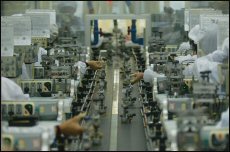
The central Chinese mainland city of Wuhan is home to the so-called “Optics Valley of China,” the largest production base for optical fibre cable and optical apparatus
Foreign investors are attracted to set up production facilities in central China to take advantage of lower operational costs, tax benefits, the availability of engineering talent, as well as relatively abundant labour supplies.
But upstream electronics suppliers are also aware of the growing input demand stemming from production activities there. A natural distribution hub, Hubei, is one example. With its skilled labour force and developing supply chains, it has attracted a number of overseas electronics investments in recent years. Foxconn set up production lines in Wuhan, producing computers and electronic game devices for export, while TPV Display Technology makes LCD display monitors and televisions for distribution to domestic clients in the province and nearby.
China’s own Gree, Midea and Haier, on the other hand, produce electrical appliances in the province to tap the local and nearby markets. But Hubei’s electronics suppliers overall still only have limited capacity. Its enterprises need to rely on the Pearl River Delta (PRD) and Yangtze River Delta (YRD) for supplies, such as passive components and testing equipment, and imports for core components such as ICs and semiconductors from abroad.
Wuhan, in Hubei Province, is also home to the so-called “Optics Valley of China,” the largest production base for optical fibre cable and optical apparatus. It is also a leading mainland laser industry base whose businesses are mainly related to industrial laser and medical/consumer electronics applications. The swift expansion of the China opto-electronics market has sparked input demand in Optics Valley, where enterprises have been expanding their production to meet increasing orders.
Hunan Province is also an emerging industrial base. Cities such as Changsha, Hengyang and Chenzhou are eager to establish development zones to promote technology industries and take in processing production that have relocated from coastal regions. Given its proximity to Guangdong and its lower operation costs, Hunan could be an ideal destination for Hong Kong’s electronics companies to relocate or set up additional production facilities outside the PRD.
But Hunan will continue to rely on material supplies from other provinces, as its supply chain is not likely to be developed quickly enough in the short term to satisfy manufacturers. With the speed of development, the influx of foreign investment is likely to put pressure on the local labour market, while pushing up land costs in the medium term.
The availability of engineers and middle-level staff is another concern for newly established enterprises in Hunan. Some investors even need to transfer workers and staff from their PRD or YRD operations to help build their Hunan plants. But the upside to the development process is that some transferred staff may actually come from Hunan, and are keen to work in their home province. Hong Kong manufacturers should consider this when looking at Hunan as a potential alternative to the PRD.
July 12 2011
Bridge changes China's image By Wang Ying
Project success provides visibility, credibility in global infrastructure - "Made in China" used to be synonymous with cheap consumer goods, but one machinery maker wants to change the image of the nation's manufacturing sector by taking part in the world's most challenging infrastructure projects.
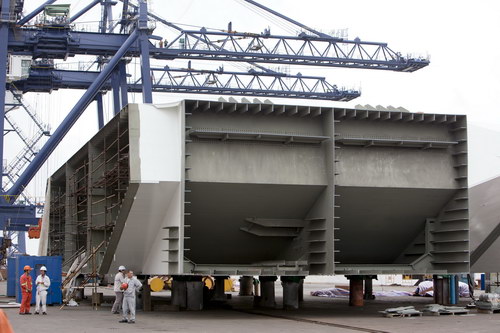
On Monday, China's Shanghai Zhenhua Heavy Industry Co Ltd (ZPMC), formerly known as Shanghai Zhenhua Port Machinery Co, finished the final four pieces of fabricated steel for the San Francisco-Oakland Bay Bridge.
A section of the San Francisco-Oakland Bay Bridge made by Shanghai Zhenhua Heavy Industry Co Ltd (ZPMC) being loaded onto a ship in Shanghai on Monday.
In 2006, the company beat strong rivals from Japan, South Korea and Western Europe to win the bid for the Bay Bridge project, due to be open for traffic in 2013.
The 50,000 tons of steel, with a contract value exceeding $350 million, are part of the $7.2 billion Bay Bridge project.
The project includes reconstruction of the eastern span, which was damaged in a 1989 earthquake.
The new section will be able to resist quakes of up to magnitude 8 on the Richter scale.
The Bay Bridge project has a global profile "and it is also a milestone for Zhenhua in entering the world's major bridge construction" sector, Kang Xuezeng, president of ZPMC, said during the steel fabrication completion ceremony on Monday.
"I am here to announce that we are qualified and confident of constructing more sophisticated steel bridges and building our presence in the world market," Kang said.
ZPMC, founded in 1992, now accounts for 75 percent of the global port equipment production market.
The construction company is entering the bridge sector and "I expect many more great things" from the company, said Steve Heminger, executive director of the San Francisco Bay area's metropolitan transportation commission.
"It is time to be confident, but not yet to be proud," said Xiang Haifan, a professor at Tongji University, who is also a member of the Chinese Academy of Engineering.
According to Xiang, ZPMC's chief competitive advantage over international rivals is cost.
A Japanese company wanted more than $600 million to undertake the project, while a South Korean company quoted more than $400 million.
"Our cost was about half that of Japan's, which makes Zhenhua outstanding with its high quality," Xiang said, adding that China's bridge construction abilities still lag behind those of Japan or South Korea, but the gap is likely to vanish in the next 10 to 20 years.
"Although the Bay Bridge project didn't bring Zhenhua substantial profit, it brought many large international contracts and gave the company fame in the global bridge sector," said Wang Hexu, an industrial analyst from Huachuang Securities Brokerage Co Ltd.
Since 1998, ZPMC has undertaken several major steel bridge projects in China and abroad, including the Shanghai Donghai Bridge and the Golden Ears Bridge in Vancouver, Canada.
Since it already dominates global port equipment production, ZPMC is finding it increasingly hard to expand in this sector, so it has decided to explore related industries.
"Steel fabrication has become our next goal. Through providing steel decks, we have driven into the world's high-end bridge construction market," said Huang Hongyu, vice-president of ZPMC.
"Currently, steel fabrication and marine engineering account for more than 40 percent of Zhenhua's total revenue, and by the end of 2015, the proportion will reach as much as 50 percent," said Kang.
July 11 2011
What a Chinese Hotel Guest Wants: Congee, Slippers and Tea By Jason Chow
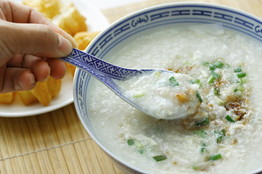
Hoteliers are bending over backward to woo Chinese travelers these days, and hotel chain Hilton Worldwide thinks slippers and tea will do the trick.
The international chain unveiled on Monday a new program called “Hilton Huanying” (which means “welcome” in Mandarin) — what the company touted as “a tailored experience for Chinese travelers.” Thirty hotels in destinations around the world are part of the program, which, the hotel company says, has been backed by extensive research in the ethnic demographic.
So what does Hilton think Chinese travelers want from a hotel? First: a staffer to help them check into their room in their native Chinese language. Then, once in the room, travelers from China will have access to tea kettles, Chinese tea and slippers as well as a welcome letter in Chinese and TV channels dedicated to Chinese programming. But perhaps most telling is the breakfast buffet: Two varieties of congee, fried noodles, dim sum, fried fritters and soy milk will be on offer. (Scene Asia has also documented Chinese travelers’ breakfast obsession.)
The Chinese travel market is growing strong, and everybody in the travel industry – including state governors and mayors of middling Canadian cities – is trying to grab a share of it. As China becomes increasingly wealthy and as the Chinese government relaxes restrictions on outbound travel, the market has exploded over the past two years – Paris and Shangri-La hotels being the preferred destination and hotel of the Chinese jetset.
Still, Hilton’s efforts are just the latest among several chains, including Starwood Hotels & Resorts Worldwide and Marriott International Inc., the latter of which is also offering congee on its breakfast menu. The WSJ’s Alexandra Berzon on Monday wrapped up what various chains are doing to cater to the fast-growing Chinese market.
July 9 2011
China vs. America: Which Is the Developing Country? By Robert J. Herbold - retired COO of Microsoft
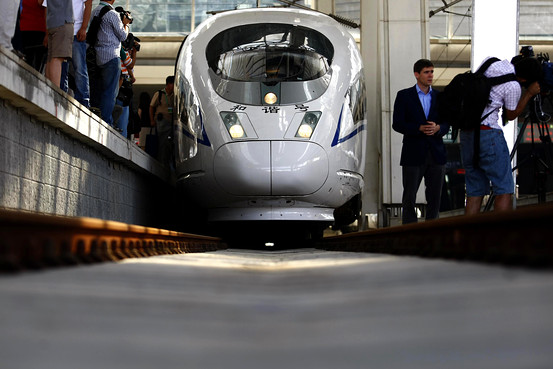
From new roads to wise leadership, sound financials and five-year plans, Beijing has the winning approach. The just-completed Beijing to Shanghai high-speed rail link is the crown jewel of China's current 5,000 miles of rail.
Recently I flew from Los Angeles to China to attend a corporate board-of-directors meeting in Shanghai, as well as customer and government visits there and in Beijing. After the trip was over, in thinking about the United States and China, it was not clear to me which is the developed, and which is the developing, country.
Infrastructure: Let's face it, Los Angeles is decaying. Its airport is cramped and dirty, too small for the volume it tries to handle and in a state of disrepair. In contrast, the airports in Beijing and Shanghai are brand new, clean and incredibly spacious, with friendly, courteous staff galore. They are extremely well-designed to handle the large volume of air traffic needed to carry out global business these days.
In traveling the highways around Los Angeles to get to the airport, you are struck by the state of disrepair there, too. Of course, everyone knows California is bankrupt and that is probably the reason why. In contrast, the infrastructure in the major Chinese cities such as Shanghai and Beijing is absolute state-of-the-art and relatively new.
The congestion in the two cities is similar. In China, consumers are buying 18 million cars per year compared to 11 million in the U.S. China is working hard building roads to keep up with the gigantic demand for the automobile.
The just-completed Beijing to Shanghai high-speed rail link, which takes less than five hours for the 800-mile trip, is the crown jewel of China's current 5,000 miles of rail, set to grow to 10,000 miles in 2020. Compare that to decaying Amtrak.
Government Leadership: Here the differences are staggering. In every meeting we attended, with four different customers of our company as well as representatives from four different arms of the Chinese government, our hosts began their presentation with a brief discussion of China's new five-year-plan. This is the 12th five-year plan and it was announced in March 2011. Each of these groups reminded us that the new five-year plan is primarily focused on three things: 1) improving innovation in the country; 2) making significant improvements in the environmental footprint of China; and 3) continuing to create jobs to employ large numbers of people moving from rural to urban areas. Can you imagine the U.S. Congress and president emerging with a unified five-year plan that they actually achieve (like China typically does)?
The specificity of China's goals in each element of the five-year plan is impressive. For example, China plans to cut carbon emissions by 17% by 2016. In the same time frame, China's high-tech industries are to grow to 15% of the economy from 3% today.
Government Finances: This topic is, frankly, embarrassing. China manages its economy with incredible care and is sitting on trillions of dollars of reserves. In contrast, the U.S. government has managed its financials very poorly over the years and is flirting with a Greece-like catastrophe.
Human Rights/Free Speech: In this area, our American view is that China has a ton of work to do. Their view is that we are nuts for not blocking pornography and antigovernment points-of-view from our youth and citizens.
Technology and Innovation: To give you a feel for China's determination to become globally competitive in technology innovation, let me cite some statistics from two facilities we visited. Over the last 10 years, the Institute of Biophysics, an arm of the Chinese Academy of Science, has received very significant investment by the Chinese government. Today it consists of more than 3,000 talented scientists focused on doing world-class research in areas such as protein science, and brain and cognitive sciences.
We also visited the new Shanghai Advanced Research Institute, another arm of the Chinese Academy of Science. This gigantic science and technology park is under construction and today consists of four buildings, but it will grow to over 60 buildings on a large piece of land equivalent to about a third of a square mile. It is being staffed by Ph.D.-caliber researchers. Their goal statement is fairly straightforward: "To be a pioneer in the development of new technologies relevant to business."
All of the various institutes being run by the Chinese Academy of Science are going to be significantly increased in size, and staffing will be aided by a new recruiting program called "Ten Thousand Talents." This is an effort by the Chinese government to reach out to Chinese individuals who have been trained, and currently reside, outside China. They are focusing on those who are world-class in their technical abilities, primarily at the Ph.D. level, at work in various universities and science institutes abroad. In each year of this new five-year plan, the goal is to recruit 2,000 of these individuals to return to China.
Reasons and Cure: Given all of the above, I think you can see why I pose the fundamental question: Which is the developing country and which is the developed country? The next questions are: Why is this occurring and what should the U.S. do?
Let's face it—we are getting beaten because the U.S. government can't seem to make big improvements. Issues quickly get polarized, and then further polarized by the media, which needs extreme viewpoints to draw attention and increase audience size. The autocratic Chinese leadership gets things done fast (currently the autocrats seem to be highly effective).
What is the cure? Washington politicians and American voters need to snap to and realize they are getting beaten—and make big changes that put the U.S. back on track: Fix the budget and the burden of entitlements; implement an aggressive five-year debt-reduction plan, and start approving some winning plans. Wake up, America!
Mr. Herbold, a retired chief operating officer of Microsoft Corporation, is the managing director of The Herbold Group, LLC and author of "What's Holding You Back? Ten Bold Steps That Define Gutsy Leaders" (Wiley/Jossey-Bass, 2011).
July 7 2011
China’s Retail Market, 2011
Overview
Real growth of retail sales of consumer goods moderated to 14.8% yoy in 2010; retail sales grew nominally by 16.6% yoy in the first five months of 2011
Retail sales are primarily urban-driven; urbanities contributed to 86.5% of China’s total retail sales in 2010
In 2010, eastern provinces and municipalities accounted for 59.9% of the national total retail sales of consumer goods; inland regions are expected to demonstrate better growth momentum in the years ahead
The declining trend of consumer confidence index was arrested in March 2011; entrepreneur confidence index of the wholesale and retail sector was significantly higher than the national average
Luxury sales in China registered strong growth in 2010
Boosting domestic private consumption is a major theme of China’s 12th Five-year plan (2011-2015)
Competitive landscape
The Top 100 retailers had around one-tenth of total market share; their sales revenue grew by 21.2% in 2010
Most domestic retailers are region-focused
Eyeing huge opportunities, foreign retailers continue to flock to China; nevertheless, winning in China is not an easy task
Multi-format operation is common, especially among domestic retailers
Franchise businesses are expanding
Latest developments
Retailers face climbing costs
Online retailing market continues its staggering growth
Retailers strive to improve competitiveness
Retailers extend their footprints to lower-tier cities and the rural market
More active retailers’ IPO activities
Retailer- supplier relationship continues to catch attention
Consumption safety remains a major concern; we expect retailers in China to pay more attention to compliance and quality issues
I. Overview
1. Real growth of retail sales of consumer goods moderated to 14.8% in 2010; retail sales grew nominally by 16.6% in the first five months of 2011
According to the National Bureau of Statistics (NBS), the total retail sales of consumer goods reached 15,455.4 billion yuan in 2010, up nominally by 18.4% year-on-year (yoy); real growth in 2010 was 14.8%, slower than the 16.9% real growth in 2009.
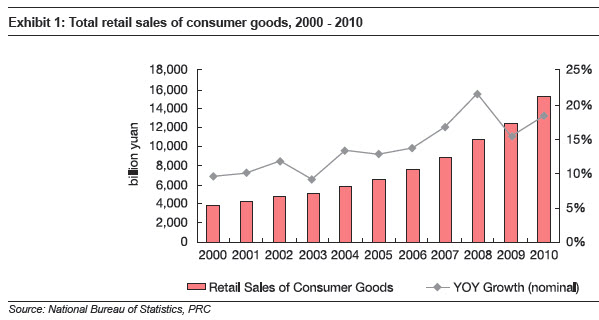
In the first five months of 2011, the retail sales of consumer goods grew nominally by 16.6% to reach 7,126.8 billion yuan. Exhibit 2 demonstrates the nominal monthly retail sales growth from April 2010 to May 2011. Nominal retail sales growth dropped to 11.6% in February 2011, before climbing to 17.4% in March 2011 and moderating to 17.1% and 16.9% in April and May 2011. The fact that the Lunar New Year holiday in 2011 was in early February and part of consumers’ holiday spending was realized in January partly explains the relatively lackluster growth in February.
June 10 2011
Selling Tea to China - Where do Chinese people go to purchase the best Chinese tea? Not China
By Ilaria Maria Sala
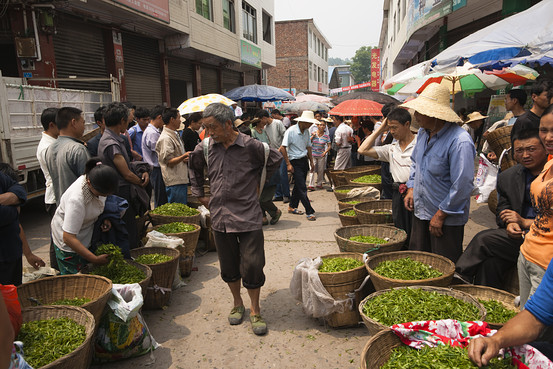
Mainland Chinese visitors to this former British colony are renowned for stocking up on luxury goods like Prada and Louis Vuitton handbags that are cheaper than at home, and less likely to be counterfeits. But now there's a new trend in trophy purchases to show off back home: top-quality Chinese tea.
Catherine Tam, shop manager at Fook Ming Tong, one of Hong Kong's best-known tea shops, explains that Chinese customers are buying up a variety called Da Hong Pao, or "Big Red Robe." From the oolong (or semi-fermented) family, it's grown in the fabled Wuyi mountains in northern Fujian province. Shrouded in mist during most of the year, this area comprised of 36 stony peaks has been used to cultivate "rock teas" since the Tang dynasty (A.D. 618-907).
Rock teas brew a dark, reddish liquor, with an initially bitter, slightly woody flavor, that quickly metamorphoses into a sweet and lingering aftertaste, with delicate hints of honey and fruit. The leaves, long and twisted, can be infused up to 15 times. As is common with many products in China, Da Hong Pao is believed to have health benefits: "It helps fight cholesterol, and has antioxidant properties," explains Ms. Tam.
As legend has it, Da Hong Pao derives its name not from the reddish hue of its leaves, or the tea liquor, but from an emperor's favor. The mother of a Ming dynasty emperor was cured of what today we would call high cholesterol by drinking Da Hong Pao. To thank the bushes that saved her, the filial emperor sent mandarin red silk robes to cover the tea trees—rewarding them, so to speak, by giving them scholar status.
The original handful of Da Hong Pao bushes, which have been harvested since the Song dynasty (A.D. 960-1279, a golden age for tea appreciation), are said to produce the very best Da Hong Pao, and a few grams of it can fetch hundreds of dollars. Until 2005, these leaves were reserved for the Chinese government. Then, the tea plantations on Wuyi mountain were privatized, some cultivars removed from the original bushes transplanted to other locations, and a lot of different grades of Da Hong Pao have since been hitting the market.
Tea connoisseurs appreciate Da Hong Pao's finer qualities, but it commands high prices for another reason: the thrill of enjoying something that used to be reserved for the most exclusive elite due to its rarity. Previously, other than imperial and Communist Party big shots, the tea was reserved for visiting dignitaries. An oft-quoted story recalls that Richard Nixon was given 50 grams of Da Hong Pao by Mao Zedong in 1972. Shortly afterward, Nixon quipped with his aides that the Chinese leader must be quite stingy to part with such a small amount of leaves, but he understood the value of the gift when someone told him that what he had been given was half of the whole harvest of top-grade Da Hong Pao for that year.
As with many other coveted products in the freewheeling Chinese marketplace, however, there are now plenty of counterfeits swirling around. Unscrupulous suppliers have been packaging lower-quality oolong as Da Hong Pao, or enhancing low-quality leaves with chemical additives. Which in turn explains why Hong Kong is so popular as a place to buy it.
"Mainland customers buy it from us in Hong Kong mainly because they trust our thoroughness with provenance," says Ms. Tam. "We have very strict quality controls, with our own personnel at every step of the way, which guarantees that what we market as Wuyi Da Hong Pao really is what it says. We only provide 70 boxes a year, and no more, as this is the amount we can guarantee to be pure, high-grade Da Hong Pao."
Farther afield, too, Chinese shoppers stop at the best tea retailers. In Paris, you might be surprised to see the flagship store and tea room of Mariage Freres, in the trendy Marais neighborhood, packed with excited Chinese tourists, but Laurent Sonnino, the shop manager, is not. "We stopped being surprised years ago. Chinese visitors just keep flocking in," he beams.
"They are very brand conscious, in particular for gifts to carry back home that show refinement and luxury," Mr. Sonnino explains. "Nowadays, a growing minority is buying the best teas imported from India and some of our mélanges, and, yes, increasingly, some of the top-grade Chinese tea as well."
As Chinese consumers remain weary of the countless food scandals that rock the country on a seemingly daily basis, tea, that commodity so coveted by foreign traders coming to China in the 18th century, is now making an unexpected round-trip journey.
June 2, 2011
Get Ready: Here Comes the Yuan By Tom Orlik
The rise of China's currency could reshape the global monetary system— and fundamentally alter the world's main engine of growth.
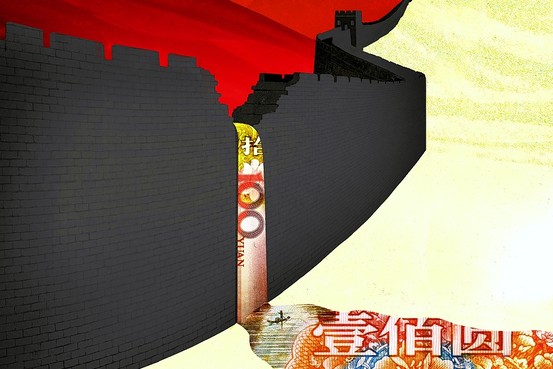
The wall is starting to crack.
For years, China has made it tough for capital to flow to and from its economy, the second-largest in the world. Now, the government in Beijing is forging ahead with a campaign to bring the yuan onto the world stage—and breaches are appearing in that formidable financial barrier.
What's Ahead for the Yuan?
A yuan that's more widely used in international trade and investment could eventually challenge the dollar's supremacy, correct some of the imbalances that plague the Chinese and global economy, and force a profligate U.S. to live within its means.
It won't be an easy transition. There are powerful vested interests in China that are satisfied with the status quo and will try to put the brakes on any reform effort. But the changes China has made so far have generated momentum both at home and internationally—and may prove too strong to resist.
For more than a decade, China's closed capital account has been a defining feature of the global economy. It has insulated the mainland from international capital flows, enabling China to ride out the Asian financial crisis in 1997 and leaving its banks unscathed by the near-collapse of the U.S. financial system in 2008.
As important, denying foreign-exchange markets a role in setting the exchange rate has allowed the government to maintain the value of the yuan at an artificially low level—supporting a 30-year export boom. Since Chinese savers can't take their money overseas, banks have also gotten away with offering them low interest rates, keeping the cost of capital for industry at bargain-basement prices and underpinning an investment binge.
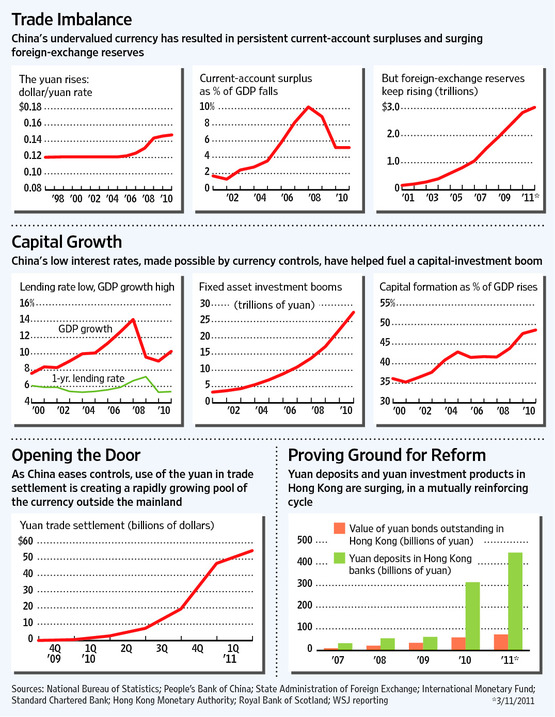
Take the example of Shenzhen—a fishing village in 1979, in 2011 a metropolis of 14 million built around the world's fourth-busiest port. Low-cost capital subsidized the construction of transport and power infrastructure, factories and production lines. An undervalued yuan, combined with low cost of labor, enabled companies to undercut their foreign rivals on price.
But manipulation of the exchange rate and repression of the interest rate comes at a cost. Cheap capital has resulted in overcapacity in the industrial sector and bubbles in the mainland's property market. Managing the exchange rate in the face of trade surpluses has resulted in the buildup of gargantuan foreign-exchange reserves—$3.04 trillion that China has little choice but to recycle as cut-price loans to the U.S.
One of the first cracks in China's restrictive policy came in July 2009, with a plan to allow settlement of import and export transactions in yuan. Wider international use of the yuan is intended to reduce transaction costs for China's importers and exporters, guard against the risk of a collapse in dollar trade financing—as occurred at the end of 2008—and fly the flag for a rising economic world power.
By the first quarter of 2011, $55 billion of China's trade—7% of the total—was settled in yuan. At the end of April 2011, yuan deposits in the Hong Kong banking system had risen to 511 billion, or $79 billion, up roughly ninefold from July 2009 when the settlement program was launched.
Restrictions on outbound flows are also being lifted. In the past month, the Shanghai government announced plans to allow residents of the city to make investments overseas.
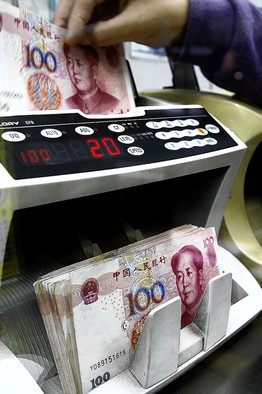
But more substantial opening of the capital account will require progress in two areas: an exchange rate that is close to fair value and market-set interest rates. The yuan is still undervalued, but two factors suggest it's much closer to market value than it used to be: It has appreciated 20% in real terms against a trade-weighted basket of currencies since 2005, and China's current-account surplus fell to 5.2% of gross domestic product in 2010 from 10.1% in 2007.
If the yuan is approaching fair value, the Chinese government will be able to loosen controls on the capital account with less chance of triggering destabilizing speculative inflows.
China's interest rates, meanwhile, are still set by the government. But the People's Bank of China is attempting to make progress, by taking a leaf out of the mainland's economic history.
At the beginning of the reform era, China's government designated Shenzhen as a special economic zone where market-based policies could be tried before being expanded to the rest of the country. Hong Kong will serve as a similar site of experimentation for reform of the mainland's financial system. Yields on yuan-denominated debt trading in Hong Kong are already set by the market rather than with reference to the People's Bank of China's benchmark interest rate.
According to the Royal Bank of Scotland, the value of bonds outstanding in this so-called dim-sum market has risen to the equivalent of $15.8 billion from about $5.3 billion at the end of 2009. McDonald's Corp. and Caterpillar Inc. are among the companies that have turned to the new market for financing.
The increase in trade settlement and the development of Hong Kong as a yuan financial center are mutually reinforcing. More yuan trade settlement adds to the pool of liquidity in Hong Kong, encouraging the development of more yuan investment products, and greater variety of investment products reinforces the incentive to use the yuan in trade settlement.
What Comes Next
Now pressure is building on China to open further channels into its capital markets. The question is whether change comes fast or slow. China's leaders seemed to be taking the cautious route. The target of making Shanghai an international financial center by 2020 was regarded as the de facto target date for capital-account opening. But the rapid progress of the past year has raised expectations of opening earlier.
If China accelerates its timetable, the implications are enormous. A higher interest rate will mean slower expansion of investment, eating into the mainland's appetite for commodities and shifting the main domestic growth engine down a gear.
A more expensive yuan will limit demand for exports that have catalyzed the explosive growth of China's east coast. Low-value-added makers of textiles, toys and tools—where margins are razor thin—will be the first to shut up shop. High-technology manufacturers like Foxconn—the trade name of Hon Hai Precision Industry Co., which makes the iPad—have already decided to move production facilities inland, to find cheaper labor away from the coast.
The same dynamic that will make investment less affordable and exporting less profitable means more spending power for China's households—kick-starting efforts to bring domestic demand to the fore as a driver of growth. In the U.S., businesses from Napa Valley wine makers to manufacturers of cinema projectors in Nebraska are hoping to cash in on the rise of the Chinese consumer.
Not all of the changes will be so positive for the U.S. Reduced intervention by China in foreign-exchange markets will lead to a reduction in demand for U.S. Treasury debt, not just from China but also from other Asian nations that have followed China's lead in managing their exchange rates. That will increase the cost of borrowing for the U.S., making it more difficult to finance public debt and continued current-account deficits.
Displacing the Dollar?
The next step in the development of the yuan as an international currency—a role as a reserve currency held by central banks—will require more substantial progress. A capital account that still remains tightly controlled means the Chinese currency can't fulfill the main function of reserves: a liquid asset that central banks can use to stabilize the value of their domestic currency.
The transition to an open capital account won't be easy. Powerful groups in the export sector, state-owned enterprises, banks and local government benefit from a low interest rate and undervalued yuan. The door to reform is not wide open, but neither is it locked.
Reform has its own logic and its own momentum. Companies that raise yuan financing offshore today will demand increased opportunities to bring those yuan onto the mainland tomorrow. If interest rates are higher offshore, investors on the mainland will find opportunities to move their yuan in the other direction. If legitimate channels don't exist, companies with an onshore and offshore presence will find ways of circumventing China's capital controls.
We aren't there yet. Yuan deposits in Hong Kong aren't yet equal to 1% of those on the mainland. But the pool of offshore yuan, available at interest rates set by the market, is growing fast—reducing the effectiveness of China's capital controls and the ability of the central bank to use administrative tools to control the mainland economy.
When the tide of offshore yuan starts to wash over the wall Beijing has built around its domestic financial system, the impact on the Chinese and the world economy will be far-reaching. China's closed capital account has been the defining feature of the world economy in the past decade; its opening could be the defining feature of the decade ahead.
May 28 2011
Business Jets Take Off in China By David Pearson
The world's makers of executive jets are pinning their hopes for sales growth on the swelling ranks of China's super-rich.
The Chinese market is booming while mature markets in Europe and North America remain lackluster after nose-diving last year. For example, half of new orders for Dassault Aviation SA's Falcon jets since the beginning of this year have come from China.
"China has become a very important part of our business," John Rosenvallon, head of Dassault's Falcon division, said at the annual European Business Aviation Convention and Exhibition here last week.
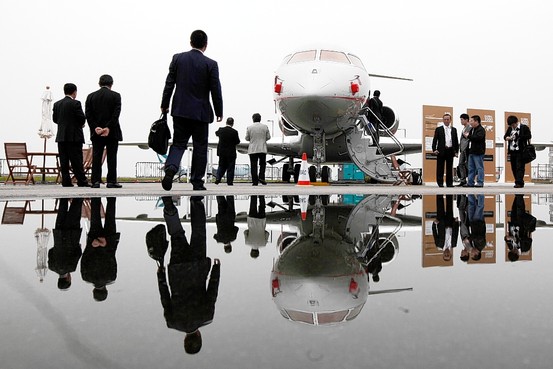
Executive-jet orders are starting to rise in China. Above, visitors toured a Bombardier Global Express XRS corporate jet in Hong Kong in March
What the business-jet builders like about the Chinese market is that it is virtually untapped. Almost all the new orders are from customers who have never owned an aircraft before, unlike in the U.S., where some two-thirds of new orders are from repeat customers. And unlike in the West, Chinese buyers are jumping in at the top end of the market, buying planes with sticker prices over $50 million.
"In the U.S. business-aviation market, people tend to start with a small aircraft and then graduate to bigger aircraft—for example, going from a Cessna to a Hawker Beechcraft to a Gulfstream, and finally they get to a Boeing business jet," says Li Bing, head of Boeing Co. business-jet sales for China and South Korea. Boeing has sold eight business jets to Chinese buyers in the past four years and is aiming to retain its 50% share of the Chinese market for large business jets.
Meanwhile, Airbus, of Toulouse, France, expects to continue selling about five corporate-jet versions of its commercial aircraft a year to Chinese customers. These top-of-the-market jets typically sell for $65 million or more apiece.
Airbus, a unit of European Aeronautic Defence & Space Co., has sold 25 corporate models of its commercial airliners in China, Hong Kong and Macau over the past eight years. Both Airbus and Boeing offer cabin designs tailored to Chinese customers, including a circular dining table with a lazy Susan, to allow passengers to eat "family style" or play mahjong.
"The potential for long-term growth in China is huge," says Charles Edelstenne, chief executive of Dassault Aviation.
Well-heeled Chinese individuals aren't shy about flaunting their wealth, and it is one of the few markets in which manufacturers can openly vaunt the luxurious nature of their products. Mr. Edelstenne says Chinese buyers able to spend tens of millions of dollars on executive jets tend to be entrepreneurs, often in real-estate or mining. And they often pay cash.
At present, there are just over 130 executive jets registered in China, a fraction of the 15,000 in the U.S., which has only a quarter of China's population.
The Chinese authorities are struggling to deal with a massive influx of registration requests from foreign aircraft manufacturers. For now, big Chinese state-owned companies are chartering rather than buying planes, but it is only a matter of time before they start leaning toward outright ownership, industry experts say.
The current leader in the Chinese market is Gulfstream, a division of General Dynamics Corp. It has close to 40% of the Greater China market, with sales of more than 58 planes, half of which are based in Hong Kong. "The Chinese market barely existed 10 years ago," says Jeff Miller, Gulfstream's head of communications. But, he adds, it would be a mistake for the company to embark on a major sales push before it has established a proper infrastructure offering quality after-sales service. "We're being realistic. We don't have stars in our eyes," he says.
The Chinese government's latest five-year economic plan places heavy emphasis on developing private aviation by easing flight restrictions and building a huge number of airports. "The important thing right now is the relaxation of aerospace control by the army at lower altitudes," says Bill Boisture, chief executive of Hawker Beechcraft Corp., one of the leading U.S. business-jet builders.
The relaxation and airport expansion should automatically lead to a significant increase in demand for aircraft, he says. Sales numbers to date have been low, "but five to 10 years from now we'll see a market that's able to grow," he says. China will become "one of the engines of the industry," he says.
Business-jet makers say the infrastructure ramp-up must also include developing fixed-base operators—essentially, aviation gas stations with maintenance and flight-crew facilities and amenities for upscale travelers—and this will require the involvement of the private sector financially and operationally. As the general aviation infrastructure develops in China, Chinese companies are expected to set up manufacturing facilities in more distant parts of the country, increasing business-jet traffic and creating even more demand for facilities.
VistaJet Holding SA, a Swiss luxury-jet charter and aviation-services company, is considering a move into China alone, with a local partner or through a franchise agreement, Chief Executive Thomas Flohr says.
Like other industry players, Vistajet knows that moving into China entails a steep learning curve as the country develops an entire industry largely from scratch. Mr. Flohr says he is taking his time to sound out the potential market, to understand what Chinese customers need in terms of types of aircraft and to figure out how to organize his sales force.
"Once these elements are defined, we will go," he says.
May 25 2011
At cross-purposes By Lanxin Xiang
Chinese history shows that the Americans have misread the intentions of their 'strategic rival'. Unfortunately, it has paved the way to a vicious cycle of mutual misunderstanding.
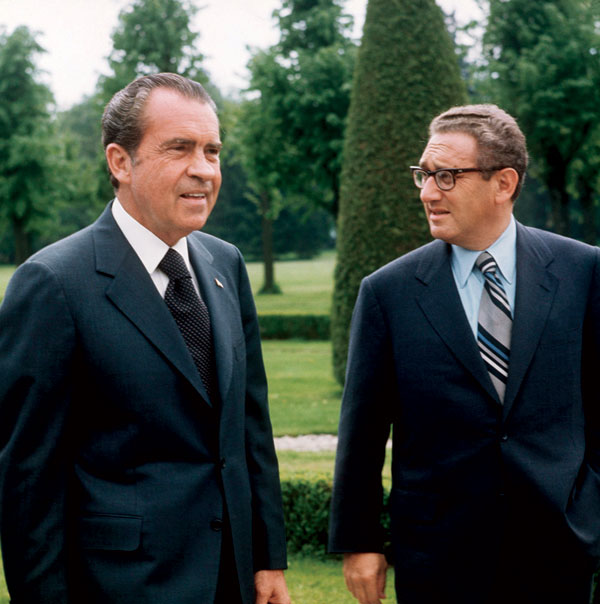
It is extremely rare for an American administration to formulate a clear strategy for its China policy during the first presidential term. Richard Nixon is one exception, thanks mainly to the help of a world-class strategic thinker, Henry Kissinger, the architect of the rapprochement between the US and China in 1971. Now Kissinger, ever the optimist on this relationship, has become a pessimist, as his new book, On China, reveals.
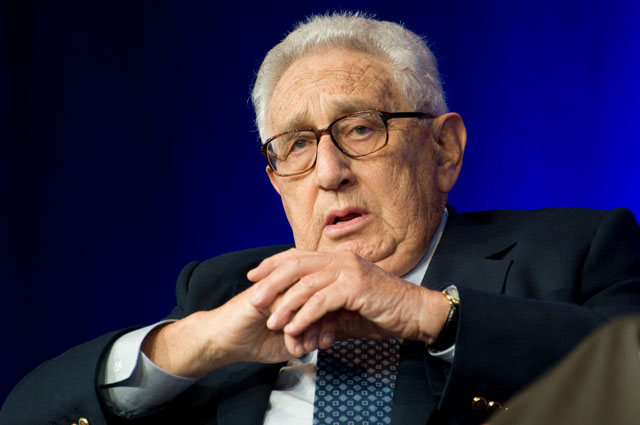
Kissinger has good reason to worry.
Though the Obama administration, too, has made an attempt at defining this bilateral relationship, arguably the world's most important, from the outset of its first term, so far its strategy seems misguided and confusing. In a short span of less than four years, the relationship has metamorphosed from an intimate G2 to strategic rivalry. Such an odd phenomenon is, perhaps, due to the lack of serious strategic minds within and around the White House.
In recent months, Barack Obama has adopted a seemingly innovative "soft containment" strategy, and the core is to reconcile two contradictory priorities: pursuing a universalist world policy in ideal and maintaining American exceptionalism in reality. Put another way, he wants to rejuvenate the American empire, albeit an insolvent one, by drinking from a universalist fountain of youth, much like strengthening the Roman Empire on the ideological basis of ancient Greece.
This has resulted in the start of a new-style cold war between China and the US. But this cold war is not so much based on the 20th-century ideological dichotomy of communist dictatorship versus democratic freedom, as on a much deeper chasm - the misunderstandings between two cultures.
To begin with, there is a misreading of history. When Hillary Rodham Clinton blasted China's human rights record recently, she claimed that Beijing was on a "fool's errand", trying to stop the process of history. But what and whose history was she talking about? Apparently, she was referring to a history after the European Enlightenment, during which the concepts of democracy and human rights became a political theology. Of course, the United States itself is a product of the Enlightenment, so this way of thinking and reasoning comes naturally. But the Chinese prefer to remember pre-Enlightenment history, as well.
The first ideological encounter between China and the West took place in the late 16th and early 17th centuries, and the first debate about the differences and common ground between the two cultures was a serious one. Pioneered by the Jesuit priests, such as Matteo Ricci, a healthy dialogue about fundamental aspects of the two cultures yielded significant results, which prompted the Vatican to consider an "accommodationist" approach. Unfortunately, this extraordinary achievement was destroyed by European power politics in a long struggle between the defeated accommodationists and their foes, centred on a controversy over Chinese religious rites.
For the Chinese, a real debate today on fundamental cultural values would mean restarting the original one with the Renaissance humanists, but this is hardly possible between Washington and Beijing, because the US has no collective memory about the Renaissance and remains the key defender of its counter-culture, the Enlightenment.
In the practical policy arena, there is also a habitual misreading of some crucial specifics in history, which could result in dangerous consequences. Armed with seemingly superior values, the Americans naturally think they can dictate the process of the "rise of China", while the Chinese view as highly problematic the very notion of the nation's "rise". Such a concept assumes at least two things: first, that China has not occupied the position as the most economically prosperous nation before and, second, that China's recent progress is primarily due to the Western-dominated globalisation process.
These assumptions are historically inaccurate. Not only did China experience sustained economic prosperity (SEHK:
0803) for centuries, it was also quite accustomed to its position as a trade-surplus country and leading holder of reserve currencies (silver and gold) up until the opium war. As late as 1820, Chinese gross domestic product was estimated to be more than 30 per cent of the global total. Today, despite all the sensation caused by the "rise of China", that figure is less than 10 per cent.
Hence, for China, its recent success is part of an ongoing process of cultural and historical restoration after a 160-year lapse.
But for the US, seeing China as a newly rising power or "emerging market" leads to the logical conclusion that China's "rise" and its negative consequences must be contained by forcing it to embrace Western value systems. Thus, the reasoning goes, since China has embraced the market economy that originated in the West - a notion that is itself problematic - political democratisation must follow. If not, China should be seen as another Imperial Germany at the end of the 19th century, a dangerous authoritarian economic dynamo with global expansionist ambitions. Such is the mentality behind the new cold war strategy.
The misreading of each other's minds in the security relationship is even more alarming. While traditional Chinese culture emphasises preparation for a potential attack by building sufficient capability, or the "offensive defence" approach, the US is accustomed to an equally pre-emptive approach; the difference is, the US strategy is euphemistically called "deterrence".
Thus, a vicious strategic cycle could result: China's military build-up will be seen automatically as having aggressive intentions, though history does not bear any serious evidence of expansionist tendencies in the Chinese state. At the same time, the US "deterrence" effort around China, even though this term confers higher moral value, could easily be seen by the Chinese as a military encirclement.
It is precisely because the two nations have so far been unable to transcend this vicious psychological cycle that Kissinger is worried about the long-term prospects for the relationship. And he is, of course, right.
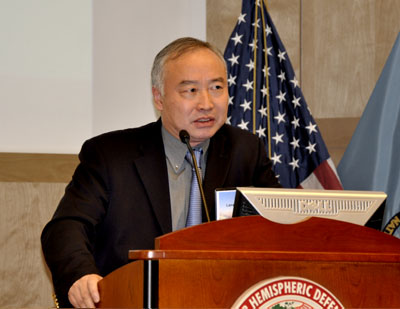
Lanxin Xiang is professor of international history and politics at the Graduate Institute of International and Development Studies in Geneva
May 16 2011
Power of China's internet can't be ignored - 70pc of mainland consumers search the web for information on luxury brands every month
By Celine Sun
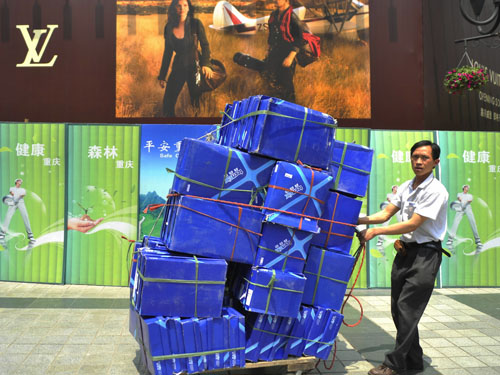
A KPMG report says the web is an increasingly popular and effective tool for mainland consumers to find promotions on luxury brands.
No luxury brand can afford to dismiss the power of the internet when doing business on the mainland, the second-largest luxury goods market in the world.
A recent study found that nearly 70 per cent of luxury consumers on the mainland search online for information on luxury brands every month, although only a small fraction actually make purchases through the web.
KPMG, a global audit and advisory services firm, issued the report yesterday, saying the internet has become an increasingly popular and effective tool for mainland consumers to find promotions and special offers.
KPMG surveyed 1,200 middle-class consumers in first and second-tier mainland cities. Thirty per cent said they searched for information on luxury goods online every week, while 39 per cent did so once every two weeks or once a month.
One reason for the high percentage was the emergence of a younger generation of big-brand shoppers on the mainland.
Despite the fast-growing number of online viewers, only 5 per cent of respondents showed a serious interest in making purchases over the internet, the report said.
Discounts and the convenience of being able to compare products were the major benefits that attracted people to online shopping. But concerns about authenticity, after-sale service and payment security remain the big deterrents for many.
"China continues its march towards becoming the largest luxury market in the world," said Nick Debnam, partner and Asia-Pacific chairman of consumer markets with KPMG. "Year on year, as this market becomes more crowded, it is harder for luxury brands to enter this space."
The report also found that French, Italian and Hong Kong brands were the top choices. Mainland consumers have a stronger interest in fashion and cosmetics products from France, footwear made in Italy and some jewellery brands in Hong Kong.
The most important reasons they consume expensive brands are to reward themselves, which was followed by "for important occasions" and "to pamper themselves", it said.
Meanwhile, mainland consumers also showed more awareness of luxury brands, with respondents recognising 57 compared with 34 brands three years ago.
An earlier CLSA study said customers from the Greater China region, which includes Hong Kong, Macau and Taiwan, would account for 44 per cent of global luxury-goods sales by 2020.
May 12 2011
China's CAAC encourages carriers to change to increase international routes
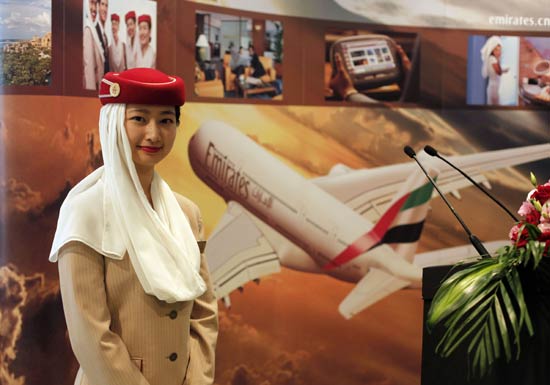
A flight attendant awaits the arrival of Emirates Airlines' first A380 at Pudong International Airport in Shanghai. The Civil Aviation Administration of China said it will take measures to encourage carriers to explore the international market.
China's civil aviation authority on Wednesday encouraged the country's airlines to add more wide-body jets to their fleets.
The Civil Aviation Administration of China (CAAC) also said it will take measures to encourage carriers to explore the international market.
Li Jiaxiang, head of CAAC, told the China Civil Aviation Development Forum that of the country's air transport fleet of 2,600 planes, only some 150 are wide-body airliners. The majority, or 80.8 percent, are single-aisle planes, while another 150 are regional aircraft, which carry fewer than 100 passengers.
"Some airlines even regarded wide-body planes as a burden. But with flight time slots at major airports becoming scarce and the globalization (of travel), wide-body jets will be very useful," said Li.
He said that as the nation's high-speed railways push to dominate the lucrative domestic transport market, and the increasing number of Chinese traveling overseas is providing airlines with fresh opportunities.
Previously, carriers put too much capacity into the booming domestic market in their search for profit. As a result, the share of Chinese airlines' in the international passenger transport market is shrinking, from 45.3 percent in 2005 to 44 percent in 2010, according to statistics from CAAC.
Among the limited capacity allocated to international routes, airlines have focused on Japan, South Korea and Southeast Asia. Their concentration on a few lucrative international routes has undercut the strength of China's air transport industry as a whole, he said.
"We observed that in the case of countries with flights to China, usually only one airline is designated to operate flights on a certain route. But in our case, several airlines are crammed onto a few routes, which offsets the country's competitiveness. The government will direct them to integrate capacities and make alliances," said Li.
He said the government will encourage both large and regional airlines to engage in cooperation and consolidation to eventually achieve the goal of having two or three large competitive airlines.
Li also noted that some airlines were granted rights to operate flights on routes that they did not fully exploit or simply wasted. "The CAAC will regularly publicize the carriers' use of traffic rights and retrieve the rights from those who have not made good use of them," he said.
By the end of 2010, China had signed bilateral air transport pacts with 112 countries and regions. However, Chinese airlines opened scheduled flights only to 54 countries. Meanwhile, on some international routes, the number of flights operated by domestic airlines is insufficient.
On routes between China and the United States in 2010, US airlines opened 34 scheduled passenger and cargo flights and offered 199 flights each week, but Chinese carriers opened only 15 scheduled flights and offered 140 flights each week.
Li said that China's major carriers should also note the potential of low-cost airlines and offer differentiated services.
Kong Dong, chairman of Air China Ltd, said at the forum that the national carrier's fleet will add 10 more wide-body jets this year: four Boeing 777s and six Airbus 330s. "The fact that we did not expand the fleet during the past two years has made us lose some opportunities," said Kong.
"With the new jets, Air China will operate flights to Africa and South America, and add flights to Los Angeles. Before that, we will also open new flights to Europe, such as the recently added flights to Milan and Dusseldorf."
May 11 2011
America Gains From Chinese Investment - These companies, like the Japanese
before, are creating jobs and growth in the U.S. By Daniel Rosen and Thilo Hanemann
Traditional macroeconomic issues usually dominate U.S.-China economic
conferences such as the Strategic and Economic Dialogue (the
"S&ED") held in Washington this week: exchange rates, trade
disputes, market access and the like. But beyond the familiar laundry list, a
new topic has burst on the scene: direct investment by Chinese firms in the
United States.
Between now and 2020, we expect Chinese firms to deploy between $1 trillion and
$2 trillion of direct investments abroad. Americans could be a major beneficiary
of this—if anti-China sentiment in Washington and around the country does not
bring down the curtain just as the show is starting.
China started investing overseas in a big way in the mid-2000s, almost entirely
in the natural resources sector. Chinese firms made some attempts to invest in
the U.S.—notably CNOOC's failed bid for oil company Unocal in 2005—but
through 2008, such forays were few and far between. Since 2009 that story has
begun to change. In a new study, we find that over the past two years direct
investment expenses by Chinese firms in America have grown more than 130% a
year.
In 2010 alone, Chinese firms spent more than $5 billion in America on a
combination of 25 "greenfield" projects built from scratch and 34
acquisitions of existing companies. While China still accounts for only a tiny
share of total foreign direct investment in the U.S., Chinese firms are today
invested in at least 35 of 50 states and an upward trend is clearly underway.
It is not politics but profit that is driving the vast majority of Chinese firms
to invest in the U.S. With over-investment leading to excess capacity in much of
industrial China, Chinese companies increasingly see greater profit
opportunities across the Pacific.
The shift of China's growth model toward domestic consumption and increasingly
intense competition at home forces Chinese firms to upgrade their technology;
capture the higher levels of the value chain they traditionally conceded to
foreign partners; and augment their managerial skills and staff base to remain
globally competitive. Investments abroad are a way to do all this.

Ren Zhengfei, CEO and managing director
of Huawei Technologies.
China's gain could also be America's gain, as demonstrated by an earlier round
of Asian investments: Japanese firms had a difficult start in the U.S. in the
1980s, as they were greeted with skepticism and fear. Today, Japanese firms
employ almost 700,000 Americans with an annual payroll of nearly $50 billion.
Yet, as with Japan, the high growth of Chinese investment—albeit from a tiny
base—is already sparking a political firestorm in the U.S. Recent
controversies have flared around various investments by telecommunications
equipment supplier Huawei, as well as steel maker Anshan in a Mississippi rebar
plant, and the acquisition of small aircraft maker Cirrus by a Chinese
state-owned company.
There is a clear danger that anti-China reactions will only grow louder as the
numbers increase, and even result in more restrictive terms for firms from
China. Such a closed-door policy would be bad for Chinese firms. It would also
be tragic for American communities to lose the jobs, innovation and tax revenue
additional investment dollars could create.
Preventing a bilateral investment shut-down will require effort by both sides.
In America, clearer thinking on national-security issues is important. The
inter-agency Committee on Foreign Investment in the United States review process
is generally working well to vet deals for security threats, but a hyperbolic
tone emanating from Congress and others on this issue is toxic. Congress and the
White House together must send a clear bipartisan signal that Chinese investment
is welcome in the U.S., lest Chinese investors take their checkbooks to less
hot-headed countries.
China also has ways to help its cause. It's little wonder deals get bogged down
in Washington, given the non-transparent, politically influenced nature of many
Chinese companies. Improving governance within companies will help this. So will
regulatory changes to brighten the line between government and companies. For
instance, a clearer separation between regulators and the firms they oversee
would send a good signal.
China must recognize that its restrictions on American direct investment affect
the political mood in Washington. Beijing maintains barriers to foreign
investors in many sectors, such as telecommunications or financial services, and
U.S. negotiators are working to remove those hurdles. China can help sustain
openness to Chinese investment abroad by continuing to reform its inward
investment rules.
That said, however, it is critical that Washington not play a tit-for-tat game
with Chinese investment. America has tried to keep politics out of the
foreign-investment screening process not to do foreigners a favor, but because
openness to investment is good for American firms, workers, communities and the
economy as a whole.
That logic applied to Japan in the 1980s, and it holds with China today. Now
would be a terrible time for the U.S. to drop its own successful principle. If
we do, we risk Chinese firms setting up plants in Ontario instead of Michigan,
or Juarez instead of El Paso.
Messrs. Rosen and Hanemann are partners at the Rhodium Group, a New York-based
advisory firm, and authors of the new study: "An American Open Door?
Maximizing Benefits from Chinese Direct Investment in the U.S."
May 10 2011
Hawaii, California and USA could benefit from the Wenzhou China overseas investments - individuals can invest up to US$3 million (HK$23.4 million) in a single overseas project, rising to US$10 million for groups
 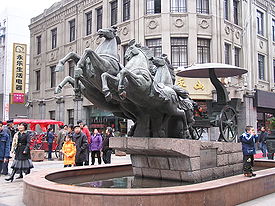
http://en.wikipedia.org/wiki/Wenzhou
The mainland's currency regulator is keeping an eye out for speculators in a pilot scheme that allows individuals in Wenzhou to invest overseas.
The State Administration of Foreign Exchange has yet to decide whether to include stock trading in the scheme, deputy director Wu Shuiping said yesterday.
Authorities in Wenzhou said at the start of the year individuals can invest up to US$3 million (HK$23.4 million) in a single overseas project, rising to US$10 million for groups.
But investments are banned in overseas stock markets, real estate, energy and mining.
Agricultural, educational,
wine, medical, technology and film sectors could benefit from the China investment.
The developments are drawing close attention in Hong Kong as approval for stocks would accelerate the so-called "through-train" policy that allows funds to flow into the local market.
Wu also warned of the impact on inflation from burgeoning foreign exchange reserves that have hit about US$3 trillion.
That comes as Zhang Anyuan, a director at the National Development and Reform Commission, said the People's Bank of China lost US$271.1 billion over the past seven years in investments using foreign exchange reserves.
Zhang estimated the loss to hit US$578.6 billion if the yuan appreciates to six against the US dollar. The yuan gained 0.05 percent to 6.4933 yesterday.
At present, the mainland is the largest investor in US treasury bills.
Zhang suggested diversifying the risk "as soon as possible."
The news comes as the Ministry of Commerce announced that foreign direct investment hit US$30.3 billion in the first quarter and involved 5,900 firms.
Hong Kong is the top investor in terms of both number of companies and investment amount, with 2,767 firms and a total investment of US$17.9 billion.
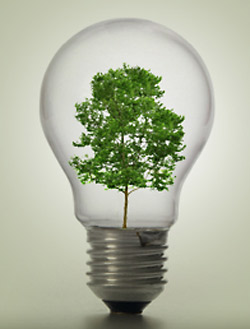
Denmark earns the biggest share of its national revenue from producing windmills and other clean technologies, the United States is rapidly expanding its clean-tech sector, but no country can match China's pace of growth, according to a new report obtained by The Associated Press.
China's production of green technologies has grown by a remarkable 77 per cent a year, according to the report, which was commissioned by the World Wildlife Fund for Nature and which will be unveiled on Monday at an industry conference in Amsterdam.
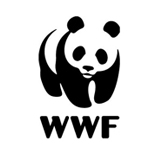
"The Chinese have made a conscious decision to capture this market and to develop this market aggressively," said Donald Pols, an economist with the WWF.
Denmark, a longtime leader in wind energy, derives 3.1 percent of its gross domestic product from renewable energy technology and energy efficiency, or about euro6.5 billion ($9.4 billion), the report said.
China is the largest producer in money terms, earning more than euro44 billion ($64 billion), or 1.4 percent of its gross domestic product.
The US ranks 17 in the production of clean technologies with 0.3 percent of GDP, or euro31.5 billion ($45 billion), but those industries have been expanding at a rate of 28 percent per year since 2008.
"The US is growing substantially, so it seems the policy of (President Barack) Obama is working," Pols said. But the US cannot compare with China, he said.
"When you speak to the Chinese, climate change is not an ideological issue. It's just a fact of life. While we debate climate change and the transition to a low carbon economy, the debate is passed in China," Pols said. "For them it's implementation. It's a growth sector, and they want to capture this sector."
The report was prepared by Roland Berger Strategy Consultants, a global firm based in Germany. It gathered data on 38 countries from energy associations, bank and brokerage reports, investor presentations, the International Energy Agency and a score of other sources. It measured the earnings from producing renewables like biofuels, wind turbines and thermal equipment, and energy efficiency technology such as low-energy lighting and insulation.
"Clean technologies are really growing fast, but China is responsible for the majority of that growth," said Ward van den Berg, who compiled and analyzed the data for the consultancy firm.
Until recently, Chinese massive production of solar cells was aimed at the export market, but they are now making solar systems for the home market, as they have been doing for several years in wind energy, Van den Berg said.
Following Denmark and China, other countries in the top five clean-tech producers, in terms of percentage of GDP, are Germany, Brazil and Lithuania, the report said.
May 4 2011
 The China Greentech Initiative
(CGTI)
The China Greentech Initiative
(CGTI)
The China Greentech Initiative (CGTI) has launched The China Greentech Report 2011, outlining five reasons why China has surpassed other markets in greentech implementation, including summaries of 19 specific high priority greentech market opportunities. The report cites five specific trends that are driving China’s emergence as a global greentech leader. It includes market updates of six greentech sectors – Cleaner Conventional Energy, Renewable Energy, Electric Power Infrastructure, Green Building, Cleaner Transportation and Clean Water – and summaries of 19 prioritized specific greentech market opportunities.
As an official CGTI Supporting Partner, AmCham Shanghai is hosting a series of CGTI roundtables highlighting key insights and analysis from the China Greentech Report 2011. CGTI roundtables are open to AmCham Shanghai members and are held at the AmCham Shanghai office.
To download the full China Greentech Report 2011 in English http://www.hkchcc.org/2011greentechinitiativereport.pdf
May 2 2011
Battleground for US car wars shifts to China - GM, Ford and Chrysler look to expand in world's biggest market
By Neil Gough

For the first time in American carmaking history, the battleground for Detroit's "Big Three" - General Motors, Ford and Chrysler - has shifted offshore from the United States to China. Since the outbreak of the financial crisis in 2008, GM, Ford and Chrysler have laid off tens of thousands of workers in the US, closed dozens of domestic plants and dramatically downsized their portfolios of car brands.
This contrasts with the scenario on the mainland, where GM has announced plans to double its sales by 2015 to five million cars and microvans, up from 2.35 million sold on the mainland last year.
Rival Ford is in the process of building two new mainland plants for vehicles and one engine plant to deliver a much-needed production capacity boost. It plans to double its professional workforce and dealership network on the mainland and launch 15 new models by 2015.
GM is the biggest US carmaker in the United States by sales volumes, but as of last year the company's number one market was China. Not surprising, since China became the world's number one vehicle market in 2009.
Ford entered the mainland market in 2003, about five years after GM, and now sells about a third as many passenger cars in China as GM.
"It's fair to say we could've and should've gone faster, but over the last 18 months we are going about as fast as we can go," Ford China chairman and chief executive Joe Hinrichs said. "We are adding two dealerships a week in China, and we have been doing that for over a year. The scale of growth is just amazing."
So how to explain the success of Detroit - best known for producing big and brawny gas guzzlers - in a market like mainland China, where around 90 per cent of the passenger car sales consist of vehicles with fuel-sipping engines of less than two litres?
"Most Chinese today buy cars for social image projection first and function second, and many admire America or at least the power that America projects," said Michael Dunne, an industry consultant and author of the forthcoming book American Wheels, Chinese Roads: The Story of General Motors in China.
"The story of the Detroit Three in China has been how to take advantage of this natural appeal. It's meant making major adjustments to their products."
Some of those changes have been fairly fundamental to Detroit's heritage. For example, mainland buyers like the size and spaciousness of American rides, but shy away from big block engines that suck up small fortunes at the petrol pump.
GM brought the mid-sized Buick Regal to the mainland in 1998 with a 3.0 litre engine, but it proved a laggard on showroom floors until it was swapped for a 2.5-litre version in 2003, said Dunne.
Today, Regals are available with 2.0 litre engines on the mainland and are GM's seventh-best seller in the market, with 80,000 units sold last year, according to data from J.D. Power & Associates.
Still, while two-thirds of Detroit's "Big Three" are seeing booming business in China, the firm that was the first to gain access to the mainland market continues to struggle.
Beijing Jeep, established in 1984 as the first Sino-foreign carmaking joint venture, was acquired by Chrysler in 1987 and seemed to be the perfect window for the smallest of Detroit's "Big Three" to gain access to the mainland market. But success proved elusive throughout changes in ownership at Chrysler and strained dealings with its mainland joint venture partner.
Last year, the group's three main brands - Chrysler, Jeep and Dodge - combined to sell less than 20,000 units on the mainland. "Chrysler is a sad story," said Dunne. The firm "never had good partner relations".
That lesson has not been lost on GM or Ford when it comes to managing their all-important relations with the joint-venture partners they are required to work with on the mainland.
Relations with the joint venture partner were "the heart of the matter", said Tim Lee, GM's Shanghai-based president of international operations and the chairman of its collaboration with SAIC Motor - a tie-up that forms China's biggest passenger car producer.
"The value of the partnership is in the level of trust that you can develop between the two parents," Lee said. GM's dealings with SAIC now extend beyond China: SAIC paid US$500 million for a 1 per cent stake in GM during its US share sale last year, prior to which the two inked a deal to make and sell cars in India.
Detroit carmakers' strengths and weaknesses in the mainland market are the inverse of their position at home. In China, they are strongest in the small to medium-sized sedan segment, where in the US they face their fiercest competition from Japanese and Korean carmakers.
Surprisingly, the Americans lag behind in the mainland market's hottest growth segment: sport-utility vehicles or SUVs. US drivers' appetites for big-engine SUVs built on truck platforms delivered bumper profit margins to Detroit throughout the 1990s and early 2000s.
But in China, where SUV sales doubled last year and rose another 44 per cent in the first three months of this year, the top 10 best selling SUVs are made by Japanese, local, Korean and German firms. The US companies do not rank. Mainland buyers prefer the smaller engines and sportier styling of so-called crossover-utility vehicles or CUVs, usually built on a car platform.
"In terms of growth, they are the fastest-growing segment and we are not where we need to be there," said one executive from a Detroit firm. "We've got catching up to do on that, and we intend to."
For Detroit, it is all part of the learning curve in the world's (new) biggest car market.
"In the US, they really only compete with the Japanese and Korean firms," AutoForesight Shanghai managing director Yale Zhang said. "But China is probably the most competitive market in the world ... you do battle with almost everyone."
April 29 2011
Companies to boost overseas investment
By Lan Lan
Survey: Sharp rise in firms planning more spending in foreign markets
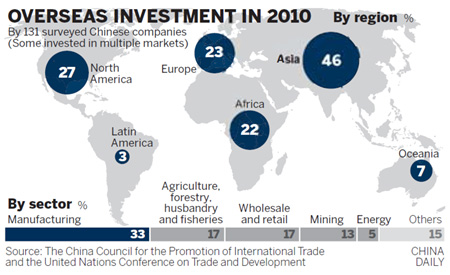
BEIJING - Almost 90 percent of domestic companies involved in international trade plan to increase overseas investment, a survey reveals.
Of the 1,024 companies surveyed, about 88 percent said they want to boost investment overseas over the next two to five years, a sharp rise from a year earlier when 61 percent of the firms surveyed said they planned to expand investment.
The China Council for the Promotion of International Trade (CCPIT) and the United Nations Conference on Trade and Development conducted the survey between December and March. China's foreign exchange reserves, the world's largest, hit $3.04 trillion at the end of March.
Li Xiaojing, head of the Bank of China's financial market department, said overseas investment will help diversify some of the reserves.
Asia, Europe and North America will be prime destinations for investment and Africa is gaining increasing importance as 22 percent of the companies surveyed had already invested there.
However, overseas investment remains small with about two-thirds of the companies surveyed investing less than $5 million in 2010. Only 8 percent made investments of more than $100 million.
In the next two to five years, about 30 percent of the companies surveyed expect to invest more than $5 million.
The central bank in January allowed the yuan to be used in direct overseas investments. Asia and South America will be potential markets, at least in the initial period, Li told China Daily.
But Jia Huai, the survey's project director, said he believed many companies still lacked the technical knowledge to take advantage of the yuan policy but it was a step in the right direction.
Sun Lujun, director of the capital management department of the State Administration of Foreign Exchange, said on Wednesday that the new policy will facilitate overseas investment and better support companies seeking markets overseas.
Sun also said China will continue to loosen restrictions on capital control and facilitate overseas investment by the end of 2015.
In addition to traditional investment models, such as building plants or upgrading existing facilities, a growing number of companies are looking at mergers and acquisitions.
Chinese investment overseas through mergers and acquisitions in 2010 was worth $23.8 billion, accounting for 40 percent of total investment.
Last year saw a new wave of companies targeting overseas acquisitions, including the high-profile private automaker Zhejiang Geely Holding Group buying Volvo Cars and Sinopec Group acquiring a stake in Repsol's Brazilian subsidiary.
Companies investing overseas traditionally favored the machinery and textile sectors, but recently investments in agriculture, mining and energy have surged, the survey said.
Other sectors are also attracting interest, an analyst said.
"High-tech and clean energy technology companies are becoming hot targets for overseas mergers and acquisitions," said Xu Weiqing, an analyst with Zero2IPO Group, a capital market research company.
In 2010, Chinese firms invested in 3,125 overseas companies in 129 countries and regions and total foreign direct investment in non-financial sectors rose 36 percent to $59 billion, according to the Ministry of Commerce.
China has become the world's second-largest acquirer of foreign companies, only next to the United States, according to a recent research by the Chinese Academy of Social Sciences.
But a lack of diversified fundraising channels also restricts investment overseas, the survey showed.
"Fundraising difficulties and lack of international operation experience are major limitations for Chinese companies hoping to expand overseas, especially for small- and medium-sized enterprises," said survey project director Jia.
Using the companies' own capital and borrowing from banks are the two main channels for overseas investment. Other financing channels such as stocks, securities and other market instruments are not widely used, Jia said.
April 28 2011
Growing concern over school milk program By Zhou Wenting
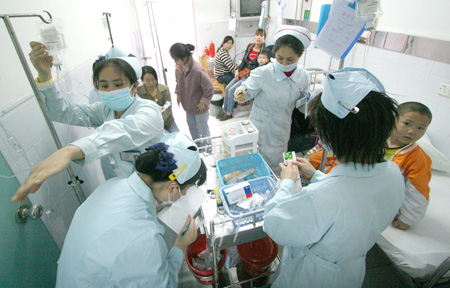
Kindergartners in Zhuhai, Guangdong province, are treated after drinking contaminated milk. The company that provided the milk was not qualified for the school milk program but was a longtime supplier.
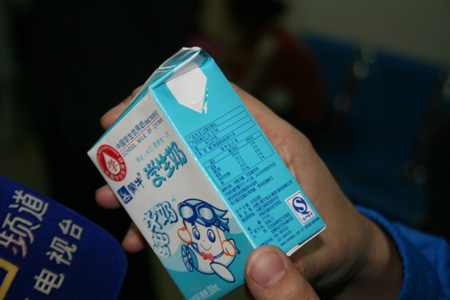
A parent checks the labeling on a carton of school milk in Yulin, Shaanxi province, on Friday after 251 children fell ill at Yuhe Town Central Primary School. Initial tests found no pathogens.
Health scares continue to damage public confidence, reports Zhou Wenting in Beijing.
A national school milk program intended to improve children's health has soured again.
On Friday morning, 251 children at Yuhe Town Central Primary School in Yulin, Shaanxi province, fell ill after drinking school milk produced by the Mengniu Dairy Group. They were sent to hospital for treatment, and were all discharged by the following day.
Test results released on Tuesday afternoon said the milk met China's national standards for food safety, and no pathogens were detected in the milk or the students' vomit and feces. They did not say why 251 students suffered from the discomforts collectively.
The tests were conducted by Yulin's Center for Disease Control and Prevention and the results were announced by the city's food safety committee.
On Tuesday evening, Mengniu said on its website that it would work with the school and the local health department to track the students' health. But public confidence in China's developing school milk program suffered another blow.
Dairy enterprises are impaired by suspected and real poisoning incidents and low profits. Schools stay out of the program because they do not want to be implicated in safety scandals. And the country has no unified management or supervision of the program it started in 2000.
Milk producers and local watchdogs are the first to be blamed for bad quality control, but experts also have doubts about the guiding theory behind the program.
Two tests, two results
Mengniu breathed a corporate sigh of relief at the test report, but food safety experts didn't let it go easily.
"Why do accidents always happen at branch plants?" said Sang Liwei, a food-safety lawyer in Beijing and a representative of the Global Food Safety Forum, a non-governmental organization.
The milk the Yulin children drank was processed at a local plant in Baoji that is owned by Inner Mongolia-based Mengniu. "One month ago," Sang said, "milk withdrawn from circulation was also produced by a subsidiary plant", that one in Zhengzhou, Henan province, and owned by Shanghai Bright Dairy & Food.
Mengniu was involved in two milk incidents in Shaanxi province within the past year, but test results for both set it free. Experts called for a new test by higher authorities.
Sang mentioned safety concerns at Nongfu Spring in Haikou, Hainan province, in 2009. Haikou Municipal Industrial and Commercial Bureau detected excessive mercury in the drinking water, but a later test by the provincial bureau showed the water met standards.
"No matter what happened behind the scenes, it at least showed that two tests can give different answers," Sang said.
Food safety experts said if the questioned milk indeed passed the tests, then the standard for dairy products in China is doubtful.
"We have two tests: qualitative and quantitative," Sang said. "Sanlu's baby formula had also been qualified before 2008, because there wasn't a test target for melamine," Sang said.
An estimated 300,000 infants, including six who died from kidney stones or other kidney damage, became victims of baby formula produced by Sanlu Group Co in 2008. The chemical melamine, which was added to the milk, caused it to appear to have a higher protein content.
So what really caused the Yulin schoolchildren to become ill?
Hours after the test results were announced, Mengniu suggested two possible reasons - the "unscientific" way the children drank the milk and hysteria, because "only 16 students vomited and felt nausea at first".
"After drinking the cold milk on an empty belly, some students experienced upper abdominal pain, nausea, vomiting and other symptoms of gastritis," said Zhao Yuanhua, vice-president of Mengniu Dairy Group.
Parents were skeptical. "Is this blaming the children's poor physical condition? Could it be said that hundreds of students are all in poor condition?" Chen, parent of a third-grader, was quoted by the Beijing News as saying.
Zhao told China Daily there are other reasons to believe the milk was safe. "Students at another primary school in Hanzhong, Shaanxi province, drank 700 cartons of milk from the same batch, but none experienced discomfort."
Zhao said teachers at the Yulin school have said the symptoms appeared first among 16 students and then seemed to spread. "That might be caused by hysteria," he said.
Mental health experts said it can happen. "If several children began to vomit and have stomachaches, it's possible that hundreds of others may be influenced . . . and undergo a collective reaction," said Ji Xuesong, a professor at Peking University's institute of mental health.
"If some students showed symptoms like nausea and vomiting, a teacher should avoid asking if others have the same feelings," Zhao said. "Asking that may make more children get infected."
An outbreak
When China launched its national school milk program, nine ministries and bureaus established a coordination group, which is affiliated with the Ministry of Agriculture.
School milk carries special symbols on its packaging and cannot be sold in the marketplace. Authorized enterprises must pass expert evaluation and approval of the coordination group. The price of school milk must be lower than the market price of similar products in the same region.
"Direct delivery was compulsive, and the service was regulated," Wang Dingmian, former vice-chairman of the Guangdong Provincial Dairy Association, told China Daily on Monday. "But when the management system ended in 2003 and the administration and approval rights were passed on to local departments below the provincial level, problems began to erupt."
The incident with the widest impact happened in Haicheng, Liaoning province, in March 2003. A total of 3,936 students and 260 teachers in eight primary schools showed symptoms after drinking soymilk at school. A 13-year-old girl died.
An investigation found that the food poisoning was caused by the soy flour, the raw material used in soymilk.
Five years later, 152 children in several kindergartens in Zhuhai and Jiangmen, Guangdong province, were poisoned when they drank milk processed by Zhuhai Bigshot Dairy Co. The company did not meet the qualifications for supplying school milk but had long been a major supplier for local schools.
The Ministry of Health reported, "The milk was contaminated by a kind of coccus (bacterium) in the process of adding ingredients, and was not effectively disinfected."
Five incidents occurred in April 2010 in Shaanxi province. In two cases, investigations showed that the milk from Mengniu Dairy Group and another dairy giant, Yili Industrial Group, met national standards for food safety.
Shaanxi Renrengao Dairy, a private company based in Baoji, was the culprit in two of the cases. Its filling machines did not seal milk packages well, so air sneaked in and the milk spoiled.
The company had acquired a license for manufacturing of industrial products, a food hygiene license and ISO9001 quality management accreditation.
No reports were found about how the enterprises were punished. Bigshot and Renrengao have multiple product lines today.
In the fifth case, nine pupils at Qianwei town's Andai Primary School in Lantian county suffered abdominal pain after ingesting milk and eggs at school. No reports about the culprit were found.
Well off target
China's school milk program is still in a fledging phase, covering only 1 percent of students. The original target was 30 percent in 2010.
The program's broader goals were to improve the health of children and teenagers, advocate the concept of scientific diet, and promote the rapid development of the dairy industry.
In 2000, five major cities carried out pilot programs. By 2006, four of them had sunk in stagnancy.
For example, the Shanghai Municipal Education Commission called it quits after the soymilk poisoning in Liaoning province in 2003. Guangzhou had been the best performer, but participation dropped from 40 percent in 2007 to 12 percent this year, according to a milk market analysis and a dairy industry plan from Guangzhou.
The national school milk program continues, but experts say it seemingly has become philanthropy.
"Parents in developed cities are more willing to buy expensive and high-quality milk for their children by themselves," said Sang, the food-safety lawyer. "So the school milk project is now more noticeable in backward areas, including many cases where local governments pay the bill."
Experts say that if the program is called off in some areas, students will be harmed.
"The school milk program should be a boon for students nationwide," Sang said. "Local governments shouldn't give it up for fear of milk scandals. Large-scale businesses and State-owned enterprises can take part in and shoulder more social responsibilities."
'Invest in children'
The United Nations Food and Agriculture Organization reports that 62 countries have implemented school milk programs. Roughly half are developed countries and half are developing.
Experts are frustrated to see the program cannot find its place in China. They attributed the failure to weak supervision and overwhelming business costs.
Wang, the former Guangdong dairy association official, said a local permit to produce school milk is a stepping stone for companies to enter a local market. But once the permit is obtained, he said, companies might not strictly follow the processes and meet the standards for student milk.
Detection equipment, inspectors and other means of ensuring product safety are costly, Sang said. If an enterprise cannot produce a profit - remember, the school milk price must be lower than market price - it has fewer resources to ensure the quality of its products.
Even local watchdogs have proved to be of little help. "In many areas, one could find a 'school milk office', which is responsible for supervising the local school milk program," Wang said. However, he added, the office usually has other responsibilities that take priority.
Experts suggested a national program that is fully carried out by the government as a solution.
"It can be managed by the cooperative efforts of the Ministry of Education, quality inspection department and others, who are in charge of unified bidding, establishing a long-term mechanism and implementing strong penalties," Sang said. "This is also a good way to prevent collusion of local governments and businesses."
Wang came up with the same solution. "The government can set up a production chain and supervise the whole process, from raw material collection to delivery."
In many places, especially well-developed ones, Wang said, local governments are doing well on social service programs. "Why can't we invest more in children?"
Sang said China can learn from the United States, which experienced serious food safety problems a century ago but reversed its plight. The president, Theodore Roosevelt, was determined to make a change. Later, the Food and Drug Administration and a quality inspection system were established in succession.
"The Chinese government can also solve the problem," Sang said, "and the key is determination."
April 27 2011
China, Australia ties get trade boost - Wen and Gillard sign deals to increase economic cooperation
By Wu Jiao

Premier Wen Jiabao chats with Australian Prime Minister Julia Gillard during a welcoming ceremony at the Great Hall of the People in Beijing on Tuesday.
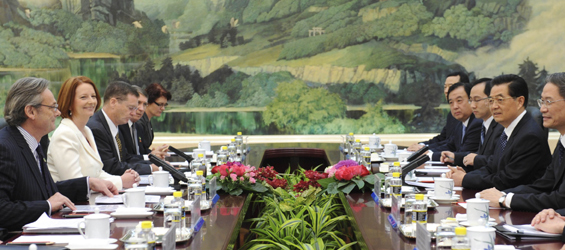
President Hu meets with Australian PM Gillard - Chinese President Hu Jintao meets with Australian Prime Minister Julia Gillard in Beijing, capital of China, April 27, 2011.
BEIJING - China and Australia signed a series of cooperation agreements on Tuesday as Australian Prime Minister Julia Gillard attempted to boost ties and smooth over recent spats with China.
Yet analysts said that achieving smooth bilateral ties would take some time despite strong trade relations.
There was an upbeat tone for the visit on Tuesday with a lavish red-carpet welcoming ceremony given by Premier Wen Jiabao, and a signing ceremony for bilateral agreements witnessed by both Wen and Gillard following their meeting at the Great Hall of the People, the seat of the legislature in the heart of Beijing.
According to a press release by the Foreign Ministry, both Wen and Gillard agreed to further economic and trade cooperation in a bid to promote bilateral ties.
Opening their discussions, Wen reaffirmed the importance of China's relations with Australia, saying that "we have always seen Australia as an important partner in our win-win relationship".
Wen proposed that the two states establish "long-term and stable strategic cooperative ties" amid booming cooperation in energy and natural resources.
He also encouraged bilateral cooperation in the research, development and utilization of new, clean and renewable energy, as well as in the construction of information networks, rail systems and ports.
Wen urged the two states to promote the ongoing Sino-Australian free trade talks, explore financial cooperation and expand cooperation in culture, education, science and technology and tourism.
Gillard said Australia's economic ties with China were "in good shape" and trade between the two countries was growing in "leaps and bounds".
Gillard also said that Australia welcomes more Chinese students and tourists and greater investment, despite a number of controversial incidents.
In 2009, China Nonferrous Metals Mining Group Co Ltd was blocked from buying a controlling stake in rare earths miner Lynas Corp.
Australia also stymied China Minmetals Corporation's bid for Oz Minerals' Prominent Hill copper and gold mine because the mine was too close to a defense rocket range.
Of the five agreements signed by the two countries on Tuesday, one allows for the establishment of a joint fund, worth $18 million over four years, for science cooperation, according to ABC News.
Another enables Tourism Australia to promote products to individual Chinese customers and not just tour groups.
Gillard is the first Australian prime minister to visit China in three years.
Despite robust bilateral trade, ties deteriorated in 2009 after China arrested Australian iron industry executive Stern Hu and later sentenced him to 10 years in prison on charges of bribery and infringing trade secrets.
The two sides also feuded over Australia's permission for Uygur separatist leader Rebiya Kadeer to visit in August 2009 despite China's strong objections.
Observers said that for Australia, finding the balance between courting and criticizing China is especially tricky.
According to Reuters, no advanced economy is as dependent on China for its fortunes, but as a close ally of the United States shares many of Washington's concerns.
China buys more than a quarter of Australian exports, having overtaken Japan as the country's largest trading partner in early 2009. Two-way annual trade has now passed $107 billion, up from $61 billion in 2009.
"There's a desire on both sides to put 2009 behind them. I think the government is looking to reset the relationship and put it on a more pragmatic footing," said Andrew Shearer, director of studies at the Lowy Institute for International Policy in Sydney, who formerly worked as a policy adviser in the Australian government.
Yet analysts also warned that Australia's China policy means that it is hard to expect an overhaul in bilateral ties.
Gillard's visit to China follows the release of a survey showing 75 percent of Australians viewed China's growth as good for Australia, but 57 percent believed there was too much Chinese investment there.
The survey published by the Lowy Institute on Monday also shows Australians remain concerned over Beijing's military power and global influence.
According to Su Hao, an expert on international security at the China Foreign Affairs University, Gillard's adjustment to Australia's China policy is only on the economic level, not on the strategic level.
"The mutual mistrust is still there," Su said.
According to Su, Gillard's visit to the Republic of Korea and Japan in the last few days, and her support for defense ties with them, sent negative signals to China, and possibly means a backward step in Australia's China policy.
April 22 2011
Micro blog leads revolution in China By Zhang Jing, Yang Yang and Meng Jing

Weibo may reshape Internet behavior in China over next few years - It is the new kid on the block and growing leaps and bounds. Soon it may tower like a goliath over other better known peers in the Web world as suitors from the government, public and corporate sector jostle for attention on its platform.
Weibo, or micro blog, the sending of brief text, audio or video to select groups, is making rapid strides in China and reshaping the way information flows with their multiple sources and diversified, authentic content. It is also becoming an attractive platform for companies to showcase their products and reach out to more consumers.
 click on the picture for full view
click on the picture for full view
Unlike Twitter, micro blog is relatively new to China and just two years old. Despite being a late entrant, the weibo has already started to reshape people's lives in China, thereby indicating its growing prowess.
A typical weibo starts with an "@" before the user's nickname, and like Twitter, has a word limit of 140 words. There is, however, one exception. Internet company
www.Tom.com has set the weibo limit at 163 words to match with its parent company name 163.com. Unlike Twitter, a weibo can also be a picture, a voice message, a song and a video.
In February this year, Beijing rock singer He Yong posted a short message on his micro blog styled, "Weibo the Almighty, please save my child!" It was a request for help to cure his 30-month-old daughter as she refused to take any food or water for five days in a row. In the same month, the Ministry of Foreign Affairs saved over 900 stranded Chinese workers in Libya as they were able to locate them through their weibo messages for help.
The weibo power came to the fore in March, when irate netizens in Nanjing, Jiangsu province, led a campaign to stop the felling of the city's famed parasol trees for a subway construction. Netizens urged micro blog followers to hold protest meetings in front of a local library until the authorities agreed to their demands.
Nothing personifies the growing popularity of weibos than the example of a 12-year old boy in remote Fujian province who has a weibo account with all the four major providers - Sina, Tom, Tencent and Sohu.
Tencent, the world's third-largest Internet company by market capitalization, said in February this year that its number of registered weibo users has risen to nearly 100 million. Sina also claims that its numbers have swelled considerably and it has started making profits from the weibo services. That is indeed impressive, considering that the feat was achieved in less than two years, whereas it took Twitter nearly four years to build a network of 195 million users since inception in 2006.
Though Tencent and Sina are the biggest players among Chinese weibos, there is also a sea change when it comes to the customer profile on the two platforms. Tencent Weibo users are mostly teenagers who use the company's instant messaging service QQ, which has nearly 630 million active accounts. Users of the Sina services are in contrast aged between 30 and 40 and better educated.
With a big surge in user numbers expected by the end of this year, both the companies are leaving no stone unturned to boost market share. The Data Center of China Internet (DCCI) says that by the end of 2011, independent weibo users will reach 100 million and grow to 253 million by 2013. The weibo market is expected to take off from 2013, it says.
"Though the data differs from company to company, there is no doubt that micro blog is poised for explosive growth," says Liu Yan, director of Digital Influence with Ogilvy Public Relations Worldwide.
"Micro-blogging has a real-time news function," says Yang Guobin, author of The Power of the Internet in China: Citizen Activism Online and associate professor at the Barnard College of Columbia University in the United States.
"Its basic follower function gives a clearer structure to the increasing expansive and formless flow of information in cyberspace.
"By following another weibo user, I automatically receive his or her messages. Popular weibos can have large following. A person with a large following has enormous broadcasting power," says Yang.
By Jan 12 this year, the number of Tencent followers on Liu Xiang, China's 2004 Olympic 110-meter hurdle champion, crossed 10 million, well surpassing that of Lady Gaga on Twitter. Since then, Liu has become the most popular micro-blogger in the world.
Entrepreneur Lee Kai-fu, the former China head of Google, is another leading light in the weibo world and has more than 3 million followers. Lee admits that his entry into the weibo world was by chance. In June 2009, his friends told him that someone with the name of @kaifulee had been publishing news concerning Google and responding to fans' comments on Twitter. This made Lee aware of the power of Twitter.
"If a fake Kaifulee could enjoy such popularity, I thought that I should micro blog myself for more influence," says Lee, who later verified his account and posted a message saying "Dear impostor Kaifulee, you pretended to be me for three months. You've been reasonable, but with the Reuters' coverage, I had to get my name back."
An experienced micro-blogger now, Lee was invited to give a speech at the first China Weibo Developer Conference 2010. Lee named his latest book, Weibo Changes Everything, in which he has predicted the end of WAP era, and the coming of the new age of Mobile Internet, embodied by weibo.
"Weibo's social networking function is further enhanced by external applications, like those found on compatible mobile phones that can read, receive and send micro blogs," says Yang Guobin.
A recent report by Sina shows that nearly 36.6 percent of their weibo users log onto the service with their mobile phones. Over 43 percent of such users are women and they account for nearly 65 percent of the active weibo accounts.
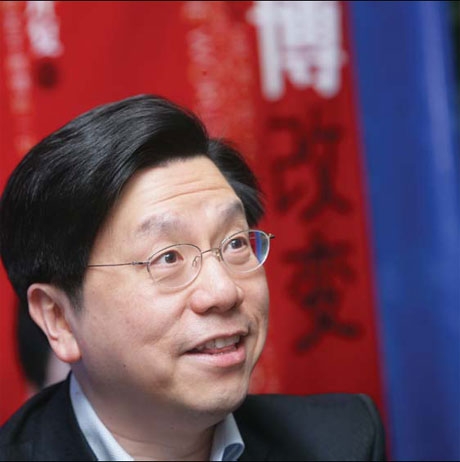 Lee Kai-fu at the release of his book Weibo Changes Everything in Beijing in February. Lee Kai-fu at the release of his book Weibo Changes Everything in Beijing in February.
"The level of stickiness and salience on the micro blog sphere is beyond any other forms of media," says Liu from Ogilvy.
"With the advent of weibo, one can immediately feel that social network sites like Kaixin001.com are losing their sheen. I used to visit Kaixin every day, but now I visit the site only once or twice a week. But for weibo, it's a different story. I can publish a microblog in a restaurant, at bedside, on the subway... It can be anywhere, any time. It is said some real fans would publish a micro blog even when they go to the toilet."
"They (weibo) can help us find those with similar interests instantly and build a network through information sharing," says Elli Li, a business development representative with Bianfeng.com, a leading online gaming company in China.
"In the social network system (SNS) of weibo, the clearer one is about what his or her interests are, the more effective the process of information gathering will be. For example, once I wanted to buy certain cosmetics products online and my followers immediately told me to go to a global purchasing website. That helped me save nearly $80 (56 euros).

Liu Xiang, the 2004 Olympic 110-meter hurdle champion, meets with his followers at Tencent Weibo on Jan 22 in Shanghai.
"Nowadays, I don't read newspapers nor do I watch TV. Most of my information feed is from weibo. The speed of weibo SNS information sharing and the vastness of its spread are also beyond reach for blogs or forums, which, in a way, has brought about the decline of the latter. MSN blogs closed on March 17 after a five-year existence," says Li.
According to the Internet Real-time Public Opinion Index Annual Report 2010 released by the Communication University of China in Beijing, weibo has become the third-favorite online source of information for public opinion, after news portals and online forums.
"At the moment, weibo serves more as a content provider and disseminator than a social networking platform," says Zheng Yingqin, a PhD from Cambridge University and a senior lecturer with the De Montfort University in UK, who specializes in information & communication technology (ICT) and social development.
"According to research, the main content providers on Twitter largely fall into four categories - celebrities, media, individual bloggers and enterprises/organizations. The first two are mostly interested in their own networks, i.e. they follow weibo accounts in the same category, while the other two have broader interests and may pay more attention to other groups. It is likely that the same applies to weibo," says Zheng.
"People log onto weibo for a variety of reasons, and social networking is only one of them. Weibo differs from existing social networking services such as QQ or Facebook in that its connections can be unidirectional. One can follow other people without their permission or reciprocal attention and nor does one necessarily need any fans (followers) to enjoy a fulfilling weibo experience. It also provides minimal tools to support one to one interactions, unlike QQ or Facebook."
"Weibo may evolve to incorporate stronger social networking functions in the future, as there seems to be such a demand from some users. More importantly, it is changing the way we perceive the world and the way we connect to each other. Potential opportunities of open innovations, for example, user-led product development and network-based business models, are yet to be explored," says Zheng.
The huge population base of weibo has greatly enhanced its potential in social commerce and influence. By the end of August 2010, a total of 466 major media companies, including TV, radio, print and magazines, have registered with Sina Weibo. The latter has also verified some 2,500 companies as its weibo users, covering over 30 industries such as automobiles, food, film and entertainment.
Sina chief executive Cao Guowei says that his company's advertising revenue grew 28 percent in 2010 thanks to the weibo platform. "There is still enough room for Sina Weibo's growth," says Cao.
Other companies are also taking advantage of weibo, but in more creative ways. Sohu is providing weibo dating services, while several companies are using it for recruitment by asking potential employees or interns to describe themselves on weibo in whatever way they like. Prominent include French advertising company Publicis Groupe, Taobao.com, and Hangzhou City Express, a local newspaper in Hangzhou, Zhejiang province, that attracted some 500 million yuan (53.7 million euros) advertising revenue in 2010.
Many European companies and organizations in China have also followed the trend of creating weibo accounts in China. These include the Netherlands Board of Tourism and Conventions and the British Tourist Authority. The Delegation of the European Union to China officially launched its "EU in China" blog and micro blog service in Beijing on March 28.
"Blog and micro blog are a promising way to reach out to different types of people whom we don't meet in our daily work," says Markus Ederer, ambassador of the EU Delegation to China.
The EU Delegation blogs on four major Chinese portals - Sina, Tencent, Tom and Sohu. Most topics are on European lifestyle and pertain to films and travel. "Hopefully the interactiveness of blogging will help Chinese understand why we are the way we are," says Ederer.
William Fingleton, press officer with the EU Delegation, says blogging the EU in China "is perhaps the best way to reach out to young people who spend a lot of time indoors and in front of their computers."
The EU delegation has chosen food as its first blogging theme, to coincide with the recent visit of the EU Agricultural Commission and the introduction of its geographic identification system in China. Special guests to the ceremony included Chinese food bloggers like Great Chef Bai Du and Transparent Purple, who showcased their self-made favorite European dishes to the audience.
"Weibo has made understanding our customers easier, and them us," says Ogilvy's Liu. She says her team addresses questions to followers of their clients, sometimes trivial questions like the duration of time taken to apply cosmetics. Feedback from the followers also helps us understand their interests and also whether they are more interested in brand history and culture, or whether they are more interested in sales and discounts.
"Weibo is an integral platform for companies to communicate with their customers or potential clients. What you get is first-hand material. It is fast and effective and without the participation of any third parties. Previously, we may have to physically go to 10 cities to collect samples, which are time consuming, and the samples are limited. But within two days, an online survey on weibo may get more than 100 feedbacks from across the county," she says.
Each company approaches micro blogs differently and their styles vary. Dell China has set up several micro blogs, intended for differentiated customers, like one for medium- and small-sized companies, and one for after-sales. L'Oreal decides on the next city for its road show by fans' votes on its micro blog.
"When the fans' wishes are answered, they feel they are respected," says Liu. "And once an emotional bond is connected, it will last for a long time. Eventually it may lead to sales."
"But everything is still in the early stages of trial and error. A business model with weibo is yet to be set up," says Liu.
April 20 2011
Creating an International Renminbi
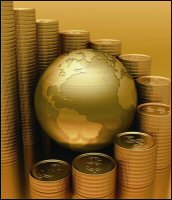 Increasing renminbi trade settlements should lead to higher demand for related financial transactions Increasing renminbi trade settlements should lead to higher demand for related financial transactions
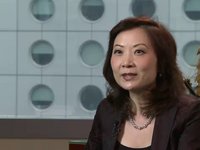 Jing Ulrich: Renminbi to Appreciate 5% in Both 2011 and 2012
http://www.vimeo.com/22653447
Jing Ulrich: Renminbi to Appreciate 5% in Both 2011 and 2012
http://www.vimeo.com/22653447
Having engineered such a large economy, China is now focused on developing its domestic financial system, which includes reforming and
liberalizing its capital account. In the process, creating an offshore renminbi market in Hong Kong, with its sound banking system and mature, well-developed financial infrastructure, makes sense. Hong Kong serves as a testing ground for renminbi
internationalization and acts as a buffer for funds going in or out of the Chinese mainland market.
The fact that Hong Kong has launched offshore renminbi businesses before the currency is freely convertible is unusual. By comparison, Japan had already liberalised its capital account by the time it started developing offshore markets.
Though China’s situation is different, Japan’s development of offshore markets and financial products priced in yen provides a useful guide. The Japanese experience demonstrated that developing diversified renminbi investment vehicles in an offshore market such as Hong Kong can contribute to the use and accumulation of the renminbi by international investors.
Issuing renminbi bonds of different terms of maturity help to establish an offshore renminbi yield curve. That also provides a pricing basis of high transparency for related financial products and derivatives, thereby lowering the transaction costs of financial products.
Developing various renminbi derivatives also offers more choice for hedging transactions, leading to a substantial lowering of hedging costs and an increase in demand for the use and holding of renminbi.
Adopting Renminbi Pricing
 Mainland exporters can gain greater bargaining power in using the renminbi as a pricing currency Mainland exporters can gain greater bargaining power in using the renminbi as a pricing currency
Promoting the use of a home currency to settle import trades is a useful step in the
internationalization process. Japan’s reliance on imported commodities should have been an excellent opportunity to push the yen to the world, but most international commodities transactions habitually use the US dollar as the pricing currency.
Furthermore, Japan’s huge trade surpluses since the 1960s hindered the export of the yen through international trade.
Most of Japan’s finished goods made with imported raw material are exported to developed markets such as the United States. But Japanese manufacturers prefer to use the same currency as the pricing unit to avoid the exchange-rate risk involved in importing and exporting. Most exporters will also use US dollars for pricing, since they are bound by the pricing currency of the imported raw materials. China currently faces a similar situation: the processing trade accounts for about 40 per cent of its overall trade. Therefore, China will encounter many difficulties in promoting the use of the renminbi to settle international trade, making it hardly
favorable to renminbi internationalization.
At the same time, increasing renminbi trade settlements should lead to rising demand for related financial transactions. Adopting a “new” settlement currency, however, ultimately depends on whether the habitual use of the existing currency – the US dollar – can be broken down. It’s a change that’s likely to take a long time.
Trade financing is common in international trade, and the currency for trade finance is typically the same used for pricing or invoicing. The provision of high efficiency and low-cost renminbi trade financing would make the currency more attractive in trade settlements.
Promoting Innovation
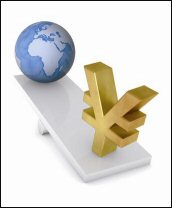 Renminbi deposits in Hong Kong are still tiny but, through Hong Kong, the mainland currency can venture out into the world Renminbi deposits in Hong Kong are still tiny but, through Hong Kong, the mainland currency can venture out into the world
From the yen’s experience, the degree of product differentiation is bound to affect how much say producers have in choosing the currency for pricing. Keen competition in homogeneous goods such as raw materials, energy resources commodities and electronic components has eroded the bargaining power of the producers. In such cases, either the importer’s currency or the US dollar will likely be adopted as the pricing currency. Promoting independent product innovation and developing home-grown technology can only help raise the competitiveness of Chinese products and lower the elasticity of demand by consumers in the export markets. In turn, Chinese exporters can gain greater bargaining power and say in using the renminbi as a pricing currency.
Currency Stability
For the renminbi to become an international currency, liberalising China’s capital account and realising the currency’s full convertibility will eventually be necessary. But it’s also important to maintain the stability of the currency’s value.
A widely fluctuating exchange rate would mean higher risks and hedging costs to trading companies, which would weaken the currency’s role as a unit of pricing. That would dampen the confidence of international investors to hold the currency and reduce its attractiveness as a reserve currency or as an investment vehicle.
Developing a currency as a medium of exchange in international trade will supplement the currency’s role as a store of value and help advance its
internationalization. Since Hong Kong started launching renminbi businesses in 2004, progress has been bright and investment vehicles in the form of renminbi bonds have been successively introduced, with the cross-boundary renminbi settlement business
liberalized.
The amount of renminbi deposits in Hong Kong is tiny compared to the mainland market. Hong Kong’s great advantage, however, is that it can take the renminbi to the world.
April 19 2011
`Hawaii of China' lures locals with rebates
By Samson Lee
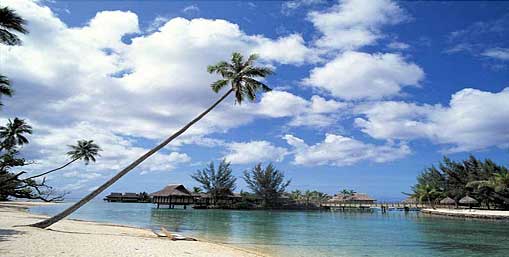
Hainan, long known as the Hawaii of China, takes on a new identity from tomorrow,
April 20 2011 as a shopping paradise. But unlike most countries that pitch their shopping to foreign tourists, it is aiming to woo a bigger market - mainland travelers.
The island's duty-free rebates to foreigners will now be offered to domestic tourists.
A total of 18 items will be exempted from consumption and business taxes and will retail at 70 percent of their original prices.
A mainland tourist will not need to pay taxes on items totaling no more than 5,000 yuan (HK$5,945) for a single trip, and can enjoy duty-free shopping up to twice a year.
The goods include watches, perfume, makeup, pens, eyewear, scarves, ties, clothes, shoes, belts, bags, candies, sporting goods, and leather, woolen and cotton products,
The aim is to attract more tourists to Hainan and boost consumption.
Paul Tse Wai-chun said he does not think the move will affect Hong Kong's reputation as a shopping paradise in Asia.
The tourism lawmaker said there are still some restrictions in Hainan while Hong Kong has a lot of international brand-name stores that are an attraction for mainland tourists.
"We also provide good customer services," he said.
Travel Industry Council executive director Joseph Tung Yao-chung said Hong Kong and Hainan offer different markets for mainlanders. "They come to Hong Kong to buy brand- name products. And they have confidence in the quality of products sold in Hong Kong," he said.
The Hainan arrangement was introduced after Beijing implemented a tax-refund program in January that allows foreign tourists, as well as Hong Kong, Macau and Taiwan residents, to obtain tax rebates of 11 percent.
Local travel agencies said there have been no obvious increase in the number of people joining Hainan tours.
"I think Hainan is a place for sightseeing instead of shopping," China Travel Service general manager Ng Hi-on said.
Lee Chung-ming, a Hong Kong resident, agrees. "Hainan is a beautiful place. I think I would go there for the scenery rather than the tax refund," he said.
April 4 2011
Legal system less arbitrary but still a work in progress - Overseas-educated lawyers bring change to mainland courts By Glen Norris and Daniel Ren in Shanghai
 Mainland courts are inching towards a system based more on the ''rule of law'', but foreign lawyers are still restricted and issues of independence, training and impartiality remain. Mainland courts are inching towards a system based more on the ''rule of law'', but foreign lawyers are still restricted and issues of independence, training and impartiality remain.
New talent and rising competition is helping to boost the transparency of the mainland's legal sector, long derided as being a Communist Party offshoot.
With foreign investors in the world's second-biggest economy demanding legal certainties for their billion-dollar projects, Chinese courts are slowly moving towards a system based more on the "rule of law" rather than on official whim.
But there is still a long way to go. For foreign lawyers working in the country, the legal system is still a closed shop in many respects; and issues of independence, training and impartiality remain.
According to a study in 2009 by the Carnegie Endowment for International Peace, the mainland's legal system remains a "work in progress" despite three decades of reform. The study found half of corporate litigants admitted to giving judges "gifts or banquets" to sway legal decisions.
But it was not all bad news - only 8 per cent of litigants who lost their case thought it was due to preferential treatment.
Increasingly, Chinese lawyers educated in the common or civil law systems of the West are rising through the ranks of the legal system. Many have degrees from universities in the United States or Britain, home to two of the most respected legal systems in the world.
 "It is a relatively young legal system," says mainland-born and US-educated Howard Wu, a partner with Baker & McKenzie in Shanghai. "But it is becoming less arbitrary and there are clearer rules and procedures that people can follow." "It is a relatively young legal system," says mainland-born and US-educated Howard Wu, a partner with Baker & McKenzie in Shanghai. "But it is becoming less arbitrary and there are clearer rules and procedures that people can follow."
Until the 1990s, legal education was not considered an important priority even as China shifted towards a market-based economy. Very few lawyers trained outside the country and most locally trained lawyers were heavily steeped in community dogma rather than legal rules and principles. Only a small minority of judges in those days had law degrees.
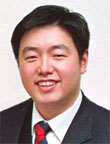 Young lawyers like Luke Zhang are at the coalface of a central government push to put more emphasis on legal training. In 2007, there were close to 600 law schools or law departments on the mainland, with nearly 300,000 students studying law. Young lawyers like Luke Zhang are at the coalface of a central government push to put more emphasis on legal training. In 2007, there were close to 600 law schools or law departments on the mainland, with nearly 300,000 students studying law.
A partner with Zhonglun Law Firm, Zhang majored in English rather than law, becoming a certified Chinese lawyer after just two years of preparation for examinations organised by the Ministry of Justice. In a sign of the heightened demand for legal talent in the world's secondbiggest economy, the ministry awarded licences to those who passed the exams, regardless of their educational background.
China has 190,000 lawyers, or one for every 6,977 people. That compares with one for every 303 in the United States.
Zhang, a graduate of Shanghai Jiao Tong University, the city's top engineering institute, specialised in English, science and technology. "Through the preparations for the exams, I acquired the basic knowledge though it was just a self-study process," Zhang said. "I felt academic points about legislation and jurisdiction were badly needed. So I continued my self-study without tutors."
Gong Zhenhua, a partner with Shanghai Ronghe Law Firm, is more frank about the shortfalls. "Education for students majoring in law is far from adequate to develop them into qualified lawyers or judges," Gong, a bachelor degree graduate from East China University of Political Science and Law, said. "I didn't understand what the basic role of a lawyer was until after graduation. I learned how to become a true lawyer through years of working experience."
Both lawyers said the mainland's legal system - particularly in the commercial area - had a lot of room for improvement.
"China has many laws that appear outdated," Gong said. "Many of the existing laws governing businesses, investment and trade were promulgated during the planned economy era and legislators failed to make proper and punctual amendments, even though we have been in a market economy for two decades."
Wu says the mainland legal system is developing rapidly, especially in the area of commercial law. The country introduced an antitrust clearance procedure for foreign company acquisitions in China in 2003 and an anti-monopoly law in 2008.
Born in Shanghai before moving to the US when he was 11, Wu says returning to his native land in 2001 was like the difference between "night and day". "I grew up in a house [in Shanghai] with American plumbing but it was circa 1948 plumbing."
The gleaming skyscrapers of 21st century Shanghai are not the only changes in the city. The legal system has also undergone an overhaul.
For a lawyer like Wu with degrees from the prestigious University of California at Berkeley, Columbia University and Fordham University School of Law, the system can still feel foreign. Unlike lawyers in the US, Australia or Britain, Chinese lawyers cannot rely on hundreds of years of precedents - judgments from earlier cases followed in later cases that make up the body of common law.
"A client will ask whether there is a precedent for something and it is difficult to advise them as you are only looking back 15 to 20 years," Wu says. Important rules on foreign joint ventures, for instance emerged only in the late 1970s and early 1980s, and the country did not have a company law until 1994.
Wu notes that a foreign lawyer on the mainland plays a more advisory role - on everything from cultural norms to the political environment. This is mainly because of regulatory restrictions that prevent them from giving formal advice in a legal capacity.
Andrew Tortoishell, managing partner for Greater China at Herbert Smith, says the mainland legal system presented a number of challenges for lawyers. "The legal system in China is evolving rapidly. Situations do arise where laws are interpreted or applied differently in different provinces," he says. "Naturally this increases the commercial risks faced by foreign investors who seek legal certainty before they make investment decisions."
But Tortoishell says the situation is improving as a new generation of lawyers start practising. "Mainland law schools are producing some very talented graduates and many are also training overseas, often in the US or Britain," he says. "A growing number are being recruited by international firms."
 David Fleming, a partner at Baker & McKenzie in Hong Kong, says as a civil system, the Chinese state plays a different role than in a common law system. "It involves a greater degree of interpretation, so the same law may be interpreted and applied differently between provinces," he says. David Fleming, a partner at Baker & McKenzie in Hong Kong, says as a civil system, the Chinese state plays a different role than in a common law system. "It involves a greater degree of interpretation, so the same law may be interpreted and applied differently between provinces," he says.
The view of the mainland's legal system as arbitrary is outdated, Fleming says, although foreign lawyers are still restricted in what they can do.
March 8 2011
 China Vanke to invest in housing for elderly
By Peggy Sito
China Vanke to invest in housing for elderly
By Peggy Sito
China Vanke, the mainland's largest developer by market value, said it planned to invest in housing developments for the elderly in light of the country's ageing population.
"The investment potential of the market is huge," said president Yu Liang at a press conference in Shenzhen. "Vanke's housing projects for seniors will be developed first in Hangzhou, Beijing and Shanghai this year."
The ageing population provided the company with a new business opportunity because the government had not provided sufficient housing for senior residents, said Yu, quoting People.com.cn, an official media outlet. But he said the company had not finalised what types of housing for the elderly would form its investments.
According to world population statistics published by the UN, the proportion of the global population over 60 will increase to 21.9 per cent from 11 per cent by 2050. In particular, the numbers of elderly will rise to 31.1 per cent of the population from 12.3 per cent over the same period.
During the next five years (2011-2015), the ageing of the mainland population is expected to accelerate, according a report on housing for the elderly published by international property consultant DTZ.
In 2010, an estimated 690,000 senior citizens lived in more than 11,000 government or government-sponsored welfare care homes. Fewer than 270,000 lived in non-profit, non-government care homes. Together that represents only 0.57 per cent of a total population of 167.14 million citizens aged over 60 in 2009.
Apart from housing for the elderly, Yu said Vanke also planned to increase the development of environmentally friendly residential properties.
Meanwhile, its contract sales surged to a record of more than 100 billion yuan (HK$118.7 billion) last year - mainly through the development of mass housing.
Results for 2010 announced on Monday showed contract sales rose 71 per cent to 108 billion yuan, making it the first mainland developer to exceed 100 billion yuan. Net profit last year grew to 7.3 billion yuan, up from 5.3 billion yuan a year earlier.
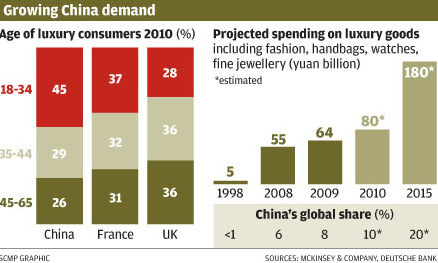 China to be world's top luxury market by 2015 By Minnie Chan China to be world's top luxury market by 2015 By Minnie Chan
A growing base of vibrant young consumers will see the mainland replace Japan as the world's biggest luxury market by 2015, comprising 20 per cent of the global market, according to a new McKinsey report on China's luxury goods consumption. The survey found that 45 per cent of luxury consumers on the mainland were aged between 18 and 34, compared with 37 per cent in Japan and 28 per cent in Britain.
"Luxury consumers in China are younger than their global peers. They are not only second-generation rich but also those born in the 1980s who are still saving for buying houses ... but they still have passion for luxury goods," Yuval Atsmon, a partner in McKinsey's Shanghai office, said yesterday.
"They are different from peer groups in Japan and other countries because they are confident and very optimistic about their financial future. In Japan, young people ... are moving away from luxury goods, while in [South] Korea, the percentage of luxury consumers is declining."
The report was based on interviews with more than 1,500 consumers in 17 mainland cities last year.
It showed that 72 per cent of wealthy luxury consumers, with annual incomes of more than 250,000 yuan (HK$296,800), believed their earnings would "increase significantly" in the next five years, 13 percentage points more than the national average.
The report estimated that in the next five years, the number of upper-middle-class households, defined as those with annual incomes of 100,000 yuan to 200,000 yuan, would increase from 13 million to 76 million.
It said luxury sales were expected to reach US$27 billion by 2015, comprising 20 per cent of the world's luxury market and surpassing Japan as the No1 luxury goods market.
Thirty per cent of respondents indicated they preferred to buy goods abroad to avoid a 20 per cent tariff. But the report said that in the next five years, the top 36 cities and 25 other developed cities would capture 74 per cent of growth in the market.
The McKinsey report also found luxury consumers were willing to buy good-quality brand names, even if they had to pay a premium price, but they were being more rational about their purchases.
"Some luxury consumers would consider their luxury goods as one of their investment tools, with some saying that they prefer to buy luxury goods with lasting value because their price won't drop or [may] even increase," Atsmon said.
Spending on luxury services such as spas, massages and other wellness activities was growing even faster, the report said. It found 20 per cent of luxury consumers said they had increased spending on such services while 13 per cent spent more on goods.
The survey findings are in line with remarks made by Commerce Minister Chen Deming on Monday. Chen said China would become the world's largest market for luxury goods in five years, adding that it would become the largest retail market in 10 years, surpassing the US.
March 4 2011
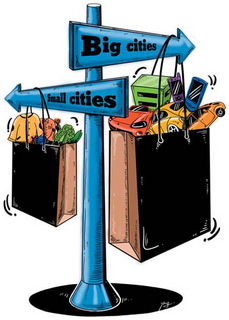 Retail giants square up for rich pickings in China
By James Sinclair Retail giants square up for rich pickings in China
By James Sinclair
Take a walk around one of Beijing's neighborhoods and you're more than likely to see a Walmart and a Carrefour, as well as many other hypermarket chains from around the world.
The hypermarket business in first-tier cities is fast reaching saturation, with fierce competition and little room left for newcomers. So retail giants are turning to China's dozens, if not hundreds, of smaller cities, tapping the retail growth that's emerging across China.
However, as global leaders move into smaller cities, transforming local retailers from traditional shops into more modern chains, they face new challenges.
All the top international chains are in China. For Walmart, Carrefour and Tesco, the world's top three players, China is now the fastest growing market worldwide.
Walmart has the largest hypermarket footprint of the three, generating 34 billion yuan (3.73 billion euros) in revenue through 189 stores in 101 cities. Carrefour has 159 stores in 47 cities and 37 billion yuan in revenue, while Tesco has 78 stores in 35 cities, generating 13 billion yuan. Many other international chains are also in the chase.
The trend is clear: International chains will expand rapidly. Tesco, for example, will likely open more floor space in China over the next five years than it has done in eight decades in its home country, the United Kingdom.
But Chinese chains still dominate the domestic market. Among them are China Resources Vanguard (CRV) and Lianhua Supermarket, among China's top five retail groups.
CRV generated 72 billion yuan in revenue in 2010 from 3,200 stores in more than 100 cities. In the past year, CRV opened more than 450 stores, including 60 large supermarkets. It plans to open 400 more this year, including 70 to 80 large supermarkets.
And the Chinese chains are becoming much more sophisticated when it comes to shopper experience.
Beijing Hualian Supermarket, one of China's top 20 chains, is among the most forward thinking. It is now seeking to differentiate against its international and domestic peers by developing a deeper understanding of the Chinese shopper and providing them with a better shopping experience.
Yet while the stronger Chinese chains are moving to better compete in bigger cities, international chains are heading into smaller cities. One of the most successful has been RT-Mart, the joint venture between Taiwan-based Ruentex Group and the Auchan Group from France.
RT-Mart enter China in 1997, a few years after Carrefour, with an astutely tailored approach. And instead of concentrating on bigger cities, RT-Mart secured prime properties in smaller cities. The result: RT-Mart recently surpassed Carrefour to become the largest international chain in China by retail sales.
However, Chinese chains are strongest in the smaller cities, with chains such as CRV and Lianhua Supermarket having grown from provincial strongholds. And they are still in the process of building national coverage.
For example, CRV has more than half of its stores in East China's Jiangsu province alone. This pattern is reflected in most provinces, with scores of regional chains growing from their provincial base. They tend to have about 100 outlets and revenues in the region of 1 billion to 5 billion yuan.
Behind them are hundreds of local chains growing from their municipal bases, often with 20-100 outlets and revenues ranging from 100 million yuan to 500 million yuan. Other chains may have just a handful of outlets in one or two cities.
As the international chains penetrate smaller cities, they will face these regional players, which are even moving into first-tier cities to compete against national and international chains. These regional chains are seeking to learn from their more sophisticated international and national counterparts, and a new source of global expertise has arrived in China to do just that.
The Independent Grocery Association (IGA), a US-based association of regional hypermarket and supermarket chains, recently established a chapter in China, with 20 members operating 2,500 stores so far.
IGA has started to train members, joining the University of Wuhan to establish an IGA Institute and cover modern retail management disciplines. IGA is also starting to use the combined scale of its members to generate greater negotiation power over suppliers than individual chains would have alone. Given this support, IGA will be an important force in the shaping of China's retail environment over the coming decade.
Another force will be acquisitions and consolidation. In addition to the normal consolidation drivers, such as achieving economies of scale, securing prime locations will be a critical driver for the chains.
And the best locations are in crowded urban cores, close to dense residential neighborhoods and commercial complexes. Clearly there are a finite number of these sites, and as regional chains have been in the smaller cities for more than a decade, they already occupy them.
In the past, international chains used their joint venture partners to leverage local relationships and gain access to good locations. At present, we are seeing the chains forming strategic relationships with property developers, or investing in commercial complexes - all with the intention of their stores becoming anchor tenants.
Another strategy is to acquire regional chains and their prime locations. This will bring two benefits. First, acquisitions will provide premium hypermarket players with new formats and brands, allowing them to play in smaller formats and mid-level positions better suited to smaller cities.
Second, acquiring chains will come with local know-how, including an understanding of brand preferences and consumer behavior in each province or city. Carrefour is a case in point. In July last year, Carrefour acquired 51 percent of Hebei Baolongcang, which operates 14 hypermarkets, mainly in smaller cities, recording net sales of 1.06 billion yuan in 2009. Now, the chains - which are focusing on China's next 600 cities - may soon have to start thinking about China's thousands of towns.
The author is managing partner and a consumer and retail specialist at InterChina Consulting, a strategy and M&A advisory firm headquartered in China.
February 28 2011
Gaokao trainers foresee a bright future By Huang Ying
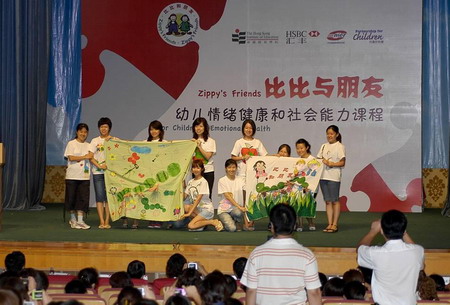 A large billboard stands in the lobby of a Beijing training organization advertising various educational programs for high school students to study at overseas universities. A large billboard stands in the lobby of a Beijing training organization advertising various educational programs for high school students to study at overseas universities.
Demand rises for classes in how to excel in the national college exam
BEIJING - With the beginning of a new semester, many education-training agencies are seeking to boost their profits by offering courses designed to better prepare students for the upcoming 2011 gaokao, or national college entrance examination, held in June.
"The college entrance examination is a very big thing for Chinese students. Parents and students alike are willing to invest as much as they can to get a good result," said Luo Ping, director of U-Can Middle School Education Center, operated by New Oriental School in Beijing.
The number of students scheduled to take the college entrance exam started to fall in 2009. It decreased from 10.5 million in 2008 to 9.46 million in 2010, according to statistics from the Ministry of Education.
However, the supplementary education market for senior high school students remains confident about its prospects.
New Oriental School is one of the top brands in English training on the Chinese mainland and it entered the area of supplementary education for middle and high schools in 2007 with the establishment of U-Can Middle School Education Center.
"We saw a 30 percent to 50 percent annual average growth in profits from 2007 to last year in this section," said Luo, adding that parents' growing expectations for their children's performance in the gaokao spurred a family's investment in education.
The huge demand attracted many others to the market. Global Education & Technology Co Ltd began college entrance examination training in December 2009, three years after it was established, and had provided gaokao-oriented education services to more than 300 students by the end of 2010.
The education institution offers one-to-one tutoring services as its major business. It will expand classes this year as more and more students are registering for its gaokao-oriented courses.
"We received 15 million yuan ($22.5 million) in revenues in this part of our business last year, and I expect it to increase to 30 million yuan this year," said Chen Tianfu, director of the operations department at Global Education & Technology Co Ltd.
Teachers may be the most valuable assets for a training agency because they have direct influence on the final results of students' grades in the gaokao. Generally, these teachers are from public high schools or are full-time training teachers.
Chen said that his company's more-than-200 teachers tutoring senior high school students are from various public high schools in the city, which he said was a guarantee that they could always get first-class educational materials and information about the gaokao.
"Years of experience in the field has also enabled them to better understand the exam system," he added.
At New Oriental School, one-third of its teachers are from public high schools, one-third of them are full-time professional-training teachers, and the rest are teachers it trained, most of whom are originally overseas students or graduates of prestigious universities in China.
"I have more confidence in teachers from key public high schools," said Shi Shigang, father of Shi Di, a senior student of the high school affiliated to Renmin University of China in Beijing. Shi paid 400 yuan an hour for his daughter's supplementary maths course provided by a teacher from Beijing No 4 High School.
The cost of gaokao-oriented supplementary education varies according to the types of classes chosen.
At Global Education & Technology Co Ltd, the average cost is 230 yuan an hour for a one-to-one tutoring service, rising to 350 yuan to 400 yuan for teachers from key high schools.
At Juren Education Group, one of the top private education brands in China with its focus on primary, middle and high school students' education, the average cost for a one-to-one tutoring service is between 300 yuan and 500 yuan an hour.
Juren was founded in 1994 and launched in the gaokao-oriented supplementary education sector in 2000.
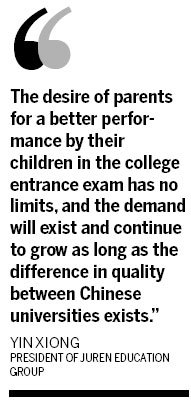 "The average annual spending on a student's supplementary education for a college entrance exam surged from 2,000 to 3,000 yuan in 2000 to 15,000 yuan nowadays," said Yin Xiong, president of Juren Education Group. These training institutions all believe the market holds great promise. "The average annual spending on a student's supplementary education for a college entrance exam surged from 2,000 to 3,000 yuan in 2000 to 15,000 yuan nowadays," said Yin Xiong, president of Juren Education Group. These training institutions all believe the market holds great promise.
"The desire of parents for a better performance by their children in the college entrance exam has no limits, and the demand will exist and continue to grow as long as the difference in quality between Chinese universities exists," said Yin Xiong.
Although many private education organizations of all levels have now entered the market, there will be a trend toward integration, said Chen from Global Education & Technology Co Ltd.
Global Education & Technology acquired two small private education organizations at the end of 2010. One of them had been in operation for seven years.
"I think the whole market will become more mature because parents are showing a more rational attitude in making their choices," said Luo from New Oriental School.
In order to differentiate itself from competitors in the market, New Oriental School provides an assessment service for students who are considering whether to sign up for its U-Can Middle School Education Center.
The assessment system could help students better understand their abilities, so that they could select the appropriate classes for themselves. The assessment also acts as a reference for the teachers who are designated to tutor them.
February 6 2011
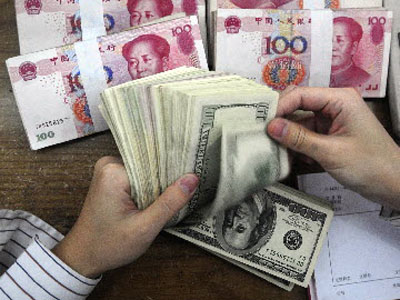 Look out, dollar. Watch it, yen. The yuan is going global By Ed Zhang in Beijing Look out, dollar. Watch it, yen. The yuan is going global By Ed Zhang in Beijing
Moves towards yuan convertibility begin to pick up pace - The "internationalisation" of China's currency is expected to be a highlight of Premier Wen Jiabao's speech for China's 12th five-year plan, during the nation's annual parliamentary session in Beijing next month.
The groundwork for the acceleration of the currency's emergence on the world stage was laid two months ago when the central bank - the People's Bank of China - stated that the nation "has good reason to expand its opening-up of capital accounts in the mid-term".
The opaque language was interpreted by currency managers as a sign the bank was looking at making the yuan internationally convertible. And though "mid-term" wasn't clearly defined it is commonly used by mainland economic planners to refer to a five-year period.
In short, the central bank seemed to be setting its sights on full convertibility of the yuan by the end of the coming five-year plan, or at the end of 2015.
The intense anticipation in the market means the internationalisation of the yuan will be one of the biggest global trends to watch this year, according to Nariman Behravesh, chief economist from HIS Global Insight.
Speaking at the World Economic Forum in Davos last month, he warned, however, that it would take "some years" for a freely convertible yuan to be traded on par with the likes of the US dollar, the euro or the yen.
Rather than a big bang, currency reform is likely to be incremental and gradual. But the subtle change in language suggests the process may unfold in accelerated fashion.
Until the second half of last year mainland officials preferred to use the term "regionalisation" rather than "internationalisation" when discussing the yuan's future status, said Jing Ulrich, JP Morgan's chairman of China equities and commodities.
Restrictions on the use of the yuan to settle foreign trade deals were lifted last June. A month later, the central bank issued a memorandum of co-operation with the Hong Kong Monetary Authority, allowing companies to set up commercial yuan business in the city and open yuan accounts and trade the currency in Hong Kong without limit.
The changes strengthened Hong Kong's position as China's offshore yuan centre, Ulrich said.
Now a new chapter beckons for Hong Kong's financial industry as it leverages its connection with mainland China and the global market; its rule of law; and its rich talent pool, said Robert Subbaraman, chief Asia economist of Nomura. By the end of last November, yuan-denominated trade settlements in Hong Kong had reached 385 billion yuan (HK$456.32 billion), and Qu Hongbin, chief economist for China at HSBC (SEHK: 0005, announcements, news) , predicted that by 2016 one third of China's cross-border trade would be settled in yuan.
Hong Kong's yuan deposit base, currently at around 300 billion yuan, would reach more than 2 trillion yuan in 2013, according to a projection by Deutsche Bank economist Ma Jun. As mainland banks continue branching out in North America and western Europe, yuan-denominated security and investment products are also going to become more diversified and popular, he added.
The first yuan-denominated bonds were issued in Hong Kong in the second half of 2010 and issues now total 30 billion yuan. Ronald Wan, the investment executive of China Merchants Securities, predicted that figure could rise to between 45 and 50 billion yuan by the end of this year.
The Stock Exchange of Hong Kong is meanwhile preparing for the issue of yuan-denominated shares. Expectations in the mainland financial service sector are that the first yuan-denominated shares will be issued in the middle of this year.
And the next thing to come, financial service executives say, will be an increase in yuan-denominated funds.
"Once yuan stocks are issued, yuan funds will have to follow in due course," said a senior manager of CICC, a Beijing-based brokerage with international operations.
Ann Wyman, Nomura's London-based emerging markets specialist, said her clients in the Middle East - especially managers of sovereign funds - are eagerly anticipating the issue of yuan-denominated low-risk assets to offer alternatives to US treasury bills.
Many have already set up beachheads in Hong Kong, she added, waiting for investments.
Yuan internationalisation was interrupted by the global crisis in 2008, said He Jun, senior economist of Beijing-based Anbound, a non-governmental consulting service.
He said, however, that circumstances now favoured an acceleration of that process.
January 28 2011
Pushing their duck - Hong Kong restaurateurs are helping to redefine Beijing's dining scene By Mark Graham
It takes entrepreneurial effrontery to open a restaurant in Beijing offering a Cantonese reinterpretation of the capital's most iconic dish, Peking duck. Still, the gamble by Hong Kong restaurant group Elite Concepts has paid off in a big way - its gourmet restaurant, Duck de Chine, is packed every night with locals and visitors. There, the duck is roasted over a fruitwood fire in the classical way, but sauce options include herb-infused hoi sin with peanuts, garlic or sesame. French music plays in the background and a champagne bar greets diners at the entrance.
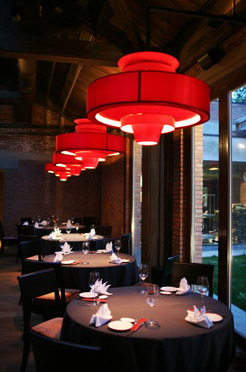 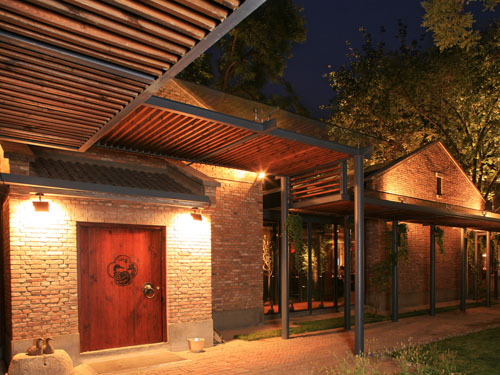 Duck de Chine is among several innovative Hong Kong-run ventures that are helping to redefine the Beijing dining scene. The 2008 Olympic Games sparked a culinary revolution that is still transforming the once-dull capital. Although Hong Kong restaurateurs are by no means the only ones introducing new concepts to Beijing, they operate some of the most high-profile venues. Duck de Chine is among several innovative Hong Kong-run ventures that are helping to redefine the Beijing dining scene. The 2008 Olympic Games sparked a culinary revolution that is still transforming the once-dull capital. Although Hong Kong restaurateurs are by no means the only ones introducing new concepts to Beijing, they operate some of the most high-profile venues.
Several are located at Opposite House, a stylish, minimalist, lobby-free hotel owned by the Swire group (SEHK: 0019). Sureno, the hotel's open-plan, light-flooded restaurant, is a
favorite with the art, fashion and design crowd; Bei restaurant's Japanese and northern Chinese dishes, prepared by an American chef, has a coterie of fans.
 "There are just so many more options these days in Beijing, upscale and international-inspired things," says the restaurant and bar manager of Opposite House, Milan Sekulic. "Investors are prepared to put more money into the design to give things a much more contemporary style. The whole feel of the city is becoming more international." "There are just so many more options these days in Beijing, upscale and international-inspired things," says the restaurant and bar manager of Opposite House, Milan Sekulic. "Investors are prepared to put more money into the design to give things a much more contemporary style. The whole feel of the city is becoming more international."
That growing cosmopolitan awareness inspired advertising executives Patrick So and Ellis So (no relation) to launch an upscale burger bar, convinced that expatriates and locals would pay HK$80 for a top-quality burger and french fries.
The pair enlisted Danish-Chinese chef Kevin Lam as the third partner in Let's Burger, located on lively Nali Patio in the nightlife zone of Sanlitun. "We both like burgers but to find a decent one in Beijing you had to eat in a hotel, so we thought opening a burger shop would be a good opportunity," says Patrick So. "It is a simple idea - burgers are simple - and we offer a cosy environment where people can sit and chat with friends."
But running the eatery, which cost about HK$1 million to set up, has been challenging. "We were naive before opening: we thought we would be able to sit and enjoy a glass of wine and talk to people but that is not the case," Patrick So says. "In the food and beverage business you have to work hard; you have to put everything into the restaurants - time and money."
Their burgers, made with Australian meat, organic lettuce and tomato and thick-cut fries, and served with a range of sauces such as wasabi mayonnaise, have proved hugely popular.
Buoyed by that success, the pair went on to open Let's Seafood in an adjoining space. Its menu features such items as classic English-style fish-and-chips and Thai-style fish curry. Prices there are higher, with customers spending an average of HK$150 per head.
"There were no seafood restaurants like this in Beijing" says So. "It was more expensive and more difficult to source the seafood we wanted but our aim was to provide good food at a reasonable price; there are plenty of people in Beijing with money to spend on quality food."
Tom Pattinson, a British entrepreneur and long-time Beijing resident who runs the annual Affordable Art fair, appreciates the improved options.
"A lot of restaurants opened for the Olympics and the dining scene skyrocketed, but now it has levelled off and the best operators have been left standing. In recent years, we have also seen the rise of the value restaurant. At the top end, Duck de Chine is always on my personal list for entertaining people; it is a special restaurant but can be affordable if you don't go for really expensive wines," Pattinson says.
"If you live a local lifestyle in Beijing it can still be incredibly cheap. You can spend 20 yuan (HK$24) to 40 yuan a head and it will be decent food."
One downside for restaurateurs is the Beijing weather, which makes often generous patio space unusable for much of the year. The extreme cold in winter and the stifling heat and buzzing mosquitoes during the midsummer months make sitting out impossible.
Finding capable staff is also difficult. "In Hong Kong two guys take care of eight tables and do everything," So says. "Here, you have to ask three people to take care of six tables. They are learning fast but one of our main problems is turnover. People just change all the time and salaries in Beijing are rising fast, especially at Sanlitun."
Drilling staff to the service levels that are the norm in Hong Kong is an ongoing process at Duck de Chine. "Most of the staff now understand the Hong Kong hospitality style," says director Amin Yip. "We want them to have a passion for service we try to train them so they can understand the Hong Kong way by using the magic words like `Thank you'. We put a lot of effort into it."
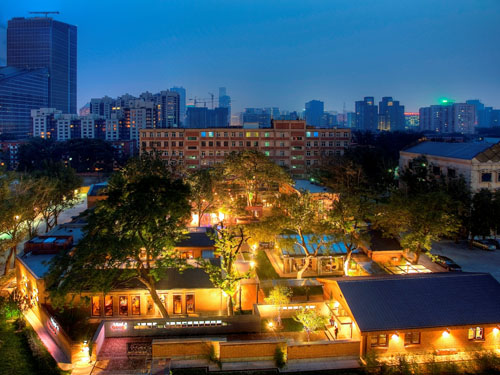 Duck de Chine is among several outlets that Elite runs in a converted machinery factory compound, now known as 1949 - The Hidden City. Diners enter the 60,000 sq ft complex via an art gallery, before making their way through a garden to the Japanese, Mediterranean and Peking duck restaurants. The compound also features a tiny noodle bar that seats just 12 people and, in summer, an outdoor bar. Duck de Chine is among several outlets that Elite runs in a converted machinery factory compound, now known as 1949 - The Hidden City. Diners enter the 60,000 sq ft complex via an art gallery, before making their way through a garden to the Japanese, Mediterranean and Peking duck restaurants. The compound also features a tiny noodle bar that seats just 12 people and, in summer, an outdoor bar.
Chien'men 23, a cluster of outlets occupying the former American diplomatic complex just off Tiananmen Square, was set up on a similar concept with high hopes it would attract food-lovers. But the operation has been less than successful: Hong Kong-based Aqua group, one of the flagship tenants, closed its Japanese restaurant, lounge and rooftop bar and relocated its Spanish restaurant, Agua, to bustling Sanlitun.
Across the street, however, a venture by Michelle Garnaut attracts patrons who pay upwards of HK$550 a head for a three-course Mediterranean-style meal with wine. Capital M has become a
favorite among diplomats, businessmen, expatriate residents and affluent locals alike. The food is dependable, the decor elegant and the location stunning, with terrace views towards Tiananmen Square.
"Timing is crucial with opening a restaurant - having the right thing at the right time," says Garnaut, who launched M at the Fringe in Hong Kong and M on the Bund in Shanghai.
"We painted ourselves into a corner with M on the Bund because the expectation was that our next place would be spectacular. I think we have delivered on that in Beijing, but it took seven years to find the right place. It is a fabulous location.
"People in Beijing are not the going-out type and they don't like to spend money like people in Shanghai and Hong Kong. They are still extremely price-conscious. It is also a city that is hampered by the traffic, weather and politics."
Master chef Jereme Leung, who learned his trade in Hong Kong, also established a restaurant in Shanghai before opening the Whampoa Club in a converted merchant's house in Beijing. Leung dreams up unusual combinations such as bean curd and vegetable roll with foie gras terrine, Beijing-style pork and bean jelly, and cheesecake with Beijing pea custard.
For all their entrepreneurial verve, the trailblazing restaurateurs face many challenges in Beijing, not least among them opaque rules and niggling bureaucracy.
"It is an expensive place to do business - rents are expensive and salaries are expensive. We are doing fine, but it is not an easy business environment," Garnaut says.
Still, the potential of an increasingly affluent city of 20 million people continues to attract adventurous restaurateurs. Food writer Lillian Chou reckons Hong Kong operators have a head start over rivals from the United States, Europe or Australia because they are used to Chinese and Western ways of running businesses.
"They have been working both sides for ever and are familiar with China," says Chou, an American.
Bei: The Opposite House, 11 Sanlitun Lu, Chaoyang, Beijing; tel (10) 6410-5230, 6410-5230
Capital M: 3/F, No.2 Qianmen Pedestrian Street; tel (10) 6702 2727.
Duck de Chine: Courtyard 4, Gongti Beilu, Chaoyang, Beijing; tel (10) 6501-1949
Let's Burger: D101a, Nali Patio, 81 Sanlitun Beijie, Beijing; tel (10) 5208-6036
Whampoa Club: 23A, Jinrong Jie (bet. Fuxingmennei Dajie & Guangningbo Jie) tel (10) 8808-8828
Afternoon tea memories add zest to Cambridge graduate's bakery
Lexie Morris could have had a promising corporate career in London. Instead, the neophyte businesswoman, who was born in Hong Kong and went to school here, gave it all up to start a cupcake business in Beijing.
"After university, I got a job at a strategy consulting firm in London. I was the highest-paid graduate coming out of my year, but I absolutely hated it," she says.
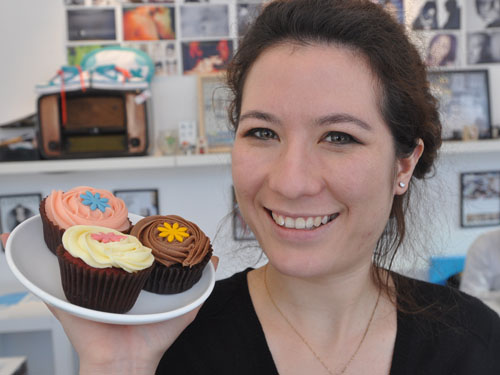 But Morris, 25, who had studied in Beijing as part of her degree in Chinese studies at Cambridge University, figured there would be a market in the Chinese capital for properly made, prettily packaged cupcakes and relocated to launch her venture. But Morris, 25, who had studied in Beijing as part of her degree in Chinese studies at Cambridge University, figured there would be a market in the Chinese capital for properly made, prettily packaged cupcakes and relocated to launch her venture.
"The idea for cupcakes came from going for high tea in London, to the Ritz or Fortnum & Mason. I also knew how successful the Peninsula in Hong Kong was with its afternoon tea," says the keen baker. "I knew from experience that Beijing did not have anything like that - one thing I hated about the city when I was there as a student was that there was no cake." Morris did all the baking out of her 800 sq ft flat when she set up Lollipop Bakery (www.lollipopbakery.cn) a year ago. Her biggest expenses at the time were rewiring the place to cope with an electric oven in constant use and placing an order for 10,000 packaging boxes (the minimum her supplier would accept).
"At first it was just an order a day, and then it really began to snowball," she says. "Since last September, it has been insane - I get orders from individuals and also supply coffee shops. I have never done any advertising or marketing; it is all word of mouth."
With the business expanding, Morris (pictured) has since moved into commercial premises and hired three full-time workers. A standard order of 24 mixed cupcakes costs about HK$220, with a choice of chocolate, vanilla, Earl Grey, spiced carrot, red bean, cookies and cream, black sesame and red velvet flavours. The bakery also customises the cupcakes with inscriptions for birthday parties or other special occasions.
Morris's base in Beijing makes it convenient to meet her father, a civil engineer, when he visits Hong Kong as a designer on the new bridge linking the city with Zhuhai. Martin Morris worked on all three cross-harbor tunnel projects and met his wife, Fifi Chan Lai Thiong, while posted to Hong Kong.
Lexie Morris has clearly inherited her Cantonese mother's entrepreneurial genes. "Right now, I am really engaged with what I am doing," she says. "I find it really satisfying when compared to the corporate world. I feel I am creating something. I have to decide where to go from here, whether to hand over day-to-day control, do a coffee shop or franchise it."
January 27 2011
US will lose business if export controls remain in place
By Ding Qingfen
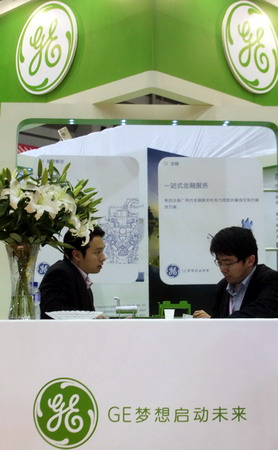 The United States will probably allow huge business opportunities to go to European Union (EU) countries and Japan if it refuses to rescind controls on exports to China as soon as possible, according to Chinese government officials. The comments came at a monthly forum on China-US Economic Relations held by the China Center for International Economic Exchanges (CCIEE) - a high-level business thinktank - on Wednesday. The United States will probably allow huge business opportunities to go to European Union (EU) countries and Japan if it refuses to rescind controls on exports to China as soon as possible, according to Chinese government officials. The comments came at a monthly forum on China-US Economic Relations held by the China Center for International Economic Exchanges (CCIEE) - a high-level business thinktank - on Wednesday.
Wei Jianguo, a former vice-minister of commerce, and now secretary-general of the CCIEE, urged the US to quickly reduce restrictions on high-tech exports to China in a bid to narrow the trade surplus, an issue that has become central to bilateral trade conflicts.
"The sooner the US does it (loosens the restrictions), the more leverage it will gain in the future and the more commercial benefits it will gain otherwise, the business opportunities (in terms of high-volume Chinese imports of high-tech products) will naturally slip away to other nations, including those in the EU and Japan," said Wei.
During the 3rd China-EU High-Level Economic and Trade Dialogue held in Beijing in December, the EU agreed to set up a working panel to examine boosting high-tech sales to China.
A meeting on the issue is expected to be held early this year, after the two sides reached a consensus on increasing cooperation on high-tech trade.
China has a large trade surplus with the US, which the US attributes to the yuan being undervalued.
China denies this, and says that the best way to promote Chinese imports is for the US to abandon its restrictions on high-tech exports.
The export of high-tech products to China, for both military and civilian use, has long been forbidden by the US despite repeated calls for change. During President Hu Jintao's four-day visit to Washington last week, China again made a proposal on the issue during the bilateral high-level meeting.
Although China signed a series of agreements on purchasing US goods worth as much as $45 billion, no progress was made on the issues of export controls.
"China and the US have been cooperating well, but US export controls are a big problem in bilateral economic relations," said Sun Zhenyu, the former Chinese ambassador to the World Trade Organization, at the forum.
"US exports to China would easily increase if such a restriction did not exist."
Some US companies have also agreed with that statment.
"The US government has to look at reducing controls, because erecting barriers cannot be the answer to US need to create jobs and prosperous growth," said Mark Norbom, president of General Electric China.
GE, the largest US industrial company by market value, announced a number of deals with Chinese groups last week that will create about 4,500 jobs in the US, including the formal signing of a joint venture agreement with the Aviation Industry Corporation of China to set up a 50-50 joint venture to provide avionics for the new Chinese C919 airliner.
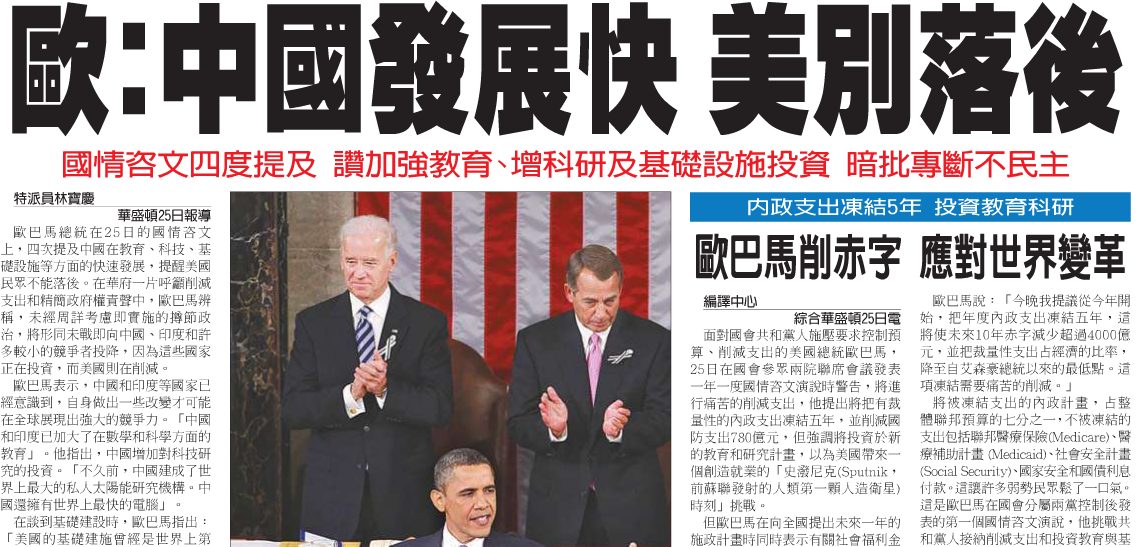

January 26 2011
World’s Most Globalised Economy
Hong Kong has topped the list in a global ranking of the world’s 60 largest economies. Hong Kong, one of only two Asian economies to place among the study’s top 10, was cited as the most
globalized economy for doing business.
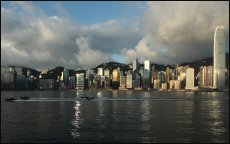 Hong Kong has been ranked the world’s most
globalized economy in the latest Globalization Index survey by Ernst & Young Hong Kong has been ranked the world’s most
globalized economy in the latest Globalization Index survey by Ernst & Young
Hong Kong is leading the world in the trend towards globalization, particularly in the exchange of goods, capital and labor. That’s the conclusion of a new study from the global advisory services firm Ernst & Young, in association with the Economist Intelligence Unit. Its findings show that Hong Kong in 2010 embraced the highest level of
globalization among 60 of the world’s largest economies.
“Hong Kong is playing a very significant role in the world,” said Agnes Chan, Ernst & Young’s Regional Managing Partner, Hong Kong and Macau. “China now is the second-largest economy in the world. Investors regard Hong Kong as the gateway to enter and invest in mainland China, while Chinese enterprises view Hong Kong as a springboard to expand into the international market.”
The Globalization Index tracks and measures the performance of the world’s 60 largest economies, based on 20 indicators of cross-border business integration. The indicators fall into five broad categories: openness to trade; capital movements; exchange of technology and ideas; movement of
labor; and cultural integration. The Index measures relative rather than absolute
globalization, meaning that the five categories are measured relative to the economy’s GDP.
The 2010 index is based on a survey of 1,050 global senior business executives and in-depth interviews with 20 senior executives and high-level experts.
Embracing Globalization
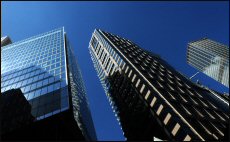 Hong Kong’s rule of law, transparency and availability of talent make it an especially attractive base Hong Kong’s rule of law, transparency and availability of talent make it an especially attractive base
Rounding out the top three was Ireland, which scored highest on technology, and Singapore, which dropped from number one to number three.
“Significantly, two out of the top three economies are from Asia-Pacific, which shows how the region is embracing
globalization,” Ms Chan said. “It also demonstrates how these economies are willing to stake their economic legacies on creating the right environment to facilitate the freedom of movement of goods, people, capital and ideas.”
According to Ms Chan, Hong Kong ranked top in the areas of openness to trade, movement of capital and finance and cultural integration. But she noted that the city lags behind in the areas of exchange of technology and ideas, and in net labour migration. The group proposed that the Hong Kong Government introduce business tax and financial incentives to encourage investments in innovation. The report also called on the Government to improve the environment and education system in order to attract talent to Hong Kong.
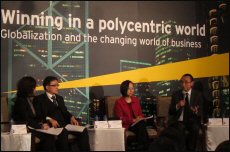 Experts discuss the merits of doing business in Hong Kong at the unveiling of the Globalization Index survey Experts discuss the merits of doing business in Hong Kong at the unveiling of the Globalization Index survey
To maintain Hong Kong’s edge, business operators also stressed the importance of continuing to provide a free operating environment. “To retain the number-one position is to have an all-embracing attitude in areas such as trade openness, exchange of culture,” said Tony Tsoi, CEO of Varitronix International Ltd.
As a gateway to China, Mr Tsoi said Hong Kong’s advantage is “indisputable.”
But the challenge, according to Mr Tsoi, is to raise the bar higher. “Hong Kong’s advantage over other economies is that being able to base in Hong Kong is an assurance of quality. So it’s all the more important at this juncture not to be lax in our standards, and to raise the quality even higher,” he said.
International firms are taking heed. According to Invest Hong Kong, 280 regional headquarters set up in the city last year. Hong Kong’s rule of law, transparency and availability of talent make Hong Kong an especially attractive base, according to David Wong, Deputy Chief Executive of the Bank of China Hong Kong. He said that Hong Kong’s role as a renminbi offshore centre will also enable the creation of innovative financial products in the city. But he added that Hong Kong companies must remain responsive to customer needs and stay sensitive to regulatory changes.
Localizing Strategy
The study noted that globalization is now spread more evenly between developed and emerging economies. But while access to markets, talent and technology is easier thanks to
globalization, the study showed that the pace of recovery and growth, as well as business environments and customers needs, differ.
Those two developments raise the importance of having a globalized team that understands the needs of the local market, according to Ernst & Young. It also advised business from developed countries to pay greater attention to policy issues when expanding into emerging markets, where governments play a prominent role in business.
January 19,
2011
US, China Make
Progress on Procurement, IPR Issues; Announce Export and Investment Deals
US President Barack Obama and PRC President
Hu Jintao emphasized cooperation on the economic, security, and political
issues facing both countries at a joint
press conference at the White House Wednesday afternoon. In addition
to announcing billions of dollars worth of business deals, US and PRC government
officials also announced potentially important progress on China's government procurement
policies and intellectual
property rights (IPR) protection.
According
to a joint statement released by the White House today, China agreed to delink its innovation policies from
government procurement--a top US-China Business
Council (USCBC) advocacy priority for the Hu visit. "We're
making progress on making sure that the government procurement process in China is open and
fair to American businesses," Obama said at the press conference. "And
we've made progress as a consequence of this state visit."
China also bolstered
its IPR protection commitments by agreeing to audit the use of legal software in
government offices and
publish the results of those audits. The commitment goes a step further than the
agreement at last December's Joint
Commission on Commerce and Trade meeting, at which China only agreed to
ensure that its government uses licensed software. China also agreed today to
submit a revised offer to join the Government Procurement Agreement to include purchases
by central government and
sub-central entities.
Companies from both
countries signed several lucrative business deals, including a $19 billion deal
to sell 200 Boeing airplanes to China over the next three years. The White House
said that the deals are worth more than $45 billion in increased US exports that
"will
help support an estimated 235,000 jobs in the United States."
Earlier in the day,
Obama welcomed Hu with a ceremony
on the south lawn of the White House. Obama
and Hu also attended a meeting of Chinese and American business leaders
that included four USCBC board members--Coca Cola Co.'s Muhtar Kent, Dow Chemical Co.'s Andrew Liveris, Boeing Co.'s Jim McNerney, and
Motorola Solutions' Greg Brown.
At a luncheon for Hu
hosted by Vice President Biden and Secretary of State Hillary Rodham
Clinton, Biden announced that he would visit China this year and will
invite PRC Vice President Xi Jinping to visit the United States.
US and PRC government officials participated in a number of
events related to Hu's visit Wednesday.
-
US and PRC
government officials participated in a forum hosted by USCBC, the China Council for the Promotion of
International Trade (CCPIT), and the US Chamber of Commerce. USCBC
and CCPIT signed an agreement to continue "Invest in America"
programs.
-
US Energy
Secretary Steven Chu
announced the signing of a five-year work plan to develop the $150 million US-China Clean Energy Research Center. The
center will initially focus on energy efficiency, clean coal, and clean vehicle
technology research.
Tomorrow Hu will
make the major policy speech of his visit at a luncheon
hosted by USCBC and the National Committee on US-China Relations
before departing for Chicago. He will meet in the morning with members of Congress, including
House Speaker John Boehner
and Senate Majority Leader Harry Reid.
Related links
January 7 2011
Ministry tries to clear up VoIP confusion
By Wang Xing
 Skype introduces its voice over Internet protocol (VoIP) telephone services on a telecommunication products fair in Nanjing, Jiangsu. Since 2005, Chinese authorities have permitted only China Telecom and China Netcom to operate pilot VoIP services in four cities. Skype introduces its voice over Internet protocol (VoIP) telephone services on a telecommunication products fair in Nanjing, Jiangsu. Since 2005, Chinese authorities have permitted only China Telecom and China Netcom to operate pilot VoIP services in four cities.
In a move that has confused China's telecom industry as well as Skype users in the nation, the Ministry of Industry and Information Technology said it has always been supportive of Internet-based telephone services, a remark that contrasts with a Dec 10 notice by the ministry.
Last month, the ministry issued a notice calling for a crackdown and ban on illegal voice over Internet protocol (VoIP) telephone services in China. The announcement, which many believe was designed to protect the interests of State-owned telecom carriers, has sparked concerns that companies such as Skype will be forced out of China.
But during a recent telecom industry conference, Wen Ku, director of the ministry's technology department, told China Daily that the ministry is not against Internet-based telephone services, "but only those operating illegally in the country".
"VoIP phone service is a world trend in the telecom industry. We are not against that technology," Wen said.
Industry experts told China Daily that Wen's remark is a possible sign that the ministry may not execute its crackdown or ban.
Wang Lijian, ministry spokesman, told China Daily on Wednesday that the "whole issue is over". He refused to comment on whether the ministry will adopt any measures to crack down on Skype.
But what constitutes a legal or illegal VoIP service is hazy at best. The ministry on Dec 10 called for a crackdown "on illegal VoIP telephone services" and said it was collecting evidence against them.
At the conference, Wen would not define what an illegal VoIP service is but noted that the crackdown is mainly to fight online crimes and fraud done through VoIP services.
Since 2005, Chinese authorities have permitted only China Telecom and China Netcom, which merged with China Unicom, to conduct trial VoIP services in four cities. Experts say that this rule technically means that all VoIP phone services provided by other companies are illegal, said Wang Yuquan, senior consultant with research firm Frost & Sullivan in China.
The pilot programs by China Telecom and China Unicom never happened, while so-called illegal VoIP services have grown rapidly over the years.
"I think the Chinese authorities will be extremely cautious in dealing with the regulations to avoid raising international concerns," said Kan Kaili, a professor at the Beijing University of Posts and Telecommunications.
Kan, a former official in China's telecom regulation agency, said Chinese telecom regulators don't want to see another foreign firm forced out of China, especially after the Google debacle.
That doesn't mean Chinese State-owned telecom carriers are not worried. Many carriers, experts said, fear that the rapid expansion of third-party VoIP providers will threaten their revenue from long-distant calls.
Skype's partner in China, TOM Group, said earlier this week that the Web-based calling service complies with the Chinese law.
A TOM Group spokeswoman said that "the operation of Skype in China is compliant with local laws and regulations" and "it is business as usual".
Chinese users currently have no problems accessing Skype.
Hong Kong billionaire Li Ka-shing owns 51 percent of the TOM Group. In 2004, the company launched a partnership with Skype to provide a customized, simplified Chinese version of Skype in China. The two companies established a 51-49 joint venture in 2005 to expand their partnership.
The two announced in 2005 that the co-branded software attracted over 3.1 million registered users in China, making the country one of Skype's top three markets.
December 24 2010
Made in China iPhone give a bilateral surplus of US$48 million in favor of the USA
by Tom Holland
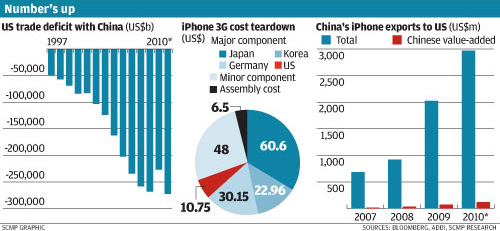
One of the most popular presents in American stockings this Christmas will be Apple's sleek new iPhone. But although the fortunate recipients will no doubt be delighted when they unwrap their iPhones tomorrow, a good many Washington politicians will be incensed.
What gets their goat is that Apple's iPhones are made in China. As a result, for every iPhone sold in America this Christmas, the US trade deficit with China will go up by around US$170. (Actually that figure is based on an iPhone 3G. For each iPhone 4, the US deficit goes up a shade more).
Considering Apple is forecast to sell almost 16 million iPhones in the US this year, that deficit soon mounts up. Altogether iPhones are likely to contribute almost US$2.7 billion to this year's US trade deficit with China, which is on target to hit a record US$270 billion (see the first chart). That means iPhones alone will account for 1 per cent of the bilateral trade imbalance in 2010.
No doubt this huge imbalance will infuriate politicians on both the right and left of the Washington spectrum and prompt renewed calls for a sharp appreciation of the yuan when the new Congress meets late next month.
Yet if they were to smash their iPhones in anger, the US politicians threatening trade retaliation against Beijing might realise that America's bilateral trade deficit with China is not all it seems.
Although iPhones are made in China, few of the components, and none of the valuable ones, are manufactured there. Teardown analysis of an iPhone 3G reveals that the touch screen is made by Toshiba of Japan, the application processor comes from Korea's Samsung, the camera unit is manufactured in Germany by Infineon, and US company Broadcom provides the Bluetooth gadgetry. China's only significant contribution is the actual assembly, which costs only US$6.50, or just 4 per cent of the total manufacturing cost (see the second chart).
Seen this way, the bilateral trade imbalance between China and the US looks radically different. On a value-added basis, China's iPhone exports to the US were not worth US$2 billion last year, as the headline figure indicates, but a mere US$73.5 million. Given that companies in the US shipped iPhone components worth US$121.5 million to China for assembly, that means far from running an iPhone trade deficit with China of almost US$2 billion last year, the US actually notched up a bilateral surplus of US$48 million.
This not only means that US anger at China is misdirected, it also means that the 20 per cent yuan appreciation that many in Washington are demanding would have little impact on America's overall trade deficit.
In a research study published earlier this month, analysts at the Asian Development Bank Institute in Tokyo calculated that a 20 per cent rise in the yuan's exchange rate against the US dollar would add just US$1.30 to the manufacturing costs of an iPhone 3G which sells in US shops (without a mobile contract) for US$499. Given Apple's 60 per cent profit margin, the ADBI analysts argue that the company would not even bother to pass these cost increases on to customers.
The effect would be more pronounced if a rise in the value of the yuan triggered a parallel appreciation of other Asian currencies including the yen. In that case, the ADBI estimates that a 20 per cent across the board rise in Asian currencies would push up the iPhone's manufacturing costs by almost US$34, or 19 per cent.
Even then, however, sales would barely be affected. If Apple were to pass all the extra costs on to consumers, the retail price of an iPhone would only rise by 6.8 per cent, which would not be enough to deter significant numbers of buyers.
More likely, however, the productivity gains from rising sales volumes around the world would more than compensate for the cost increase. As a result, the ADBI concludes that a even joint appreciation of Asian currencies would not dent US consumer demand for imported iPhones.
Clearly, American politicians' fury at China over the US trade deficit is misplaced. Perhaps instead their anger should be directed at those companies like Apple which chose to manufacture in China rather than in US factories.
Even allowing for the difference between US and Chinese labour costs, the ADBI estimates that Apple could manufacture all its iPhones in the US and still make a profit margin of 50 per cent.
Apple doesn't do that, of course, because it is trying to maximize the returns made by its shareholders - which no doubt include many of the same US politicians who will be in such a lather about the trade deficit this Christmas.
December 22 2010
Tradition Chinese Medicine (TCM) cosmetics that pass test of time By Cheng Anqi
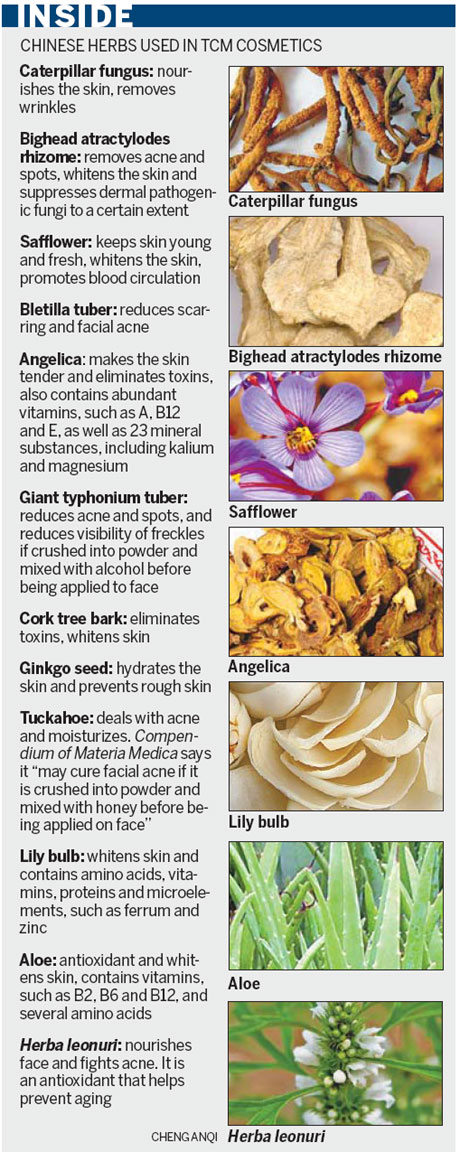 Traditional Chinese medicine cosmetics have a history of 1,600 years but have only recently started to compete with modern international brands. Traditional Chinese medicine cosmetics have a history of 1,600 years but have only recently started to compete with modern international brands.
University student Lu Jing has been battling acne for the past three years, using dozens of products to get rid of the disfiguring scars on her face - all without success. Three months ago, however, a doctor prescribed her traditional Chinese and Tibetan medicine in her hometown in the Innner Mongolia autonomous region. He told her to mix a mystery powder with egg white every night and apply it to the face. Now, the 25-year-old has a clear complexion free of comedones (blackheads and whiteheads) and with just a few fading scars.
According to the Chamber of Beauty Culture and Cosmetics of All-China Federation of Industry and Commerce, foreign companies have more than half the domestic cosmetics market and rake in 80 percent of the profits.
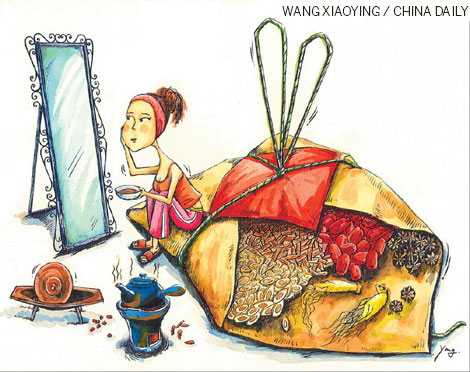 But people like Lu are increasingly turning to traditional Chinese medicine (TCM) cosmetics to sort out their skincare problems, moving away from Western beauty products. But people like Lu are increasingly turning to traditional Chinese medicine (TCM) cosmetics to sort out their skincare problems, moving away from Western beauty products.
So, when Lu returned to Beijing, she stopped using imported skincare products and instead went to reputable domestic pharmacies to buy suitable TCM cleansing milk, creams and facial masks, such as products from the 140-year-old pharmacy, Beijing Tongrentang Group Co Ltd.
"Tongrentang promotes TCM cosmetics products and has become the market leader," says Huang Xing, the general manager of Guangzhou Yanzhuang Cosmetics Ltd.
Meanwhile, Jiang Xiaojun, director of the Tongrentang publicity department, says the company's skincare products have passed the test of time.
The company's products include medicine originally prescribed by Wang Tao, a Tang Dynasty (AD 618-907) doctor that uses tuckahoe, the root of red-rooted salvia, ginseng and herba leonuri to improve sallow skin and moisturize.
Many young customers come to buy the whitening-and-moisturizing facial masks, says Zhang Can, a shop assistant at Tongrentang.
"Nearly 100 boxes are sold every day," she adds.
The move away from foreign cosmetics brands to domestic versions is a slow one, as domestic consumers have grown to trust and admire foreign brands.
Huang, of Guangzhou Yanzhuang Cosmetics Ltd, recalls that in the 1990s the senior manager of an international cosmetics company said Chinese companies could not build a global brand because they were just making copycat products.
"His words were unpleasant because they labeled Chinese goods as imitations, but it was true and to the point," says Huang, who has been involved in TCM cosmetics for 17 years.
"My friends always ask me to take a large empty case every time I go abroad and bring back luxury cosmetics, because they are cheaper abroad. It upsets me a bit," Huang says.
He believes TCM cosmetics have three directions in which to develop.
One is developing traditional eco-cosmetics, such as curing chloasma with honey and tuckahoe powder, a long-standing folk remedy.
Second is developing TCM cosmetics that meet modern cosmetic and marketing requirements, such as Tongrentang's whitening-and-moisturizing facial masks.
Third, extract chemicals from traditional Chinese medicines, such as amylase, polypeptides and alkaloids, and do research on their safety and beauty treatment values.
With a history of 1,600 years, TCM cosmetics will not fade away as trends change, Huang says.
He refers to beauty products from the Sui Dynasty (AD 581-618); the 81 products for facial care written by Sun Simiao, China's King of Medicine in the Tang Dynasty; and the 168 facial care products recommended in Compendium of Materia Medica by Li Shizhen in the Ming Dynasty (1368-1644).
"These facts cannot be changed by multinational companies, and it surely creates an opportunity for domestic cosmetics companies to compete with foreign brands."
World-class brands have a genetic blueprint, Huang says. If Chinese elements are built into the foundation of cosmetics, then strong brands like Tongrentang will find their place in the international market.
December 1 2010
Developing Retail Channels in China
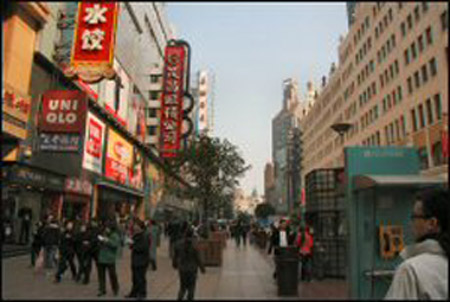 The mainland consumer market
is rapidly developing, with short product cycles and fast-changing consumer
preferences The mainland consumer market
is rapidly developing, with short product cycles and fast-changing consumer
preferences
There can be little doubt that the Chinese mainland’s huge consumer market holds
massive potential. But the overall scale and density of development of mainland
chain stores – including department stores and supermarkets – have yet to match
levels seen in the West. In addition, the volume of goods produced for domestic
sale is no match for that made for export. Further development of the mainland
economy and rapid urbanisation will lead to gradual expansion of distribution
chains. But in the meantime distributors are becoming increasingly aware of the
need to enhance cooperation with suppliers. Modern multi-purpose shopping malls
also provide new sales venues for franchisees to choose from. In turn, these
developments have led to an easing of restrictions Hong Kong companies face in
developing distribution channels on the mainland.
“Convenient sales channels are very important to fast-moving consumer goods (FMCGs)
– such as daily necessities, food and beverages, and groceries – because
consumers need to purchase these products on a regular and recurring basis,”
said Pansy Yau, HKTDC Deputy Chief Economist. “With the rapid development of
various retail formats such as the supermarket, hypermarket and convenience
store in mainland commercial districts and residential areas, consumers have
grown accustomed to buying daily necessities and food from nearby outlets.”
According to the China General Chamber of Commerce, 31 out of the mainland’s top
100 retail enterprises in 2009 mainly operated supermarkets; and among the
top-100 chain enterprises dealing in FMCGs in 2009, 19 supermarket enterprises
achieved an annual sales volume of more than Rmb10 billion. This shows that
chain supermarkets are developing rapidly on the mainland and the size of
related enterprises is also continuously expanding.
Modes of Distribution
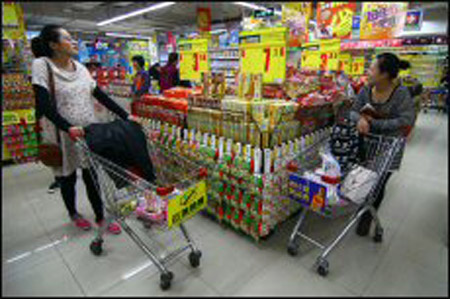 Chinese mainland consumers
are accustomed to buying daily necessities and food from nearby supermarkets and
convenience stores Chinese mainland consumers
are accustomed to buying daily necessities and food from nearby supermarkets and
convenience stores
In contrast with mature overseas markets, mainland convenience stores are still
at their nascent stage, and generally operate as small local or independent
stores. To consumers, the most essential requirements of these outlets are
convenience and time-saving features. These stores are mainly situated in
densely populated locations like office buildings as well as commercial and
residential areas. They rely on the flow of people to generate sales, and their
target customers are mainly singles because people with families usually make
their purchases at supermarkets and hypermarkets.
According to international market experience, the convenience store enters a
market when per-capita income reaches US$3,000. These stores will enter a stage
of growth and then peak development when per-capita income hits US$4,000 and
US$6,000 respectively. The growth of convenience stores on the mainland,
therefore, is concentrated in regions that are economically well-developed, with
a high population concentration and relatively high per-capita income, such as
in the cities of Guangdong, Shanghai and Beijing.
Franchise operations have advantage such as fast expansion of the sales network
and the establishment of brands with limited funds. They can also benefit from
the strong local knowledge and connections of franchise holders, who face fewer
difficulties and risks than the franchisors themselves would while setting up
new stores. The quality of franchisees varies on the mainland and companies with
experience in the sector tend to be bigger and better-performing operators.
After establishing themselves in the franchise system, some franchisees can even
assist the franchisors to develop sub-franchise or expand into other regions.
Under the Regulations on the Administration of Commercial Franchise Operations,
franchisors that plan to develop their domestic sales through franchise
operation must have at least two directly operated stores that have been in
business for no less than one year.
Apart from physical stores, online sales have become the future growth target
for the sales channels of FMCGs and general merchandise. As conditions for
online shopping improve, and transactions and payments become more secure, the
popularity and volume of online shopping transactions are rising. According to
the China Internet Network Information Center (CNNIC), the mainland’s Internet
population had reached 420 million as at June 2010, up 24.3 per cent from June
2009. The Internet penetration rate stood at about 31.8 per cent on the
mainland, with a 142 million-strong online shopping community (up 61.6 per
cent). The mainland’s online shopping penetration rate still lags behind other
mature markets such as Japan, Korea and the United States, where the rate has
reached 53.6 per cent, 57.0 per cent and 70 per cent respectively. However, the
mainland’s online shopping rate continues to grow, rising from 26 per cent in
2009 to 33.8 per cent in 2010, underscoring the mainland’s tremendous potential.
Market Positioning
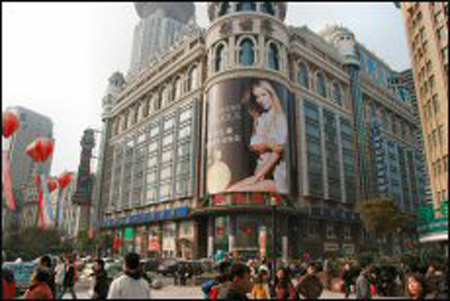 International brands have
established their presence in first-tier Chinese mainland cities, making second
and third-tier cities ideal for new brands International brands have
established their presence in first-tier Chinese mainland cities, making second
and third-tier cities ideal for new brands
In order to capture the market and build brands, Hong Kong companies need not
only to carefully choose the market positioning of their brands and sales venues
suitable for their image, they also need to understand the positioning and
strategy of their competitors. “Mainland consumers are becoming more
sophisticated and pay considerable attention to price-performance ratios,” Ms
Yau said. “The mainland consumer market is also rapidly developing, with short
product cycles and quick changes in consumer preference. A brand must follow
closely the changes in mainland consumer demand if it is to enjoy sustainable
development.”
She noted that it is also important for Hong Kong companies to take note of
regional differences on the mainland market. The various climate conditions,
living habits, customs and traditions as well as different regions such as
south, north, central and west, translate into different preferences for product
design and functionality. That also means that the degree of homogeneity of the
mainland market is low. Even within the same region, different cities will have
different income levels and consumption power because of their different degrees
of economic development, she pointed out.
“For example, people in the northeast love to shop for fashion and accessories
and pay great attention to how clothes are matched. However, in selling garments
and accessories to this market, Hong Kong companies have to bear in mind the
short product cycle, the distinct seasons, and that local people’s tastes are
very much influenced by trends in Japan and Korea due to geographic proximity,”
Ms Yau said. To capture this market, Hong Kong companies must be sensitive to
trends and market changes and launch new items every season, or they will face
slow sales, unmarketable merchandise and business losses, she added.
As they approach the mainland market, Hong Kong companies need to adapt to the
demands and preferences of the mainland consumer as well as the different
operating environment. Ms Yau advises companies to start on a pilot basis and
build a name brand before expanding. There are a large number of distributors of
various sizes on the mainland, and Hong Kong companies can make use of a number
of trade exhibitions to identify suitable distributors. Smaller distributors
have the advantage of being more flexible and possessing local knowledge and
networks, and owners usually have a hands-on style and are able to maintain
close relationships with clients. The larger nationwide wholesale agents have
more professional marketing know-how and experience, more investment in
information technology resources and computer support, and are able to provide
more systematic and analytical information about the market. But their operating
costs are higher and their fees more expensive.
Many international brands have already captured markets in first-tier mainland
cities. In contrast, consumers and retailers in second and third-tier cities may
be more receptive to new brands, and hence, prove more profitable to Hong Kong
companies entering the mainland market. In any case, before Hong Kong companies
approach the market, they should carefully research conditions and consider
joining relevant mainland trade associations to build up their network and to
better understand mainland operations.
November 16 2010
US$33.3 Billion 1,318km Beijing to Shanghai High-Speed Railway
completed in 2 1/2 years - Journey between Shanghai and Beijing to be
cut to four hours.
 Track-laying work for the long-anticipated Beijing-Shanghai high-speed railway
stood complete when Railways Minister Liu Zhijun tightened the line's last bolt
on a windy Monday morning. "The project has entered its last stage," Lu Chunfang,
vice-minister of railways, said at a ceremony to celebrate the latest success in
the city of Bengbu, situated in the center of the railway line. Since the
project kicked off on April 18, 2008, some 135,000 workers have toiled hard to
lay 1,318 km of high-quality tracks.
Track-laying work for the long-anticipated Beijing-Shanghai high-speed railway
stood complete when Railways Minister Liu Zhijun tightened the line's last bolt
on a windy Monday morning. "The project has entered its last stage," Lu Chunfang,
vice-minister of railways, said at a ceremony to celebrate the latest success in
the city of Bengbu, situated in the center of the railway line. Since the
project kicked off on April 18, 2008, some 135,000 workers have toiled hard to
lay 1,318 km of high-quality tracks.
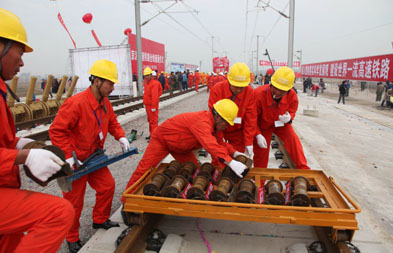 In the next few months, workers
will race against time to install the railway's power supply, communications and
signal systems, and carry out operation trials to test the line and trains to
ensure the railway can open to traffic next year, Wang Yongping, spokesman of
the Ministry of Railways, said. In the next few months, workers
will race against time to install the railway's power supply, communications and
signal systems, and carry out operation trials to test the line and trains to
ensure the railway can open to traffic next year, Wang Yongping, spokesman of
the Ministry of Railways, said.
"The Beijing-Shanghai high-speed railway incorporates China's latest high-speed
railway technologies," he said.
The 1,318-km railway costs 220.94 billion yuan ($33.29 billion) in total.
"The core factor that can tell a country's high-speed railway technology is the
speed," said Guo Zhiyong, deputy chief engineer of China Railway Siyuan Survey
and Design Group Co Ltd, which is in charge of the line's design.
"The future trial operations on this line are expected to beat the speed record
of 416.6 km per hour achieved by the Shanghai-Hangzhou railway on Sept 28. And
its future operation speed will also exceed that of the current 350 km per
hour," he said.
The ministry aims to slash the travel time between China's two largest cities to
only four hours, down from the current 10 hours.
Other technical highlights include engineers' innovations in tunnel design and
construction that allow trains to encounter each other in the tunnel at a speed
of 350 km per hour safely, and the world's first six-line high-speed railway
bridge, the Dashengguan bridge in Nanjing, Jiangsu province, which spans 336
meters and allows trains to pass through at a speed of 300 km per hour.
The railway winds through seven provinces and municipalities along China's
eastern coast, where one-fourth of the country's population lives, generating 40
percent of the country's GDP.
Along the way, there are 24 stops, including five major stations - Beijing
South, Tianjin West, Jinan West, Nanjing South and Shanghai Hongqiao stations.
The new railway is expected to relieve the existing line of pressures from both
passenger and cargo transport, said Wang Yongping.
For a long time, the railway department found it difficult to meet
transportation demands along the line. Only 35 percent of the demand for cargo
transportation could be met in the past, he said.
With the new rail line ready, the ministry estimates that it can ferry 80
million passengers in one direction annually. This will greatly enhance the
railway transport capability between Beijing and Shanghai, as the existing
railway will be used for cargo transport, he said.
China now leads the world with 7,431 km of high-speed railways in operation.
The country plans to build a high-speed railway network of 13,000 km by 2012. By
then, passengers would be able to reach most provincial capital cities from
Beijing in eight hours by train.
November 14 2010
Doing business in China needs differenct approches: U.S.
expert
Opportunities abound in China, but doing business in China needs different sets
of thinking and approaches, some U.S. experts said Wednesday.
The advices came from the 2010 Ernst & Young Strategic Growth Forum held in Palm
Springs, California.
The forum is the largest gathering of entrepreneurs in the United States which
is attended by more than 1,700 industry icons and business leaders.
At the forum's China Panel held on Wednesday, introducing to the audience the
thinking and approaches to do business in China was what Dr. Robert Lawrence
Kuhn planned to achieve, as many American businesses and companies have been
trying to enter the emerging vast market.
Kuhn is a well-known international investment banker, corporate strategist and
long-time adviser to the Chinese government.
"Every company in this room has a China strategy," Dr. Kuhn said. "You may say:
'No, I don't.' Yes, you do," he said,. "Because if you don't have a strategy,
you have one by default, and that's not good enough."
The changes in China over the past 30-plus years have been constant, Robert
Nardelli, CEO of Cerberus Operations & Advisory Company and panelist at the
forum noted.
He pointed out that China's advantage, as is the case with many developing
countries, lies in its ability to leapfrog ahead of Western countries.
John Rice, Vice Chairman of General Electric Company, said his company is doing
joint ventures with more than 20 state-owned enterprises, which "is not
something we ever would have thought about 15 years ago."
As one of the significant keys to business success, Rice suggested a win-win
arrangement. "You'd better be prepared to really create a win-win, or that thing
is not going to work," he said.
Alignment with the government policy is another key of doing business in China,
Kuhn said. "Alignment is key in China. To be aligned with policy in terms of
technology area or industry area and geography area. This is a critical factor."
Kuhn noted that one of the most effective ways of doing business in China for a
large and medium-sized company is work the provincial level. "The provincial
level is really the source of power, decision-making for almost all of the
business," he said.
At the meeting, Kuhn also made a brief introduction to China's political and
social reality, and answered inquiries about politics in China, the China's
stance on rare earth exports and China's policy of promoting peaceful
development.
Kuhn is the author of "The Man Who Changed China: The Life and Legacy of Jiang
Zemin" and "How China's Leaders Think: The Inside Story of China's Reform and
What This Means for the Future."
October 18 2010
Distribution systems separate men from boys as China
e-commerce grows By Bien Perez
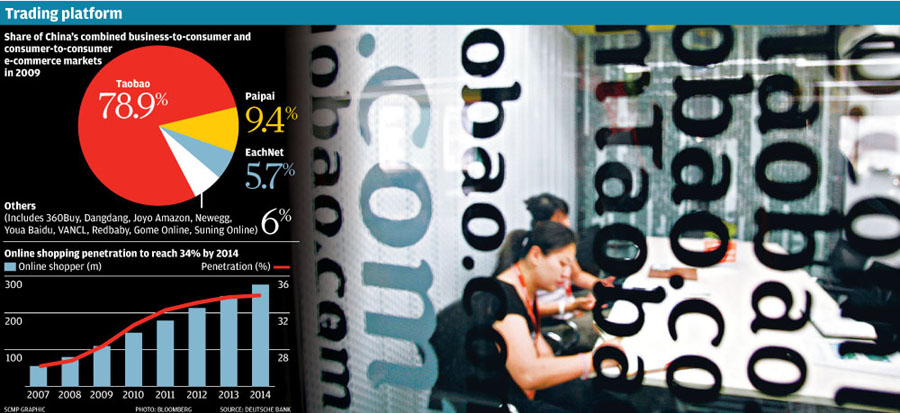
Mainland consumers are buying and selling more goods over the internet,
prompting the nation's largest online retail players to sharpen their
distribution systems to keep customers satisfied and help the industry further
expand. "Only those companies with a mastery of logistics as part of their value
proposition will succeed in China's e-commerce race," Deutsche Bank analysts in
Hong Kong said in a recent "China Internet Insights" report. Logistics, they
said, comprised warehousing, trunk transport and delivery.
The mainland's profitable business-to-consumer and consumer-to-consumer
e-commerce market segments are forecast to grow an average of 42 per cent
annually over five years and be worth 1.523 trillion yuan (HK$1.78 trillion), or
7.2 per cent of the country's total retail sales, in 2014, according to the
report.
Taobao, the mainland's leading online retail services provider, has championed
what analysts call the "platform" approach, which involves outsourcing most
logistics requirements to specialist third-party partners. The other approach is
called "self-build", which provides more control to the e-commerce player.
Tom Group (SEHK: 2383), the diversified media arm of conglomerate Hutchison
Whampoa (SEHK: 0013), in August unveiled what could be considered the best
example of the self-build approach.
Tom's new internet retail joint venture with China Post, known as Beijing Ule
E-Commerce, had a highly developed, nationwide infrastructure not possessed by
the likes of Taobao and Joyo Amazon, owned by United States-based Amazon.com.
The Deutsche Bank report described the mainland's warehousing market as
"underdeveloped".
"China's warehousing is unable to meet the demand from growing e-commerce
platforms, especially business-to-consumer [players], which have more exacting
requirements for warehousing than consumer-to-consumer [players]," the report
said. It noted that trunk transport, involving the transfer of goods through
road networks from province to province, was comparatively developed and
dominated by traditional business-to-business e-commerce players.
The delivery part of logistics "remains a largely labour-intensive industry",
the report said, adding that it "could be fuelled by reasonably low labour costs
in the next three to five years". While the sector might be underdeveloped in
terms of equipment and service quality, it was largely driven by the robust
transaction volume growth of Taobao, the report said.
According to the China Express Association, Taobao-related transactions
generated one billion parcels last year and accounted for 50 per cent of the
total market volume.
The analysts predicted the major domestic business-to-consumer e-commerce
players, including Joyo Amazon, Dangdang.com, Vancl and the Beijing Jingdong
Century Trading-operated 360buy.com, would increasingly widen their product
categories, a development that would entail setting up more strategic
distribution centres across the country.
That expansion is expected to result in industry consolidation over the next few
years.
The report noted that companies that have raised their investment and expertise
in logistics would be more competitive in a market where quality user experience
is as important as price.
The authors suggested a preference for the "platform" approach to solve most of
the logistics issues of domestic e-commerce players because "it is more
cost-efficient and scalable", and needs less capital.
"We believe that Taobao is the only e-commerce platform that has been able to
leverage this approach extensively due to its scale," the report said.
Taobao, which is Hangzhou-based Alibaba Group's other flagship unit after
business-to-business e-commerce giant Alibaba.com (SEHK: 1688), declined to
provide the amount of investments it has made in logistics, which culminated in
the creation of its "Wuliubao" platform earlier this year.
"Our platform consolidates logistics information, transaction information and
also the enterprise resource planning systems of merchants," an Alibaba Group
spokeswoman said.
"This allows seamless interaction between back-end logistics management systems
and offline distribution systems."
Stars Express and Annto are current third-party logistics partners listed on
Taobao's website. Of the 13 distribution centres set up by its partners, six are
in Shanghai.
Taobao, which iResearch estimated had a 79.3 per cent share of the mainland's
online shopping sector in the second quarter, has also established guidelines
for third-party logistics companies that relate to handling inventory, security
deposits, customer complaints and penalties.
The standards set were designed to improve the service quality and abilities of
logistics vendors, the spokeswoman said. "Any future expansion plans will depend
on these partners and follow customer needs," she said.
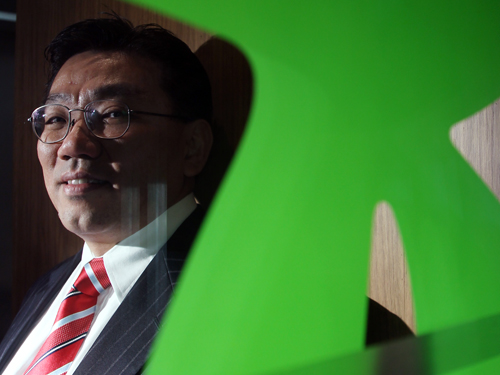 Tom chief executive Ken Yeung Kwok-mung
said many mainland manufacturers and merchants were looking for more than just a
pure information exchange type of e-commerce platform. Tom chief executive Ken Yeung Kwok-mung
said many mainland manufacturers and merchants were looking for more than just a
pure information exchange type of e-commerce platform.
"They need an integrated solution with excellent customer service support and
logistics capabilities, especially warehousing," Yeung said.
Ule, the Tom-China Post joint venture, was able to provide "individually
tailored solutions that combine online and offline requirements", he added.
With a network of 46,000 post offices, 36,000 Postal Savings Bank branches,
150,000 workers, 56,000 delivery vehicles and 17 aircraft, China Post will
provide the offline sales channels, logistics support and transaction
fulfillment for its 51 per cent-owned joint venture.
Health and beauty chain Watsons, casual garments supplier Giordano (SEHK: 0709),
computer maker Lenovo (SEHK: 0992), skin care supplier Vichy Laboratories and
entertainment giant Walt Disney were Ule's launch partners in August. Ule now
serves more than 1,000 local and international brands.
October 12 2010
Through the red door - New York designer Phillip Lim is expanding his
horizons on the mainland By Tessa Chan
 New
York-based designer Phillip Lim compares his years in fashion to dog years: one
year feels like seven. "It's been such a fast ride I didn't even realise it was
our anniversary," he says, when I remark upon his eponymous label's fifth
birthday. "Yet at the same time it's so intense, I feel like I've been doing
this forever." New
York-based designer Phillip Lim compares his years in fashion to dog years: one
year feels like seven. "It's been such a fast ride I didn't even realise it was
our anniversary," he says, when I remark upon his eponymous label's fifth
birthday. "Yet at the same time it's so intense, I feel like I've been doing
this forever."
He sounds like a parent. "Either way, we're still at the `early learning' stage,
and I think I'll always feel that way."
The son of Chinese immigrants who fled to
the US to escape the civil war, 35-year-old Lim has returned to his roots to
promote "4 X 3:1" an artistic collaboration with Lane Crawford, comprising four
short films by four up-and-coming female directors. While many fashion brands
use film as a medium to promote their latest collections, Lim gave Victoria
Tang, Rain Li, Elle Muliarchyk and Yi Zhou carte blanche over the content.
Only one outfit from the Philip Lim 3:1 label - so named because he was 31 when
he founded it - unifies the films: a white trench coat, "Baroke" pumps and a
Phillip Lim bag. Each item has its symbolic significance, as does the red door
the female protagonist steps through. "It represents the beginning of an
adventure, and the colour also reflects my cultural heritage."
Lim will hold an inaugural fashion show in Beijing this month to introduce his
designs to a broader audience on the mainland.
Seeing the Phillip Lim woman from the perspective of others has opened his eyes
to new possibilities. "I'm always open to collaborating with other artists and
mediums to create a new energy. You never know what you're going to find; it's a
constant evolution. If you stay still, you're dead."
Has technology and, in particular, the internet forced fashion labels to rethink
the way they communicate with their customers? "Definitely," he says. "It breaks
the bubble, removes that sense of distance. I like that, though. That's what our
brand has always been about: accessibility."
Lim is proud of his label's independence, and believes that not having the
heritage of a major couture house has given him more creative freedom, allowing
him to work on pure instinct. "They say that naivety is bliss, and that's true,"
he says. "So in the process of getting more history, I'm going to enjoy and
maximise my naivety...while it lasts."
Known for producing elegant, wearable clothes with a youthful twist, Lim
describes himself as a neoclassicist. Rather than try to reinvent himself every
season, he aims to create what he believes will become new classics. "Your
aesthetic evolves, but it shouldn't change," he says.
Lim rebels against the showmanship that many big labels resort to on the
catwalks, and instead limits himself to simply showing the audience what he
sells. "It's never a big show. It's just a chance to show the world what we've
been working on. It's like, `these are clothes... that you can actually wear!'"
he says, laughing. "And the funny thing is, because everyone's trying to be so
edgy, to be classical is kind of counter-current."
For spring-summer 2011, he has opted to present a look he dubs the "dandie-lion".
"It's the female form of a dandy, with the strength of the lion," he explains.
"The new dandies are very subtle, but what they have in common is that eccentric
soul."
 A scene from Victoria
Tang's film for Phillip Lim. A scene from Victoria
Tang's film for Phillip Lim.
Rather than introduce them in a theatrical production, models, towering in
platform heels, showed off the collection, which featured predominantly neutral
layers of nude, camel, black and bone white and a contrast of leathers, sheers
and elaborate lace. Future classics included tan lambskin halter tabards, an
antique rope-embroidered panel dress and chic trenches updated in translucent
organza, juxtaposed with playful items, such as flora-dot track pants or a "Bougie
Blue" leather pinafore.
Classic with a touch of madness, he calls it, and, as always, a blend of
masculine and feminine elements.
The way Lim is dressed for our meeting encapsulates this. From a distance he
looks like any other smartly dressed man with his simple, clean-cut suit. Step
closer and you notice that his top is rich blue suede and glance down and you're
greeted with grey and black leopard-print calfskin loafers - Yves Saint Laurent,
he confesses, the only thing he's wearing that's not from his own label.
Another thing that defines Lim's clothes is their reasonable prices. Today, more
than ever, he says, it's hard to justify charging exorbitant prices for an item
of clothing, especially when it may fall out of trend by next season.
"Some clothes you look at and think, `I could buy this dress, or I could buy a
car,'" he says. "It's like an alternate reality. But that's up to the
individual."
Evidently not the kind of individual he's looking to appeal to with 3:1. "You
can't appease everybody. If you try to, you confuse your customer. It shows a
sense of desperation - it makes them lose faith. If you don't have confidence in
who you are, why should they?"
There is, however, one luxury Lim wishes he had more of - time. "If I could have
one wish it would be to have more time. It's not something you own and you can't
buy it," he says. "There are only so many days in the year and we make our
clothes from scratch - this isn't like fast fashion where things happen
overnight."
What helps keeps him sane when the pressure's on is his sense of humour. "And
accepting the fact that it's insane," he says. "And remembering I'm not the only
one. My team shares it with me; we're all insane so it's OK."
The people he works with have been crucial to his success, he says. "You spend
more time with your colleagues than with your family. So you'd better hope you
surround yourself with inspiring, supportive people."
Does he feel he has evolved since he co-founded his first label, Development, at
the age of 27? "Besides a couple of pounds and a few wrinkles?" he asks. "I know
myself better. I know what I want. It's about self evolution and self
acceptance. That's the biggest part of this journey, and that comes out in the
clothes."
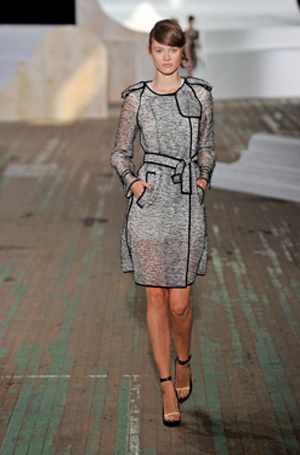 These clothes are now available in
50 countries worldwide, and his fashion show in the Chinese capital will expand
his exposure beyond the fashionable few who can buy his designs at Lane Crawford
Beijing. These clothes are now available in
50 countries worldwide, and his fashion show in the Chinese capital will expand
his exposure beyond the fashionable few who can buy his designs at Lane Crawford
Beijing.
"My parents are from the mainland. About two years ago I went to Beijing for the
first time, and I've made a commitment to come back more [often]," he says. "I
grew up in California, but at home our culture was Chinese. The language, the
food, the values... everything."
Lim says 3:1 will be the first young designer brand to have an independent show
in Beijing, but for him the milestone is a personal one. "What's really touching
for me is that my mother is flying out to Beijing for the show," he says. "She
has never been to a fashion show of mine. So it's like I'm bringing her home.
I'm extremely nervous about how it'll be received."
So as he steps through the "red door", does he believe that China is ready for
him? "There's definitely an appetite for something new, and it's incredibly
fast-paced, so I hope so."
August 18 2010
Winding Road to the China Market
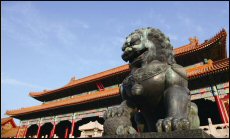 Chinese mainland authorities recently
announced tighter regulations on foreign representative offices on the mainland Chinese mainland authorities recently
announced tighter regulations on foreign representative offices on the mainland
Representative offices (ROs), once among the most popular corporate vehicles
used by foreign firms for initiating business on the Chinese mainland, seem to
be fading from favor among small- and medium-sized (SME) trading companies.
What was a minimally regulated means of accessing the mainland market since the
1980s became misused over time, say observers, and the strong corrective
medicine of tighter regulation and more comprehensive taxation might not be what
foreign traders can stomach.
Under regulations jointly announced by the State Administration of Industry and
Commerce and the Ministry of Public Security last January, ROs must comply with
annual rather than tri-annual renewal of registration certification, as well as
notarised obligations of the foreign head office for new RO setups. There are
also restrictions on the number of representatives among other new
administrative measures. (Please see chart below)
New measures for foreign representative offices At issue is whether ROs, which
are currently numbered in the hundreds of thousands, continue to be useful, as
their business scope remains limited. At the same time, they could face a higher
tax burden and administration requirements.
Some senior legal, tax and trade professionals see the RO as a bygone vestige of
the last century. But there are also those who view this hybrid corporate
vehicle, which is banned from taking part in revenue-taking activities, as still
playing a key role liaising with mainland firms and facilitating international
supply chains.
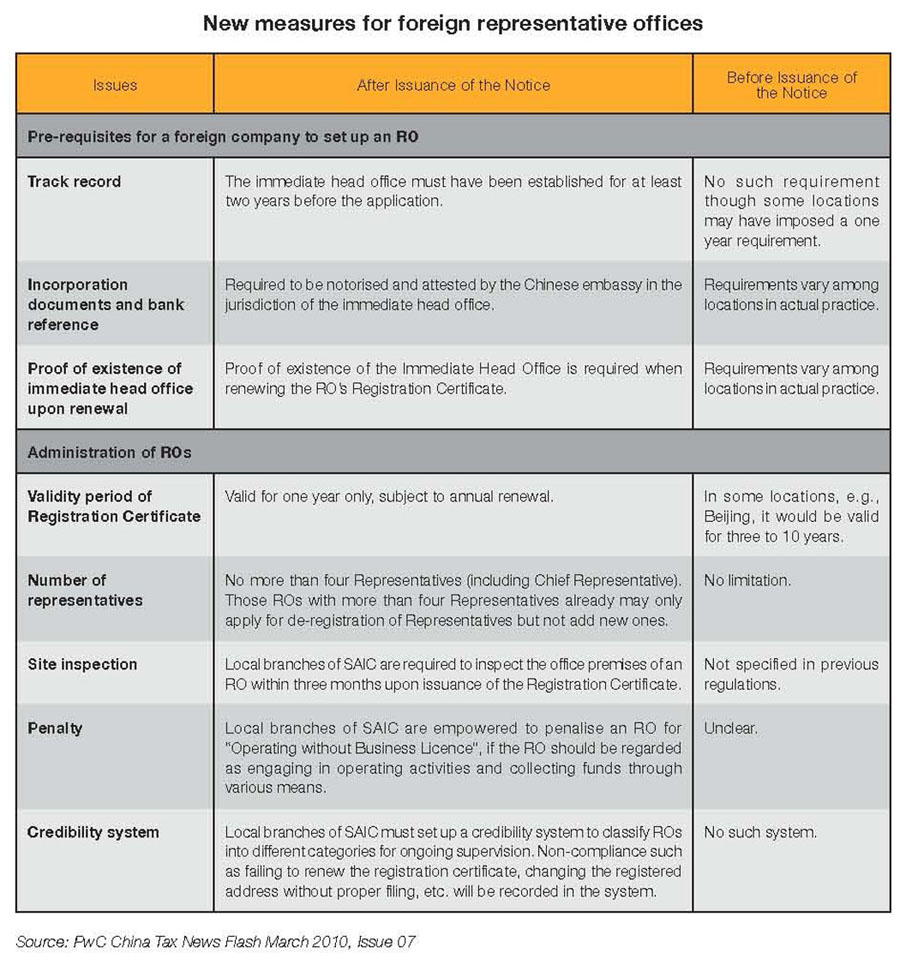
Choice of Vehicle
Much depends on the size and operations of the foreign company. Large retail
players are already far advanced in building extensive revenue-taking networks.
For them, the RO is a device that has served its purpose already.
For smaller entrants, newly formed regulations for ROs are proving more
difficult to work with for lack of full definition. Further official explanation
of how the modified RO will operate is due at any time.
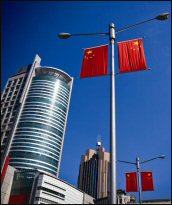 Large, successful players
have moved on from ROs to access the Chinese mainland market Large, successful players
have moved on from ROs to access the Chinese mainland market
For these smaller foreign firms, Hong Kong-based corporate entities seem to have
been gaining in popularity, not only for the relative simplicity of their legal
framework and ease of setting up, but also for their accessibility to financial
services. Also, Hong Kong-based entities may be eligible for the preferential
tax treatment under the existing arrangement on the avoidance of double
taxation, on income arising between Hong Kong and the mainland in respect of
mainland operations.
In particular, withholding tax on dividend repatriation may be reduced from 10
per cent to five per cent for Hong Kong firms with mainland operations.
Elizabeth Thomson, President of corporate financial services firm ICS Trust
(Asia) Ltd, says she invariably advises trade clients – many small- and
medium-sized, capitalised at between US$10 million and US$500 million – to use
Hong Kong’s jurisdiction to provide a holding structure in its well-regulated
legal environment. ICS Trust has itself been established in Hong Kong for 30
years. “Based in Hong Kong, a lot of people are happier, with easier travel
options and continuing to be in touch with people on the mainland.”
Ms Thomson says this is also why her company offers integrated “one-shop”
solutions in Hong Kong, primarily to avoid exposure to risks existing for
mainland entrants, particularly new ones. Anthea Wong, a partner for China Tax
and Business Advisory Services with accountancy firm PricewaterhouseCoopers (PwC)
in Hong Kong, advises clients – whether large multinationals or mid-sized firms
– to take what she calls “a holistic approach” when planning their China
investment structure.
Investing in Hong Kong is not contradictory to investing on the mainland, she
says. The two structures can actually be complementary if the roles and
functions between the entities in both jurisdictions are carefully designed.
This could help investors capitalise on Hong Kong’s sophisticated banking
system, tax regime and legal structure, while having a mainland-based entity to
penetrate the China market. “You have to look at both angles; if the client is
expanding in the mainland market, there would be a need for a presence [on the
mainland],” says Ms Wong.
ROs and Other Species
 Many foreign firms prefer to go straight
to becoming revenue-handling entities Many foreign firms prefer to go straight
to becoming revenue-handling entities
ROs were set up in the 1980s as part of an array of foreign-invested
enterprises, which included different types of ventures. Of the other
categories, the most often used are wholly foreign-owned enterprises (WFOEs) and
joint ventures (JVs).
Lawyers agree WFOEs are comparatively flexible corporate entities that allow
manufacturing and services firms to set up on the mainland, provided they are
not under restriction in so-called state “strategic sectors.” The uncertainty
lies in the fact that what is “strategic,” can change.
The main advantages for foreign investors are in the fact that WFOEs are
independent, allow freedom of management and operation, invoicing in Rmb and IP
protection.
Comparatively, some believe JVs with mainland partners offer the attraction of a
shared investment risk, as well as good market access and intimate knowledge of
the country. But partners have to offer the right fit; there’s plenty of
potential for disagreement.
There are still other, more specialised vehicles that may not be suitable for
smaller players. Of these, strategic alliances are said to have the benefit of
flexible operation, but lack the stability of a formal corporate structure.
Relatively new licensing agreements require both branding and a large-scale
operation to generate the profits that foreign firms expect of a mainland
investment.
Passive and Active
ROs are structured as “passive investment” entities, mainly to lay out foreign
companies’ long-term goals and oversee mainland operations. In turn, these
foreign-manned corporate units were popular with multinationals striving to make
an impact on a largely unknown but seemingly lucrative Chinese market.
Times have moved on and a proportion of ROs is said to have been “too creative”
with their manning and operations, leading to this year’s thorough shake up.
William Soileau, Senior Associate with UK-based law firm Pinsent Masons in
Shanghai, says that mainland ROs are an “historical anachronism.” But since
China joined the World Trade Organization in 2001, a number of ROs have been
“used in a sloppy fashion” by firms, with lax oversight and inadequate
bookkeeping. Indeed, there’s trade talk of so-called “credit card factories”
grouped as ROs, with their only function being to pay for goods destined for
export, using credit cards to hide what are real revenue flows.
The overall effect of the mainland regulation was seen by some as cracking down
on the exposure of ROs to tax after they were revealed to be carrying out
physical trades. According to one account, this even involved foreign teachers
and traders that formed the easy-to-establish ROs and bypassed mainland
employment regulations. They’re now subject to tax, assuming they have the right
to work on the mainland.
Mr Soileau says Pinsent recommends a Hong Kong company as a “special-purpose
vehicle,” establishing bona fide residence for the foreign entity on the
mainland, whichever one is chosen.
The law firm tends to prefer WFOEs to either ROs or joint ventures, unless the
latter are situated in the Guangdong special economic zones of Shenzhen or
Zhuhai. That’s because the cultural and operational differences between foreign
and mainland enterprises vary significantly according to region, with
consequences for the success of the joint venture. For her part, Ms Thomson says
she advises clients to look closely at whether they need to set up an RO or a
WFOE. Some indeed adopt the RO, due to the type of businesses they operate.
For example, one client is involved in selling auto industry parts to a US-based
car producer. The company’s RO is responsible for finding the factories on the
mainland and negotiating contracts for shipment of the parts back to the United
States. In this case, the RO acts as a facilitator for all aspects of the
contract, which is usually directly drawn between the US and Chinese firms.
Ms Thomson believes some aspects of the new regime are intriguing, including the
registration certification for ROs, which ran for three years. Under the
regulatory change, this has been reduced to one. “A lot can happen to a company
in three years,” Ms Thomson says.
From PwC, Ms Wong admits that the new regulatory framework doesn’t fully answer
how the “new” RO will fit into a modern supply chain that assumes revenue flows
through different entities to achieve efficient business models; this is
required by most foreign traders on the mainland.
But she still insists there will be foreign companies that prefer to enter the
mainland intending to “look first before trading” (therefore opting for an RO),
even though the process of dismantling this and forming a WFOE is a cumbersome
one. It’s still not possible to “transform” a mainland RO. A new WFOE will have
to be separately established, whereas the RO may be de-registered if it is no
longer useful.
As for the income tax of ROs, most were taxed on a deemed basis at the profit
rate of 10 per cent in the past. However, from this year, ROs are requested to
compute tax on an actual basis or on a deemed basis at the rate of no less than
15 per cent. This could conceivably result in some ROs paying more in tax than
previously, under some circumstances.
Ms Thomson of ICS Trust (Asia) hopes to see “a new RO take the place of the
present one,” believing that an improved model can emerge from the mainland’s
regulatory work in progress. It would be wise not to pronounce the RO dead quite
yet.
August 17 2010
China 'overtakes Japan in economic prowess'
By Wang Xiaotian and Li Xiang
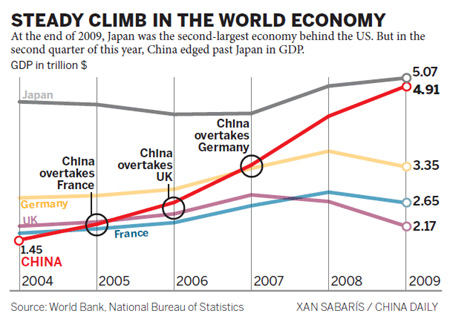 China may overtake Japan as the world's second-largest economy this
year, but it remains a developing economy despite its fast pace of growth,
economists said.
China may overtake Japan as the world's second-largest economy this
year, but it remains a developing economy despite its fast pace of growth,
economists said.
Japan's nominal gross domestic product (GDP), which is not adjusted for price
and seasonal variations, was worth $1.286 trillion in the April-to-June quarter
compared with $1.335 trillion for China, according to data released by the
Japanese government on Monday. The figures are converted into dollars based on
an average exchange rate for the quarter.
Japan's GDP grew at an annualized rate of just 0.4 percent, the government said,
far below the annualized 4.4 percent expansion in the first quarter and adding
to evidence the global recovery is facing strong head wind.
China has surpassed Japan in quarterly GDP figures before, but this time it is
unlikely to relinquish the lead, AP reported.
China's economy will almost certainly be bigger than Japan's at the end of 2010
because of the huge difference in each country's growth rates. China is growing
at about 10 percent a year, while Japan's economy is forecast to grow between 2
to 3 percent this year.
The gap between the size of the two economies at the end of last year was
already narrow. Chinese economists estimated China's leading advantage would
maintain through the rest of 2010, reinforced by its usually more vibrant
economy in the fourth quarter and possible yuan appreciation.
Japan has held the No 2 spot behind the United States since 1968, when it
overtook West Germany. From the ashes of World War II, the country rose to
become a global manufacturing and financial powerhouse. But its "economic
miracle" turned into a massive real estate bubble in the 1980s before imploding
in 1991.
Despite emerging as an economic power, China remains far behind many countries
if per capita GDP is taken into account.
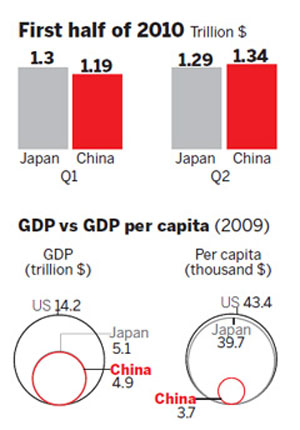 In 2009, China reported a per capita GDP
of $3,687, as compared to $37,800 for Japan and $46,436 for the US. China ranked
103th worldwide in terms of per capita GDP, according to the World Bank. In 2009, China reported a per capita GDP
of $3,687, as compared to $37,800 for Japan and $46,436 for the US. China ranked
103th worldwide in terms of per capita GDP, according to the World Bank.
Richard Berner, Morgan Stanley's chief US economist, said that the news of
China's GDP overtaking Japan came as no surprise. The nation's GDP on the
purchasing power parity basis already surpassed Japan some time ago.
In 2007, China overtook Germany as the third-largest economy in terms of total
GDP. A decade ago, it ranked seventh globally.
Gu Yuanyang, economist with the Chinese Academy of Social Sciences, said the
quality of its economic growth is yet to match its pace of expansion.
"China lags far behind in the ability to transform technical progress into
economic benefits and our weight of research and development to GDP is very
low," he said. "We are over-dependent on foreign technologies."
Despite the fast expanding GDP, China is still bothered by such domestic
problems as poverty and a widening wealth gap, which thwarts its efforts to take
on more international responsibilities, said Yang Yi, a professor at the School
of International Relations and Diplomacy, Beijing Foreign Studies University.
He said how much China could contribute to the international community depends
on how well it could address domestic economic problems.
Lei Yanhua, researcher with the Chinese Academy of International Trade and
Economic Cooperation affiliated to the Ministry of Commerce, said responsibility
on the international scene should result in a greater say in global bodies.
"When China takes more responsibilities internationally, it should have a
greater voice in major international organizations on key global issues," he
said.
August 11 2010
Why the West should not fear China - Those who see the
nation's development as a threat are missing the huge change that its embrace of
capitalism has brought By Ting Shi
The multi-faceted story of China growth has been told in many ways - Some see it
as China Inc, the world's most successful mercantilist state, expanding at the
rest of the world's expense. Another version features a rising revisionist power
seeking to remake the global system in its own image. Yet another casts it as a
retrograde political outsider, emboldened by economic steroids, that is doomed
to suffer a systemic implosion.
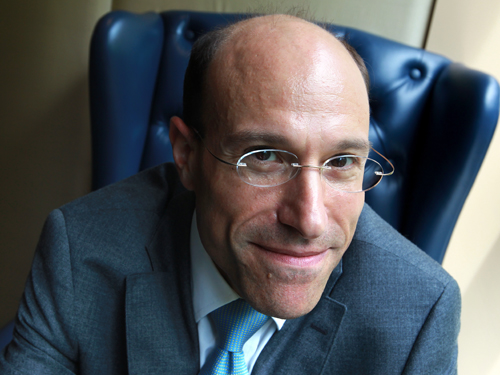 None of them gets it exactly right,
argues Massachusetts Institute of Technology political science professor Edward
Steinfeld. None of them gets it exactly right,
argues Massachusetts Institute of Technology political science professor Edward
Steinfeld.
The China story he tells is bold, counterintuitive and has an unfashionably rosy
tinge. Here is a country that 20 years ago took a great leap of faith by
hitching its fate to a global economic system designed and dominated by the
advanced Western countries. Then it grew up, not by conjuring up its own rules,
but instead by absorbing - and even embracing as its own - norms, practices,
values and aspirations of the West.
"In essence, China today - a country at the peak of its modernisation revolution
- is doing something it historically never really did before. It is playing our
game," says Steinfeld, who directs the MIT Sloan China Management Project.
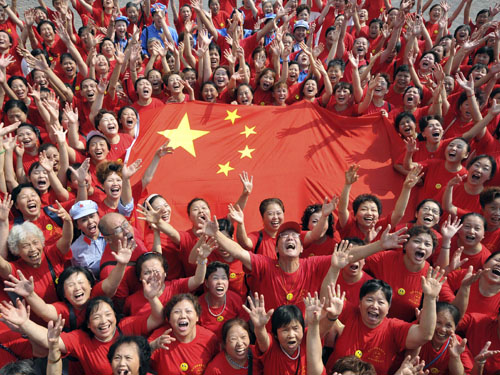 Mainlanders hold a giant
national flag ahead of a flag-raising ceremony in Chongqing . The country has
undergone huge change in the past 20 years as it has opened up to the West and
undertaken massive economic reforms. Mainlanders hold a giant
national flag ahead of a flag-raising ceremony in Chongqing . The country has
undergone huge change in the past 20 years as it has opened up to the West and
undertaken massive economic reforms.
In his new book Playing Our Game: Why China's Rise Doesn't Threaten the West,
Steinfeld sets out to challenge two views expressed by nearly all China
worriers, China bashers and China doomsayers: that a rising China poses a global
threat and that growth abnormalities - in the form of a dangerous disconnect
between political and economic transformation - have become grossly manifest.
"The US and western European countries perceive China as an economic threat
because they don't fundamentally understand how modern production works,"
Steinfeld says.
China has been growing mainly by "aggressively embracing globalised production",
and by doing so, it has fostered the global division of labour which has
permitted the advanced economies, particularly the US, to surge forward in
technological innovation and commercial creativity.
The role China has played might be termed as "best supporting actor", he says.
By serving as a low-cost provider of mass manufactured goods, China has created
opportunities for wealthier nations, the lead actors, to specialise in something
far more difficult to replicate: knowledge creation and invention.
"Economics-wise, China has been a facilitator for growth of a number of other
countries, including the US," says Steinfeld, who is also director of the
National Committee on US-China Relations.
So, here is the alternative China story that Steinfeld puts on the table: the
real transformation of the Chinese economy took place in the early 1990s, and it
was not a well thought-out, carefully crafted, long-term plan to start with.
China, hit by economic setbacks and political shocks, opened up its industrial
base to foreign players out of pure desperation, and an urgent need to stimulate
growth and create jobs.
 Fireworks during the opening
of the Beijing Olympics, the encouragement of consumerism and the development of
infrastructure to cope with massive trade growth have all contributed to
changing the nation. Fireworks during the opening
of the Beijing Olympics, the encouragement of consumerism and the development of
infrastructure to cope with massive trade growth have all contributed to
changing the nation.
This was anything but the standard growth model. Rather than fixing up the
institutions - private property rights, commercial legal codes, the currency
exchange mechanism, etc - to prompt economic activity, China did the opposite.
Chinese reformers left in place a bunch of institutions that were wrong but
ploughed ahead and opened the country up to foreign investment anyway.
"The textbook approach would have had China first getting its house in order and
then joining the global economy. In reality, China first joined the global
economy and only subsequently scrambled to get its house cleaned up. A kind of
order would ultimately be achieved but one as much of the global commercial
world's choosing as China's own," Steinfeld says.
At the heart of the matter is what he calls "institutional outsourcing" - China
handing outsiders the power to design the rules by which its internal market
operates. In this process, foreign players selectively upgraded Chinese domestic
industry and reshaped it to meet specific global needs. For example, the
self-induced competitive threat following the country's WTO accession forced the
restructuring of thousands of domestic firms and the elimination of the "iron
rice bowl" of lifetime employment. The integration of producers into global
production chains subjected them to global quality standards and foreign media
scrutiny. The listing of companies on overseas stock exchanges exposed those
firms to stringent monitoring by overseas watchdog agencies.
In the broadest sense, he says, China's revolution is about a nation that has
rescued itself from existential crisis by tying itself to a particular kind of
global economic order. So far, China has done well through this division of
labour. The leading market economies, with their higher levels of wealth and in
more specialised areas, have done equally well or even better.
"It does not mean triumph of any one nation or the capitulation of any other. It
does not by definition entail selling out or caving in. Indeed, given the growth
record China has achieved, particularly compared with that of many other
developing countries during the same period, it may very well constitute an
optimal strategy," Steinfeld says.
More contentiously, the MIT professor challenges what he calls "a truism today"
that "China is transforming economically but frozen politically". The "binary"
view that, if there's no full democratisation, political change does not happen,
is categorically wrong.
"There's no way the current level of economic growth could have been achieved
without comparable political transformation. Growth up to today would have never
been maintained in the absence of dramatic social, political changes," he says.
There is some kind of "organic, interlinked" relationship between economic and
political progress. By participating deeply in globalised production, China is
subjecting its existing political and social order to stress. Chinese growth has
involved the yoking together of economic and political forces.
"I can say for sure there's been political liberalisation going on," says
Steinfeld, a close observer of China for more than 20 years.
The single-party, authoritarian state obviously survives. However, the party's
omnipresence has been diluted over the past two decades. The nature of the
state, its relationship to its citizenry and its sources of legitimacy have all
been fundamentally changed. In the process of scrambling to keep up with rapid
political and social changes, Communist Party leaders carried out many reform
policies which Steinfeld says are "gutsier than many of us gave them credit for"
because they could undercut party power.
Take the "Open Government Initiative", which obliges government to make public
information that is of public interest, as one example. On one level, he says,
you may doubt whether it would be fully enforced, but on another level, it's a
daring move because once made it cannot be withdrawn, and that makes the party
vulnerable.
"It's like tossing a hand grenade and saying, all right, let's see where it
explodes. Maybe it [the Communist Party leadership] is under the idea or
illusion that the blast can always be contained, or the blast can at least
release some pressure. But so far, it hasn't been fully contained and actually
leads to other pressure the government has to catch up to," Steinfeld says.
Another example is the Central Party School - the party's top training ground
for high-level officials - which Steinfeld describes as "the most interesting
organisation in the country". Its curriculum now includes courses on comparative
democratic systems and the role of civil society in effective governance. It
also invites liberal scholars with technical expertise - including Steinfeld -
to give lectures and sends its students to top universities abroad to study
courses such as public affairs, public finance and environmental regulation.
In this sense, the government's reform programme - rule of law, political
accountability and increasing popular participation - has become something more
than cynical rhetoric. "We can argue that the government has become a believer
of its rhetoric, an advocate," he says.
Moving to the future, it's the same game - growth can't be sustained without
political change. And here, Steinfeld makes an intriguing comparison between the
Communist Party and Taiwan's Kuomintang.
Neither party ever set out to dismantle authoritarian rule. Both, arguably for
reasons of survival, came to legitimise themselves through commitments to
concrete development goals. As a result, each party's relationship with its own
elites and society at large changed irrevocably.
Steinfeld says that perhaps the most important lesson from Taiwan's
democratisation experience is that right up to the moment one-party rule
disappeared, real political change appeared unlikely, if not impossible. Right
up to the very end, the KMT was suppressing dissidents and throwing political
prisoners in jail. And right up to the very end, it was insisting that while
democratisation was a long-term goal, one-party rule was a national necessity
for the time being.
In other words, virtually anything the party did - from admitting outsiders to
pushing new laws - could be dismissed by observers as avoidance of change rather
than change itself.
But in reality, the end of authoritarianism came not as a single,
bolt-out-of-the-blue break from the past. Instead, it was an accumulation of
changes that each in and of itself would have appeared insignificant.
China's authoritarian rule, Steinfeld says, is "self-obsolescing" in ways that
roughly mirror what transpired two decades ago in Taiwan. Real changes -
including social and political - have actually been under way for years.
"I don't think it's a huge mystery. It's only a question of what the time frame
is," Steinfeld says. "And I'm certainly more optimistic than I was."
August 8 2010
Don't overestimate China's economy
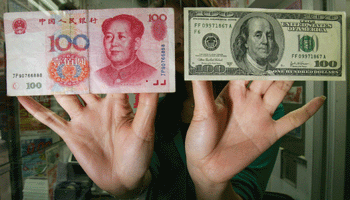 The Governor of the People's Bank of
China (PBC) Yi Gang recently mentioned that China had overtaken Japan to become
the world's second largest economy. Some UK researchers believe that at current
GDP growth rates, China will overtake the U.S. to be the world's top economy
within nine years. The forecasts sparked heated debate worldwide. Some people
think the figures are faked and do not take the forecasts seriously; others
agree that, sooner or later, China will become the world's biggest economic
power. The Governor of the People's Bank of
China (PBC) Yi Gang recently mentioned that China had overtaken Japan to become
the world's second largest economy. Some UK researchers believe that at current
GDP growth rates, China will overtake the U.S. to be the world's top economy
within nine years. The forecasts sparked heated debate worldwide. Some people
think the figures are faked and do not take the forecasts seriously; others
agree that, sooner or later, China will become the world's biggest economic
power.
The accuracy of China's GDP figures need not concern us much. Given the rate of
economic growth over the past 30 years and the current exchange rate of yuan,
the national figures for GDP are quite believable. Some provinces may exaggerate
the figures, but on the other hand in some developed areas the figures may be
understated. This makes the final figure released by the National Bureau of
Statistics (NBS) more or less accurate.
What concerns me most is that, although China's overall GDP is high, its
per-capita GDP lags far behind the west. China's per-capita GDP is around
US$3,800, less than one tenth that of Japan or the U.S., and less than one sixth
that of France and the UK. Even among developing countries, China occupies only
a mid-to-low-ranking position.
Besides, the quality of China's economy bears no comparison to that of the west.
Since 2003, China's economic growth has relied on two pillars: exports and real
estate. While the former brought China some benefits in terms of modernization,
the latter has caused many serious problems. The growth in the real estate
market is based on the mismanagement of land resources and property speculation,
leading to skyrocketing house prices and a real estate bubble that must
eventually be deflated. If China's growth continues to depend on these sectors,
the country's economic development will be severely distorted. Fortunately, the
government is well aware of the situation, and has introduced a series of
measures to mitigate financial risks.
China's economy suffers from a number of unbalances. The first is the imbalance
between urban and rural economic development. The reforms of the past three
decades achieved great success, but cities and villages are steadily growing
apart. The weight of the rural economy in overall economic activity becomes ever
smaller.
The second imbalance is between regions. The economies of coastal regions are
approaching the level of developed countries, but inland provinces lag behind by
at least 10 or 20 years. The more inland a province is, the more backward its
economy. The huge regional gap means that even if all provinces have the same
GDP growth rate, the quality of their economy differs greatly.
The third imbalance is in income distribution. China is transitioning from a
planned economy to market economy. Government intervention can still be seen
everywhere in economy. In this situation, the income of an individual is greatly
influenced by how close he is to power. The further away a man is from the
government power, the less wealth he will get. Rapid economic growth has
resulted in a small number of people grabbing the lion's share of the wealth.
If these problems are not solved, the quality of China's economic development
will be badly affected and China will face serious difficulties in the future.
China's rapid GDP growth will be meaningless if these unbalances remain
unsolved.
When we talk about China's economic power, we should be careful not to
overestimate our strength. We are still an underdeveloped country and many
problems need to be addressed. Only by constantly reviewing our progress and
identifying successes and shortcomings, can we move forward. Otherwise, if the
country encounters a real financial crisis it may regress to what it was like
years ago.
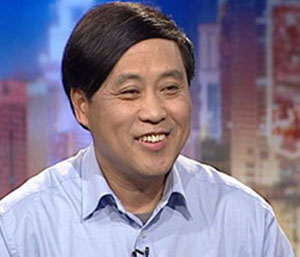 The author, Yi Xianrong is the director
of the Finance Institute at the Chinese Academy of Social Sciences (CASS). The author, Yi Xianrong is the director
of the Finance Institute at the Chinese Academy of Social Sciences (CASS).

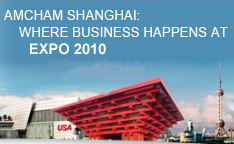 AmCham Shanghai launches 2010 World Expo
Business Series and AmCham Expo Website - AmCham Shanghai is pleased to
announce the AmCham Shanghai 2010 World Expo Business Series, bringing Expo
business opportunities to our members while facilitating the entry of new
businesses to China. The AmCham Shanghai 2010 World Expo Business Series is
supported by the U.S. Foreign Commercial Service, the China Council for the
Promotion of International Trade and the Shanghai Foreign Investment Development
Board. Confirmed speakers include Jeffrey Immelt, chairman and CEO of GE, Dr.
George Buckley,chairman and CEO of 3M and Tom Donohue, president and CEO of the
U.S. Chamber of Commerce. Visit the new AmCham Shanghai Expo site at
http://expo.amcham-shanghai.org
for a full listing of speaker events, conferences, Expo related forums and more!
AmCham Shanghai launches 2010 World Expo
Business Series and AmCham Expo Website - AmCham Shanghai is pleased to
announce the AmCham Shanghai 2010 World Expo Business Series, bringing Expo
business opportunities to our members while facilitating the entry of new
businesses to China. The AmCham Shanghai 2010 World Expo Business Series is
supported by the U.S. Foreign Commercial Service, the China Council for the
Promotion of International Trade and the Shanghai Foreign Investment Development
Board. Confirmed speakers include Jeffrey Immelt, chairman and CEO of GE, Dr.
George Buckley,chairman and CEO of 3M and Tom Donohue, president and CEO of the
U.S. Chamber of Commerce. Visit the new AmCham Shanghai Expo site at
http://expo.amcham-shanghai.org
for a full listing of speaker events, conferences, Expo related forums and more!
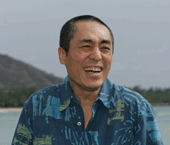 Download Power Point Presentation
of the Hangzhou's "Impression Xihu" Produced by Mr. Zhang Yimou who among
producing award winning films worldwide for the past 2 decades, he was the
director for the opening and closing ceremony of the Beijing Olympics 2009
影像西湖
-
張藝謀太厲害了
http://www.hkchcc.org/westlakeimpressionshow.pps
Download Power Point Presentation
of the Hangzhou's "Impression Xihu" Produced by Mr. Zhang Yimou who among
producing award winning films worldwide for the past 2 decades, he was the
director for the opening and closing ceremony of the Beijing Olympics 2009
影像西湖
-
張藝謀太厲害了
http://www.hkchcc.org/westlakeimpressionshow.pps
Business China Archives
before 2008
June 27, 2010
 10-year plan to turn Hainan "aka
Hawaii of Asia" into tourism hub By Toh Han Shih 10-year plan to turn Hainan "aka
Hawaii of Asia" into tourism hub By Toh Han Shih
Even as former Citic Pacific (SEHK: 0267) chairman Larry Yung Chi-kin attracts
scrutiny for his controversial land purchases in Hainan province, Beijing has
approved a 10-year plan to turn the southern Chinese island into an
international tourism hub.
The plan calls for well over 100 billion yuan (HK$114 billion) to be spent on
infrastructure and a sixfold increase in the province's tourism revenue to 124
billion yuan by 2020.
Analysts expressed concern that even with the tsunami of funds heading towards
the island, the plan might fail to meet its ambitious targets.
The storm being created over Yung's deal is already one fly in the ointment. In
the Legislative Council on Wednesday, Democratic Party chairman Albert Ho Chun-yan
asked if Hong Kong police would investigate Yung's purchase of the five sites at
a tourism project near Wanning.
Secretary for Financial Services and the Treasury Chan Ka-keung declined to
comment on the matter. The Department of Justice had asked the police to look
into Yung's Hainan deals, the South China Morning Post (SEHK: 0583,
announcements, news) reported on May 27.
Two private companies of Yung acquired the sites at an average of 700 yuan per
square metre, far below the current price for residential units in Wanning of
6,000 yuan per square metre. Yung acquired the land in April last year, when he
resigned as Citic chairman following disclosures of foreign-exchange losses of
US$1.9 billion the red chip incurred under his leadership.
Wanning is one of the major tourism destinations mentioned in the central
government's plan to develop Hainan as an international tourism resort.
On June 8, the National Development and Reform Commission approved the
government's 10-year plan to develop Hainan as a "global top-tier leisure island
resort".
The targets are annual tourism revenues of 54 billion yuan and for tourism to
account for at least 9 per cent of the province's gross domestic product by
2015, according to the plan posted on the Hainan government's tourism website.
The goals for 2020 are annual tourism revenues of 124 billion yuan and for
tourism to account for at least 12 per cent of GDP.
This is a big leap from last year, when Hainan's tourism revenue was 21 billion
yuan and tourism accounted for 6.4 per cent of its GDP, according to government
data.
Patrick Chovanec, a professor at the School of Economics and Management at
Tsinghua University, said there is a strong foundation for the tourism industry
in Hainan, as it has attractive beaches and nice hotels. "But it will take time
for it to be an international tourism destination."
Chovanec said 10 years is possibly too short a time for Hainan to develop into a
full-fledged international tourism hub, pointing out that most tourists on the
island are mainlanders and most foreign tourists would likely first visit
Shanghai and Beijing before considering Hainan.
"Hainan is going to face a lot of competition as a regional tourist
destination," he said.
Hainan lies in the South China Sea, where Thailand, Malaysia and the Philippines
compete with the island for international tourists, Chovanec said.
The plan for Hainan calls for massive spending on infrastructure, including the
construction of a cross-sea link between Guangdong and Hainan across the
Qiongzhou Strait.
A feasibility study is under way on three options for this Guangdong-Hainan
link, Xinhua reported. One option is a 41.3-kilometre road-and-rail bridge on
the western edge of the strait that will cost 142 billion yuan.
The second is a 21.9km road-and-rail bridge in the centre of the strait that
will cost 106.4 billion yuan and the third option is a 27.8km rail tunnel in the
centre of the strait with a 43km road bridge on the western edge of the strait
that will cost 159.8 billion yuan. The study is expected to be completed by the
end of this year. If all goes well, construction will begin in 2012.
The plan also calls for a high-speed rail network that will enable travel
anywhere on the island within two hours by 2015. This includes a 345km rail link
on the west side of Hainan to be completed by 2015, which is estimated to cost
22.5 billion yuan, media reports said. The plan includes the renovation of
airports at Haikou and Sanya and the construction of a new airport at Boao.
Talk of high-speed rail connections and cross-strait links has been good news
for speculators.
"Speculators don't care if the government's plan to develop Hainan as an
international tourism hub will be successful. They will use the tourism plan as
a good excuse to speculate on property," Raymond So Wai-man, associate professor
of finance at the Chinese University of Hong Kong, said.
He pointed out that shortly after the State Council announced the tourism plan
for Hainan on January 4, property prices in the province shot up.
On February 19, the Post reported that prices of some properties in Hainan rose
30 per cent within two weeks.
In mid-June, Xinhua reported transactions of Hainan's commercial residential
properties last month slumped 57.95 per cent from April to 229,000 square metres,
while average transaction prices slipped 29.74 per cent month on month to 8,483
yuan per square metre.
Many Chinese people buying holiday apartments in Hainan had no intention of
staying there but only kept them for investment purposes, Chovanec said. "When
you have a market driven by these people instead of end-users, it's very easy to
develop a bubble."
In January, more than 30 per cent of the properties in the Hainan resort city of
Sanya were vacant, the China Daily reported.
The Vietnamese government opposes China's plan to develop Hainan for tourism in
the decade to 2020 as the proposal incorporates the disputed Spratly and Paracel
islands.
June 26, 2010
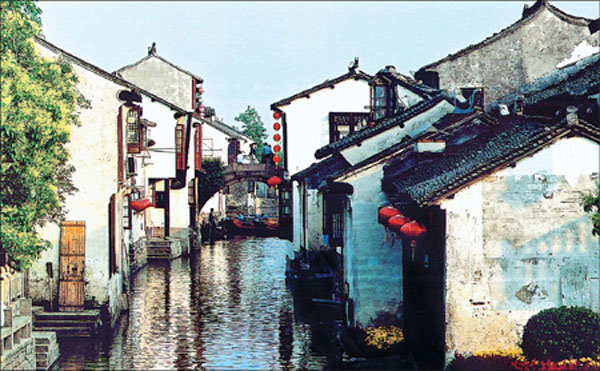 Water town awash with sights - Catch the
watery views at Zhouzhuang, only 50 kilometers from Shanghai Water town awash with sights - Catch the
watery views at Zhouzhuang, only 50 kilometers from Shanghai
If you want to get away from the hustle and bustle of the Shanghai metropolis to
seek out a historic and well-preserved ancient town, then head for Zhouzhuang, a
place regarded as China's most famous "water town".
Situated in Jiangsu province's Kunshan city, only about 50 kilometers from
Shanghai, Zhouzhuang offers typical southern Chinese riverside scenery, which
features numerous small and ornate bridges, murmuring streams and elegant
dwellings. It is an ideal holiday destination when a break from the big city is
sorely needed.
Zhouzhuang dates back to the Spring and Autumn Period (770-476 BC), when it was
called Zhenfengli. In 1086, during the Northern Song Dynasty (960-1127) it was
renamed Zhouzhuang in honor of a benevolent Buddhist named Zhou Digong.
Zhouzhuang has been "rediscovered" in recent decades thanks to the unique beauty
of this ancient water town. It has won new popularity and aroused the interest
of conservationists. It has also become a popular scenic spot and cultural
relic.
In the 1980s, a base for TV and film was established in Zhouzhuang. Since then,
more than 100 TV series and films have been shot there, including the
award-winning movie Shanghai Triad, which was directed by Zhang Yimou and
starred Gong Li.
Taking a gondola, the most convenient form of transport in Zhouzhuang, visitors
can enjoy the lovely watery views in a peaceful way, along with typical ancient
buildings found along the southern reaches of the Yangtze River, with plenty of
local color and customs mixed in.
Zhouzhuang features zigzagging waterways breached by many elegant stone bridges.
The small town is surrounded and divided by lakes and rivers, with 14 stone
bridges crossing the waterways, each offering distinctive views of the town.
Among them, Twin Bridges (Shuang Qiao) is the most famous because of a painting
by the internationally renowned artist, Chen Yifei. The two bridges, the Shide
and Yong'an, were built in Wanli era (1573-1619) of the Ming Dynasty. The
structures are considered the symbol of Zhouzhuang.
Seeing the ancient residences in Zhouzhuang is also a must. About 60 percent of
the town's structures were built during the Ming and Qing dynasties, from 1368
to 1911. Shen House and Zhang House are the two best-known structures and are
well worth a visit.
Shen House, built in 1742, was the private property of the descendants of Shen
Wansan, one of the richest men in south Yangtze River region in the early Qing
Dynasty. Occupying an area of more than 2,000 square meters, the Qing-style
house is known for its large scale - with more than 100 rooms. These rooms are
divided into three sections, with each section connected by arcades. The first
section is the water gate and wharf, where Shen's family moored boats and washed
clothes. The middle section includes the gate tower, tearoom, main hall and
places for entertaining guests. The last section is the two-story dwelling where
the family resided.
You can also visit the Chengxu Taoist Temple, known as Shengtang Hall, which has
a history of over 900 years. After several periods of expansion, it is one of
the most famous Taoist temples in the south Yangtze River region. Taking in an
area of 1,500 square meters, its design is deceptively simple, yet elegant, some
even say majestic, with its elaborate workings. It is regarded as a masterpiece
of ancient Taoist architecture.
Quanfu Temple and South Lake Garden are two other places worth visiting in
Zhouzhuang. You can also visit the town's museum to see examples of traditional
regional crafts and fishing implements.
At night, you can watch a special water performance called Zhouzhuang in All
Seasons, featuring local folklore, traditions and legends of this water
township.
The large-scale performance recounts what life was like along the southern
Yangtze River region centuries ago. The performance is unveiled in a classical
environment of small bridges, murmuring rivers and riverside homes. The
performance projects Zhouzhuang in four seasons: rain in spring, picking lotus
root in summer, harvest in autumn, and the New Year in winter. The performance
is well regarded and has earned praise around the world for its display of folk
customs and traditions portrayed in an artistic and authentic way.
The performance is staged between 7 pm and 8 pm each evening at a water stage at
Jiangnan Renjia.
June 14, 2010
TRADE DELEGATION TO CHINA SEES
OPPORTUNITIES, CHALLENGES IN THE CLEAN ENERGY SECTOR
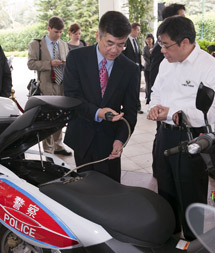 Representatives from 24 U.S.
businesses in the clean-energy sector visited China in May 2010 and participated
in the administration’s first cabinet-level business development mission, led by
Secretary of Commerce Gary Locke. They experienced firsthand the many
opportunities—and numerous challenges—that await them in this burgeoning market. Representatives from 24 U.S.
businesses in the clean-energy sector visited China in May 2010 and participated
in the administration’s first cabinet-level business development mission, led by
Secretary of Commerce Gary Locke. They experienced firsthand the many
opportunities—and numerous challenges—that await them in this burgeoning market.
On the plaza outside the Disney Hotel Conference Center in Hong Kong on May 17,
2010, Secretary of Commerce Gary Locke saw firsthand some innovative U.S.–made
automotive technologies. The visit was part of the clean-energy business
development mission that Locke led to China on May 16–21.
Secretary of Commerce Gary Locke led a delegation of representatives from 24
U.S. companies to China on May 16–21, 2010. Clean energy, the focus of this
weeklong trade mission, is a sector that holds great importance for the future
economic well-being of the United States and China.
At the start of the mission on May 16, Locke spoke at a press conference in Hong
Kong about the importance of developing clean-energy resources. “With global
energy demand slated to double by 2050, we’re going to have to mobilize every
innovative company and every bright mind we can behind discovering cleaner,
greener energy solutions.… The United States and China—as the world’s two
biggest emitters of carbon—have a moral responsibility to lead the world in this
effort.”
Growing Demand Fuels Expansion
As China continues to expand its economy, the domestic demand for energy has
experienced dramatic growth. China’s central planners have attempted to
accommodate this increased demand by setting targets for reducing the emissions
of pollutants and for increasing the use of renewable sources of energy. In
addition to expanding ties with resource-rich countries, China is taking a
number of steps to reduce emissions of pollutants in key sectors, including the
following:
Renewable energy. The Chinese government has mandated that 15 percent of its
energy come from renewable sources by 2020.
Nuclear energy. China currently has 11 nuclear reactors with an additional 20
under construction.
Coal. Today, 80 percent of China’s electricity is generated by coal. The
government has allocated significant funds for reducing emissions and for
increasing efficiency.
Clean technology. China’s current Five-Year Plan sets targets for reducing the
emissions of major pollutants, such as sulfur dioxide, nitrogen oxide, and
carbon dioxide by 10 percent.
Transmission infrastructure: with electricity consumption forecast to grow 7
percent annually through 2020, China’s power grid is in need of significant
upgrades and expansion.
Three Cities, One Message
Those specific energy needs were drivers of the trade delegation’s agenda as the
members spent time in three major Chinese cities: Hong Kong, Shanghai, and
Beijing.
The first stop was Hong Kong, which is a special administrative region of China
and a key center of commerce. The delegation participated in a forum at the
Green Technology Showcase, had one-on-one meetings with representatives of Hong
Kong businesses, and visited the Hong Kong Science and Technology Park.
In Shanghai, China’s largest city, the delegates met with Yu Zhengsheng, the
Shanghai Municipal Committee party secretary, and with representatives of
Chinese green companies. They also participated in site visits to Pratt &
Whitney’s engine facility and a Dow Chemical Company facility. There were also
meetings with companies participating in the U.S.–China Energy Cooperation
Program, which is a public–private partnership that deploys the expertise of
U.S. companies to help develop clean-energy solutions.
On May 20 and 21, the delegation’s final stop was the capital city of Beijing.
The delegation met with senior Chinese government officials, visited the China
Business Innovation Center, and participated in a town hall meeting with
students and scientists at Tsinghua University.
Challenges Remain
Despite the many potential opportunities encountered by the U.S. delegation
during its visit, companies that are seeking to do business in China face
several policy and regulatory impediments. Those issues include a lack of
transparency in government decision-making processes, China’s recently announced
“indigenous innovation” product accreditation system, inconsistent market access
at the provincial and local levels, and the need to strengthen the protection
and enforcement of intellectual property rights.
Locke spoke about those trade impediments during his speech in Shanghai on May
19 to the American Chamber of Commerce and the U.S.–China Business Council.
Speaking specifically about transparency, Locke noted that “businesses
frequently don’t know what the rules are, how they are enforced, or how
decisions are made.… Especially in the energy sector, where upfront capital
investment can be in the hundreds of millions of dollars and have multidecade
time horizons, this uncertainty has the potential to inhibit foreign corporate
investment in China.”
Future Growth, with U.S. Help
Although those challenges to doing business in China can be daunting, they are
not insurmountable. In fact, many U.S. companies are finding markets in which
they not only grow but prosper, often with the help of the U.S. Department of
Commerce and other federal agencies (see sidebar).
Trade between the United States and China can work to everyone’s mutual
advantage. “When … American companies find success here in Beijing, it creates
economic value throughout the supply chain in China and in manufacturing towns
across America,” said Locke. “That is the definition of a win–win for the United
States and for China.… In today’s global economy—where ideas are just as likely
to be discovered in Beijing as in Boston—we need to do everything we can to keep
markets open and to allow for the free flow of capital and ideas across our
borders.”
An Agreement on Wine and a Visit to the Shanghai Expo 2010
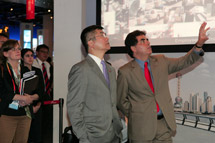 Aside from its focus on clean energy,
the visit to China by Secretary Locke was an occasion to mark significant
achievements in two other areas of U.S.–Chinese commercial relations. In Hong
Kong on May 17, Locke and Rita Lau, Hong Kong secretary of commerce and economic
development, signed a memorandum of understanding that supports the marketing
and promotion of wine from both countries. The memorandum follows the 2008
elimination of Hong Kong’s excise tax on wine. Aside from its focus on clean energy,
the visit to China by Secretary Locke was an occasion to mark significant
achievements in two other areas of U.S.–Chinese commercial relations. In Hong
Kong on May 17, Locke and Rita Lau, Hong Kong secretary of commerce and economic
development, signed a memorandum of understanding that supports the marketing
and promotion of wine from both countries. The memorandum follows the 2008
elimination of Hong Kong’s excise tax on wine.
Later, in Shanghai on May 19, Locke and the trade delegation visited the U.S.
pavilion at the Shanghai Expo, the world’s fair that opened recently in that
city (see related stories in the July 2009 and August 2009 issues of
International Trade Update). The theme of the U.S. pavilion is “Rising to the
Challenge.” According to the pavilion’s organizers, it will demonstrate “the
dynamic and emotional story about the American spirit of perseverance,
innovation, and community building.” The U.S. pavilion is expected to draw 6
million visitors before the close of the expo on October 31, 2010.
On May 19, 2010, Secretary of Commerce Gary Locke (center) and members of a U.S.
business delegation visited the U.S. pavilion at the Shanghai Expo. Accompanying
Locke was José H. Villarreal (right), the commissioner general of the U.S.
pavilion.
For More Information
The Department of Commerce has a
number of programs to assist U.S. businesses of any size that wish to enter the
Chinese market. Those programs include a network of commercial officers in five
Chinese cities, trade specialists located in more than 100 U.S. Export
Assistance Centers located throughout the United States, and the China Business
Information Center. Contact Johnson Choi, President of Hong Kong.China.Hawaii
Chamber of Commerce
www.hkchcc.org
John Ward is a writer in the International Trade Administration’s Office of
Public Affairs. Steven Chan of the International Trade Administration’s Market
Access and Compliance unit assisted with this report.
June 11, 2010
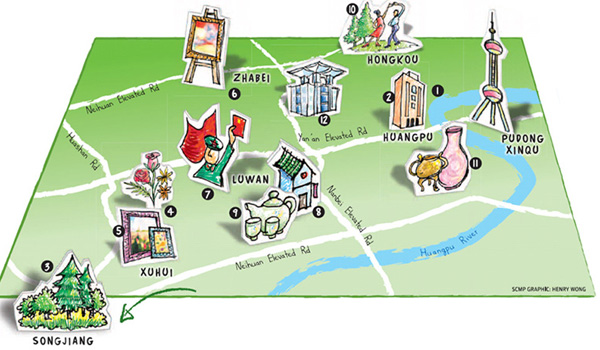 Shanghai must-sees
- If planning a visit to the World Expo, let a prominent resident show you
around its fascinating host city By Susan Jung Shanghai must-sees
- If planning a visit to the World Expo, let a prominent resident show you
around its fascinating host city By Susan Jung
An early innovator in Hong Kong's independent fine dining scene, restaurateur
Michelle Garnaut went on to blaze new trails on the mainland with her M at the
Bund and Glamour Room and Bar outlets in Shanghai.
With hundreds of thousands expected in Shanghai to check out the 2010 World
Expo, Garnaut introduces some of her favourite spots around the site:
1. Take a stroll down the newly renovated, newly spacious, newly landscaped and
gorgeous Bund.
2. Visit the Rockbund Museum's Peasant Da Vincis exhibition featuring crude but
ingenious rural inventions curated by leading artist Cai Guoqiang (Rockbund Art
Museum, 20 Huqiu Road, Huangpu District,
www.rockbundartmuseum.org)
3. The Chenshan Botanical Garden is an amazing East-West creation with hundreds
of plants, many endangered, landscaped by the brilliant architect Christoph
Valentien (3888 Chen Hua Road, Songjiang District,
www.csnbgsh.cn/en/index1.htm)
4. More floral offerings are at Rosa Gallica, which has Shanghai's best cut
flowers and plants, including beautiful roses from Yunnan (Ferguson Lane, 376
Wukang Road, Xuhui District, tel: +86 21 2821 2241)
5. Hong Merchant of Shanghai displays interesting art and antiques in a
beautiful vintage French Concession house (No 3 Lane 372 Xing Guo Road,
www.hongmerchant.com.au)
6. Curator Li Liang has an interesting mix of paintings, sculpture and
contemporary Chinese art at Eastlink Gallery (5th floor, Building 6, 50
Moganshan Road, Putuo District,
www.eastlinkgallery.cn)
7. Madame Mao's Dowry stocks original Cultural Revolution memorabilia, including
some that connoisseurs have never seen before (207 Fumin Road, Jingan District,
www.madamemaosdowry.com)
8. Tianzefang (Taikang Lu) is a truly adorable little shopping area, full of
narrow streets and original, one-of-a-kind shops in old houses (Lane 210,
Taikang Road, Luwan District,
www.tianzifang.cn)
9. Songfang Teahouse is a gorgeous teahouse in a lane house, with selections of
hard-to-find Chinese teas and French blends too (227 Yongjia Road, Xuhui
District,
www.songfangtea.com/home_en.php)
10. To watch the early morning ballroom dancers, go to the tranquil Lu Xun Park
(2288 North Sichuan Road, Hongkou District)
11. Head to Cang Bao Market for vintage Shanghai clothing, books and furniture (Cang
Bao Antiques Market, 457 Fangbang Zhonglu, Huangpu District)
12. Shanghai Urban Planning Exhibition Centre has detailed scale models of the
city, which give you a good sense of Shanghai's rapid development (100 Renmin
Dadao, People's Square, +86 21 6318 4477)
May 21 2010
Beijing, Washington talk tech and markets
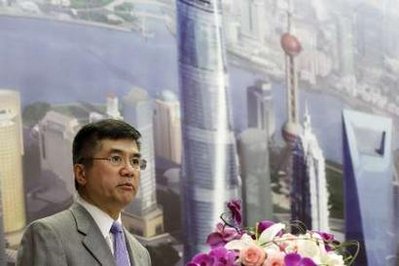 US Commerce Secretary Gary Locke
speaks during a ceremony to present the US Department of Commerce's Certificate
of Appreciation to Shanghai Tower Construction & Development Co., Ltd. in
Shanghai May 18, 2010. US Commerce Secretary Gary Locke
speaks during a ceremony to present the US Department of Commerce's Certificate
of Appreciation to Shanghai Tower Construction & Development Co., Ltd. in
Shanghai May 18, 2010.
China has an ambitious goal of improving energy efficiency but faces a shortage
of cutting-edge technology, while the United States is the world's biggest owner
of such know-how.
However, industry insiders are doubtful of success at a high-level strategic and
economic talk in Beijing next week.
"I hope there is a breakthrough but I think mounting difficulties loom ahead in
achieving such an ideal win-win situation," said Robert Lao, head of
Beijing-based RCL Consulting Company. As a scientist-turned-consultant, Lao has
been tracking the clean energy competitiveness of major economies for years.
Despite the Obama administration's intention to create green jobs and boost the
market share of its know-how worldwide, Lao said the American Congress and some
influential multinationals are not willing to relax control of high-tech
exports.
"They may welcome China buying high-tech products, but when it comes to core
technology transfer, that's a problem," said Lao.
During a recent interview with China Daily, Zhang Guobao, head of the National
Energy Administration, said he hoped the US could soon remove the high-tech
barriers.
The Beijing office of the United Nations published a low-carbon development
report this month, saying China needs more than 60 key technologies to realize
its carbon intensity reduction goal in major industrial sectors such as
electricity, transportation, buildings, steel and chemicals.
Beijing, Washington talk tech and markets
"For 70 percent of this necessary know-how, China does not have the core
technology," the report said. "China has to make a choice: Either buy from
multinationals or develop it itself."
Facing export controls from developed economies, China recently encouraged
investment in solar power, carbon storage and clean coal while urging rich
countries to relax their controls.
However, China's incentives in clean energy development have caused some concern
among developed countries. US Commerce Secretary Gary Locke urged China to
remain open to US and other foreign technologies as it ramps up investment in
clean energy to fight global warming and secure its economy.
"China, given the incredible challenges that it has, should in my view be taking
the best technology from wherever - whether it's China, the United States,
Europe, Japan, anywhere else," Locke said in Hong Kong on Sunday.
There are also worries that China could restrict foreign participation in
Chinese clean energy projects. An official from the National Development and
Reform Commission has said that China badly needs to boost competitiveness in
clean technologies and encourage foreign investment.
"In reality, some local governments even favor foreign investment over that from
local investors, though it's unfair for the latter," said the official, who
refused to be named.
Echoing consultant Robert Lao, Huang Shengchu, president of the China Coal
Information Institute, agreed that the US is competitive both in technology
development and market-oriented practices. Based on US experiences, he believed
that designing market-based tools is as important as improving coal combustion
and achieving breakthroughs in carbon storage technologies.
"We hope the US is generous enough to export both market-based tools and
technology at the same time," Huang said.
April 27
2010
Beijing defines
commercial secrets after Rio Tinto trial
The central government has issued definitions of what constitutes commercial
secrets for its hundreds of state-owned firms, in line with a draft law that
also requires telecommunications and internet operators to give authorities
access to information sent through their networks.
The draft is part of an effort to codify what is a secret in the mainland, after
a trial of four Rio Tinto employees drew international attention to the
country’s vague secrets laws. Those laws have long concern human rights
advocates.
Regulations on commercial secrets issued by the State-Owned Assets Supervision
and Administration Commission were dated March 25, the day after the trial of
Rio Tinto’s Shanghai-based iron ore managers. They were published late on
Monday.
The Rio employees’ detentions and trial alarmed both Chinese and foreign
investors because of the lack of definition in China of what makes up state or
commercial secrets.
The issue is of particular concern to business because state-owned enterprises,
which dominate many industrial sectors, are both competitive listed entities and
an integral part of the state-directed economic model China imported from the
Soviet Union.
Negotiations with those firms can therefore easily touch on matters that the
Chinese state deems of national interest.
Commercial secrets for state-owned firms include information related to
strategic plans, management, mergers, equity trades, stock market listings,
reserves, production, procurement and sales strategy, financing and finances,
negotiations, joint venture investments and technology transfers, according to
the notice posted on SASAC’s website late on Monday.
The regulations prevent information from being secret forever by requiring the
company to set a time limit when it classifies information as either “core
commercial secret” or “standard commercial secret”.
SASAC published its regulations after China’s legislature reviewed for a third
time an amendment to the Law on Guarding State Secrets, which China has been
updating to include information sent through modern communication networks.
Legal and rights advocates contend the ruling Communist Party uses secrets laws
to prosecute critics and people who reveal information embarrassing to the party
or powerful individuals.
“According to the draft, a State secret is defined as information concerning
national security and interests that, if released, would harm the country’s
security and interests,” the China Daily said on Tuesday.
The requirement for communications and internet firms to reveal information
applies to Chinese and foreign firms, it said.
The four Rio employees, including Australian citizen Stern Hu, were jailed for
accepting bribes and infringing commercial secrets during tense negotiations
over iron ore prices last year.
Rio Tinto promptly fired the four for “deplorable behaviour” but cleared itself
in an internal audit of any wrongdoing.
The commercial secrets portion of the trial was closed, even to Australian
diplomats, despite consular agreements, and defence lawyers were reluctant to
talk about it.
According to a text of the Rio Tinto verdict, published by The Australian
newspaper, the commercial secrets obtained by the four included discussions at
meetings of the China Iron and Steel Association attended by numerous steel mill
executives, and production cuts by Shougang Corporation in Beijing which the
defense countered had been published in Chinese newspapers.
April 26
2010
Is it too late to enter
the China market? By Andrew Moody
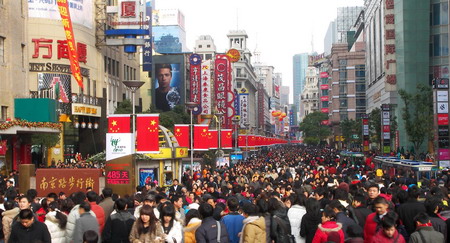 Crowds of shoppers in Nanjing
Street, Shanghai. Many foreign companies now have little choice but to enter
China as it emerges as the world's key market in the 21st century. Crowds of shoppers in Nanjing
Street, Shanghai. Many foreign companies now have little choice but to enter
China as it emerges as the world's key market in the 21st century.
Foreign companies have long seen the country with its 1.3 billion people as a
potential bonanza. But have those foreign companies who have yet to make their
move missed the boat?
Certainly, there are signs the China market is becoming tougher for those
companies wanting to enter from outside.
Indigenous Chinese companies, particularly in key sectors such as technology,
are increasingly competitive and have a more solidly entrenched position.
China's State-owned enterprises, which have benefited greatly from the country's
4 trillion yuan stimulus package, appear to have an impregnable position as
never before.
There is also a sense among some in the foreign business community that
regulations and rules are selectively applied to the advantage of Chinese
companies.
Could it be that those who came five or even 10 or 20 years ago to China were
the lucky ones and in the best position to benefit from any future spoils
offered by the market?
Edward Tse, chairman of global management consultants Booz & Co in China, based
in Hong Kong, admits there has been a recent nervousness among foreign
companies.
"I think there has been a lot of talk in the international businesses community
about how businesses feel about China now," he said.
But he added that many foreign companies now have little choice but to enter
China since it is emerging as the really key market of the 21st century.
"The great majority of the companies I deal with regard it as the most important
market in the world, if not the most important, " he said.
"For most foreign companies, it is not about whether to enter China, but having
the right China strategy."
Since the reform and opening up began in 1978, the number of foreign companies
in China has grown to around 435,000, according to the State Administration for
Industry and Commerce.
Around 480 of the Fortune 500 leading companies in the world, are now in the
country.
When many first entered there was very little in the way of domestic
competition.
In 1992, there were just 140,000 private companies in the country compared to
around 6.6 million today.
US businessman Tom Melcher is someone who is unafraid of this competition and
does not believe it is too late to enter China.
He is chairman of American technology company Zinch's China operations.
The company, which provides an online platform for students applying to colleges
or looking for scholarships, launched its operations in China this month.
"Are we too late? Absolutely not. Is China a bad place for foreign companies?
Absolutely not. It is much easier than it was five or 10 years ago, " he said.
He said there has been a big improvement in the regulatory environment so
foreign companies have a much better understanding as to where they stand.
"The regulatory environment in China is getting much more clear than it was five
years ago. Sometimes it is clear in a good way. Sometimes it is clear in a bad
way. But what is important is it is clear. That is what business people need,"
he said.
He says it is also easier for foreign companies to recruit talented people from
the local workforce than it was just a few years ago.
Is it too late to enter
the China market? By Andrew Moody
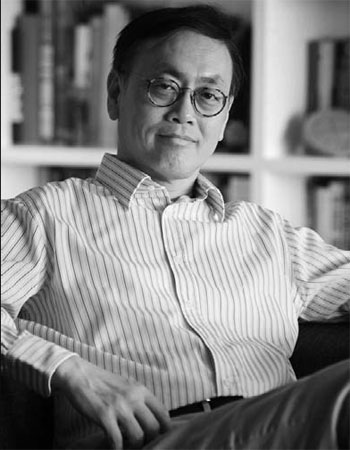 Edward Tse, chairman of global management
consultants Booz & Co in China, said the great majority of the companies he
deals with regard China as the most important market in the world. Edward Tse, chairman of global management
consultants Booz & Co in China, said the great majority of the companies he
deals with regard China as the most important market in the world.
"Even if they have not had a chance to go outside of China, they have a much
more international outlook," he said.
Tse at Booz and Co said that whether foreign companies entered China five or 10
years ago or now, it has always been one of the more difficult foreign markets.
"If an American company goes to Europe or a European company goes to the US
there are differences but the differences are not as great as when they go to
China. It has the longest continuous civilization in the world and the culture
and the way of doing things is very different," he said.
"China is not only an old nation but a new nation, which in my mind came into
being when the veteran Chinese leader Deng Xiaoping visited Shenzhen in 1992
(when he called for the creation of a socialist market economy). It is a very
odd combination."
Wu Changqi, professor of strategic management at Guanghua School of Management
at Peking University, said it is difficult to make a case it is harder to enter
China now than in the past because it was never easy in the first place.
"The Chinese market has never been an easy market for multinationals. Companies
which have come to China have always needed to do a lot of homework and
preparation. It is not easy to do business here," he said.
Wu adds there are areas where it has become easier rather than harder in recent
years.
"There have been a lot of improvements institutionally. The government is more
transparent. Government bureaucrats have become more competent and professional.
China too, to some extent, has become more integrated into the global economy, "
he said.
"China's speed of business development is so rapid it is not really for the
faint hearted. You need much more of a long- term vision to succeed in China
compared with other emerging markets."
Roy Newey, group board director of A4e, a services business which helps people
who are unemployed get back into work, is someone not daunted by the prospect of
entering China.
The Sheffield, UK-based operation is already in 11 international markets and is
hoping to set up an operation in the country soon.
"I have been on a China-British Business Council trade mission recently and I
didn't get any sense among those on that trip that there was any lack of
enthusiasm for doing business in China," he said.
Newey believes the company provides the sort of specialized service for which
there is a gap in the market.
"We help people who are out of work get back into jobs and we believe we could
play a role in China," he said.
Eric Schmidt, chairman of China Entrepreneurs, a Beijing-based organization
which promotes entrepreneurship and works with a number of foreign companies,
said in some aspects the market is tougher.
"The government is trying to promote local businesses and help them succeed and
that can have an impact on foreign businesses, but it really depends on which
sector," he said.
"In other technology sectors such as clean energy, however, there are a lot of
opportunities for foreign companies."
Cheryl Tang, director of The Beijing Axis, a consultancy which works with many
foreign multinationals, mainly in mining and natural resources sectors, said
there are now more opportunities for small- and medium-sized (SME) companies
than bigger companies in China.
"There seems not so much space for bigger companies to come to China. I see a
lot of opportunities for SMEs to come here with unique products and services.
Currently, we are helping an automotive lubricants company and they are doing
well here because they have products their competitors simply don't have, " she
said.
Wu at the Guanghua School of Management said one of the barriers to entering
China - that companies had to develop different strategies for different regions
of the country - seems to be disappearing.
He said a one-size-fits-all strategy for China would have a better chance of
working now than ever before.
"It actually defies traditional theories of comparative advantage. As areas of
the country develop they should in theory develop areas of specialization in
particular sectors or industries. What seems to be happening in China is that
everywhere is becoming more uniform," he said.
Tse, whose new book on tackling the China market, The China Strategy, has just
been published, said for those who haven't entered the China market there are
"leapfrogging" opportunities, where established companies in the country have
yet to catch up with an international consumer trend or an advancement in
technology.
"China's development is never a linear or incremental phenomenon but often non
linear so that outside companies can always leapfrog over incumbents," he said.
He insists, however, that whether the market has got more difficult to enter or
not, foreign companies have to have a more sophisticated approach than ever
before.
"You can no longer put your B or C team in China but you have to send you're a
team. It is not a matter of plugging them in and playing either. They have got
to appreciate the local context and that doesn't come naturally to a lot of
people," he said.
January 26 2010
 Mandarin for a Global Edge - Chinese Language Initiative
Mandarin for a Global Edge - Chinese Language Initiative
 Chinese language
instruction is exploding in American public schools. In this exclusive Asia
Society video, teachers and politicians explain why studying Mandarin gives kids
a global edge. Chinese language
instruction is exploding in American public schools. In this exclusive Asia
Society video, teachers and politicians explain why studying Mandarin gives kids
a global edge.
Young Americans from all walks of life are learning to speak Chinese in
elementary and secondary schools. Key educators and politicians weigh in on the
global advantage of studying Mandarin. (4 min., 50 sec.).
 Chinese Language Initiatives Chinese Language Initiatives

 Hon. Jon
Huntsman: Languages as a Bridge to the Future - Hon. Jon Huntsman--then Governor
of Utah and current U.S. Ambassador to China--discusses China, building a
prosperous future, and what his state is doing to prepare the next generation.
Chicago, May 1, 2009. (24 min., 27 sec.)
http://www.asiasociety.org/video/education-learning/hon-jon-huntsman-languages-bridge-future Hon. Jon
Huntsman: Languages as a Bridge to the Future - Hon. Jon Huntsman--then Governor
of Utah and current U.S. Ambassador to China--discusses China, building a
prosperous future, and what his state is doing to prepare the next generation.
Chicago, May 1, 2009. (24 min., 27 sec.)
http://www.asiasociety.org/video/education-learning/hon-jon-huntsman-languages-bridge-future
December 23 2009
Overseas investment
poised to pick up pace
China will aim to accelerate outbound investment next year as the country sees
many opportunities abroad, the Ministry of Commerce said yesterday.
The ministry estimated that non-financial outbound foreign direct investment by
mainland firms would reach US$42 billion this year, level with last year's total
of US$41.9 billion.
The government reminded state-backed firms to remain prudent when buying
overseas assets as the world was battered by the global economic crisis. It
believes asset prices will further depreciate.
The ministry did not detail what measures it would take to promote overseas
investment in the coming year. It also added in a statement on its website that
there were many uncertainties because of rising protectionism.
The overwhelming focus of Chinese firms making overseas plays this year has been
on natural resources.
Among the biggest deals, oil refiner Sinopec Corp (SEHK: 0386) bought Swiss oil
explorer Addax Petroleum Corp for US$7.15 billion and Yanzhou Coal Mining (SEHK:
1171) bought Australian coal miner Felix Resources for US$2.9 billion.
Some companies also closed their acquisition deals with global carmakers, such
as little-known equipment maker Sichuan Tengzhong Heavy Industrial Machinery,
which bought out Hummer, while Beijing Automotive Industry Holding bought
certain know-how of Saab.
The ministry said earlier it supported the parent of Geely Automobile Holdings (SEHK:
0175) in its bid to acquire Ford's Volvo passenger car unit.
However, Chinese firms have had to end some plans for political reasons. On
Monday, Northwest Nonferrous International Investment backed out of a deal to
invest in a Nevada gold mine owing to United States national security concerns.
For now, there is still more investment flowing into China than out of the
country. It attracted US$77.9 billion in foreign direct investment in the first
11 months, 9.9 per cent less than last year. It drew a record US$92.4 billion in
non-financial foreign direct investment last year.
December 17 2009
Clarification on Foreign Exchange
Payments for Reinvestment
The State Administration of Tax and the State Administration of Foreign Exchange
have jointly issued a circular which provides additional clarification on tax
certificate requirements for service industry items and transactions.
The circular expands the list of items that do not require tax certificates,
including payments made by contractors for overseas engineering/construction
projects, payments to overseas freight forwarders for international air or land
transportation, accommodation and traveling expenses paid by domestic travel
agencies on behalf of outbound travelers and payments by securities companies of
dividends, interest and proceeds derived from selling securities to overseas
institutions and individuals.
New requirements for forex transactions -Companies based in China making
domestic forex transfers, re-investments or capital increases with mainland
China must present tax certificates issued by the in-charge tax authority to be
presented to local branches of SAFE or designated banks, including:
- Foreign investors of a Foreign Invested Enterprise (FIE) using dividends for
domestic reinvestment or capital increase, or FIEs using capital reserves,
surplus reserve or undistributed profits belonging to the foreign investors, to
make domestic reinvestment or capital increase;
-Foreign investors using proceeds from early repatriation of investment,
liquidation, disposal of equity, and capital reduction to make reinvestment in
China;
-Subsidiaries of FIEs paying dividends in forex to the China Holding Company.
Specific outbound forex remittance - The following outbound Forex payments must
be supported by tax certificates issued by the in-charge tax bureau:
- Payments to airline companies by domestic travel agencies for air tickets sold
on their behalf;
- Remittance of investment gains by qualifying foreign investment institutions (QFIIs);
- Remittance of forex converted from renminbi generated from the sale of A
shares or from dividends by a foreign investor who has legally acquired A shares
of companies listed on Chinese stock exchanges
Treatment for representative offices of foreign airline companies - Remittance
of outbound air tickets sales revenue by the representative office of a foreign
airlines (including Hong Kong, Macau and Taiwan-registered airlines) can either
be supported by a tax exemption notice issued by the in-charge tax bureau, or a
document evidencing mutual tax exemption for international transportation income
under an international aviation agreement signed between China and the pertinent
jurisdiction instead of a tax clearance certificate.
Foreign individuals - According to the circular, outbound service payments made
by foreign individuals shall follow the forex administration rules set for
individuals.
Tax certificate issuance and review - Tax certificates should be issued by the
in-charge tax bureau and local tax bureau respectively following the settlement
of the pertinent China tax liabilities. These shall be reviewed by the
designated forex bank to which the payers present the supporting documents for
forex payment.
If multiple remittances are required, the banks should note the amounts of
payment, dates and apply the bank seal to the original tax certificates and
should keep them for a five year period.
December 16 2009
China’s Challenges
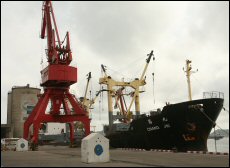 A recovery in the
export sector is part of the thinking behind the mainland’s stimulus plan A recovery in the
export sector is part of the thinking behind the mainland’s stimulus plan
A recovery in the export sector is part of the thinking behind the mainland’s
stimulus plan
The Chinese mainland’s economic growth since opening up to the world 30 years
ago has been nothing short of breathtaking. And, after the country’s accession
to the World Trade Organization in 2001, that growth has intensified, to the
point where the mainland is poised to overtake Japan next year as the world’s
second-largest economy.
Thanks to Beijing’s Rmb4 trillion investment programme and increased lending by
state-owned banks, the mainland economy has continued to flourish through the
global slowdown. The International Monetary Fund forecasts economic growth of
8.5 per cent this year and nine per cent in 2010.
But the Central Government faces many challenges, including the country’s
over-reliance on exports; the need to boost rural incomes and shift to a more
consumer-oriented economy; pressure to revalue the renminbi; and trade friction
with the United States.
Two-Pronged Stimulus
 Dr Stephen Roach,
Morgan Stanley Asia Chairman, doubts the mainland’s stimulus package alone can
resolve deeper macroeconomic issues Dr Stephen Roach,
Morgan Stanley Asia Chairman, doubts the mainland’s stimulus package alone can
resolve deeper macroeconomic issues
Stephen Roach, Chairman of Morgan Stanley Asia and an influential economist
whose new book is called The Next Asia, doubts that the Central Government’s
stimulus package alone can resolve the deeper macroeconomic issues.
Dr Roach acknowledges the “striking pickup in Chinese economic activity” this
year, but warns “there are two pieces to the Chinese stimulus that we need to
think very carefully about.
“First is the investment impetus, which has been very powerful and has accounted
for about 95 per cent of all the GDP growth that China has had in the first
three-quarters of this year. The second piece, though, is the hope that the
export sector will kick in once global trade turns around. I’m more dubious on
that piece of the stimulus working, not through any fault of China’s, but simply
because the rest of the world has been weak and is likely to remain so.”
Dr Roach predicts that, as the investment stimulus starts to fade around the
middle of next year, the continuing lack of demand for mainland exports will
become more evident, possibly slowing economic growth to seven per cent or
lower. “And then I think the government will opt for another investment
stimulus, which is not necessarily the most strategic thing for China to do.
“China has done a very good job at shaping policies to drive economic
development [and] transformation in the past 30 years, but there’s a big shift
coming in China as the economy now begins to lose its impetus from external
demand and must [move] to a greater support for internal demand. So the Chinese
government in the upcoming 12th Five-Year Plan will, I think, put in place
policies that are much more pro-consumption than we see today, both in terms of
the safety net – support to rural incomes – and a blueprint for the development
of large-scale consumer-products and services industries.”
He also believes that the government is committed to making the currency
convertible in future. But, he cautions, “There’s a lot of focus on the renminbi
right now. I don’t think it’s in China’s best interest to move aggressively on
its currency just because some of its trading partners are complaining due to
problems of their own.”
Trade Friction
Recently, Beijing and Washington have been at odds over mainland-produced tires
and steel pipes.
“There are growing tensions on that front right now, which quite frankly are
pretty disconcerting,” says Dr Roach. “The United States, as you know, is
dealing with a 10.2 per cent-plus unemployment rate, enormous pressure on
middle-class American workers in terms of job security and real wages. There’s a
growing sense in political quarters that China, particularly because of its
undervalued currency, plays a disproportionate role in causing these problems in
the US middle-class. And it’s a politicians’ move to impose some type of trade
sanctions on China. It’s unfortunately not a low-probability chance, in my view
then, we can have a major problem on our hands.”
Currency Question
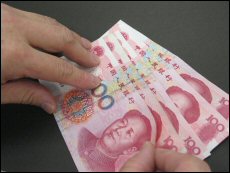 The mainland is under
international pressure to revalue the renminbi The mainland is under
international pressure to revalue the renminbi
The mainland is under international pressure to revalue the renminbi
On the possibility of the renminbi appreciating, Professor Nouriel Roubini,
Professor of Economics and International Business at New York University’s Stern
School of Business, notes that mainland leaders are known for acting cautiously.
“They’ve re-pegged [the renminbi to] the US dollar, and that is one of the main
problems of the global economy, because as the dollar is falling, the Chinese
currency is falling relative to everybody else with the dollar,” he says. “There
has been political pressure from Europe, from Japan, to force the Chinese to
appreciate the renminbi. Even if they’re going do that in the next few months, I
think that the amount of appreciation is going be very, very small and cosmetic
. . . maybe two or three percentage points per year, because they’re worried
about jobs, about their exports, about their own stability.”
Sir David Brewer, Chairman of the China-Britain Business Council (CBBC), which
helps British companies get into the mainland market, agrees that a shift to a
more consumer-oriented economy is needed.
When Chinese Premier Wen Jiabao was in the United Kingdom in February, he says,
he spoke at a CBBC dinner “about the healthcare scheme that he was introducing,
which was designed to try and help people, particularly in the countryside, not
to have to put so much money under the mattress for fear of one day having to go
to a city and fork out money for medical attention and medicine.
“He felt it would take some time for the people in the countryside to relax on
that side but, ultimately, if they knew they weren’t going to have an unforeseen
expense for healthcare, that would perhaps reduce the percentage they felt they
had to [save] and maybe get it from 50 per cent to 40 per cent.”
Mainland Business Matching
 Sir David Brewer,
Chairman of the China-Britain Business Council, says UK companies are looking
for mainland investment opportunities Sir David Brewer,
Chairman of the China-Britain Business Council, says UK companies are looking
for mainland investment opportunities
Sir David says many UK companies are looking for investment opportunities on the
mainland, and not only to export. “People are happy to manufacture in China
because they believe now they can supply the Chinese market rather than just
rely on exports. A British company wouldn’t go to France just to serve the
British people, or to bring back to the UK. They want to get into the French
market. And I think the same thing applies even more so with the size of China.”
The CBBC is currently working on matching British small and medium-sized
companies with counterparts in 35 mainland cities, in such sectors as the
creative industries (including animation and computer games), medical
technology, biotech, and information and communication technology. “They
wouldn’t get, say, the headlines of Rolls-Royce exports, but it does provide
employment back here and in China through shared technology.”
He’s also upbeat about collaboration in financial services on the mainland. “I
find that every city one goes to has its own financial street or its own
financial block, where they want to get the financial-sector companies, Chinese
and international, clustering together, and they often quote the City of London,
saying, ‘That’s what you’ve got in London, that’s what we want to have on a
smaller scale here.’”
Sir David estimates that there are 274 Chinese cities with a population of more
than one million, including 33 with populations exceeding 10 million. “In the
whole of Europe, we only have four. Take out Beijing, Shanghai, Guangzhou and
Hong Kong, you’ve still got another 30 or so huge cities. Those are the ones
we’re trying to get to.”
December 1 2009
Rmb500,000 (US$73,500)
Start-up Subsidy for Overseas Returnees
The Ministry of Human Resources and Social Security (MOHRSS) recently decided to
introduce a start-up support plan for overseas returnees. The maximum amount of
such subsidy is Rmb500,000 per returnee entrepreneur.
A number of enterprises with strong innovation capability, development potential
and market prospects started by overseas returnees will benefit from this plan
each year to speed up the commercialisation of research achievements.
Suggestions for Implementing the Start-up Support Plan for Overseas Returnees
recently issued by MOHRSS pointed out that the plan will give priority to
projects in the fields of electronic information, biomedicine, new materials,
new energy and other high-tech industries as well as in modern services like
finance, logistics, information and business services that are badly needed in
China. Funds will come from the government as well as from different sectors of
society, with government input boosting society input, to create a favourite
atmosphere for overseas returnees to start their own business.
By supporting overseas returnees to start their own business, the plan hopes to
promote the optimisation of the industrial structure, raise the ability of
independent innovation as a whole, gradually develop a number of high-tech
enterprises with core competitiveness and foster a number of modern enterprise
management personnel with high professional competence, great technology
prospects, good overseas connections and a sound knowledge of international
practices.
It is understood that the “start-up support fund for overseas returnees” will be
managed by MOHRSS as project expenditure and spent on selected enterprises set
up by overseas returnees. Key projects selected by MOHRSS will be granted a
lump-sum subsidy of Rmb500,000, while outstanding projects selected will receive
a lump-sum subsidy of Rmb200,000. The local governments where the projects are
located should also offer funding support.
Trademark Agents Must Keep Clients’ Trade Secrets
Under the Administrative Measures for Trademark Agency Business promulgated by
the State Administration for Industry and Commerce on 17 November, trademark
agents must keep the trade secrets of their clients and must not disclose to
other entities or individuals any undisclosed agency task without their clients’
consent.
Trademark agencies refer to trademark agency organisations that accept the
entrustment of clients and handle trademark registration applications and other
relating matters for their clients. Trademark agents refer to people working in
trademark agency organisations.
According to the Administrative Measures for Trademark Agency Business,
trademark agents must have full capacity for civil conduct, be familiar with the
trademark law and relevant laws and regulations, possess trademark agency
professional knowledge, and work in trademark agency organisations.
Trademark agents are prohibited from working in two or more trademark agency
organisations or disclosing undisclosed agency tasks to other entities or
individuals. They must refuse if they know the entrusted tasks are malicious or
if the acts are in violation of state laws or are deceitful.
Trademark agents may be warned or given a fine of up to Rmb10,000 by industry
and commerce administrations at or above the prefectural or county level in
their place of work or in the place of the act if they violated the above
provisions.
Trademark agency organizations are prohibited from accepting the entrustment of
the two parties involved in the same trademark case. Otherwise they are liable
to a maximum fine of Rmb30,000.
Trademark agency organisations are legal service entities that are entrusted by
clients to handle trademark registration applications and other
trademark-related matters. They may, acting on the entrustment of clients,
appoint trademark agents to handle their trademark registration applications,
alterations, transfers, oppositions, cancellations, reviews, infringement
complaints and other matters.
China to Expand Pilot Program on Currency Exchange for
Individuals
The State Administration of Foreign Exchange (SAFE) has recently expanded the
pilot franchising of local to foreign currency exchange business for individuals
to meet growing demand. It has also made improvements to the relevant
administrative measures.
Beijing and Shanghai began a pilot programme to allow franchised operations to
provide local to foreign currency exchange services to individuals in August
2008. SAFE expanded the scope of the programme and the types of business offered
on this basis.
The gist of the expanded programme is as follows: First, the scope of the
programme is extended to cover 13 provinces, autonomous regions and
municipalities (including Beijing and Shanghai) and the four cities with
independent planning status. Second, the number of franchised operations is
increased and they are encouraged to set up sub-branches in other districts
within the pilot areas. Third, the procedures for currency exchange are made
simpler. For currency exchange transactions of under US$500 by individuals,
money-changers may process the transaction first and record the transaction on
the individual foreign exchange settlement and sale management information
system later. Fourth, specific requirements are spelled out for the supervision
of money-changers with equal emphasis on compliance and convenience.
According to SAFE, the expansion of the programme beyond Beijing and Shanghai
will help meet the demand for money exchange services in areas where foreign
economic relations are thriving as well as in international tourism centres and
border ports, promote fair competition in the currency exchange market for
individuals, and fully bring into play the advantages of franchised operations
in having longer business hours, covering a wider range of currencies, and being
more flexible in operation.
What merits attention is that the programme is extended to cover border
provinces like Guangxi, Yunnan and Xinjiang this time. These provinces may make
use of the services provided under this programme to settle some of their border
trade payments, said a SAFE official.
Shanghai Disneyland project spurs new round of investment
Investment opportunities relating to the Shanghai Disneyland project will, from
now on, move in tandem with the progress of the project now that it has got
state approval. The Disney concept will extend from speculative real estate
investment at the beginning to the hospitality, tourism and infrastructure
sectors.
On the whole, the Disneyland project has its similarities with the Shanghai
World Expo in that both are one-off infrastructure investments that will provide
a lasting boost to tourism consumption.
1. Boosting property price around the proposed park
The Disneyland project will boost the local economy. The most obvious gain will
be escalating land and property prices under the spur of the brand effect and
anticipation of better supporting facilities around the proposed park. Listed
companies with land resources in Chuansha and the surrounding areas will benefit
most from this project.
2. Spurring consumption
The Disneyland Resort will have the capacity to receive 10 million visitors when
completed and will bring at least 3 million to 5 million more visitors to
Shanghai each year. This will translate into business opportunities for the
hospitality, retailing and transportation sectors. To begin with, since tourism
consumption will enter a golden age of development when per capita GDP exceeds
US$3,000, the Disneyland project can expect to attract a large number of
visitors. Furthermore, with the scheduled completion of the Shanghai-Hangzhou
Express Rail Link, Nanjing-Shanghai Rail Link and Nanjing-Hangzhou Intercity
Railway after 2012, Shanghai Disneyland will be able to effectively serve the
whole Yangtze River Delta, even eastern, northern and northeastern China. The
huge regional economy will guarantee the success of the project.
3. Stimulating increased demands in other industry chains
Disney’s revenue mainly comes from four lines of business, namely, media
networks, parks and resorts, studio entertainment and consumer products. From
the angle of industry chains, the completion of Shanghai Disneyland should be
able to generate a lot of business opportunities in toy production, advertising,
publishing and printing, cable TV, internet and other sectors.
4. Investment opportunities
According to media reports, the first phase of the Shanghai Disneyland project
will cover an area of 150 hectares and involve an investment of about Rmb24.48
billion, approaching the level of the World Expo. Large-scale investment and
construction will generate opportunities for the construction and building
material industries.
The boost in consumption that comes with the completion of Disneyland project
will generate opportunities in the consumer industries, such as tourism,
hospitality, retailing and transportation, as well as stocks in related industry
chains, such as toy production, advertising, publishing and printing, cable TV
and internet services.
October 27 2009
Pudong to Build National Digital TV Industry Park - Shanghai’s Pudong
will soon have its own “digital valley” in the form of a national digital TV
industry park. Construction will begin before the end of this year and the
project is expected to become operational in 2010
Shanghai Intellectual Property Transaction Center Officially Opens - The
Shanghai Intellectual Property Transaction Center, to be actually operated by
the Shanghai United Assets and Equity Exchange (SUAEE), officially opened on 11
October 2009. The centre will provide a platform for the evaluation and transfer
of pledge in intellectual property (IP) pledge financing
New Version of License for Lawyers and Law Firms Comes into Use on 1 October
- China’s Ministry of Justice recently issued an announcement saying that
pursuant to the Lawyers’ Law and the relevant regulations and normative
documents, it had redesigned and printed a new version of practice license for
lawyers and law firms
October 1 2009
Hail the next global leader - While crystal-ball gazing towards 2049 yields only
murky visions, scholars agree China will soon be acknowledged as the dominant
world power - THE NEXT 60 YEARS by Ting Shi
Life is good for Zhong Guoren . The 42-year-old founder of Green Dragon has seen
his solar energy company grow into the world's top in its field since the
central government instituted a phased carbon tax on all fossil fuels nine years
ago.
An initial public offering four years later raked in a solid seven billion yuan
- the de facto world currency - and Green Dragon has maintained darling status
on the Shanghai stock exchange, the world's largest.
Zhong's success came after a gradual but massive switch to alternative energies
worldwide after global oil production peaked 30 years ago and oil prices reached
disastrous levels.
He often remembers his father telling him of how some countries went to war for
the doomed resource.
Zhong says goodbye to his two children, who are driven to Confucius Renaissance
Middle School by robotic helper Abian , which he recently shipped over from
Taiwan, a federal state of China.
He then takes his morning run around Tiananmen Park, the biggest green area in
central Beijing that once witnessed massive political gatherings and troop
processions.
Zhong has a busy day planned. He has to pop over to meet UN Development
Programme officials in its recently relocated headquarters in Beijing to talk
about a charity project aimed at beaming electricity to the remote town of
Kimpese in Congo.
Kimpese is in one of the few non-urbanized areas in Africa - a continent whose
economic and social landscape has been transformed by Chinese capital and a
massive wave of Chinese immigrants, who have become the dominant ethnic group in
every corner of the continent.
After the meeting, Zhong has to rush down to Qingdao , now the world's
third-biggest port, to preside over a joint venture with a San Jose-based solar
company that used to be the market leader.
Zhong plans to be back in Beijing by 7pm to watch the live broadcast of the
launch of the "Ziqiang VII" space shuttle's manned mission to Mars. The newly
elected government, the right-wing Youth Force of China that splintered from the
Communist Party 12 years ago on a slogan "for people who give a damn", decided
this was the perfect way to mark the centenary of the People's Republic of China
today - October 1, 2049.
An economy twice as big as that of the US
Gazing into the crystal ball at China's future offers any number of visions.
Factors - ranging from political stability and economic sustainability to
climate change and war - are weighed in judgments of where the country could
stand in 2049 and beyond.
There is consensus on one important point - that the economic performance of the
past three decades is no flash in the pan. Forty years from now, with an output
double that of the United States, China will have climbed to the top of the
economic podium.
According to Mao Yushi , one of the mainland's most influential economists, the
economy by then will not only be bigger - it will also be healthier.
The services industry will increase its share of gross domestic product to 80
per cent, from the current 41 per cent, reflecting a new consumer orientation.
The grotesque trade imbalances, which have mainly been driven by the country's
excessive dependence on exports, will ease off, Mao predicts.
Among the world's top 500 firms, Chinese companies will account for 300 to 400,
most likely in telecommunications, vehicle production, banking, petrochemicals
and electronics. With present barriers to free competition having been
eliminated by then, the telecoms sector will become the most dynamic element in
the national economy. Also, China's pharmaceutical companies and research
institutes will be reaching for the global lead in biotechnology, particle
physics, genetic engineering and other hi-tech fields.
An economy topping the global chart would almost certainly give China commercial
and institutional leadership in the world, says Albert Keidel, former senior
associate in the China programme at the Washington-based Carnegie Endowment for
International Peace.
Fluctuations in its domestic demand will send ripples around the world, he
predicts. Market surveys will focus on China first. Its monetary policies will
affect liquidity and interest rates everywhere. Its commodities and securities
markets will be the world's largest, and will heavily influence global standards
for due diligence. Leadership of international institutions such as the United
Nations, International Monetary Fund and World Bank will gravitate towards
China.
The United States will have an important secondary influence, but it will need
to compromise and its sphere for unilateral action will be increasingly
curtailed, Keidel says.
If the development path continues, it will be among the world's top 30
modernised nations 40 years from now, Mao says. In 2049, the standard of living
will be higher than for Americans today - although still behind two-thirds of
Americans at that time. Average personal income will hit US$25,000 to US$30,000
a year, lifting wages about 50-fold in rural areas and virtually eradicating
poverty.
Demographic dividend turning into demographic tax
By then around 80 per cent of the population will live in cities, compared with
44 per cent now, according to forecasts by McKinsey Global Institute. Once a
population's urban share becomes predominant and most families enjoy higher
urban-style living standards, overall inequality declines. The country's Gini
coefficient, which has been rising steadily from below 0.3 four decades ago to
0.46 today, should drop back to the range of 0.3 to 0.4, Mao says.
But at the same time, China will reach a stage where its demographic dividend,
which has been the principal driver of its growth, turns into a demographic tax.
The population is projected to be outstripped by India in 20 years, will see its
working population shrink considerably and the ratio of the elderly (those aged
above 65) rise from 8 per cent of the population to an expected 25 per cent in
mid-century, according to a UN forecast.
The ageing population means increased health, pension and labour costs, all of
which will erode the mainland's competitive advantage, says Dr Minxin Pei,
political scientist at Claremont McKenna College.
More importantly, Pei says, this will also cause the savings rate to fall. This
means the government will be unable to continue subsidising industrial growth
with private wealth. In a global context, declining savings rates and labour
supply relative to competitors will have a negative impact on capital flows and
foreign direct investment. Thus, with fewer people entering the workforce and an
ageing population, China faces the curse of an old cliche - getting old before
getting rich.
"A very new kind of number one"
So, will China be able to sustain its status as number one? And will it gain the
technological, military and cultural leadership that comes with superpower
status?
Andrew Nathan, a political scientist at Columbia University, believes China will
almost certainly become the world's largest economy, but this would not confer
as much power as it did in the past.
"Historically speaking, China will be a very new kind of number one," he said.
Unlike other number ones in history, China is not likely to be the world's
leader in science and technology, despite forecasts by the Chinese Academy of
Sciences on a Chinese base on the moon or even Mars by mid-century. Unless the
other hi-tech nations stop competing, China will not surge ahead of them in a
wide range of fields to become world leader like 19th century England or the
20th century United States, Nathan says.
Nor will it dominate militarily. It will not be able to gain energy or commodity
security through conquest the way the colonial powers did or through the
indirect neo-colonial control of the US. Barring the collapse of other strong
powers, there will be no power vacuum to expand into, nor will China have the
kind of military lead to force its way to supremacy, Nathan says. China will
have to get hold of the resources that it needs through economic means.
Then, will a hegemonic China exercise its power in any manner familiar from the
American experience? Stanley Rosen, director of the East Asian Studies Centre at
University of Southern California, says no.
In contrast to the self-image of the United States as a special, chosen nation
created to play a unique role in history as a messenger of universal values such
as liberalism, democracy and human rights, the "Chinese model" begins with a
fear of chaos and disorder brought about by a weak central government. Thus the
goal in China is domestic stability, not the projection of its ideology to other
nations.
"If the American `national interest' implies not just economic prosperity (SEHK:
0803, announcements, news) and civil liberties at home, but a world where others
also enjoy a variety of political freedoms, the Chinese national interest is far
more limited and domestically defined," Rosen says.
China in 2049 is likely to reside in a multipolar world in which its influence
is exercised more subtly, without the military adventures that have marked the
American model, Rosen says.
Still, top-dog status would confer special influence on China as it has on other
economic leaders in history, Columbia University's Nathan says.
Less tangibly, we should expect to see a "Sinicisation" of global culture
through the influence of Chinese consumers' tastes, Nathan predicts. Clothing
styles, food flavours, the design and packaging of global brands, music, sports
and entertainment would respond to the draw of the Chinese market. More and
more, we should expect to see our youngsters studying Chinese and Chinese become
the most popular choice of foreign language across the continents.
Stumbling blocks to pre-eminence
Nevertheless, there remain significant hurdles for China to overcome in its
march to pre-eminence.
The major stumbling blocks will be social instability, corruption and
environmental challenges, says Orville Schell, a veteran China watcher.
Some argue that an affluent society would minimise social and ethnic tensions,
but Schell says tensions in Xinjiang and Tibet give little cause for optimism,
even though these two regions are far more irrevocably integrated into China as
parts of a multi-ethnic nation than Taiwan.
On the environment, David Sandalow, the US assistant secretary of state for
energy, projects a 2.7 degree Celsius temperature rise by 2050 as the result of
unchanged emissions in China and an 80 per cent cut elsewhere. However, if China
promotes low-carbon output, according to the country's top climate change
policymakers, its carbon emissions could peak around 2030 and by mid-century use
of fossil fuels could drop to 70 per cent from the current 90 per cent. China's
carbon emissions "could fall to the same levels as in 2005 or even lower".
Schell, director of the Centre on US-China Relations at the Asia Society, says
people should be encouraged by the speed with which Beijing had started to
become aware.
"When Chinese leaders finally do dedicate themselves to solving problems, they
have proven able to accomplish amazing things," he says.
The speed of the awareness is a reflection of the urgency required. By
mid-century, China will have to have completed a transition away from being an
oil-based economy, thanks to decreasing production and increasing energy demand.
The South China Sea, a disputed area now for its oil and gas resources, might
not be as disputed when we enter the "post-oil era".
The real question
Arguably the biggest question mark of China's future is over politics. Can the
leadership continue to be dominated by the same fairly small group and their
offspring? Or will ordinary people - aided by technological advances and
increasingly aware of their rights and willing to protest - start to have more
of a say?
Perry Link, a renowned Sinologist at University of California at Riverside, says
China's political fate depends on how these two big forces play out.
"My guess is that 40 years from now the Communist Party will no longer own a
monopoly of political power and that its `royal families' will have less control
of politics and the economy than they now have," Link says.
Can the Communist Party become one party among many? Is it willing to allow such
competition? Will the party fashion itself, say after Japan's Liberal Democratic
Party, whose party presidency rotates frequently enough among the heads of its
several main factions to balance the entrenched interests of each? Do the
Chinese people really want a messy, multiparty democracy? "We have had no model
for a country as large and important as China making a successful passage from
being a Marxist-Leninist one-party state to ... to what? That is the real
question," Schell says.
Rosen predicts "a hybrid form" in which democratisation in a Western sense does
not occur, but public opinion plays an increasingly prominent role. The exercise
of central power will become more selective, opening up new avenues for local
initiatives in policy innovation and implementation.
Much of the change will be fuelled by a combination of new technologies, the
rising expectations of an increasingly confident middle class, and the rapid
change in younger generations, marked by an increasing boldness and lack of
respect for any established authority. Today's "angry youth", some of whom would
still be angry at middle age, will push future governments to aggressively
pursue China's interests. The middle class, who quietly endorse the leadership
in Beijing today, may change its political attitude and play an important role
in the struggle for democracy.
Will a future leadership struggle produce a contender who will "play to the
masses"? "It is certainly possible to conceive of a charismatic strongman
arising over the next 40 years if the promised wealth and power become unfilled
promises," Rosen says.
If the current elite manages to stay on top for another 40 years, Link says, his
fear is that they will do it by stimulating and exploiting nationalism.
"Emotional ethnic pride may be the only force in the Chinese national psyche
that is potentially strong enough to cause people to set aside the other worries
that have recently been fuelling their protests: corruption, official arrogance,
pollution, the gap between rich and poor, and so on," Link says. "It is
possible, probably a 20 per cent chance ... that 40 years from now the
[Communist Party] will run a successful monster state based on ethnic
chauvinism. This, if it happens, would be bad news for the world."
While China has begun to amass real economic, military and geopolitical clout,
there are doubts over the level of international acceptance it can achieve over
the next 40 years under the present system. "Great power" status will not come
until it has matched its political and economic might with moral power, Schell
says.
Such "moral-suasion" is a quality much esteemed in the Confucian scheme of
things, but it is at odds with many aspects of contemporary Chinese governance.
Link says full cultural and moral respect will not come until there is a
fundamental political change.
"The truth is that the Communist Party itself provides all the main reasons for
China's continuing loss of face in world opinion," he says. "The international
image of China would rise dramatically if it were able to get out from under its
current rulers and their system."
According to Columbia's Nathan, this type of transition is unlikely to come
easily - or quietly.
The regime is willing to change in any way that helps it stay in power, but is
unwilling to relax the ban on autonomous political forces, Nathan says.
"This makes it more likely that regime change, should it come, would occur
through some kind of rupture, when the elements of potential crisis come
together."
The most likely form of transition for China, therefore, remains the model of
Tiananmen, with three elements coming together.
The first element is a robust plurality of disaffected citizens. The 1989
protests broke out because of inflation and corruption; Nathan identifies
potential future triggers as unemployment, an environmental disaster or some
form of national humiliation.
Second comes a catalytic event that sends a signal to scattered social forces
that the time has come to rise up.
The third element is a split in the leadership, whether due to personality
differences, power struggle, uncertain support of the armed police and military,
or ideological division, that renders the response from the top uncertain or
weak and allows the challenge to snowball, Nathan says.
One factor that is important to remember is how often developments in China have
surprised even the best-informed scholars. One prediction seems safe - that
China will surprise the rest of the world again by 2049.
"In China, one must always be ready for the unpredictable," Schell says.
September 19 2009
Scenic city bought on brands
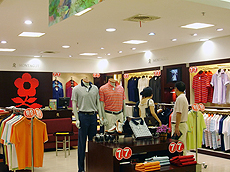 Parkson positions itself in the
mid-price market. Parkson positions itself in the
mid-price market.
The Nanchang Parkson Shopping Centre is the first department store opened by
foreign-invested, chain-operated department store group Parkson in scenically
beautiful Nanchang in Jiangxi Province; it's learned a sharp lesson of how one
area can be totally different from another on the Chinese mainland for shopping
appeal.
Zhang Jun, Deputy General Manager of Parkson tells the story of how the store
chain made its entry into the city's market by purchasing Nanchang Pacific
Shopping Mall by stock acquisition.
At the beginning, Parkson sold young fashions popular in the coastal regions
adjacent to Nanchang. But after two years of operation, the group came to
realise that Nanchang consumers are quite different. They tend to shop for
established, more conservative brands.
For instance, established brands such as Goldlion and Montague sell very well.
On the other hand, the city's consumers are rather slow to accept new brands or
fashion items.
Part of the reason is that Nanchang incomes are not high and their spending
power is rather limited.
Hongkelong Department Store Investment Co Ltd is the largest local commercial
enterprise chain in Jiangxi. According to Wang Mingbiao, the CEO, Nanchang has a
relatively small population and its market size is not big. The consumption
power of its residents is weaker than that in neighboring cities such as Wuhan
and Changsha.
Average monthly incomes of white-collar workers in Nanchang are between about
Rmb2,000 and Rmb3,500, with housing being the largest expenditure item.
People don't have much money to spare. So, consumption among Nanchang residents
is rather conservative and most live closely within their means.
It is perhaps for this reason that when Nanchang residents shop they mainly go
for established brands because they don't want to risk buying new brands or even
"new" fashion items.
Since the spending power of youthful Nanchang consumers is limited and that of
their elders more mature, Parkson decided to adjust its approach and switching
its focus to mature ladies' and men's garments, targeted at customers aged over
30.
High-end department stores are generally still in the development stage in
Nanchang. Hongkelong Group opened its Caifu Plaza in 2004 in the hope of turning
it into upmarket department store. It offered imported international
top-of-the-market brands. However, for the next four years the store made a
loss. It's only this year that profits have begun to appear.
As for Nanchang Parkson, its positioning is slightly lower than that of Caifu
Plaza. In the first half of 2009, gross profit margins dropped as intense market
competition led to frequent discounts and free offers.
The scale of profitability in the Nanchang market is not very large, but there's
been relatively fast growth in the past few years. In 2008, total retail sales
of consumer goods grew 24%, higher than that of Wuhan (21.8%) and Changsha
(22.8%).
In the first half of this year, the growth of Hongkelong Group's sales of
general merchandise hit 25.8%.
Sept 1 2009
Canton Fair Considers Promoting
The Canton Fair is considering something new again after holding the first
foreign and domestic trade matching service in the last session. The Department
of Foreign Trade of the Ministry of Commerce (MOFCOM) recently circulated a
letter calling for support for the Canton Fair in studying the feasibility of
staging an export commodities sales exhibition at the end of each Canton Fair.
It is understood that the views of fair exhibitors are being gauged on this
intended reform.
Open to the public for two days - MOFCOM said in the letter that the plan is to
help enterprises cope with the financial crisis and open up the domestic market.
The sales exhibition will last four days. The first two days is for trade only
and will only open to specialised domestic buyers while the last two days are
open to the public.
MOFCOM and provincial and city government departments have been holding frequent
exhibitions for domestic sales of goods originally produced for export and
foreign and domestic trade matching service since the Spring Canton Fair this
year. In mid-June, the Guangdong provincial government held the first Guangdong
Foreign-Invested Enterprises Products Expo in Dongguan.
Some exhibitors said that they would give it a try only if the government agreed
to provide booths to them free of charge. However, booths at the Canton Fair are
not free. MOFCOM said in its letter that the Canton Fair charges Rmb7,500 for a
standard 9-sqm booth and Rmb790 per sqm for raw space.
Cold initial response - Since many enterprises have been seeking channels for
domestic sales in the past year or two, they may consider joining after
calculating the costs. However, they are against opening the fair to the public,
saying that this will not be of any help to export enterprises and will only
downgrade the Canton Fair.
Meanwhile, some enterprises are just not interested. They think that this
stopgap and piecemeal solution will only make export enterprises lose their
bearings. Some enterprises with an annual export growth rate of over 30% in the
past only managed to reach last year's level this year. They would rather wait
for the US and European markets to recover than to change their direction just
because of the economic downturn in order not to fall between two stools.
Assessment Required for VAT Refund from
1 September
The policy of immediate VAT refund has been replaced with assessment before
refund since 1 September 2009. Taxpayers with irregularities will have
difficulty claiming refunds and may even be referred to the tax inspection
departments for investigation and handling.
According to a circular recently issued by China’s State Administration of
Taxation, the competent tax organs will first assess the sales amount changes
and VAT tax burdens of taxpayers eligible for immediate VAT refund after
receiving their refund applications.
The competent tax organs will suspend the examination and approval of refunds
and carry out field investigation and other assessment measures to find out the
causes if irregularities are found in the sales amount changes and VAT tax
burdens. If doubt remains over the irregularities after the assessment, the
competent tax organs will stop processing the refund procedures and the cases
will be referred to the tax inspection departments for investigation and
handling.
Aug 4 2009
CBRC: No Credit Cards to Students under 18
- The China Banking Regulatory Commission (CBRC) recently issued a circular on
the further regulation of credit card business, stressing that banking financial
institutions must strengthen the regulation and risk management of credit card
business.
Yiwu Customs Officially Opens - The customs office at Yiwu, the world’s largest
distribution centre of small commodities, officially opened for business in
mid-July. This is the first customs house established in a county-level city
under the jurisdiction of Hangzhou Customs.
July 31 2009
Wedding bells ring the profits - - report from the Asia-Pacific Wedding
Photography and Wedding Supplies Expo 2009, Beijing
 |
|
Glamorous bridal attire. |
Visitors to the Asia-Pacific Wedding Photography and Wedding
Supplies Expo (WPWS) were treated to sumptuous displays comprising
floating, white-laced bridal gowns, glamorous Chinese cheongsams,
glittering wedding rings, rich wedding photography and
comprehensively-packaged banquet supplies.
Young couples visited the wedding photography section in the hope of
revealing the style that suited their ideas for a dream wedding.
In the jewellery section, many tried out the glittering array of
rings and other pieces, while WPWS brought bridal gown and wedding
service companies, travel agencies, image consultancies, beauty
salons and bridal salons under one roof.
Industry players said the financial crisis may impact the wedding
budgets of many intending couples, but it can't hold back the
2009-2010 wedding market explosion.
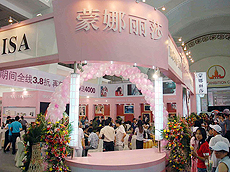 |
|
Fairground fairytale. |
About 10 million couples tie the knot in China each year. Total
spending power on wedding services is expected to reach hundreds of
billions of yuan by 2010. Market prospects are undimmed.
Popularity of photo studios
Photographic studios that emphasise independent style provide an
emerging form of the photography on the Mainland. "Photo studios are
more economical and have a more relaxed environment than bridal
salons," said Zhao, one of the exhibitors and owner of a studio
specialising in outdoor photography.
According to Zhao, the way customers end up having to pay 150% or
double the quoted price is a common practice in bridal salons.
Customers are charged more for compulsory purchases of cosmetics,
use of hair pieces or expensive gowns and tuxedos, as well as
purchases of photographic negatives and extra prints. These all
mount up to inflate the final bill.
In order to compete with bridal salons, photo studios usually offer
"free negatives" and promise not to impose additional charges to
worry their customers.
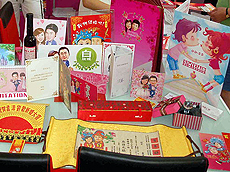 |
|
Wedding cards for all tastes. |
All charges are reflected in the prices listed. This form of
marketing works on customers, who tend to find the prices quoted by
photographic studios more acceptable than the separate billing so
common at bridal salons.
One young couple planned to get married in October and asked about
an Rmb3,999 package offered by Zhao's workshop. They quickly signed
the contract and paid the deposit.
"The package was selling at Rmb5,000. We've lowered the price
because of the financial crisis, but we are not going to lower the
quality of service," said Zhao.
There's also a big difference between the way photo studios and
bridal salons work. Most studios operate on a "one-on-one" mode
which makes it easier for the photographer to choose a style that
suits a customer's preferences.
Studios are also relatively free to choose locations. Clients of
bridal salons can only choose among a few fixed outdoor locations,
whereas studio clients can suggest any location of their choice and
only have to reach an agreement with the photographer.
There's little wonder that studios characterized by low cost and
individuality have captured consumers and investors.
Expo offers one-stop service
Some exhibitors distributed service handbooks to visitors during the
Expo last month. Several pamphlets suggested that couples make
bookings with bridal salons about six months before their big day,
because most salons are heavily booked and need at least one month
to get the photos ready.
If customers want to show their portraits at the wedding venue, they
have the one month to provide the image they find the most pleasing,
to leave a lasting impression on guests.
Many young visitors said they hoped to see more offerings from
companies that deal with minor wedding details, such as MV
production and invitation cards. "These are not difficult to
arrange, but they are time-consuming. If there are more exhibitors
from these businesses, we can shop around and place orders," said
one couple.
Since this year marks the 60th anniversary of the founding of the
People's Republic of China, more people are expected to choose to
marry on National Day, 1 October. In fact, Beijing has seen a steady
increase in marriage registrations since Labour Day on 1 May.
The market is expanding and the trend is expected to continue for a
few more years, said a manager from the China Wedding Industry
Association.
People are now more mindful of their wedding budgets and simple
ceremonies are becoming increasingly popular. Keeping the total
budget under Rmb10,000 is now the goal of many couples.
Wedding limousines are no longer de rigeur and more people are
holding evening weddings, to save money.
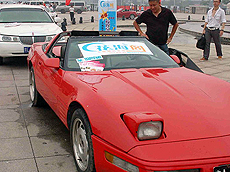 |
|
Ferraris the new favourite wedding limos. |
|
 |
|
Sweet gift packs. |
|
The opening of online shops for wedding supplies is a big help.
These stores offer better bargains than physical stores for items
like wedding candies, invitation cards, red packets and ribbons.
Wedding rings are selling at up to 50% discount online.
Legislation governs standards
 |
|
Paying attention to tuxedos. |
The National System of Standards for Management and Services in
the Wedding Service Industry, which has recently been
published, is an important reason for the sustained development of
the industry.
China's first set of standards has finally won the approval of the
General Administration of Quality Supervision, Inspection and
Quarantine (AQSIQ) and the Standardisation Administration of China
(SAC) after years of deliberation. The new standards aim to plug
loopholes in the wedding service industry.
According to information provided by the expo organisers, the
committee of wedding service industries of the China Association of
Social Workers was charged by SAC and the Ministry of Civil Affairs
with the task of formulating the standards at the end of 2005.
|
 |
|
The bridal gown. |
This system needs the enrichment of more than 60 carefully defined,
specific and workable industry specifications. China expects to
complete the formulation, examination and approval of three sets of
standards, including standards for wedding services and bridal
salons, before the end of this year.
This means that undesirable competition in the wedding service
market should be brought under control. False advertising, spending
traps and other nefarious activities will become far less common.
However, some exhibitors said the introduction of new standards
alone cannot put a quick end to malpractices in the market.
From the perspective of spending habits, the wedding is the most
important item of spending in the life of a Chinese person. Now that
the single-child generation is reaching marrying age, it's only
natural that parents want a lavish wedding for their only child. |
|
|
July 1 2009
AQSIQ Reminds Chinese Enterprises to
Observe New EU Directive on Toy Safety
The European Parliament recently adopted the draft of a new directive on toy
safety. In other words, it was revising the existing legislation on toy safety
published by the European Parliament just a little more than a year ago on 25
January 2008. In this connection, China's quality supervision, inspection and
quarantine departments are reminding toy enterprises concerned to
conscientiously exercise control in designing, technological processes and
quality management in the light of the characteristics of their products, with
special attention to the following four areas:
1. Chemical safety
Chemical safety falls into the category of material safety. Since different toys
are made of different materials, their control methods also differ. Enterprises
must understand the nature of the materials used in the making of their
products, what testing and control are necessary for particular materials, and
which materials need registration. They must clearly specify their requirements
in agreements signed with suppliers, and keep records traceable.
2. Structural safety
The new rules put stricter requirements on small toys parts which may be
swallowed by children and lead to suffocation, or toys which may be put in the
mouth and cause children to choke. These problems have to do with the structural
design of products. European Toy Safety Standards have special requirements for
these toys (such as pre-school dolls and hemispheric toys).
3. Product labeling
The new rules put greater emphasis on warning label requirements. Enterprises
processing for brand-name products probably would not have any problems with
product labeling, but those processing for small importers should make an effort
to learn more about warning labels to protect their own rights and interests.
4. Product conformity assessment
Enterprises should strive to do a good job of product conformity assessment in
accordance with the requirements set out in the EU's toy safety directive. Under
the new rules, the EU will strengthen market monitoring in member states and
member states must ensure that their market supervision authorities conduct full
inspection within and outside the EU and that hazardous toys are immediately
banned.
 June 16 2009 - Rupert Hoogewerf:
Counting China’s Millionaires June 16 2009 - Rupert Hoogewerf:
Counting China’s Millionaires
Despite the global financial crisis, the number of high net-worth individuals on
the Chinese mainland has hit a record high – and they're continuing to spend,
according to the Hurun 2009 Wealth Report. The study found 825,000 mainland
Chinese – or one in 1,700 – with a personal wealth of at least US$1 million. And
now the rich are more likely to be found in second- and third-tier mainland
cities. Rupert Hoogewerf, founder and publisher of the Hurun Report, a leading
luxury business magazine in China, and author of the annual Hurun China Rich
List, explains what this means for brands looking to tap the mainland's high-end
consumers.
How are China's wealthy holding up during the credit crunch?
Relatively speaking, China has avoided the worst of the credit crunch. Our
data shows that 82 per cent of China's richest have not made any lifestyle
changes since the financial crisis hit. The underlying reason is that their
confidence remains high. They believe that in six months or a year, it will have
blown over completely, and China will be back on a track of high growth.
How would you profile China's big spenders?
The average mainland Chinese millionaire is 39 years old. The average
mainlander with US$10 million is 43, and the average mainlander with US$100
million is 49. This makes China's richest 10 to 15 years younger than their
Western counterparts. They have a special affinity for international luxury
brands, especially European brands. If a Chinese person has built a successful
business, the first thing they reward themselves with is a luxury watch, then a
luxury car; after that comes all the rest.
Where do the second- and third-tier cities rank in terms of consumer spending
power?
As Beijing, Shanghai and Shenzhen are becoming inundated with luxury brands,
there has been an explosion of growth in wannabe cities. The latest Hurun Wealth
Report highlights the increased importance of second- and third-tier cities for
brands looking to tap China's high-end consumers. Leading the pack are cities
like Hangzhou, Chengdu, Chongqing, Shenyang, Qingdao and Xiamen.
What does this mean for brands targeting China?
Luxury brands looking to break into the China market need to have a good
partner. If you try coming in on your own in the retail industry, it is very
hard to make things happen. You also need to be sure of your brand positioning
and pricing; many brands arriving in China sell more expensively than back home.
Does Hong Kong make a good partner for the mainland?
Hong Kong enjoys a huge advantage. With a generation or more of luxury brand
experience, local dealers in Hong Kong have accumulated expertise on the
subject, and are best placed to develop brand strategies for the mainland. Hong
Kong is also intensively competitive for luxury products, so brands tend to cut
their teeth there before coming into the mainland.
As the mainland's spending power continues to rise, where do you see Hong
Kong's role in this?
Hong Kong has always been a shopping Mecca. It has a more favorable tax
rate, so many luxury products are cheaper in Hong Kong than on the mainland. So
long as the tax remains favorable, places like the Landmark and other upmarket
shopping malls will continue to attract luxury mainland consumers in their
hoards.
June 15 2009
 Growth gravitates inland in downturn - As the global crisis bites, more firms
are setting up offices and factories away from the coast to slash costs
by Cary Huang
Growth gravitates inland in downturn - As the global crisis bites, more firms
are setting up offices and factories away from the coast to slash costs
by Cary Huang
Long derided as poverty-stricken backwaters reliant on government handouts, the
mainland's inland provinces are getting a boost from an unexpected quarter - the
global financial crisis. As more companies seek to cut costs to stave off
sliding earnings, many are relocating to cheaper inner regions away from the
more high-cost coastal provinces. Among those making the move are some of the
biggest names in global business such as Intel Corp and Motorola.
Ironically, the crisis that has rocked the western world could be a turning
point in a long-held Beijing ambition to close the income gap between the
wealthier eastern seaboard and the inland regions.
Intel, the world's biggest semiconductor maker, announced in February that it
would close a Shanghai plant and consolidate chip assembly and testing
operations in southwestern Chengdu.
Eco Service Management, a unit of blue chip Hong Kong and China Gas (Towngas) (SEHK:
0003), recently announced it was setting up its regional headquarters in a
hi-tech zone on the outskirts of Xian.
Meanwhile, Foxconn International (SEHK: 2038) has set up operations in the
inland Wuhan city and Shanxi province while Motorola established a research and
development laboratory in Chengdu to develop software for mobile telephones.
Alcatel-Lucent, Ericsson, Nokia and Microsoft Corp also have all set up research
and development centres around Chengdu.
Much of this investment is expected to bring about a knock-on effect on the
manufacturing value chain as suppliers join the move inland, benefiting local
small and medium-sized manufacturers. The shift by these companies, which has
some similarities with America's westward migration in the 19th century, comes
as the latest official data reveals a dramatic change in fortunes for regional
economies. While some economists remain sceptical the move can become a
sustainable trend, early signs show the traditional scenario that has seen
inland regions lag robust growth on the coast is being reversed.
The mainland's economic growth slowed in the first quarter of this year to 6.1
per cent, a sharp decline from the 10.6 per cent gain a year earlier and
representing the weakest growth since quarterly records began in 1992. But while
growth in formerly pace-setting coastal provinces lagged the national average,
their poorer inland cousins in the western, central and northeast regions
expanded at an above-average pace - a precedent not seen since the mainland
adopted its open-door policy in 1978. The most prominent decline on the eastern
seaboard came from Dongguan, the mainland's foremost export manufacturing
centre, which recorded an unparalleled negative growth of 2.5 per cent in the
first quarter.
The Pearl River Delta city's performance was a key reason behind Guangdong
province's lacklustre 5.5 per cent first-quarter growth, the slowest in 20 years
and nearly half the 10.5 per cent recorded a year earlier. The southern
province, the largest of the 31 provinces and municipalities directly under the
central government, accounts for about 28 per cent of the nation's exports and
12.5 per cent of its gross domestic product. Its historical compound annual
growth rate is 14.4 per cent.
Shanghai, the mainland's biggest commercial city, registered lacklustre growth
of 3.1 per cent in the first three months of the year while neighbouring
Zhejiang, the richest province in per capita income terms and known for its
booming private sector, grew 3.4 per cent year on year, an 8.4 percentage point
decline from the first quarter of last year.
The depressing numbers send these traditional economic powerhouses to the bottom
of the nationwide growth rankings - Guangdong and Zhejiang to 26th and 29th
place, and Shanghai to 30th. That was just one notch above the coal-rich
northwestern province of Shanxi.
By contrast, western and central regions accounted for nine of the 11 provincial
areas that posted double-digit growth in the first quarter. "There are signs
that China's inland economy is 'decoupling' from the eastern coastal regions,
which are more exposed to external demand," said Jing Ulrich, managing director
and chairman of JP Morgan's China equities.
Zhao Ying, an economist at the Chinese Academy of Social Sciences (CASS), a
leading government think-tank, described the trend as an "abrupt turn" that
began in the middle of last year when the US financial crisis began to spread
worldwide.
Over the past 30 years, coastal provinces have had a growth advantage over
inland regions as surging exports and lashings of foreign investment helped the
mainland become the world's third-largest economy.
But the extensive reliance on the export trade has meant the impact of the world
recession has been more pronounced in port cities along the eastern seaboard. In
the first four months of the year, the mainland's total trade volume plunged
24.3 per cent to US$599.4 billion. Exports were down 20.5 per cent and imports
slipped 28.7 per cent. The weak showing was more prominent in regions like
Guangdong, where exports account for about 75 per cent of the province's
economy, more than double the national 32.6 per cent level.
Changing growth rate trends have gone largely unnoticed in the past two years.
Last year, Shaanxi and Inner Mongolia were among the fastest-growing economies
with GDP increasing 15 per cent and 17.5 per cent respectively. At the same
time, several coastal provinces posted single-digit growth.
Mr Zhao said several factors were behind the changing growth patterns broadly
stemming from the coastal regions' focus on the external market and inland
provinces' concentration on the domestic mainland market. With global trade on a
slump, the inland provinces' strong dependence on domestic markets is seen as a
good bet. Rising consumer spending, a government policy of supporting
development in the west and the 4 trillion yuan (HK$4.53 trillion) stimulus
package have helped push growth.
Paramount leader Deng Xiaoping's declaration that "to get rich is glorious" made
coastal Guangdong the first province to achieve relative wealth, while former
president Jiang Zemin and former premier Zhu Rongji's regional power base in
Shanghai guaranteed central government support for development of the country's
biggest commercial city.
But since they came into power in 2002, President Hu Jintao and Premier Wen
Jiabao have advocated the building of a "harmonious society" that encompassed
"the new socialist countryside". Their aims are to help those left behind by
breakneck growth in the largely urban areas of the country by directing
investment towards the west, central and northeast.
Pan Yingli, a professor at Shanghai's Jiaotong University, said structural
changes had been taking place in the economy for years and the global financial
crisis had only added impetus to the restructuring. Mr Pan said growth in the
export-oriented manufacturing sector in the east had been in a bottleneck
because of rapidly rising costs. The increasing competitive margins of the
inland regions largely explained moves by Towngas and Intel to shift away from
the coast.
Li Daokui, a director of the department of finance at Tsinghua University, said
stronger than expected economic growth in the inland regions had reflected the
strong impetus of domestic consumption and investment.
Nationwide retail sales rose 14.8 per cent in April, with growth in the
countryside climbing 16.7 per cent compared with the urban rate of 13.9 per
cent. The same strength was evident in capital investment. Urban fixed-asset
investment in the west jumped 46.2 per cent to 504.2 billion yuan in the first
quarter, 26.4 percentage points higher than the figure for eastern China and
18.1 percentage points above the average weighted national growth, according to
the National Development and Reform Commission.
Traditional economic leader Shanghai registered the lowest growth of 1.7 per
cent to 90.23 billion yuan.
Mr Zhao attributed the shift to the government delivering on its promise to
invest a big chunk of the 4 trillion yuan stimulus package in infrastructure in
the central and western regions. In its Blue Book of Urban Competitiveness
released in April, the CASS said while coastal cities retained their
competitiveness, the inland was fast catching up.
Of the 10 fastest-growing mainland cities last year, eight were in northern
agriculture-dominated Inner Mongolia and northeastern industrial Liaoning and
Jilin. The remaining two were Heyuan and Qingyuan in southern Guangdong, it
said. "Decoupled from the coastal export economy, China's inland cities are
becoming important centres of growth," Mrs Ulrich said. Mr Pan said in the
medium term, it was more certain the inland regions would outpace coastal areas
as they were now in their early or middle stages of industrialisation, where
growth rates often outpace the coastal cities that have reached the late stages
and are focusing on the development of the service industry.
June 13 2009
China's new bank loans rise to 664.5
bln yuan in May
China's bank credit expanded in May, with new yuan-denominated loans reaching
664.5 billion yuan (about 97.29 billion U.S. dollars) in May, the People's Bank
of China (PBOC), the central, said here Friday. The May figure brought new
yuan-denominated loans in the first five months to 5.84 trillion yuan, far
exceeding the full-year target of 5 trillion yuan. Outstanding loans by
financial institutions grew 30.6 percent year on year to 36.21 trillion yuan as
of May, the PBOC said.
In the first quarter, China pumped 4.58 trillion yuan worth of new loans into
the economy to stimulate growth. However, new bank credit shrank to 591.8
billion yuan in April as the peak season for bank lending ended. Renminbi
deposits grew 1.33 trillion yuan in May, taking outstanding deposits to 54.63
trillion yuan, up 26.27 percent from a year earlier.
M2 -- a broad measure of money supply, which covers cash in circulation and all
deposits -- grew 25.74 percent year on year last month to 54.82 trillion yuan.
The narrow measure of money supply, M1 (cash in circulation plus corporate
current deposits), was up 18.69 percent year on year to 18.2 trillion yuan,
which was 1.21 percentage points higher than the April level.
Outstanding M0, or cash in circulation, hit 3.36 trillion yuan, up 11.24 percent
from the same period last year.
"The bank credit is growing at a regular pace as investment expansion continued
last month, and there is an increasing demand for loans," said Zhang Liqun, a
researcher with the Development Research Center of the State Council, a
government think-tank. China's urban fixed-asset investment in the first five
months surged 32.9 percent year on year to 5.352 trillion yuan, 2.4 percentage
points higher than that of the first four months.
The increase in the new bank loans from April and May had shown that China had
continued its loosened monetary policy based on the economic downward pressure,
said Guo Tianyong, director with Finance Research Center of China's Central
University of Finance and Economics. "Such policy would continue in the future,"
he said.
Zhuang Jian, a senior economist with the Asian Development Bank, said despite
the loan surge, China's economy is still contracting as the consumer prices
index (CPI) and producer price index (PPI) continued to fall in May. "It's too
early to tell that there is an inflation risk as prices remain at a low level,"
he said.
China's CPI and PPI fell 1.4 percent and 7.2 percent in May year on year,
respectively, the National Bureau of Statistics said Wednesday.
May economic data:
·China's
retail sales up 15.2% in May ·China's
industrial output up 8.9% in May
·China
urban fixed-asset investment up 32.9% in first five
months
·China
PPI down 7.2% in May year on year
·China's
CPI falls 1.4% in May
·China's
PMI of manufacturing sector stands at 53.1% in May
June 4 2009
China Revises 2009 Catalogue of Prohibited Products in Processing Trade
The Ministry of Commerce and the General Administration of Customs have jointly
issued the 2009 Catalogue of Prohibited Products in Processing Trade, with
effect from 3 June 2009.
The commodity codes in the updated catalogue have been revised in accordance
with the 2009 tariff codes. The new catalogue contains a total of 1,759 tariff
code items, 30 less compared with the previous version.
For details of the adjustments to the Catalogue of Prohibited Products in
Processing Trade (in Chinese), please visit:
http://www.mofcom.gov.cn/aarticle/b/c/200906/20090606300331.html
May 14 2009
The Foreign Corrupt Practices Act:
Implications for U.S. Businesses in China
The 1988 Trade Act by the Congress of the United States directed the U.S.
Attorney General to provide guidance to potential exporters and small business
regarding the Foreign Corrupt Practices Act of 1977, an act all U.S. businesses
operating in China need to be familiar with.
The FCPA prohibits the “corrupt” payment of money or bribes to foreign officials
for the purpose of keeping or maintaining business. The FCPA also links in with
several other U.S. acts, providing for federal prosecution of violations of
state commercial bribery statutes. The FCPA requires U.S. listed companies to
meet their accounting provisions, which are designed to operate in parallel with
the anti-bribery provisions of the FCPA and require corporations to make and
keep books and records that accurately and fairly reflect the transactions of
the corporation and to devise and maintain an adequate system of internal
accounting controls.
A potential violation of the FCPA would include the following elements:
1. An act by a “covered” person
2. An offer to give something of “value”
3. To a “foreign official”
4. To “obtain or retain business”
5. With “corrupt” intent
There are two categories of “persons” under the FCPA: issuers and domestic
concerns. An issuer is a basically a listed company that has filing requirements
with the Securities Exchange Commission – the enforcing agent with respect to
FCPA for issuers. A domestic concern is an individual or any form of business
organization not registered with the SEC. The U.S. Department of Justice has
enforcement responsibility with respect to domestic concerns.
With respect to an offer to give something of value, keep in mind there is no
materiality to this act. It is illegal to offer anything of value as a bribe,
including cash or non-cash items. The government focuses on the intent of the
bribery rather than on the amount.
“Foreign official” is broadly defined by FCPA. Anyone working for a
government-owned or managed institution or enterprise (including doctors,
lawyers and accountants) is considered a foreign official. Any business person
that also serves a foreign governmental agency is a foreign official. Also,
employees of international organizations are also considered to be foreign
officials under the FCPA. Any U.S. business operating in China must pay
particular attention to this broad definition as many Chinese business people
are also government officials. Ignorance of the person’s status does not provide
exemption from prosecution for a violation of the act.
It does not matter whether there is an existing business relationship with the
foreign official. So an offer of value to acquire business or to prevent the
loss of business is covered by the act.
Corrupt intent encompasses the notion of a benefit given or offered to persuade
a foreign official to misuse their position or authority through action or
inaction and it includes quid pro quo arrangements. Quid pro quo generally
assumes the benefit is given with reasonable expectations of some official favor
in return. The quid pro quo does not need to have been executed nor does the
foreign official need not be able to deliver it themselves. Again, note that the
U.S. government does not need to establish the defendant knew their conduct
violated the FCPA.
Hank Bourg is a U.S. certified public accountant and the head of the North
American desk at Dezan Shira & Associates. For comments or inquiries, please
contact him at tax@dezshira.com.
May 6 2009
The Mainland China Hit Parade
 |
|
| Shanghai tops the list of mainland
consumer markets in terms of total consumer retail sales |
|
Many Hong Kong and foreign retailers and manufacturers
in the mainland market have been making plans to venture into cities beyond
Beijing, Shanghai and Guangzhou. While only a few cities can rival the spending
power of sub-provincial cities, provincial capitals and autonomous region
capitals, many can afford medium-range consumer goods, according to a newly
published report, "Breaking into the Mainland Consumer Market – HKTDC's Top 30
Cities."
Hong Kong's well-designed and high-quality branded
goods are popular with residents in these cities. In addition to running their
own stores, Hong Kong brands can also build extensive sales networks by
establishing hundreds, even thousands, of outlets via franchising. Well-known
foreign brands have already established a strong presence in large and
medium-sized mainland cities, suggesting that consumers in these areas can now
afford higher-quality consumer goods.
The Top 30
Generally, the cities chosen have the largest
consumer-market, highest consumption power, most developed hinterlands and most
extensive coverage of neighbouring cities. The 30 cities selected in the HKTDC
report are: Shanghai, Beijing, Guangzhou, Shenzhen, Tianjin, Wuhan, Nanjing,
Chengdu, Hangzhou, Suzhou, Shenyang, Qingdao, Wuxi, Jinan, Changsha, Ningbo,
Dalian, Zhengzhou, Foshan, Chongqing, Dongguan, Changzhou, Zibo, Jinhua,
Shaoxing, Jiaxing, Zhongshan, Xiamen, Zhenjiang and Zhuhai.
The cities are located mainly in the three major
economic regions, the Pearl River Delta (PRD), the Yangtze River Delta (YRD) and
the Bohai Rim. Both the PRD and YRD are home to a large number of affluent
cities within a relatively small area and with a busy flow of people, goods and
information exchange. Retail channels and supporting facilities are well
established, facilitating the development of new markets.
The selections were initially drawn from the 50
mainland cities with the highest retail sales and consumption level. They were
then ranked according to four indicators: GDP, total retail sales of consumer
goods, population and passenger throughput (including all cities at the same
level or lower level within a 200-kilometre radius).
Consumer Profiles
 |
|
The dominance of mid-range domestic
brands in the central mainland city of Wuhan makes it a promising
consumer market |
|
Coastal area consumers are more knowledgeable about
international brands. They regard Hong Kong brands as advanced but inferior to
international brands. Compared with Korean, Taiwanese and indigenous mainland
brands, Hong Kong brands are more attractive to the majority of mainland
consumers. Thus, despite keen market competition, Hong Kong brands still have a
good chance to stand out, provided appropriate positioning is adopted, unique
product features are highlighted and marketing efforts are stepped up.
Making it in the PRD
The majority of the top-30 cities are concentrated in
the YRD and PRD regions and more dispersed in other regions. The geographical
distribution of cities is of great significance to the establishment of sales
networks, arrangement of logistics and penetration and influence of brands. With
that in mind, Hong Kong companies planning to devote their resources to the
development of one region first should give priority to the YRD or PRD region.
It is worth noting that the PRD is a light industrial
base with a large number of factories producing textiles, shoes and headgear,
electronics, furniture, home appliances, household goods, stationery and toys,
and watches and clocks. Many are competitive private enterprises. In fact,
Guangdong province is among the regions with the greatest number of private
enterprises in China. After years of growth, many mainland manufacturers have
developed high-quality products. For example, electronics and technology in
Shenzhen, electronics and textiles in Dongguan, and household appliances in
Foshan are particularly popular. Some mainland brands that have achieved
"well-known brand" status are perceived as mid- to high-end products by PRD
consumers. In view of this, Hong Kong companies wishing to break into the PRD
market must enhance the quality and characteristics of their products.
The Affluent YRD
Although the market size and depth of Nanjing, Hangzhou, Suzhou and Wuxi still
lag behind those of Beijing, Shanghai and Guangzhou, growth has been rapid and
their per-capita consumer spending is among the highest in the country. After
years of wealth accumulation and economic development, the YRD has a high
concentration of affluent cities, a number of them important consumption centres.
Transportation and people flow between the cities in
the YRD region are busy, and retail channels and infrastructure are
well-developed. Hence, once a product has established a foothold in Shanghai, it
can easily break into the larger regional market. Hangzhou, a provincial capital
and commercial centre of Zhejiang, has attracted many private enterprises from
other provincial cities. Hence, Hangzhou, with its huge demand for high-end
products and large number of international brand stores, has become a
battleground for upmarket brands.
Bohai Rim Cities
Consumers in major cities such as Beijing and Tianjin no longer blindly buy Hong
Kong brands. Since there are a great variety of brands available in Beijing,
consumers can compare Hong Kong brands with foreign ones. While Hong Kong brands
may still have an edge over Korean and Taiwanese brands, they may be less valued
than European and American brands. Younger and wealthier consumers increasingly
favour foreign brands. Which means that Hong Kong brands must have a clear
positioning and the right market strategies to be competitive.
Dalian has the geographic advantages of a coastal city,
attracting a great number of foreign traders, especially Japanese traders, and
visitors. With a well-developed information network, its residents are widely
exposed to the outside world, open-minded, and regarded as fashion trend
pioneers. Many international brands have chosen Dalian as the entry point to the
northeastern China market.
Central Spending
As for central and western China, since their economies picked up more recently,
only the capital cities of the more affluent provinces are better developed. The
provincial capitals of central and western China in the top-30 are generally the
most mature markets of the province, outshining other cities of the same
province in consumption power and commercial development. The coverage of these
provincial capitals is very strong and attracts consumers from their own
provinces as well as other provinces, creating a kind of cluster effect.
And the Winner is Hong Kong, meanwhile, has
been ranked at the top of the 10 most competitive Chinese cities by the latest
Blue Book of Urban Competitiveness. The annual study, first compiled in 2003 by
the mainland government think tank the Chinese Academy of Social Sciences,
covered 294 medium-sized and large cities, ranking them in terms of economic
scale and growth rate, economic efficiency, development costs, industrial
structures, residents' quality of life and other features.
Hong Kong came out ahead in the versatility
of its economy, its openness, level of integration with the global economy,
talent and intellectual property protection. Researchers cited Hong Kong's
international status as one of its key strengths.
April 29 2009
China Offers Further Tax Concessions to
Cultural Establishments
The Ministry of Finance, General Administration of Customs and State
Administration of Taxation have recently issued in their joint names a circular
on some tax policies for the conversion of operational cultural institutions
into cultural enterprises and a circular on some tax policies in support of the
development of cultural enterprises.
These departments have formulated a series of preferential tax policies to
promote cultural system reform since 2004. They have recently added some new
policy provisions to address new situations and new problems in reform. The
implementation period lasts from 1 January 2009 to 31 December 2013. The
following are some of the new tax concessions offered:
In order to support the conversion of operational cultural institutions, the
newly formed cultural enterprises are exempt from enterprise income tax from the
day of conversion. Cultural units receiving allocations from the Ministry of
Finance that convert into enterprises will be exempt from real estate tax for
own-use property from the day of conversion.
Cultural enterprises formed by the spin-off of the distribution, printing and
related operational assets of party newspapers and magazines will be exempt from
value-added tax (VAT) for distribution and printing revenue derived from the
party newspapers and magazines from the day of registration. Enterprise income
tax on the appreciation of asset value as appraised during the course of
conversion from operational cultural institution to cultural enterprise, as well
as the VAT, business tax, urban construction tax and other levies on the
re-assignment or transfer of assets, are offered appropriate concessions.
In order to promote the development of newly formed cultural enterprises, film
groups, movie studios and other film enterprises engaged in the production,
distribution and screening of films are exempt from VAT and business tax on
income from the sale of film copies, income from the transfer of film
copyrights, income from the distribution of films and income from the screening
of films in rural areas. Imports of equipment, accessories and fittings that are
currently not produced in China but needed for the production of key cultural
products for own use are exempt from import tariffs.
In order to encourage cultural enterprises to "go global", exports of books,
newspapers, periodicals, audio-visual products, electronic publications, films
and TV programmes are eligible for VAT rebate. Proceeds obtained offshore by
cultural enterprises from performances staged outside the mainland will also be
exempt from business tax.
Strict Ban on Use of Prohibited Substances in Cosmetics
The State Food and Drug Administration (SFDA) of China recently issued a
circular urging cosmetics hygiene supervision departments at all levels to
conscientiously exercise supervision, effectively strengthen the routine
monitoring, supervision and inspection of cosmetics production and operation
enterprises, do a good job of the record filing of cosmetics, and strictly ban
the use of prohibited substances in cosmetics.
Acting on complaints about individual enterprises illegally using prohibited
substances in the production of cosmetics, the circular calls on all cosmetics
production enterprises to conscientiously discharge the duties of the first
responsible person, strictly abide by relevant laws and regulations, and carry
out production strictly in accordance with the prescriptions and technological
processes approved or filed for the record. Local cosmetics hygiene supervision
departments at all levels must crack down on the illegal use of prohibited
substances, the use of restricted substances above the approved limit, the
production of cosmetics without hygiene licence, the illegal selling of
cosmetics, and other violations of laws and regulations.
Cosmetics are household and personal care chemical products applied to various
external parts of the human body, including skin, hair, nails and lips by
smearing, spraying or other similar methods to clean, to correct body odours, to
protect the skin, and to improve their appearance. Among these, hair tonics,
hair dyes, hair perms, hair removers, breast cream, deodorants, speckle removers
and sun blocks are referred to as cosmetics for special purposes. Products other
than these are cosmetics for non-special purposes.
The safety of cosmetics has been an issue of widespread public concern for some
time. In order to strengthen the filing for record of mainland-produced
cosmetics for non-special purposes, the SFDA also issued another circular
requiring cosmetics hygiene supervision departments in all provinces, autonomous
regions and municipalities to make more perfect regulations regarding the filing
for record of mainland-produced cosmetics for non-special purposes and do a
better job in this connection.
The circular calls on all localities to file for record mainland-produced
cosmetics for non-special purposes within a specified time and fully bring into
play the information recorded. Products filed for record that fail to comply
with the laws and regulations, standards and specifications for cosmetics
hygiene supervision and management must be dealt with according to relevant
rules and regulations. Information regarding the filing for record of
mainland-produced cosmetics for non-special purposes must be published in a
timely manner.
April 13 2009
HKR in monumental Shanghai build - Hong
Kong heads class leisure project in Shanghai.
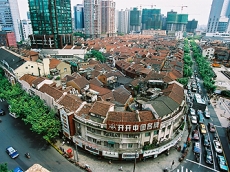 The Dazhongli project, which property developers describe as Shanghai's
"premium" sector, is where Hong Kong's HKR International and Swire Properties
plan to create a classy leisure and shopping complex amid the relocation of a
historic landmark, belonging to the former Minli Middle School.
The Dazhongli project, which property developers describe as Shanghai's
"premium" sector, is where Hong Kong's HKR International and Swire Properties
plan to create a classy leisure and shopping complex amid the relocation of a
historic landmark, belonging to the former Minli Middle School.
Dazhongli is one of the biggest and best-preserved collections of stone gated
homes in Shanghai. Only a stone's throw from People's Square, this rare, prime
site in downtown Shanghai is situated on Nanjing West Road in the heart of the
Jing'an district and is connected with Shimen First Road, Weihai Road and
Qinghai Road.
The site has a total area of 63,000 sqm which will include underground walkways
linking neighbouring streets to form a transit hub. The initial plan is to
develop the area as an office, hotel and commercial complex, including two
office towers, three luxury hotels and a shopping mall.
The project sits on a 6.2 hectare area with a plot ratio of 4.6. The buildings
will have a maximum height of 250 m, with 1,730 parking spaces. HKR
International won the land use right for the Dazhongli plot for Rmb$1.3 billion
in 2002.
In November 2006, Swire Properties acquired a 50% interest in the project at an
estimated cost of HK$1.2 billion. Swire Properties Chairman Keith Kerr said the
company would invest no less than Rmb10 billion in the project, its first real
estate development in Shanghai.
HKR International, which owns and runs the Discovery Bay residential and leisure
site in Hong Kong, was founded by Hong Kong business tycoon Cha Chi-ming.
Managing Director Victor Cha and his wife Laura Cha are also leading lights,
with the latter being the former Vice Chairwoman of the China Securities
Regulatory Commission.
Swire Properties is a subsidiary of Hong Kong-listed Swire Pacific. Its real
estate projects on the Chinese mainland have a total floor area of 1 million sqm.
The first phase of the Dazhongli project was the relocation of a heritage
structure. This consisted of the office block belonging to Minli Middle School,
which was rated as a Shanghai "Excellent Historic Building" in 1999.
The building was the former residence of brothers Qiu Xinshan and Qiu Weiqing,
wealthy businessmen in the paint industry. The heritage structure was relocated
to Weihai Road and will become the central landmark for the project on
completion. Work will last about six months, with phase two demolition now
underway. The developers aim to build a truly landmark complex.
On the prospect of completion, District Mayor Zhang Renliang said his hope was
to turn the Jing'an district into a top international quarter like Fifth Avenue
in New York, the Champs-Elysées in Paris, Oxford Street in London or the Ginza
in Tokyo.
Guangdong Helps Processing Trade
Enterprises Sell Goods on Domestic Market
The financial crisis has quite a serious impact on the 70,000-plus processing
trade enterprises in Guangdong. In order to positively address the crisis and
take the initiative into its own hands, the government of Guangdong is doing
everything to help processing trade enterprises expand domestic sales, according
to the foreign trade and economic cooperation bureau of Guangzhou.
First, in order to expand the domestic market, Guangdong is considering
implementing the "Guangdong Goods Go North" project to help enterprises open up
the mainland market. Guangdong has already contacted the governments of the Hong
Kong and Macau special administrative regions and persuaded them to organise two
to three major sales promotions in north China cities while taking part in
various types of exhibitions on the mainland to help their companies open up the
mainland market.
Second, in order to boost domestic sales, Guangdong will promote "sell first tax
later" in the domestic sales of processing trade goods. Enterprises are allowed
to sell goods produced with bonded import materials first before completing
centralised customs declaration procedures. This will greatly facilitate the
domestic sales of processing trade goods.
Moreover, the foreign trade and financial departments of Guangdong have prepared
an implementation plan for the setting up of an Rmb1 billion fund to help
processing trade enterprises undergo transformation and upgrade. This document
has been submitted to the provincial government for approval.
The introduction and implementation of these measures will help Guangdong's
processing trade enterprises launch domestic sales to make up for the losses
resulting from the decline in exports and tide over the difficulties as soon as
possible.
March 3 2009
Chinese Insurance Companies Allowed to
Invest in Real Estate
Chinese insurance companies may invest in real estate in China when the
Amendments to the People's Republic of China Insurance Law (the "Amendments"),
recently passed by the legislature in China, become effective on October 1,
2009.
On February 28, 2009, an Order of the President, issued by President Hu Jintao,
announced that the Standing Committee of the 11th National People's Congress had
passed the Amendments as a new law, taking effect on October 1, 2009.
Investment in Real Estate - One of the most significant changes under the
Amendments is that Chinese insurance companies will be permitted to invest
insurance funds in real estate other than for self use. Such a change could
release significant funds into the real estate market and open up investments in
infrastructure projects (a major focus of the Chinese government's stimulus
package). It would also assist Chinese insurance companies with diversifying
their investment portfolios to achieve higher returns on their insurance assets
in order to deal with increasingly difficult solvency scenarios. Currently, a
Chinese insurance company is not allowed to invest in real estate other than for
self use unless granted special approval by the China Insurance Regulatory
Commission ("CIRC"), the regulatory body for insurance companies in China.
Historically, PICC, China Life, and Ping An, all listed on overseas stock
markets, have obtained special approvals.
Other Highlights of the Amendments - The Amendments also reflect China's recent
policy of allowing Chinese insurance companies to invest in marketable
securities, such as company stocks and securities funds.
Additionally, the Amendments include provisions to tighten the supervision of
and raise the risk management standards for investments by insurance companies
to better protect policyholders and shareholders, as part of the measures in the
Amendments to provide increased protection for insurance policy holders and
further improve the corporate governance of insurance companies.
February 26 2009
Fujian Extends Basic Medical Insurance
Coverage to Hong Kong, Macau and Taiwan Personnel
Fujian's department of labor and social security recently issued a circular
announcing that Hong Kong, Macau and Taiwan personnel working in the province
will be eligible to enroll in its basic medical insurance programs.
According to the circular, Hong Kong, Macau and Taiwan personnel may enroll with
local medical insurance agencies on the principle of voluntary participation by
presenting valid travel passes, the number of which will be used as the
identification number of their medicare cards.
The circular stipulates that Hong Kong, Macau and Taiwan personnel who have
labor relations with employing units or engage in individually-owned businesses
in Fujian may enrol in basic insurance programs for urban workers. Hong Kong,
Macau and Taiwan personnel residing but not working in Fujian (for over one
year) may enroll in basic medical insurance programs for urban residents.
When the insured Hong Kong, Macau and Taiwan personnel terminate their labor
relations with their employing units, complete the cancellation of their
employment registration and leave the mainland, their enrolment in the medical
insurance program will also be terminated and the balance of their personal
accounts with the program will be returned to them, said the provincial
department of labor and social security.
Guangdong Steps up Unemployment Monitoring
The Guangdong Provincial Labor and Social Security Department has recently
adopted a number of unemployment insurance protection measures, including
measures to better monitor unemployment and help people find jobs.
The department calls on labor and social security offices at all levels to
better monitor the unemployment situation, have a good grasp of unemployment
trends, and keep track of enterprises likely to face closure or production
stoppage in order to be able to step in and provide employment service and job
vacancy information in a timely manner and effectively contain the scale of
unemployment. They are also urged to give full scope to neighborhood and
community organizations as grass-roots labor and social security work platforms
in order to get a full picture of the unemployment situation and provide better
unemployment service to the masses, making sure that there are public job
centres in areas of high unemployment.
Local labour and social security offices should draw up tailor-made assistance
programs and provide "one-on-one" assistance to the unemployed. Using technical
schools as the main venues, they should offer job training to people laid off by
enterprises and prepare them for other jobs by teaching them skills and helping
them upgrade themselves.
At the same time, local labor and social security offices must also better
supervise and guide enterprises when they have to lay off workers. In
conjunction with the departments concerned, they should properly take care of
the legitimate rights and interests of laid-off workers, punish offences
according to law, and mediate or adjudicate labour disputes in a swift manner.
Guangdong also requires local social insurance agencies to further optimise
their handling procedures, improve efficiency, and make sure that the unemployed
get full unemployment benefits on time.
Tips on Supplying to Mainland Department
Stores
According to Liu Jiangchao, chairman of Wuhan Department Store Group Co. Ltd.,
it is common for mainland department stores to expect their suppliers to have
independent legal person status and provide relevant documents, including legal
and valid documents (business licence, tax registration certificate and
organization code certificate), proof of trademark registration, letter of
authorization from the trademark owner, legal and valid documents of domestic
agencies (business licence, tax registration certificate and organization code
certificate), legal and valid proof of customs clearance for imported goods, and
product marketing proofs required by relevant laws and regulations.
In the light of the market influence of the supplied brands and the demand for
these goods, department stores usually adopt the following modes in their
cooperation with suppliers. Specific terms and conditions are agreed upon
between the two sides through negotiations.
Country or regional sole agent: Responsible for the promotion and sale of a
particular brand in the whole country or in a particular region.
Direct retail: Establish a direct dealership relationship with suppliers and
settle payment at supply price either by means of cash on delivery or delivery
upon payment.
Direct commission sales: Establish a direct commission relationship with
suppliers and settle payment at supply price after the goods were sold.
Jointly-operated special counters: Operate special counters with suppliers and
take a commission from the selling price as profit.
Rental business: Suppliers rent a venue or counter to do business independently
and charge a fixed amount or a certain percentage of the sales volume as rent.
(Source: Speech by Liu Jiangchao, chairman of the Wuhan Department Store Group
Co. Ltd., at the "Seminar on the Retail Market in Wuhan and the Central China
Region" jointly organized by the Hong Kong Trade Development Council and the
city government of Wuhan on 16 December 2008.)
February 10 2009
China Ups VAT Rebate Rates for Textiles
and Garments
The Ministry of Finance (MOF) and State Administration of Taxation have
issued a circular on the adjustment of VAT rebate rates for certain textiles and
garment exports. Effective from 1 February 2009, VAT rebate rates for textiles
and garments under 3,325 tariff codes have gone up from 14% to 15%.
For details in Chinese, please visit the MOF website at:
http://szs.mof.gov.cn/shuizhengsi/zhengwuxinxi/zhengcefabu/200902/t20090205_111836.html
February 8 2009
Guangdong China Announces Support Measures
for Hong Kong, Macau and Taiwan Enterprises
The Guangdong provincial government announced 30 measures in January 2009 to
help Hong Kong, Macau and Taiwan enterprises operating in the province tide over
the global financial crisis and speed up their transformation and upgrade.
Details are available at the official website at:
http://www.gd.gov.cn/govpub/zfwj/zfxxgk/gfxwj/yfb/200902/t20090201_84870.htm (Chinese only - see below using Google Translate***)
The measures include: allowing enterprises with genuine difficulties to apply to
their supervisory tax authorities for tax exemption, tax reduction or deferment
of tax payment; reducing the social insurance premium rates by phases; and
simplifying the domestic sale procedures for bonded goods under processing
trade.
In addition, the Guangdong provincial government will provide fiscal support and
tax concessions to enterprises in the areas of technology and equipment
renovation, R&D and innovation, and technology transfer. Details of these
measures are also available at the government website.
***Guangdong Province, Hong Kong, Macao and Taiwan-funded enterprises support
to cope with the international financial crisis
And accelerate the transformation and upgrading of a number of policy measures
Our province is the absorption of Hong Kong, Macao and Taiwan region invest up
to one of the provinces, the province's existing Hong Kong, Macao and
Taiwan-funded enterprises 5.8 million homes, accounting for about 64 percent of
the total number of foreign-funded enterprises. Guangdong, Hong Kong, Macao and
Taiwan-funded enterprises in the healthy development of our province is related
to the continued development of export-oriented economy, but also the prosperity
and stability of Hong Kong and Macao regions and cross-strait economic
cooperation continued to deepen. To conscientiously implement the Party Central
Committee and State Council on the support of Hong Kong and Macao's economic
development, and promote the deployment of cross-strait economic cooperation in
order to help Hong Kong, Macao and Taiwan-funded enterprises to cope with the
international financial crisis, to speed up transformation and upgrading,
special formulated the following policy measures.
First, increase financial support
(1) Increase of processing trade enterprises to upgrade their support. In 2009,
the provincial financial arrangements for a one-time 10 billion to set up
transformation and upgrading of processing trade enterprises in special funds.
Special fund is mainly used: of processing trade enterprises in Guangdong to set
up R & D platform for innovation in public services, R & D institutions,
headquarters or regional headquarters to give incentives and support; of
processing trade enterprises to introduce advanced technology and equipment to
carry out technological transformation of industries, as well as the purchase of
core technology trademarks and brand support; of processing trade enterprises
for the transformation process technology and equipment loans to support
domestic help; of processing trade enterprises to independent research and
development and export of independent brands to give incentives and support;
larger amount of domestic tax and the creation of the domestic brands of
processing trading enterprises, such as reward. (Foreign Trade and Economic
Cooperation Office of the lead, together with Ministry of Finance and other
relevant units responsible for)
(B) increase the flow of corporate support. Hong Kong, Macao and Taiwan-funded
enterprises may apply for provincial development of special funds to support
circulation, the implementation of domestic-funded enterprises with the same
application procedures and conditions. (Provincial Economic and Trade Commission
to take the lead, together with Ministry of Finance and other relevant units
responsible for)
(C) increased energy consumption for enterprise support. Hong Kong, Macao and
Taiwan-funded enterprises may declare the province a special fund energy-saving
projects, projects for comprehensive utilization of resources, energy-saving
incentives and that the clean production enterprises, domestic enterprises with
the same application procedures and conditions. (Provincial Economic and Trade
Commission to take the lead, together with Ministry of Finance and other
relevant units responsible for)
Second, reduction of some taxes and fees
(D) the fee waiver. Deployment in accordance with the country, and seriously do
a good job in the fuel tax reform and the work of a fee waiver, cancellation and
suspension of the 100 administrative fees and charges, the abolition of the road
maintenance fee, waterway conservation fees, management fees highway
transportation, highway passenger surcharge, waterways transportation management
fees, coupled with the implementation of relief and reduction for some
entry-exit inspection and quarantine fees. Waiving part of their local charges,
cancellation charges sales management audio and video products in some provinces
set administrative fees and charges; the development of relevant implementation
methods of entering the transfer of provincial-level industrial park businesses,
in addition to state taxes and fees, the no longer charge local charges. Suspend
the collection of foreign-invested enterprises to use the premises fees, permit
enterprises to pay the land transfer extension. (Ministry of Finance, Price
Bureau to take the lead, together with the provincial Economic and Trade
Commission, Department of Communications, Office of Land and Resources, Foreign
Trade, Press and Publication Bureau, the Guangdong Entry-Exit Inspection and
Quarantine is responsible for other units)
(V) tax incentives.
1. Hong Kong, Macao and Taiwan-funded enterprises engaged in business customs
agent, with its charge to the client the full purchase price and the price and
the cost deducted from the amount of tax policies and regulations after the
balance of the project, as a declaration of taxable turnover of sales tax paid.
2. Hong Kong, Macao and Taiwan-funded enterprises engaged in technology
transfer, technology development and related business technology consulting,
technology services business income, may apply for exemption from sales tax
reduction. Enterprises in a tax year of the transfer of technology derived from
no more than 500 million parts, exemption from corporate income tax; part of
more than five million yuan, half corporate income tax.
3. Hong Kong, Macao and Taiwan-funded enterprises to develop new products, new
technologies and new techniques of research and development expenses occur, the
formation of intangible assets not included in current period profit and loss,
in accordance with the provisions of a factual basis of deduction, in accordance
with the research and development costs plus 50% deducted ; the formation of
intangible assets, intangible assets in accordance with the amortization of the
cost of 150 percent. Been identified as high-tech enterprises of Hong Kong,
Macao and Taiwan-funded enterprises, reduced 15% enterprise income tax.
4. Hong Kong, Macao and Taiwan-funded enterprises to pay normal property taxes,
urban land use tax is indeed difficult, in line with the provisions of tax
policy can be made to the competent local tax authorities to apply for reduction
or exemption.
5. Hong Kong, Macao and Taiwan-funded enterprises to pay taxes on time there are
difficulties, in line with the provisions of tax policy, to the competent tax
authorities may apply for an extension to pay, but the extension period not
exceeding 3 months.
(Above the provincial Department of Finance tax policy measures to take the
lead, together with Provincial State Administration of Taxation, to the Inland
Revenue Department, Science and Technology Agency, Office of Land and Resources
and other relevant units responsible for)
(Vi) reduce the burden of social insurance enterprises. Relevant to develop the
implementation plan, the appropriate stage to reduce unemployment insurance,
basic medical insurance, industrial injury insurance and maternity insurance
rate, allowing enterprises in a certain period of time holdover social
insurance. (Provincial Office of Labor and Social Security to take the lead,
together with the relevant units responsible for)
Three, simplifying approval procedures
(Vii) simplify the processing trade enterprises restructuring and the relocation
process. Strengthening of operational guidelines related to the publicity,
guidance and help in transition processing enterprises do not stop. Of
transformation, the remainder of the relocation of enterprises and non-price raw
materials and parts for equipment, mutatis mutandis, "the same operating unit"
approach, according to regulations and the price is more than expected
carry-over of equipment procedures, without in order to "transit" or exit way
for Habitat . Transformation, after the relocation of non-price devices for
calculating the length of supervision. Upon approval by the Customs, enterprises
can retain the original Customs Classification Management category. (Customs
Guangdong Branch of the Office of Foreign Trade and Economic Cooperation Council
and other relevant units responsible for)
(Viii) simplification of processing trade enterprises to outward processing
procedures. Outward processing to promote reform and accelerating the "outward
processing Management System" application, realize "online approval." Granted
the province a certain processing capacity, due to its production
characteristics and technological conditions and restrictions should not
complete all processes and orders of the processing trade enterprises to carry
out outward processing operations. (Customs Guangdong Branch is responsible for)
(Ix) to simplify the processing trade bonded goods domestic procedures. Further
streamline the domestic approval procedures, to promote the application of
"e-manual processing trade" and "management of the domestic taxation system,"
realize "online reporting, real-time single"; pre-classified, pre-trial price of
consumption, such as work authorized, shortening domestic tax processing time,
improve customs clearance efficiency; on the implementation of the electronic
mode of regulation of business books, AA type of enterprises and provide an
effective guarantee of A-type enterprises, upon approval by the Customs and
Excise, permit a natural period in the use of "multiple domestic sales, a
declaration "the way for domestic business. (Customs Guangdong Branch of the
lead, in conjunction with the Office of Foreign Trade and Economic Cooperation
and other relevant units responsible for)
(Ten) to simplify the Hong Kong and Macao enterprises to invest in commercial
retail-related examination and approval procedures. Under the CEPA framework in
the development of management practices, to simplify the Hong Kong and Macao
service providers to invest in commercial retail project approval process.
(Provincial Economic and Trade Commission to take the lead, in conjunction with
the Office of Foreign Trade and Economic Cooperation and other relevant units
responsible for)
(K) Food and Drug simplified investment approval procedures related industries.
To Hong Kong, Macao and Taiwan-funded medicines, medical equipment, health food,
cosmetics production and operation enterprises and medical institutions to bid
to host the agents part of the permit, change, replacement and other procedures
for examination and approval, the next move to cities and counties in food and
drug regulatory authorities, approval and implementation of territoriality
"online examination and approval, a one-stop examination and approval." Hong
Kong, Macao and Taiwan-funded enterprises of food and drugs, medical equipment,
health food, cosmetics brand category of technical review and administrative
examination and approval, implementation of "green channel" measures.
Pharmaceutical Group to encourage Hong Kong, Macao and Taiwan-funded enterprises
with between Optimize product mix, to allow the enterprises to increase the
production site or change the corporate name change to add applications such as
drug registration, reduce duplication of reporting and production of drugs. Meet
the requirements of the new start-up pharmaceutical production enterprises
commissioned processing policy support, support for moving the stock of Hong
Kong, Macao and Taiwan-funded enterprises production resources. (Provincial Food
and Drug Administration to take the lead, together with the relevant units
responsible for)
(Xii) Optimize land settlement procedures. Further optimize the export of land
settlement interconnection verification system functions and operational
procedures, improve the speed of the export exchange collection. Improve under
proper processing of export may be approved by the ratio of the amount of
foreign exchange. (Foreign exchange bureau in charge of the Guangdong Provincial
Branch)
(Xiii) to optimize the export tax rebate procedures. Exports of goods in the
actual departure, or deposited in the enjoyment of "the zone (positions) that
is, tax" policy of Customs special supervision of the regional sites, you can
apply to Customs to prove the issue of export tax rebate in conjunction, the
Department approved three days after to complete the procedures issued by the
enterprise sector's bid for a certificate to the National Tax refund procedures,
tax departments in accordance with the regulations in time. (Customs in
Guangdong Province Sub-Council is responsible for the IRS)
Fourth, support enterprises in independent innovation
(14) Strengthening innovation platform. Guangdong, Hong Kong, Macao to
strengthen cooperation in scientific and technological innovation in Hong Kong,
Macao and Guangdong economic linkage industries and technological fields, the
joint establishment of a group of high level of innovation platform; in
Guangzhou, Shenzhen, Zhuhai, Dongguan and other places to build the
internationalization of high - science and technology parks and industrial base,
to create a joint science and technology innovation in Hong Kong, Macao and
Guangdong area. (Science and Technology Department in conjunction with relevant
units responsible for)
(15) Strengthening of intellectual property services. Hong Kong, Macao and
Taiwan-funded enterprises to apply for the patent business has opened a "green
passage", Hong Kong, Macao and Taiwan-funded enterprises on the domestic
invention patent applications, the country (territory) outside the patent grant
funding. Supporting Hong Kong, Macao and Taiwan-funded enterprises applying for
Provincial Intellectual Property enterprises, demonstration pilot enterprises
and strategic enterprises, the inclusion of patented technology implementation
plan, and implement domestic enterprises with the same application procedures
and conditions found. (Provincial Intellectual Property Office is responsible
for in the relevant units)
(Xvi) to encourage and support technological upgrading of enterprises. Hong
Kong, Macao and Taiwan-funded enterprises and enterprises can apply for
provincial financial potential transformation of funds, implementation of
domestic-funded enterprises with the same application procedures and conditions.
(Provincial Economic and Trade Commission to take the lead, together with
Ministry of Finance, the Provincial Science and Technology Agency and other
relevant units responsible for)
(17) to encourage research and development in support of enterprise technology.
Hong Kong, Macao and Taiwan-funded enterprises to apply for permit found the
provincial level enterprise technology (R & D) center and the provincial
engineering technology research and development centers, in line with the
conditions recommended that national enterprise technology (R & D) Center and
the Engineering Research Center; permit Hong Kong, Macao and Taiwan-funded
enterprises applying high-tech enterprises, science and technology enterprises,
innovative enterprises to participate in the pilot; encourage and support Hong
Kong, Macao and Taiwan-funded processing trade enterprises to apply for
Innovation Fund for small and medium-sized, heavy special technology, industrial
technology and other common development projects, scientific and technological
incentives to declare. The application procedures and conditions, with the same
domestic-funded enterprises. (Science and Technology Department to take the
lead, together with the provincial Economic and Trade Commission, Department of
Finance and other relevant units responsible for)
Fifth, strengthen the financial services
(Xviii) to guide financial institutions to put in efforts to increase loans.
Give it active and competitive, there is a market, there are orders, credit
history, such as the fundamentals of Hong Kong, Macao and Taiwan-funded
enterprises better credit support. Guide financial institutions to increase in
line with the direction of industrial upgrading in transition funds to support
Hong Kong, Macao and Taiwan-funded enterprises intensity. (People's Bank branch
in Canton is responsible for the relevant units)
(Xix) the promotion of debt financing instruments directly. To develop
short-term financing instruments, such as coupons and medium-term debt financing
instruments. Small and medium-sized short-term financing to speed up the voucher
pilot project to speed up research in the Mainland and Hong Kong have more
business enterprises or financial institutions to issue renminbi bonds in Hong
Kong work. Give full play to all kinds of security companies and insurance
companies secured the role of credit insurance, guarantee insurance, the role of
Hong Kong, Macao and Taiwan-funded enterprises on the issue of short-term
financing of coupons or medium-term notes to provide credit guarantees or
insurance protection, reduce business in the inter-bank market for financing
risk improve the financial institutions underwriting the enthusiasm. (Guangzhou
branch of the People's Bank to take the lead, together with the provincial
financial department, financial operators, Guangdong Banking Bureau, Guangdong
and other relevant units responsible for保监局)
(20) Encourage financial institutions to innovative services. Encourage
financial institutions to innovation in Hong Kong, Macao and Taiwan-funded
enterprises and credit审贷model, according to Hong Kong, Macao and Taiwan-funded
enterprises financing needs and cash flow characteristics, set a more reasonable
way of credit and repayment period; collateral a wide range of innovative ways
to explore "Property Law" and so the new law by way of security. (Guangzhou
branch of the People's Bank to take the lead, together with the financial
running the province, Guangdong Banking Bureau is responsible for the relevant
units)
(21) Encourage financial institutions to vigorously carry out the export credit
business. Export-Import Bank of the RMB lending rate of export seller's credit
scope of application, can be expanded to contain its own intellectual property
rights, independent brands and high value-added exports, financial institutions
can operate RMB business export buyer's credit. (Guangzhou branch of the
People's Bank to take the lead, together with the financial running the
province, Guangdong Banking Bureau is responsible for the relevant units)
(22) to deepen financial cooperation between Guangdong, Hong Kong. Guangdong,
Hong Kong and the region to actively promote the yuan trade settlement
experimental work. Permit under the framework of the CEPA, Hong Kong and Macao
banks in Guangdong (mainly in the eastern, northern Guangdong, western
Guangdong) pilot city to set up branches in different places, and in a timely
manner to promote the province. Supporting the establishment of the Hong Kong
and Macao in Guangdong Investment Advisory Service; Hong Kong and Macau to
encourage private equity funds and venture (venture capital) fund to invest in
Guangdong, Hong Kong-funded enterprises; to encourage Hong Kong and Macao in
Guangdong to set up insurance companies in Guangdong, Hong Kong-funded
enterprises to provide services professional insurance services; Hong Kong,
Macao and Taiwan-funded enterprises will be encouraged settlement center, profit
center shifted to Guangdong, the province to encourage banks and banks in Hong
Kong, Macao and Taiwan, "outside the security within the loan" business.
(Minister for Finance Office, the Canton branch of the People's Bank, the
Banking Bureau of Guangdong, Guangdong证监局,保监局Guangdong, the Guangdong Provincial
Branch of the Exchange Bureau, Foreign Trade and Economic Cooperation Office and
other relevant units responsible for)
Sixth, the protection of water, electricity and gas supply
(23) improve power supply capacity. The Pearl River Delta to speed up
construction of power grids, improve the power grid structure. Hong Kong, Macao
and Taiwan-funded enterprises to promote the construction of electricity
projects, electricity distribution network to accelerate the project reported
that the construction equipment. Speed up the cloud-Canton UHVDC transmission
projects, the realization of 2009-2010 Added Western Electric for more than
three million kilowatts. Speed up the construction progress of power projects,
and strive to put into operation 2009-2010 about 10 million kilowatts power
projects around. Key support for the transfer of provincial-level industrial
park cogeneration projects to meet the enterprise into the garden hot, the
demand for electricity. (Provincial Development and Reform Commission to take
the lead, together with Southern Power Grid Corporation, the Guangdong
provincial electric company, such as the project unit is responsible for)
(24) ability to improve supply. To promote our province and natural gas trunk
pipeline network planning and construction, gas line in 2011, Sichuan Gas to
East in 2013 to send gas to the province. Promote the Zhuhai LNG, Shenzhen
Dapeng LNG project expansion project to increase imports of LNG resources.
Co-ordinate the province's natural gas resources in gas distribution in Hong
Kong, Macao and Taiwan-funded enterprises take full account of the gas demand.
(Provincial Development and Reform Commission to take the lead, in conjunction
with the Office of Land and Resources, Department of Construction, Natural Gas
Pipeline Network Co., Ltd. is responsible for the relevant units)
(25) to promote water, electricity price reform. Support the development of
modern service industry development, water, electricity pricing policy.
(Provincial Price Bureau to take the lead, together with the provincial Economic
and Trade Commission and other relevant units responsible for)
Strengthening employment services
(26) do a good job in corporate re-employment of unemployed persons. Do a good
job in Hong Kong, Macao and Taiwan-funded enterprises registered unemployed
persons work, provided free of charge of relevant policies and regulations, job
supply and demand information consultation, as well as employment guidance and
job referral and job assistance and other public employment services, employment
difficulties faced by staff to carry out "one-on-one" Employment Assistance
Services. Intermediate or above to achieve the vocational qualification
certificate of unemployed migrant workers register technical backbone of
employment have the will, no particular job requirements, commitment to
employment in a week recommended. Held in Guangdong for Hong Kong, Macao and
Taiwan-funded enterprises will be of special labor recruitment. (Provincial
Office of Labor and Social Security in charge of the relevant units)
(27) to enhance enterprise skills training. Supporting the province mechanics
vocational training institutions and various agencies and the cooperation of
Hong Kong, Macao and Taiwan-funded enterprises to carry out various forms of
skills training for workers, especially migrant workers the backbone of the
implementation of technical skills upgrading training, and skills training to
carry out the provisions of its grant appropriate subsidies. (Provincial Office
of Labor and Social Security in charge of the relevant units)
Eight to strengthen the building of a market environment
(28) to strengthen protection of intellectual property rights. Hong Kong, Macao
and Taiwan-funded enterprises to strengthen protection of intellectual property
rights, and explore the establishment of regional and inter-sectoral
coordination mechanism for protection of intellectual property rights.
Exhibition Events strengthen protection of intellectual property rights.
(Provincial Intellectual Property Office in the relevant units responsible for
the implementation of)
(29) establish a sound credit system in enterprises. Establish a sound credit
system in enterprises, and deepen "the Guangdong Enterprise Credit Information
Network", improve enterprise credit records, the promotion of credit information
sharing, promoting the industry of credit building. To encourage the expansion
of the scope of credit products, credit services to support market development.
Advancing the field of business credit building, through the pilot scheme to
promote banks, corporations and insurance agencies to develop e-trade finance.
Manufacturing enterprises to accelerate product quality electronic supervision
system, increase the quality of their credit worthiness, good business
assistance, advocacy efforts. (Guangzhou branch of the People's Bank to take the
lead, together with the provincial Economic and Trade Commission, Office of
Information Industry, Trade and Industry Bureau, Quality Supervision Bureau,
Foreign Trade and Economic Cooperation Department, Guangdong Banking Bureau,
Guangdong证监局, Guangdong and other relevant units responsible for
保监局)
Kowloon, and actively seek the support of state policies
(30) to actively create conditions to further increase the country for Hong
Kong, Macao and Taiwan-funded enterprises in our province to develop processing
trade and to carry out independent innovation, and the protection of our
province, such as refined oil supply policy support to help enterprises more
effectively to cope with the international financial crisis, stability and
development. (Provincial Development and Reform Commission, Science and
Technology Agency, foreign economic and trade offices, the IRS, Customs
Guangdong Branch Exchange Branch Bureau of Guangdong Province and other relevant
units responsible for)
The above-mentioned policy measures, are applicable to other foreign-invested
enterprises, special provisions have otherwise.
January 25 2009
China central bank refutes currency
manipulation allegation, warns trade protectionism
The People's Bank of China, the country's central bank, disproved Saturday
the allegations by a U.S. Treasury official that China is manipulating the
exchange rates of its currency, saying the statement is untrue and misleading.
Su Ning, vice governor of the central bank, said that the allegation could
sidetrack the effort to track the real cause of the financial crisis.
"President Obama -- backed by the conclusions of a broad range of economists
-- believes that China is manipulating its currency," the U.S. Treasury
Secretary-designate Timothy Geithner wrote to the Senate Finance Committee in
documents released on Thursday.
"Also, we should avoid any excuse that might lead to the revitalization of trade
protectionism. Because it will do no good to the fight against the crisis, nor
will it help the healthy and stable development of the global economy," Su said.
Yi Xianrong, a researcher with the financial research center of the CASS, told
Xinhua on Friday if the U.S. labeled China as a "currency manipulator," it would
hurt the concerted action of fighting the global financial crisis.
It would also hamper the global efforts to shake off an economic slowdown as the
Sino-U.S. economic tie had become one of the world's most important bilateral
economic ties, Yi said.
According to China customs statistics, Sino-U.S. trade hit 333.74 billion U.S.
dollars last year, up 10.5 percent year on year.
With a 9-percent rate, China contributed more than 20 percent of global economic
growth in 2008, while the U.S. remained the world's largest economy, Yi said.
Geithner's comment was just aiming to try out the Chinese government's response,
said Zuo Xiaolei, senior analyst with the Beijing-based Galaxy Securities.
Yuan appreciation and the pace of appreciation should not only be decided by
trade surplus but also the status of domestic economic development, Zuo said.
"The price advantage of Chinese exports may not be a result of currency issues,
but the country's lower costs of labor, resources and land," she said.
In July 2005, China abandoned a decade-old peg to the U.S. dollar and allowed
its currency to appreciate by 2.1 percent. Since then, the yuan has strengthened
further, rising more than 20 percent against the U.S. dollar.
January 22 2009
Latest Changes in China's Processing Trade
Policy
To help processing trade enterprises tide over the global financial tsunami,
the Chinese government has introduced a series of support measures in recent
months. These included four rounds of export VAT rebate rate hikes, adjustments
in the Restricted Category and Prohibited Category, provision of greater
financial support, and encouragement to processing trade enterprises to launch
domestic sale.
On 15 January 2009, the Department of Foreign Trade and Economic Cooperation of
Guangdong Province organised a seminar in Hong Kong to elaborate on the Central
Government's latest policy on processing trade and explained the various
implementation measures adopted by Guangdong. The measures include simplifying
the application procedures for processing trade enterprises to launch domestic
sale on the mainland; simplifying the Customs procedures for in-situ
transformation and relocation of processing trade enterprises; and investing
Rmb1 billion in setting up a provincial-level re-insurance company to provide
credit guarantee for small business financing starting from 2009. The latter is
aimed at alleviating the financing problem faced by the vast number of small-
and medium-sized enterprises including Hong Kong-invested firms operating in
Guangdong province.
January 17 2009
Better class of supermarket appears in
Wuhan
 Just over two years ago, Wuhan's first
high-end supermarket opened with little fanfare. Zhongbai Warehouse Supermarket,
a local retail operator, decided its new Life in Theatre outlet would bring in
the right kind of discerning shopper. So it opened next to the New World
Department Store on salubrious Jiefang Road. Just over two years ago, Wuhan's first
high-end supermarket opened with little fanfare. Zhongbai Warehouse Supermarket,
a local retail operator, decided its new Life in Theatre outlet would bring in
the right kind of discerning shopper. So it opened next to the New World
Department Store on salubrious Jiefang Road.
Not long afterwards, a second store was opened in Tongluowan, Hanyang. It was a
signal for several other retailers to follow suit with similar stores.
Life in Theatre has a coffee house feel about it, right down to the aroma that
greets visitors at the door. In fact, it's more like a club, with its
tawny-colored shelves, soft lighting and dark wood flooring. It features Ming
and Qing dynasty porcelain ware in its passageways.
Though with less than 1,000 sqm in area, Life in Theatre has an in-house coffee
retailer, Runway Café (a sort of coffee shop within a coffee house). Here,
customers can taste freshly baked bread, order a plate of shredded pork and
green pepper with rice or a cup of coffee and, more to the point, spend a
leisurely afternoon chatting with friends.
 The store mainly deals in imported and
high-end specialty foods and other items. Australian T-bone steaks, smoked
mackerel, limited edition Maotai wine and all kinds of imported cheeses abound. The store mainly deals in imported and
high-end specialty foods and other items. Australian T-bone steaks, smoked
mackerel, limited edition Maotai wine and all kinds of imported cheeses abound.
Zhenziwei condiments, Metier Atelier kitchenware and iced moon cakes from Hong
Kong are also to be found. There are French red wines carrying prices from
Rmb68,000 a bottle in the store's temperature-controlled cellar.
At the checkout points, cashiers place the change from purchases into little
yellow envelopes and politely hand it to the customer, instead of passing money
direct.
The whole atmosphere is personal and reeks of refinement. The store's General
Manager Xu Shali, says his policy is to pay attention to detail and, as in a
fine hotel, offer five-star treatment.
 Life in Theatre is actually selling not
just high-end merchandise, but lifestyle. Life in Theatre is actually selling not
just high-end merchandise, but lifestyle.
From parent Zhongbai Warehouse Supermarket, General Manager Cheng Jun said
serving customers is "at the tip of the pyramid" where it comes to Life in
Theatre's operation.
In retrospect, it's a smart move. There are at least 350,000 people in Wuhan
with an annual income of over Rmb100,000. They include expatriates, those
returning after studying abroad, as well as white-collar and "gold-collar"
workers who prefer a more discerning style of service.
The famous "iced moon cakes" from Hong Kong set record sales of Rmb230,000 for a
single merchandise during the Mid-Autumn Festival in 2008, reflecting the way
local consumers are keen to try new or different shopping experiences and are
prepared to pay for them.
Life in Theatre's coffee shop organizes a culinary salon on a regular basis,
choosing foreign chefs to hold master classes on preparing food. It looks like
being a storming success.
China Scraps VAT Rebates on Domestic
Equipment Purchases by FIEs
The Ministry of Finance and the State Administration of Taxation have jointly
issued a circular announcing that China will scrap rebates on VAT on domestic
equipment purchases by foreign-invested enterprises (FIEs) starting from 1
January 2009.
The new rule forms part of the nationwide VAT reform to make a uniform tax
system. The following is the gist of the circular:
1. Effective 1 January 2009, the policy of providing FIEs with full VAT rebates
on domestic equipment purchases made within the total amount of investment shall
be scrapped.
2. In order to ensure smooth policy transition, FIEs that purchased domestic
equipment before 30 June 2009 may opt for VAT rebate according to the original
regulations if the information provided in the VAT special invoice has been
verified correct. However, they must also fulfill the following conditions:
(1) They must have obtained the Letter of Confirmation of Foreign-Funded
Projects Conforming to State Industrial Policies before 9 November 2008 and have
filed for record with the tax authorities before 31 December 2008.
(2) They must have actually purchased the domestic equipment before 30 June 2009
with the VAT invoice issued, and have applied for tax rebate from the tax
authorities.
(3) The domestic equipment purchased must be included in the List of Domestic
Equipment Purchased for the Project.
3. The amount of VAT payable on purchased domestic equipment eligible for VAT
rebate may not be offset against output tax as input tax.
4. Domestic equipment eligible for VAT rebate purchased by FIEs shall be placed
under the supervision of the tax authorities for a period of five years. During
this period, if the enterprises are reincorporated into domestic enterprises, or
in case of transfer of ownership, for example, if the equipment is transferred,
given away as gifts, rented out or re-invested, they must reimburse the tax
authorities according to the following formula:
Reimbursement due = net value of domestic equipment x applicable tax rate
The net value of domestic equipment refers to the net value of equipment after
depreciation calculated according to the accounting system.
January 1 2009
China Revises Scope of Restricted and
Prohibited Categories under Processing Trade
The Ministry of Commerce (MOFCOM) and General Administration of Customs have
jointly issued Announcement Nos. 121 and 122 [2008], revising the scope of the
restricted and prohibited categories under processing trade with effect from 1
February 2009.
To maintain steady growth of China's foreign trade, a total of 1,730 products
including textiles, plastic products, wooden products and metal products have
been removed from the restricted category, accounting for 77% of the total in
the restricted category. Meanwhile, 27 products including copper, nickel and
aluminium are also removed from the prohibited category.
For details of the revised Prohibited Category in Chinese, please visit MOFCOM's
webpage at:
http://www.mofcom.gov.cn/aarticle/b/e/200812/20081205986025.html
For details of the revised Restricted Category in Chinese, please visit MOFCOM's
webpage at:
http://www.mofcom.gov.cn/aarticle/b/e/200812/20081205986024.html
December 13 2008
Macau Institute brings out leaders -
as the tourism and hospitality sectors continue to grow, training plays a vital
role in raising professional standards by Prudence Lui
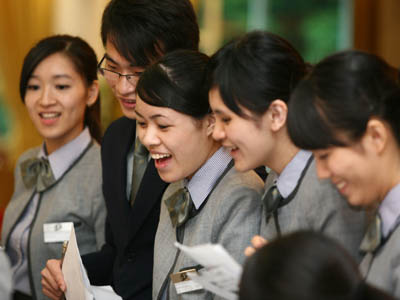 Students at the Institute for Tourism Studies
in Macau take courses in tourism and hospitality with degree-level programs
available to meet industry demand for skilled managers. Students at the Institute for Tourism Studies
in Macau take courses in tourism and hospitality with degree-level programs
available to meet industry demand for skilled managers.
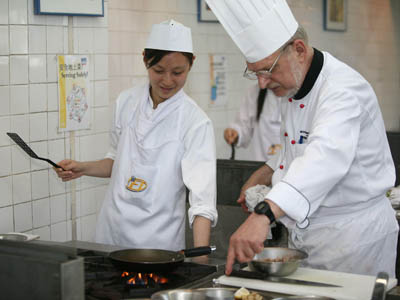 A
student receives professional training from an executive chef at the IFT. A
student receives professional training from an executive chef at the IFT.
The rapid pace of hotel and casino development over the past few years has
increased demand for tourism professionals in Macau. Long before the entry of
Las Vegas-style integrated resort operators, the Institute for Tourism Studies (IFT)
was nurturing future industry leaders and professionals.
The IFT is a public institution of higher education that falls under the Macau
government's Secretary for Social Affairs and Culture. Established in 1995, the
school offers tourism and hospitality management degree programs, and
professional training.
To help the upward trend of labor demand, the institute has played a key role in
training new blood and raising quality. It offers full-time degree courses in
tourism business management, heritage management, hotel management and tourism
event management.
Apart from the degree program, with intake reaching maximum capacity in the
coming academic year, the institute also provides professional and continuing
education and training. In 2000/2001, the institute had 233 degree-program
students and 3,208 people being trained. In 2007/2008, the figures surged to 926
and 11,300 respectively.
Last year, there were 138 graduates with bachelor degrees; 148 with higher
diplomas; 43 with diplomas and 43 with certificates. Figures for this year are
not available, except for an additional 80 graduates from the higher diploma
programmes in heritage management and tourism event management.
Given the dynamic nature of the industry, the courses are practical. IFT
president Fanny Vong Chuk-kwan said industry and government representatives sat
in the IFT coordinating council for training activities and met twice a year
with IFT management to discuss training needs. "The IFT and industry regularly
develop courses together," Dr Vong said. "We also keep ourselves in the loop by
being on industry trade associations, such as the Macao Hoteliers and Innkeepers
Association, and keep up with industry issues every month. Seeing the rise of
meetings, incentives, conventions and exhibitions, (MICE), we partnered with the
University of Technology in Sydney last year to deliver a four-day executive
development program on events management. There are also students enrolled in
various other short-term professional training courses in MICE-related areas."
The IFT launched its tourism event management degree in 2005, and enrols around
40 students a year. There are about 40 applications for each of the certificate
and diploma courses a year. So, every year, about 120 students in full-time, or
equivalent mode, are studying MICE-related programs.
"We are engaged in joint projects with intergovernmental agencies, such as
Unesco, in the development of training materials for the region in heritage
interpretation. I believe this is evidence of regional recognition of our
quality and ability to deliver," Dr Vong said.
The institute has also rolled out a series of upgrades and refurbishments for
its training facilities that are open to the public.
IFT director Gloria Wong Mei-cheng is proud of the 20-room Pousada de Mong-Ha
training hotel, which will be finished this month.
"We [closed] the training hotel between August 4 and September 5 for
refurbishment," Ms Wong said. "Every room will be installed with new furniture
and an LCD computer terminal for internet access. The Portuguese design remains,
but we used smaller Chinese-style multifunction furniture to save space. We
[are] also ... a green hotel.
"The 100-seat Educational Restaurant got a new look early this year. A modern
and trendy design replaced the home-style decor and added a modern-looking wine
cellar."
IFT students take part in day-to-day operations with supervision from lecturers.
These training grounds provide a real-life environment for them to apply what
they have learned, while comments from guests help them to refine their service
skills.
November 22 2008
China Suspends "Actual Payment" of
Processing Trade Customs Duty Deposit
On 21 November 2008, the Ministry of Commerce and the General Administration
of Customs jointly issued Announcement No.97 [2008] under which the "actual
payment" of customs duty deposit stipulated in Announcement No. 44 issued by the
two departments in 2007 will be suspended with effect from 1 December 2008. The
new policy will affect 1,853 tariff items under the restricted exports category
and 272 tariff items under the restricted light industry and textiles imports
category. Category A and B processing trade enterprises will temporarily switch
from "actual payment" to "nominal payment" of customs duty deposit, whereas
Category C enterprises will continue with "actual payment".
Moreover, 17 tariff items of furniture products will be removed from the
restricted category of processing trade.
For details of the announcement and lists of affected items, please visit
Ministry of Commerce's webpage at:
http://www.mofcom.gov.cn/aarticle/b/c/200811/20081105907568.html
November 26 2008
 The Hong Kong venture that took off thanks to Deng - Maxim's seized chance to
set up on the mainland 30 YEARS OF REFORM by Woods Lee
The Hong Kong venture that took off thanks to Deng - Maxim's seized chance to
set up on the mainland 30 YEARS OF REFORM by Woods Lee
Two days before Christmas in 1978, Annie Wu Suk-ching, the daughter of Maxim's
founder James Tak Wu, was sitting on a train outside Wuhan railway station, on
her way to Guangzhou, when the loudspeaker above her began to play a radio
address from paramount leader Deng Xiaoping .
The Communist Party had just wrapped up its plenary session in Beijing, where
members had resolved to clear up ideological uncertainties in the wake of the
Cultural Revolution and change the direction of the nation.
"In his determined and clear voice, Mr Deng said China welcomed foreign
investment, including from Hong Kong, Macau and Taiwan, and I thought that some
big changes were going to take place on the mainland," she said. "I had never
met Deng Xiaoping but he sounded very sincere, straightforward and trustworthy
in that broadcast, and I believed that this time, China meant what it said."
Here was the sort of opportunity Ms Wu had come looking for. Over the following
two years, she would start up Beijing Air Catering - registered as "Sino-foreign
Joint Venture 001" - using her family's experience in delivering fast,
inexpensive food to people in Hong Kong to create a business supplying meals to
the airlines flying out of Beijing's international airport, which was set to
more than double in size.
Eight days earlier, China and the United States had announced they would
normalize relations on January 1, with the western power deciding to switch
diplomatic recognition away from Taipei. In the coming year, Deng would go to
Washington and US vice-president Walter Mondale would visit Beijing, laying the
groundwork for accords covering, among other areas, civil aviation. Regular
flights would soon follow.
The Chinese side knew they needed help, however, to supply food for the airline
industry. The in-flight menu at that time was no more than biscuits, boiled
eggs, cold luncheon meat and washed but unpeeled fruit. Deng had muttered in
dissatisfaction more than once at the thin layer of crumbs on his lap when he
picked up the bread served on Chinese flights.
Ms Wu took her idea for the catering business to her father, who was hesitant.
The family had little knowledge about doing business in China. But she persisted
and negotiations began with the Beijing management bureau of the Chinese Civil
Aviation Administration.
The talks proceeded slowly. The central government had no experience of bringing
in foreign companies. "The officials simply did not know how to make decisions
on this unprecedented matter," Ms Wu said. "They did not have any concrete ideas
about joint ventures, and we even had to talk them through the relevant clauses
of Hong Kong's company law for their reference."
But they felt it would be easier to communicate with partners from Hong Kong,
Macau or Taiwan than anywhere else, given the shared ancestral roots. This
helped to foster mutual trust, goodwill and patience in the discussions and to
an extent helped Maxim's beat three other bidders to secure the partnership.
Ms Wu bolstered her chances in the talks when her family supplied the airline
meals on a state trip that communist revolutionary Li Xiannian , then the
vice-chairman of the Communist Party's Central Committee, took to the
Philippines. The thoughtful service and delicate food apparently deeply
impressed him and cadres from the Civil Aviation Administration on the flight.
By March 1979, all the equipment was installed and trial operations had gone
smoothly. They would open in months, but Ms Wu still did not have official
approval. When Deng eventually learned of this, he asked: "How are the Hong Kong
partner's bread-baking skills?"
"Very good," he was told. "Then why did you not approve it?" Deng said.
With that, the final paperwork came quickly, and in 1980 China's Communist Party
launched its first joint venture with a foreign company, taking a 51 per cent
stake.
Despite surmounting this initial hurdle, economic reform got off to a slow
start. By 1983, the first year the mainland publicly disclosed its official
statistics on foreign capital influx, foreign direct investment (FDI) stood at
US$910 million. Five years later, FDI was running at more than US$2.6 billion a
year.
However, in the years following the Tiananmen Square military crackdown in 1989,
the influence of party conservatives seemed to strengthen. They rekindled the
ideological debate about whether capitalism or socialism should govern China's
opening up and reform efforts and warned against "peaceful evolution" - a
reference to a possible western overthrow of the communist regime through
economic and cultural infiltration.
The ideological situation dragged down the rate of foreign capital inflow to the
mainland. From 1989 to 1991, actual FDI stayed almost unchanged, at less than
US$4 billion a year.
Foreign investment did not begin to grow rapidly until 1992 and, once again, it
was pushed by Deng.
On his famous inspection trip to southern provinces in the spring of 1992, Deng
fought back with a philosophy of "no debate" on so-called ideological issues.
Instead, he stressed a pragmatic definition of socialism - that which allowed
anything to be considered socialist provided it boosted economic efficiency and
improved the people's welfare.
Deng's clarification greatly expanded the latitude for foreign investment, and
overseas capital inflows rose sharply. By last year, the mainland had been the
biggest recipient of FDI among developing countries for 16 years in a row and
had become the second-biggest recipient of FDI in the world after the United
States.
Beijing has approved 653,087 foreign-funded enterprises, according to the
Ministry of Commerce. All but 10 of the companies listed on the Fortune 500 list
of the biggest US firms now have either branches or representative offices in
the country.
Wang Yuesheng , dean of the international economy and trade department at Peking
University, said the true impact of foreign businesses moving into the mainland
was still to be felt.
"Foreign investment has brought about changes in people's outlook, the property
ownership structure, corporate systems, means of controlling the economy and
even the government's role in the market economy," Professor Wang said.
"This will spark further chain reactions in China's political and economic
systems in the future and is therefore more valuable if viewed from a long
historical perspective."
Beijing Air Catering has witnessed the transformation and growth at first hand.
When it began, Ms Wu's company was producing between 100 and 200 meals a day
from a processing line squeezed into an area of less than 50 square metres.
On August 25 this year, a day after the curtain fell on the Beijing Olympics,
the company had its busiest day yet. It produced 80,007 meals for tourists,
athletes and state leaders leaving on 385 flights out of Beijing.
 China turns to be a hotspot
for hotels' expansion China turns to be a hotspot
for hotels' expansion
As the travel and hotel industries worldwide face the squeeze from the global
economic recession, China has turned out to be a hotspot for hotel owners and
management companies to seek continued growth and expansion.
In Shanghai alone, adding to the ever-changing city's skyline, will be a number
of luxury hotels in the coming two years. Six years after it made its first
footprint in Shanghai, the world's leading luxury hotel Four Seasons Hotels and
Resorts said it would start a second chain in the city's Pudong district by the
end of 2009. The hotel company is ready to embark on a rapid path of expansion
there, encouraged by the country's phenomenal pace of development that seems
undaunted even by the current worldwide financial crisis.
Four Seasons has also announced new openings in Hangzhou and Beijing by the end
of 2009, and Guangzhou and Sanya in Hainan province in 2010. It currently
operates three hotels in China including Shanghai, Hong Kong and Macao.
For Isadore Sharp, chairman, founder and CEO of the Canada-based luxury hotel
chain, this is just the beginning.
He says China is of strategic importance to the company's global expansion given
the sheer size of the population and the country's potential to vie with North
America as an economic super power.
"We grow with the market," says the 76-year-old hotelier, who obviously revels
in the outlook of his hotel business in China. "China is a vibrant country. For
the hotel and travel industry, they are going to benefit from what's happening
in countries like China, India, and Russia. The dynamics and demographics in
this part of the world is going to overwhelm what the future will be in our
industry."
He adds that in the future Four Seasons may probably have as many hotels in
China as it has in North America, where it now manages a conglomerate of nearly
40 medium-sized hotels of "exceptional quality".
"If you look at the size of the country in a number of cities, we are just
beginning," he says.
Obviously Sharp is not alone in thinking so. The world's largest private hotel
company Global Hyatt Hotel also announced in September the opening of the first
Park Hyatt in Shanghai, together with two other new hotels in Beijing and
Guangzhou in the same year. Mark S Hoplamazian, president and CEO of the private
hotel company, says given the significant growth in the Chinese business
community and its need to travel around the country, there will be great demand
for Hyatt's lodging.
Both hoteliers have reason to be optimistic. The last time Sharp was in China
was when the first Four Seasons Hotel opened in Shanghai in 2002. Since then,
the country has undergone "dramatic changes," which, according to Sharp, has
given the company a foothold to grow and expand in the country.
"A good example of what China is capable of doing is the way it handled the
Olympics," says Sharp. "China has set a standard that the only time when it is
reached again is when it runs another Olympics. It is symbolic of many other
things happening here. It has raised our sights. We also want to be the Olympic
champion of the hotel industry," he chuckles.
Both hoteliers' belief in the prospect of the hotel industry worldwide,
especially in China, is not dented by the current economic downturn. For them,
the whole idea of economy going down is within its normal cycles, which will not
affect the companies' long-term strategy and undermine what the future holds for
the hotel business in general.
"The hotel industry worldwide is going through normal downturn in the economic
cycles, but you are prepared, because it's natural business," Sharp notes. "The
industry today is the largest industry worldwide, growing in percentage terms
probably greater than any other industry. You have to understand that we build a
hotel to last 80 to 100 years, so it doesn't matter whether we build it during a
downturn. It's a long-term commitment."
What hotels like Four Seasons could do, he says, is to organize their business
plans to be able to go through the (leaner) times and make sure the crisis does
not affect the companies, so that they would become strong enough to withstand
whatever happens in the economy and be prepared to deal with the next good
cycle.
Hoplamazian, too, agrees that the economic growth in China, especially in
Shanghai, is going to be strong over the long term. The company wants to stay
focused on making sure that the hotels are built for the long term. He says.
Zhao Huanyan, consultant at the Shanghai-based SAO Hotel Solution Consulting
Ltd, says that it is not surprising for major international hotel giants to look
to China for growth opportunities. According to his observation, ten of the 12
major multinational hotel owners and management companies have either announced
new openings or signed new contracts in China during the two months after the
Olympics.
Jumeirah, the Dubai-based luxury hotel group and operator of the world famous
Burj Al Arab, will reportedly open its first hotel in Shanghai early next year,
and hopes to eventually open 10 in the mainland, though it did not provide a
timeframe for that expansion.
Even budget hotels in China are receiving a boost from the current economic
uncertainties. The Wall Street Journal reported earlier last month that Actis, a
private-equity investor in emerging markets, recently pumped $65 million into
the 7 Days Inn Group, a Guangzhou-based budget-hotel operator. The investor had
reportedly expressed confidence in China's budget hotel industry whether in good
times or bad.
"If we look at the potential of the tourism and hotel industries in the
Asia-Pacific region, especially in China during the current global economic
downturn, China will continue to offer growth opportunities and confidence for
hotel runners," Zhao says.
November 12 2008
How to read Country of Origin barcode?
Example: 471 is Made in Taiwan

00 ~ 13 USA & CANADA
30 ~ 37 FRANCE
40 ~ 44 GERMANY
49 ~ JAPAN
50 ~ UK
57 ~ Denmark
64 ~ Finland
76 ~ Switzerland and Lienchtenstein
471 ~ Taiwan
628 ~ Saudi Arabia
629 ~ United Arab Emirates
690 - 695 ~ China
740 - 745 ~ Central America
All 480 Codes are Made in the Philippines
November 8 2008
China
market in the franchise spotlight - report from Franchising & Licensing Asia
2008, Singapore
 |
| Franchising extension:
Carl's Jr. store. |
Everything can be franchised, it seems. This much
was clear at the Franchising & Licensing Asia 2008 exhibition and
conference, held in Singapore from 16 to 18 October. Despite the chaotic
global financial markets, this year's event continued to be as bustling as
it was last year - with some key differences that augur well for the growth
of the industry in Asia.
The 2008 event had 10,000 visitors from 43
countries. The number of exhibitors was the same as last year, but in terms
of the variety of franchise categories and the countries the exhibitors were
from, FLAsia this year was far better.
Among the more unusual companies looking to
franchise their concept this year, included customised stuffed animals (Animaland,
from the Philippines), carbon emissions management (Carbon Planet
from Australia), clothes cleaning (Mr. Clean, from Malaysia), a pet
store (Pet Lovers Centre, from Singapore), and aged care solutions
(Senior Care Services from the US). Exhibitors came from 19
countries, including Israel, Italy, New Zealand and the UAE.
 |
| Pet Lovers Centre
welcomes guests. |
|
 |
| Singapore
franchise stand. |
|
The International Franchisor of the Year Award was
given to Little Sheep. Founded in Mongolia in 1999, the chain of
hotpot restaurants grew rapidly on the Chinese mainland, leading to a US$25
million capital injection by UK company 3i and China-based US firm
Prax Capital, with a successful initial public offering (IPO) in
Hong Kong in June this year. The company today has some 350 outlets on the
Mainland, in Hong Kong, Taiwan, Canada and the US.
Yuka Yeung, COO of Little Sheep, found
FLAsia very useful for promoting the brand: "we are the most well known
hotpot brand in China, but not as well known outside China. FLAsia is a very
good venue to exchange information and ideas. We have been talking to
several people for an outlet in Singapore."
Two Hong Kong companies made their presence known
in FLAsia. One was JHC Group. Sandra Yip, senior manager for
commercial sales said: "as the largest houseware chain store in Hong Kong
with some 200 stores, we are in FLAsia to find franchise partners in
Singapore and the Southeast Asian region."
JHC Group has been expanding aggressively,
with stores in London, San Francisco, New York, the Philippines, Indonesia,
Malaysia, Dubai and Sydney. In 2007, the company embarked on a Chinese
mainland expansion plan.
 |
| Aggressive
expansion for Hong Kong franchise. |
|
 |
| Hotung (left) and
team. |
|
The other company from Hong Kong was Kids'
Gallery, a company offering art enrichment programmes for children. The
founder, Joanna Hotung, was on hand to meet and greet visitors. Founded in
1996, Kids' Gallery now has four centres in Hong Kong, with 3,000
students a week. "We started franchising in 2003," said Hotung, "and are now
in five countries, with Macau opening in November this year and Seoul early
next year."
The franchise industry has done well. By 2013, the
Asian franchise market will grow into a hundred billion US dollar industry,
according to guest of honour Indranee Rajah, deputy speaker of the Singapore
Parliament.
Franchises of the year
The Franchisor of the Year went to V-KOOL,
which produces a solar heat control film that is used in cars and buildings.
The Singapore company now controls 65% of the market and has 600 retail
points in 28 countries. China has become so important that Wilson Lim,
V-KOOL's general manager, has based himself there.
"China has several challenges," said Lim. "People
cannot distinguish our product, which is a premium brand, from those that
are not. There is a perception that cheap and dark film is better. Manpower
is another issue, with the need for proper training, and the need to
inculcate international best practices in a local environment. Yet China is
so vast, that if we achieve just 1% market share, I'll be very happy!"
 |
| Wilson Lim (left)
receives his award. |
|
 |
| 7-Eleven winner. |
|
Promising Franchisor of the Year was awarded to
Waraku International. The company provides quality Japanese food -
without the need for a chef. There are currently 10 stores in Singapore, and
franchise outlets in Hong Kong, Jakarta and Kuala Lumpur. Said founder Mr
Kiyoshi Ueki: "we plan to expand to 10 new cities in the next five years,
and plan for five outlets in Hong Kong alone next year. The potential in
Hong Kong itself is very good. I would say even better than Singapore, due
to the demographics and spending power, and like Singapore, everyone eats
out."
A new category this year was Franchisee of the
Year. The winner was Nallakaruppan, who is the franchisee for five
7-Eleven stores in Singapore. Next year, he intends to take on two more
stores.
While China remains a core focus for franchisors,
many new markets are now of increasing importance. Speaking during the
conference, William Edwards of EGS saw key markets also including
India, the Middle East and Vietnam. Each territory has its own unique
challenges and opportunities.
For China, Edwards saw the focus as continuing to
be in the urban centres. "You need customers that can afford your products,"
he said, "so the 1.3 billion total population is of a lot less significance
than 750,000 residents in Greater Shanghai with an annual income of greater
than US$25,000." It's also these urbanites that look to foreign brands for
their perceived convenience and quality.
Edwards said one key success factor in penetrating
Asian and Middle Eastern markets is trademark protection. "If you don't file
them locally, someone else will!" he quipped. The worst offenders are
surprising. The country with the worse record of trademark protection is
Australia, followed by Canada. China ranks fifth.
Tekson Teo of Singapore's Pet Lovers Centre
said he took part in the show to seek prospective franchisees for the
region, including the Chinese mainland, Hong Kong and ASEAN. There were some
interesting leads. "We will take one step at a time. Unless we have
identified franchise partners who are fully devoted to develop the Pet
Lovers Centre brand, we will not rush into any expansion. The franchise
partners that we are looking for should have strong retail experience, and
devoted to growing the pet business with us."
 |
| Interest at Funky
Fish. |
|
 |
| Subway visit. |
|
Less upbeat was Sagi Avrahami of Funky Fish,
a young women's apparel company from Israel. "The attendance has not been as
Asian wide as I had hoped. There are not many Japanese, Chinese and Koreans.
Other than that, I am generally satisfied with the event."
New to FLAsia were demonstrations and seminars for
exhibition visitors. These included talks on various aspects of franchising,
but also more engaging activities, such as dog obedience demonstration by
Pet Lovers Centre, and a flamenco dance performance, by Tapas
Tree. Tapas Tree seeks to bring the Spanish dining experience
to Asia - together with Spanish culture via its décor, music and live
performances.
Also new was extending the conference side of the
event away from theory and discussion of the formal presentations, to actual
site visits to franchisees.
Visits were made to outlets of Carl's Jr.,
Pet Lovers Centre and Subway. It was enlightening for
conference delegates to see and hear first hand from franchisees how their
operations run and the challenges they've faced. |
October 31 2008
Seven ways China might surprise us in 2009
- The country could yet again change the way the world sees it. Here’s a
shortlist of realistic possibilities. by Gordon Orr
How will China surprise us next? Shocks, tipping points, and revelations have
become basic staples of the world’s daily news diet. But with so many eyes now
on this emerging Asian giant, what happens there continues to have an
exceptional ability to draw attention and to shift perceptions drastically and
suddenly.
Will the surprise be planned, like the magnificent Beijing Olympics Games, whose
nearly flawless execution set a counterpoint to China’s image as an economic
laggard buoyed mainly by cheap labor? Will it repel, like the tainted-milk
scandal? Or will it send a message, as Lenovo’s takeover of IBM’s
personal-computer business did in serving notice that Chinese companies were
ready to enter the global fray?
Here’s a list of some realistic possibilities for the next year. Will all of
them come to pass? I doubt it. But any one of them could, and each might make us
see China and its future in a new light. What do you think?
China announces that by 2020, half of the cars in the country will be electric.
It invests tens of billions of dollars in R&D toward achieving that goal.
Such a move could make China the leader in the automotive technology of the
future, with other countries struggling to keep pace. Shanghai Automotive
Industry Corporation (SAIC) or newcomer BYD Auto could become the Ford Motor of
the 21st century, propelled by a new technology—much as Ford capitalized on the
internal-combustion engine at the start of the 20th century.
The Chinese government buys a 50-year lease on an entire geographic region of
Mexico, enabling Chinese companies to build factories there to supply the North
American market more easily.
Chinese companies would then become the undisputed leaders in outsourced
production. No longer constrained by geography, they could bring their expertise
in low-cost manufacturing to Mexico (or Poland or Turkey), greatly expanding
their reach and overcoming obstacles—such as maintaining supply chains across
the Pacific—that still hinder their growth.
A major office block collapses in Chaoyang, Beijing’s central business district.
Although officials would scramble to rewrite construction regulations, a
disaster in the capital or another large city would change the relationship
between the country’s growing middle class and the government and might threaten
its ability to keep social unrest in check. True, construction standards came
under fire after the May 2008 Sichuan earthquake felled many school buildings.
But the reaction to that tragedy would pale beside the response to a similar one
in a rich urban area with immediate media access.
A leading Chinese company tries to buy an iconic US technology firm (or two).
A major deal could be worth 10 or 100 times Lenovo’s $1.35 billion purchase of
IBM’s PC division. If the US government blocked the sale, the acquisition’s
failure could herald an era of renewed corporate nationalism in China, just as
its companies were becoming more global. You could expect an aggressive increase
in domestic R&D spending as the country focused on homegrown technology, as well
as a chillier climate for multinationals with research operations in China.
A successful deal, by contrast, could create a truly global company, unlike
anything seen before, with a multinational culture superseding any sense of
national origins.
A restructuring of China’s telecommunications industry turns into a complete
consolidation.
Regulatory failure and competitive imbalances have already reduced competition
down to three major players, from four, and telecom companies are now being
encouraged to share infrastructure. If stock prices continue their freefall and
these imbalances remain, the inability of the second- and third-ranked players
to chart a path to success could bring a full reconsolidation of the domestic
industry.
The English Premier League football association buys its Chinese counterpart,
the Chinese Super League.
What better way to signal a coming of age for China’s urban middle class?
The takeover would be a major bet that this growing socioeconomic group is ready
to spend heavily on sports and entertainment—a bet that could open the
floodgates for investment in other consumer sectors. Wallets are already opening
up: witness the Olympics and the US National Basketball Association’s
exploration of franchise and stadium deals in China. Such a purchase would also
show that the country is willing to bring outside expertise and professionalism
into a challenged domestic industry.
Warming cross-strait relationships lead to a merger between the mainland’s
Industrial and Commercial Bank of China and Taiwan’s Chinatrust Commercial Bank.
The reaction in Taiwan would probably be ambivalent—just another large business
deal. But in China, a cross-strait merger of powerhouses like these, in banking
or some other sector, would be applauded as an affirmation of its One China
worldview.
Gordon Orr is a director in McKinsey’s Shanghai office.
October 24 2008
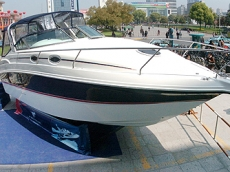 Yachting sails
into Zhejiang on winds of the US subprime - Voyaging into the Hangzhou market. Yachting sails
into Zhejiang on winds of the US subprime - Voyaging into the Hangzhou market.
Applause Yachts has a 220,000 sqm yachting shipyard in Huzhou and Wenzhou, on a
scale rarely seen in Asia. The company is enthusiastic about its new venture
mainly because it has confidence in the future of the industry, says company
general manager Fei Ping.
At a news conference for the upcoming fourth Hangzhou Qiandao Lake International
Yacht Show (from 31 October to 6 November), Fei said China's yachting industry
owes its opportunity for expansion to the US subprime crisis.
Under the impact of the crisis, yacht makers in the West are finding themselves
in a plight never before experienced.
Among the worst hit were makers of affordable yachts under 36 ft, as they were
the first to bear the brunt of the financial turmoil, Fei explained.
Conversely, in order to ease subprime pressure, makers of larger yachts are
being forced to shift manufacturing bases to Asian countries such as China and
India to hold down production costs.
"With the relocation of these large yacht makers to China comes the rise of our
home grown industry," said Fei. In his opinion, the government is beginning to
attach great importance to this industry.
Besides moves to create a greater international image, show organisers are
striving to build a business matching platform for yacht makers and buyers, said
Shi Yongsheng, deputy director of Hangzhou's West Lake International Expo
Office.
Auxiliary industries are expected to become investment hot spots in the wake of
the forging yacht industry. Conventional manufacturing enterprises, in their
subprime and exchange rate woes, also see a glimpse of hope in switching to
yacht design and boatyarding or related industries.
"Compared with steering wheels for automobiles, steering wheels for yachts can
fetch at least 10 times the price at relatively the same production cost," said
Fei.
The yachting industry can survive mainly because there are higher profit margins
but a relatively lower threshold. For example, makers of ordinary flooring can
switch to the production of yacht flooring, and makers of auto glass can produce
yacht glass just the same, Fei told reporters.
"Although small leisure boat sales have shrunk drastically, the market for big
yachts has been growing at a rate of 28% to 32% in the first seven months of
this year," he said.
On the Chinese mainland, where a yacht culture has yet to arise, more and more
large corporations are keen to buy luxury boats to enhance their image. This has
given the industry a useful boost.
October 21 2008
Pudong to Pilot Paperless Import Clearance
Shanghai Customs recently announced that Pudong will introduce paperless
clearance for imports on a pilot basis by the end of this year.
For years, enterprises must complete customs declaration procedures of imported
and exported goods at customs checkpoints. At the end of 2007, Shanghai Customs
first kicked off paperless export clearance procedures. As at the end of
September this year, Pudong Customs alone had cleared about 1.4 million export
shipments electronically.
According to Ma Yan, Director of Pudong Customs, Customs has been gradually
adopting different management measures towards different categories of foreign
trade enterprises by using risk management concepts and modern information
technologies on the principle of "law-compliance and convenience". A key feature
of the pilot reform on paperless import clearance first carried out in Pudong is
that enterprises with high credit rating are eligible for customs clearance
facilitation measures such as paperless clearance, and they are longer required
to submit the paper declaration form to Customs.
Ma reckoned paperless import clearance is a significant reform measure of
Customs after paperless clearance for exports. It can further help law-abiding
and self-disciplined enterprises reduce clearance costs and sharpen their
competitiveness in international markets, he said, adding that paperless
clearance is expected to account for 70% of all imports going through Pudong
Customs by the end of 2009.
Customs statistics show that Shanghai registers a relatively large trade surplus
among all mainland ports. From January to August 2008, Shanghai's total exports
rose 26.6% year-on-year to US$262.73 billion, while total imports were US$147.98
billion, up 21.3% year-on-year. The cumulative trade surplus reached US$114.75
billion, representing a year-on-year growth of 34.3%.
Guangzhou to Build China's Third Supercomputing Centre
Guangzhou is currently cooperating with the Chinese Academy of Sciences on a
supercomputing centre project. The future centre with a supercomputing system
will be built on a 12,000 sqm site with an investment of Rmb380 million. When
completed, it will be China's third supercomputing centre after the ones in
Beijing and Shanghai.
Meanwhile, the projects for flat panel TVs and IC chips, slated to have an
output value of Rmb250 billion and Rmb200 billion respectively when completed,
are underway. By the year 2015, the city's service-based industrial structure
will basically take shape and the proportion of tertiary industry in GDP will
reach 65%. The proportion is projected to top 70% by 2020.
Guangzhou has recently passed in principle the Urban Construction Investment and
Financing Reform Scheme, which entails the fostering of seven investment and
financing corporations to raise the necessary funds for projects in the fields
of transport, water supply, subway construction, gas supply, garbage disposal,
urban construction and building of the Asian Games City. Guangzhou also plans to
invest Rmb1 billion each year over the next three years to promote proprietary
innovation and accelerate the development of high-tech industries.
October 3 2008
AQSIQ Holds Legislative Hearing on New
Rules on Defective Goods Recall
The State Administration of Quality Supervision, Inspection and Quarantine
(AQSIQ) held a legislative hearing on the Draft Provisions on the Administration
of Recall of Defective Goods on 24 September. According to Liu Zhaobin, director
of AQSIQ's Laws and Regulations Department, the new rules are intended to
regulate the recall of defective goods, safeguard public safety, public interest
and socioeconomic order, and protect the personal health and safety of
consumers.
The Provisions on the Administration of Recall of Defective Goods will be
China's first legislation on the recall of defective goods. In addition to
automobiles, toys, food and drugs, which are already covered by the recall
system, other goods that may cause serious bodily harm, such as electrical
appliances and public service facilities, may also be recalled if found
defective.
Divided into seven chapters and consisting of 64 articles, the draft legislation
applies to products made and sold within China but does not cover drugs and
military products. Representatives from enterprises, industry associations and
consumers fully endorsed the key objectives and significance of the legislation
and offered their comments and suggestions at the hearing.
Enterprises advised to set up a risk fund
Dong Zhengwei from Zhong Yin Lawyer, a law firm in Beijing, suggested that those
held responsible for safety accidents caused by defective goods should not just
be prosecuted for criminal and administrative liabilities but should also be
made to bear civil and property liabilities.
He suggested adding the following provisions to the chapter on legal
liabilities: Producers that caused major accidents of personal and property
safety for producing and selling defective goods shall be fined 10-20 times the
value of the quantity of defective goods produced and sold at market price. If
this is not enough to make good the loss inflicted on the country and on
society, the enterprise may be auctioned off to pay the fine.
In his opinion, the state should encourage producers to join hands to set up a
risk fund for dealing with the harms caused by defective goods to society,
because some defective goods may harm many people, involve many enterprises in
the industry, and entail huge medical expenses and compensation, which cannot be
borne by individual enterprises that caused the accidents.
Wuhan Workers Get Triple Pay Working on
Holidays
The government of Wuhan recently ratified the Regulations on Wage Payment. Hong
Kong companies with investment in the city should pay attention to this because
the new rules will be strictly enforced.
The new regulations require employing units to pay their workers on the day
agreed. Wages shall be paid at least once a month. If the pay day falls on a
statutory holiday or weekend, payment shall be made on the preceding working
day.
Units that adopt the annual salary system or pay wages on the basis of
assessment periods shall pay part of the wage in advance each month at a level
not lower than minimum wage, and settle payment in one lump sum at the end of
the year or assessment period.
The most important point is that employing units that cannot give their workers
day off according to state regulations due to work needs must pay workers three
times their daily pay in lieu of remuneration for annual leave.
Those having to work on statutory holidays are eligible for overtime pay at 300%
their daily or hourly rate; those having to work on weekends but are not given
compensation time off are eligible for overtime pay at 200% their daily or
hourly rate; while those having to work extended hours on their work days are
eligible for overtime pay at 150% their daily or hourly rate.
No Jobs for People without Temporary
Residence Permit in Guangzhou
Guangzhou mayor Zhang Guangning recently signed Government Order No. 10 and
promulgated the Regulations on Floating Population Management, which came into
force on 18 August 2008.
Zhao Nanxian, deputy secretary-general of the Guangzhou municipal government,
called the new regulations an important achievement of the Urban Management
Year. Guangzhou currently has a registered floating population of 4,661,900
people. The city's party committee and government both attach great importance
to floating population management.
Under the new regulations, temporary residence permit holders shall enjoy nine
services, including application for driver's licence; application for legal aid;
declaration of scientific and technological achievements; access to birth
control and pre-marital and maternity health services; social security; access
to community and public service facilities; free compulsory education for
children; immunisation for children; and health care for children. Employing
units may not employ people without temporary residence permits. Employers of
migrant workers must sign and honour labour contracts, abide by the minimum wage
system, complete social security procedures, and provide on-the-job training to
their employees. The government keeps digital records of floating population.
The new regulations also apply to the management of foreigners living in the
city.
 Creative
Shanghai gets global attention - Brand development advances. Creative
Shanghai gets global attention - Brand development advances.
Beijing's 798 Art Zone, well-known both at home and abroad, attracted many
foreign leaders during the Olympic Games. However, Zhou Minhao,
secretary-general of Shanghai's Economic Commission, pointed out that Shanghai's
creative industry will not take the same path: it'll give full play to its own
unique advantages.
At present, over two thirds of the creative industry clusters in Shanghai take
root on the basis of preserving and developing old factories and buildings.
These clusters have gradually formed their own local characteristics.
In fact, as Shanghai's industrial base continues to shift to the rural areas,
around 20 million sqm of old factories and old buildings have been made
available in the city's central district.
In developing the creative industry, efforts are being made to preserve the
historical flavour of the city, while the element of creativity is injected into
old factories and buildings through innovative design and refurbishment.
By so doing, not only is the historical flavor of Shanghai preserved, it's
claimed, but renovation creates a cradle for the hatching of new industries.
According to Zhou, the Shanghai municipal government won't directly invest in
the creative industries, but will provide a sound market environment for
enterprises.
Currently, there are 75 creative industry clusters in Shanghai and the number is
expected to grow further. The municipal government is in the process of
formulating measures for the administration of these industry clusters with the
aim of proactively and effectively regulating their development and upgrading
the standard of the creative industries.
The Shanghai municipal government is also advocating the establishment of a
Creative Industry Alliance and encouraging industry players in Shanghai to join
on a voluntary basis. The alliance aims to promote industry self-discipline and
to enhance efforts to protect intellectual property rights.
Shanghai's creative industry has grown in leaps and bounds. In 2007, total
output value of the industry exceeded Rmb300 billion, a growth of almost 30%
year-on-year and accounting for 7% of Shanghai's total industrial output value.
As such, the creative industry has emerged as an important new pillar in
Shanghai's economic development.
Meanwhile, among the renowned creative brands established in Shanghai are SOM,
which designed the Jin Mao Tower and L'Oréal's Asian R&D centre. In mid October,
the 2008 Shanghai International Creative Industry Week will be held under the
theme of "Brilliant Creativity - Design Future". This event is set to promote
the development of China's creative industries and strengthen exchanges and
co-operation with other countries.
This year will be the fourth edition of the event in Shanghai, with participants
from over 20 creative industry sectors around the world.
September 27 2008
New Access Card for Upcoming Canton Fair
The 104th Canton Fair, with its exhibition period split into three phases
instead of two as in the past, will be held from 15 October to 6 November 2008.
Each phase will last for five days instead of six, with two intervals of four
days each. All three phases will be staged in the Pazhou complex, and the Liuhua
complex will no longer be used.
E-Passes issued to overseas buyers previously will no longer be valid and a new
IC card entry badge will be used for access. The fair organiser is therefore
providing the following application service for overseas buyers:
1. Online application: Visit the Canton Fair's official site at
www.cantonfair.org.cn after 18 August and input your E-Pass code on the BEST
(Buyer E-Service Tool) platform to apply for the new badge. Upon verification,
an acknowledgement of receipt will be sent to you by e-mail, with which you can
obtain your new badge at the overseas buyers registration counter at fairground
or at your hotel.
2. Application in Hong Kong: Apply at Solid Channel Co Ltd at Rooms 3106-3107,
Office Tower, Convention Plaza, 1 Harbour Road, Wanchai, Hong Kong, between 8
September and 26 September, bringing with you your valid original personal
identification document (such as Hong Kong/Macau Home Visit Permit or I.D. card,
Taiwan Compatriot Travel Certificate, overseas passport, overseas residence
certificate, or Chinese passport with an overseas employment visa valid for over
one year), E-Pass, business card and a passport-size colour photo. (Office
hours: 09:30-17:30, Monday to Friday; 09:30-12:30 on 26 September).
3. On-site application: Apply at the overseas buyers registration counter at
fairground or at your hotel upon arrival in Guanzghou by presenting your valid
personal identification document (such as Hong Kong/Macau Home Visit Permit or
I.D. Card, Taiwan Compatriot Travel Certificate, overseas passport, overseas
residence certificate, or Chinese passport with an overseas employment visa
valid for over one year), E-Pass, business card and a passport-size colour
photo.
For inquiries, please call 86-20-26089999 (Guangzhou), or 852-28771866 and
852-28771318 (Hong Kong).
New SFDA Rules Cover Supervision over
Catering, Health Food and Cosmetics
The Rules on the Principal Functions, Internal Organisation and Personnel
Establishment of the State Food and Drug Administration (SFDA) recently approved
by the State Council will result in two changes in SFDA's duties: First,
assigning to the Ministry of Health the responsibility for coordinating food
safety and organising investigations into major food safety incidents. Second,
assigning to SFDA the responsibility for food hygiene licensing, supervision
over food safety in restaurants, canteens and other consumption sectors, and
supervision over health food and cosmetics.
SFDA's new duties include: Food hygiene licensing for restaurants, canteens and
other consumption sectors and supervision over their food safety; formulation of
food safety management standards for food safety in consumption sectors and
supervision over their implementation; food safety surveys and monitoring in
consumption sectors; release of information on food safety supervision in
consumption sectors; hygiene licensing, hygiene supervision, and examination and
approval of cosmetics; and supervision over health food.
After this adjustment, it is up to SFDA to monitor the safety of drugs, medical
equipment, cosmetics, health food, and food in restaurants, canteens and other
consumption sectors.
According to SFDA spokeswoman Yan Jiangying, this adjustment, which embodies the
principles of reform for simplified administration, unified action and higher
efficiency, and a system of checks and balances among the decision-making,
enforcement and supervision authorities while functioning in coordination with
each other, will help further clarify the responsibility for food and drug
safety supervision, and strengthen food and drug safety supervision in order to
better protect the health and safety of the people.
Central Bank Considers New Policies to Aid
Textile Industry
After raising the rate of VAT rebate on the export of textiles and garments
recently, the Chinese government is considering taking credit, fiscal and
taxation policies and measures to aid small and medium-sized enterprises (SMEs)
and encourage proprietary innovation. This was disclosed by Zhu Hongren,
director of the Operations Monitoring and Coordination Bureau of the Ministry of
Industry and Information Technology.
The textile industry is currently facing pressure in three respects, namely,
currency appreciation, rising labour cost and shortage of funds at a time of
economic downturn and rising cost. The first two factors are hard to change
because they are the general trend, but the shortage of funds may be eased with
support from the government.
China's central bank has recently decided to conditionally increase the annual
loan quota to Rmb230 billion to support SMEs with funding difficulties.
Specifically, the increase is 5% for the four major state-owned commercial banks
and joint-stock banks, to be used for special loans such as SME loans, and 10%
for urban commercial banks and other local financial institutions, mainly for
SME loans. However, the industry is not optimistic.
Zhao Meiling is a textile industry analyst with Essence Securities. In her view,
although the majority of businesses in the textile sector are SMEs and the loan
quota raise has conditions attached, funds that truly end up in the hands of
cash-short SMEs will probably be quite small. After all, banks have the final
say on such matters because they are the ones who bear credit risks.
IBM Moves Global Procurement Headquarters
to Shenzhen
According to senior executives of IBM Shenzhen, IBM has moved its global
procurement headquarters to the city following the establishment of its China
Procurement Centre (CPC). IBM's chief procurement officer has also moved his
office to Shenzhen.
CPC will provide IBM companies worldwide with a full range of procurement and
market information and procurement consulting services, including giving
strategic procurement and engineering support to IBM's Server Services
Department and Retail Solutions Department, providing IBM subsidiary and
joint-venture companies in China with general procurement service, and providing
procurement and engineering service to IBM end-users.
This is the first time IBM has relocated the headquarters of one of its
departments to a country or region outside the US. The move is viewed by the
industry as an exemplary case of a multinational company's evolution into a
"globally-integrated enterprise".
This important decision was made by IBM in view of the fruitful returns on its
investment in Shenzhen in the past 15 years. IBM established its first office in
southern China in 1993 in a bid to expand its China operations. It soon set up a
subsidiary in Shenzhen. IBM¡¦s business has seen fast expansion in Shenzhen,
with clients in all sectors, including finance, telecommunications,
manufacturing and commodity circulation. Operations for procurement, production,
order fulfilment, software business support and global delivery have since been
set up. Today, Shenzhen is an important IBM centre for procurement, order
fulfilment and manufacturing.
September 19 2008
China Withholding Tax on H-Shares
Dividends - O'Melveny & Myers LLP
Recently, various Chinese listed H-share companies disclosed in their 2008
interim announcements that a 10% PRC withholding tax will be deducted from
dividend distributions to their non-individual shareholders according to the new
PRC Enterprise Income Tax Law and the Implementing Rules of the PRC Enterprise
Income Tax Law ("EIT Law") which took effect from January 1, 2008.
Prior to the issuance of new EIT Law, foreign investors (including foreign
enterprises and foreign individuals) were historically entitled to the following
two exemptions according to a tax circular issued by the State Administration of
Taxation ("SAT") on July 21, 1993, i.e., GuoShuiFa [1993] No. 045 ("Circular
045").
1. An exemption from enterprise income tax withholding ("EIT") and individual
income tax withholding ("IIT") on dividends derived from foreign invested
enterprises ("FIEs"); and
2. A temporary exemption from EIT and IIT on dividends derived from Chinese
enterprises with respect to their H-shares/overseas shares or B-shares.
The first exemption from EIT was also contained in Article 19 of the prior
Foreign Enterprise Income Tax Law ("FEIT Law") which was replaced by the new EIT
Law on January 1, 2008. Under the new EIT Law, a non-PRC tax resident enterprise
which derives Chinese-source dividends is generally subject to the EIT (in form
of withholding) at a rate of 10% (subject to reduction by applicable tax treaty)
and the first exemption for dividends from FIEs was clearly abolished. However,
it is unclear whether the second tax exemption on dividends paid with respect to
H-Shares or B-Shares companies was abolished. While a recent tax circular,
CaiShui [2008] No. 1 ("Circular 1"), states that "any preferential enterprise
income tax policies implemented before January 1, 2008 should be abolished
unless it is addressed in the new EIT Law, tax circular GuoFa [2007] No. 39, tax
circular GuoFa [2007] No. 40, or Circular 1" and the second exemption is not
included in any of these tax circulars, it remains unclear whether the second
exemption should be characterized as one of the many "preferential enterprise
income tax policies" given the lack of a technical definition for this term.
In light of the above development, foreign investors receiving Chinese-source
dividends should be prepared to be withheld on as a matter of current
administrative practice and should consult with their tax advisors with respect
to seeking tax treaty protection or investigate other possibilities to manage
this exposure.
September 9 2008
Shanghai supports SME financing
As China's short-term credit market has been growing rapidly since last
year, quality and large corporate customers are becoming less and less dependent
on bank loans, and banks are increasingly shifting their focus to small and
medium-sized enterprises (SMEs). SME lending, long snubbed by mainland banks, is
attracting much attention and becomes a hotly contested market among Shanghai's
domestic and foreign-funded banks after private banking.
Banks in Shanghai have developed a range of new financial products catering to
SME needs, and are giving priority to SME financing. Some banks even set
specific growth targets for SME loan. Failure to provide banks with sufficiently
valuable collaterals is a common difficulty faced by SMEs in securing loans. To
address this problem, some banks now accept intellectual property rights as loan
collateral, while raising the loan ceiling gradually on a trial basis to offer
more comprehensive financing schemes to SMEs. At present, intellectual property
such as patents and computer software copyrights, as well as contracts and
credibility can potentially become intangible assets approved by banks as long
as enterprises are technologically sound, run business in good faith and have
promising prospects.
To ease the difficulty faced by SMEs in seeking financing, Shanghai has
established several types of policy-based credit guarantee organisations, making
it easier for SMEs to obtain bank loans. This year, the Shanghai Municipal
Finance Bureau has set up an Rmb50 million agricultural loan guarantee fund by
pooling together contributions from the finance departments of various districts
and counties. In addition, the Shanghai Economic Committee also arranged
meetings for 1,000 SMEs to network with banks and venture capital funds to
facilitate the availability of bank credit.
To expand direct financing channels and promote SME shareholding reforms and
listing, Shanghai has recently issued a notice on business registration and
other matters relating to equity investment enterprises, providing general
guidance for equity investment enterprises in areas such as finance, business
registration and taxation. The city has also launched an incubator project on
SME listing. Currently, there are 10 companies listed on Shanghai's SME Board.
With total market capitalisation exceeding Rmb20 billion, these companies have
raised Rmb2.639 billion through initial public offering.
According to the statistics of Shanghai Office of the China Banking Regulatory
Commission, as at the end of June 2008, mainland-funded commercial banks
provided loans to a total of 11,716 small enterprises, with loan balance
amounting to Rmb28.956 billion, up 1.19% over January 2008. Loans for small
enterprises increased 21.36% year-on-year, and the growth rate was 1.04
percentage points higher than that of total loans.
China Raises Consumption Tax on Big Cars from September
China will adjust consumption tax on automobiles and raise the tax rate on big-engined
vehicles starting from 1 September 2008, according to a circular jointly issued
by the Ministry of Finance and the State Administration of Taxation.
The circular specifically covers two aspects: First, to raise the consumption
tax rate on passenger vehicles with big engines. Tax on cars with engine
capacities between 3.0 litres and 4.0 litres will increase to 25% from 15%,
while tax on big vehicles with an engine size of over 4.0 litres will rise to
40% from 20%. Second, to reduce the consumption tax rate on passenger vehicles
with small engines. The consumption tax on small cars with an engine size of 1.0
litre or below will be slashed to 1% from 3%.
The tax adjustment aims to restrain the production and consumption of big-engined
vehicles and encourage the production and consumption of small cars, which will
help reduce gasoline and diesel consumption.
Nine Product Categories Require Electronic Barcode
According to a circular jointly issued by the General Administration of Quality
Supervision, Inspection and Quarantine (AQSIQ), Ministry of Commerce (MOFCOM),
and State Administration for Industry and Commerce (SAIC) on implementing
electronic monitoring of certain products pertinent to the requirements of the
State Council for strengthening the supervision of product safety, starting from
1 July 2008, 69 products under nine categories have to bear an electronic
barcode before they can be produced and marketed. The nine categories are food,
household appliances, man-made board, harnesses and cables, agricultural
resources, gas-fired appliances, labour protection articles, electric blankets
and cosmetics.
The China product quality electronic supervision network is a public service
network built by the product quality supervisory department making use of
electronic information with the aim of strengthening supervision over product
quality and safety.
The network, a national network system built on the basis of the public
information service platform provided by a third party (i.e. Citic Group and
China Telecom), makes use of modern information technology, network technology
and encoding technology to implement electronic supervision over product
quality. The core function of this network is "real traceability". The network,
focusing on products with safety issues and linking up production, circulation
and consumption to carry out whole-process supervision, provides monitoring and
inquiry services for the government, consumers and enterprises.
All products covered by the electronic supervision network are products managed
by administrative permission. Putting these products under electronic
supervision is a further step in regulating the labelling and marking
requirements of such products. Enterprises producing the covered products are
required to apply an electronic barcode with a unified mark on the packaging of
their products. The barcode, a unique code with one code for one product, serves
as the "electronic identification" of the product. Production enterprises and
distribution enterprises may have access to circulation information via the
Internet. Consumers can obtain production information by means of telephone,
text messaging, Internet and terminal inquiries. Enforcement departments can
monitor the covered products at any time, and whenever any defective products
are found they can quickly trace and recall the products and take prompt action
against counterfeit and substandard products.
The supervision network is made up of one net, one databank, one call centre and
four systems. One net refers to the China product quality electronic supervision
network that covers the whole country. Four systems are online declaration and
filing system, online barcode application service system, online inquiry system,
and online report system. The network has already been verified by experts in
the computer, information security, encoding technology and printing technology
sectors jointly organised by AQSIQ and the State Council's Information Office.
Taking advantage of the fact that product quality can be traced, the China
product quality electronic supervision network links up the functions of
government supervision, enterprise self-discipline and social monitoring. This
network can help enhance the government's supervision of the market, crack down
on fake and shoddy products, ensure product quality and food safety, protect
well-known and superior products, regulate the order of market economy, protect
the legitimate rights and interests of enterprises and consumers, as well as
establish an integrity system. After three years of implementation, it can be
seen that the network plays an important role in five areas.
First, consumers can now readily obtain product information and can easily
distinguish between genuine and fake products. This has made it easier for them
to lodge complaints against fakes and substandard products and protect their
legitimate rights. For instance, in villages in Hebei province, farmers are
beginning to stop buying chemical fertilisers and seeds without barcodes.
Second, distribution enterprises can establish a sound purchasing system,
thereby enhancing the efficiency of demanding certifications and documents from
suppliers. It has also made it easier for them to trace and recall defective
products, thus helping them to purchase genuine goods, sell genuine products and
increase sales. Third, production enterprises and enforcement departments can
now discover counterfeit products more promptly and accurately, which can lead
to prompt reports and prompt crackdowns. By so doing, the legitimate rights and
intellectual property rights of enterprises are protected. Many enterprises
which have joined the network have experienced these advantages. Fourth, the
quality supervision departments have been able to enhance their supervision
efficiency, focus their efforts on supporting good and strong enterprises, and
promote industrial restructuring. Fifth, the network facilitates the
establishment of a social integrity system.
A total of 69 products under nine categories are the first batch of products put
under supervision on the network by AQSIQ, MOFCOM and SAIC. During
implementation, AQSIQ has formulated detailed regulations for problems
encountered based on the opinions and suggestions provided by some enterprises.
Enterprises which cannot assign barcodes to their products due to special
reasons are required to give a written explanation. Quality supervision bureaus
at provincial level are responsible for checking the reasons and approval will
only be granted if the cases are found to be valid. A grace period will be given
but the period may not be beyond 31 December 2008.
AQSIQ will implement this supervision system in phases based on the principle of
combining mandatory and voluntary participation. For products with safety issues
and are subject to administrative permission, products which are well-known
Chinese brands, and products granted inspection exemption, mandatory
participation is enforced.
August 19 2008
Beijing expects tourism boom will need
500,000 trained hotel staff
China needs to take training and recruitment measures in advance of the
forecast post-Olympics surge in tourism, a human resource report said.
Beijing and Shanghai will each need 500,000 trained hotel staff by 2010 to serve
the millions of overseas tourists expected to pour into the country for
sightseeing and international conferences, the Beijing Foreign Enterprises
Service Co Ltd (FESCO) said in its recently released report.
At least 10,000 sports management professionals and 7,000 trainers will also be
needed this year to meet the Chinese public's renewed interest in physical
training and sports generally, the report said.
"These rising demands are attributable to the ongoing Olympic Games, which have
stimulated local interest in sports as well as making China an even more popular
travel destination for the next two to three years," Li Yiguang, Assistant
General Manager and Director of recruitment department with FESCO, said.
Sports events brokers, personal trainers, experienced tour guides and tourism
marketing professionals will be hot job market items later this year, he added.
The Olympic games' influence on the host country's economy, particularly its
tourism and sports, usually "lasts for a decade", professional consultant Hao
Jian was quoted as saying in the Guangzhou Daily.
This optimistic forecast has prompted certain overseas study agents to recommend
colleges in the Netherlands, Switzerland and Australia specializing in hotel and
tourism management courses, the Beijing Times reported.
Market demands for media and telecommunications professionals, on the other
hand, will decline after the Olympic games, the FESCO report said.
"But the games have enhanced both the quantity and quality of professionals in
these sectors," FESCO's Li Yiguang said. The post-Olympics slump in demand for
construction, security and service sector workers is also expected to last for
two to three years, the report said.
Special measures taken to lessen city traffic since July have caused reduced
recruitment in logistics companies and factories, Zhang Jianguo, president of
ChinaHR.com, an online job-seeking platform website, said, adding that
blue-collar workers are the most affected group.
August 18 2008
To foreign friends: Experience the real
China - People's Daily Newspaper
"Of all the talk surrounding the Beijing Olympics, the toughest question
remains how the Olympics will influence the way Americans view China – as the
world’s oldest civilization? The country with a population of 1.3 billion? The
country that massively exports goods and imports employment opportunities? Do we
understand it? Haven’t we understood it for a while now?"
The above was published in TIME Magazine in the United States. As the Beijing
Olympics opening ceremony is about to start, the world sees this ancient Eastern
country through a lens of unprecedented concern, and the media are
enthusiastically trying to give people a crash course on China. But seeing
things for oneself is a hundred times better than hearing about them from
others. Descriptions can only give people a vague image of China - somewhere
between charming and worrisome. But the real story of China is hidden in this
vast land.
Yes, maybe you know China. From the clothes you wear, the toys your children
play with, the household items in your home, and other articles around you that
were "made in China, "you have come into contact with the economic part of
China. From newspaper articles and TV screens, you might have caught a glimpse
of a piece of China. You might have come to appreciate the culture of China. But
those are just cursory glances, and some are full of others' interpretations and
comments, which are not enough to engender real understanding.
Today, the Beijing Olympics have put up a bridge of understanding. It is just
like International Olympic Committee Chairman Jacques Rogge said, "As China is
the host of the Olympics, it has opened a window for the outside world to
understand the world’s most populous country.”
Amidst the endless discussion surrounding the Beijing Olympics, people have
flooded into this country: athletes from 205 countries and regions, almost
30,000 journalists, and over 90 heads of state. Because the 29th Olympic Games
are in China and there are so many people in attendance, modern Olympic history
is being made. The number of tourists coming to China is even more of a
record-breaker. Despite boycotts, doubts, criticisms, and other kinds of noise,
people are standing with both feet in Beijing, wanting to appreciate China’s
moment and the heartbeat of Beijing during the Olympics.
This is really an outcome of Olympic ideals. The platform for mutual exchange
built by the Olympic Games allows people who were once strangers to come in,
welcoming a display of different cultures, each one playing its own beautiful
movement of music. As Olympic ideals fly freely over this ancient Eastern
country, this is a significant juncture of Eastern and Western culture.
China’s history, achievements, and opportunities make it stand apart. As the
country with the largest population, the fastest rate of development, the
highest foreign exchange reserves, the fourth biggest economy, 5000 year-old
cultural traditions, a social structure and values that differ from those of the
West, and many different identities and traits, China is truly complex. It is a
real challenge to push past many kinds of obstacles to decipher it and see to
the core hidden beneath this city and this country.
Those who are coming to China during the Olympics will be able to find some
answers for themselves. The Olympics are not only a competition, but also an
opportunity to reveal China’s complexity and contradictions, which have never
been depicted in Hollywood. This is also what we look forward to in the 2008
Beijing Olympics. Sandschneider, a German expert on China, describes it well:
"This may be an opportunity for Westerners with diverging opinions and
standpoints on China to gain a more realistic perspective. This includes looking
at China’s development in a realistic way.”
The enormous amount of effort made by China, a first-time Olympics host, comes
not only from realizing a dream, but from a country that arrived late to
modernization with a population of 1.3 billion. By shouldering the
responsibility it has been given with enthusiasm and dedication, China hopes to
show the world it is not merely an economic giant that rose quickly, but an
important global player.
Beijing welcomes the world and waits for you to come to a firsthand
understanding of China. A survey concerning the Olympics showed that 65 percent
of Chinese cared most about "the image of the Chinese people and the world’s
assessment of China. "As we see it, this grand global event is not centered on a
self-evaluation by the Chinese people. In the end, its value is determined by
you, by the recognition of the world, allowing it to take its place in one
hundred years of Olympic history.
China today will not bar voices of dissatisfaction from speaking out, because we
strongly believe that in order to tell the world what China is really like, we
must show the world the openness of China.
One may recall that in 2001 when China received the Olympic nomination, it
promised the world, "We believe that hosting the Olympics will not only improve
the economy but society as a whole, including education, health, the
environment, and many other things. "China is always on a journey to realize the
one hundred-year dream of modernization.
August 9 2008
Anti-Monopoly Investigation Bureau to Set
Up Before 1 August
The Ministry of Commerce (MOFCOM) is preparing to set up an anti-monopoly
investigation bureau ahead of the implementation of the Anti-Monopoly Law on 1
August 2008. The new bureau will act as an enforcement authority tasked with
examining the concentration of business operators in mergers and acquisitions of
domestic enterprises by foreign investors.
The bureau will be located on the same premises of MOFCOM. However, its official
name and personnel structure are yet to be finalised. In tandem with the
establishment of the new bureau, the National Development and Reform Commission
and State Administration for Industry and Commerce will also set up new
departments to examine "monopoly prices" and the "abuse of dominant market
position" under the new law.
MOFCOM will adopt new procedures in line with the new law in examining the
concentration of business operators after 1 August. When the concentration under
a proposed merger reaches a reporting threshold in terms of business turnover,
the business operators must notify MOFCOM and will enter a 30-day first-phase
examination period. The examination will be carried out in accordance with the
criteria prescribed in Article 27 of the Anti-Monopoly Law.
The Anti-Monopoly Law was passed in August 2007. However, controversial
state-owned monopolies were exempted to ensure the smooth passage of this law.
As the date of implementation draws near, who is going to be the first defendant
after the new law takes effect has become an issue of common concern in business
circles.
Mainland media reported in mid-June that State Intellectual Property Office
officials were joining hands with research institutions in conducting an
anti-trust probe into Microsoft's business practices in China and may organise
affected enterprises to instigate anti-trust proceedings against Microsoft after
the Anti-Monopoly Law goes into force on 1 August. However, this news was
subsequently denied by the departments concerned.
July 13 2008
 Mainland maternity boom begets "baby
brands" - Young mothers keep in training. Mainland maternity boom begets "baby
brands" - Young mothers keep in training.
Expectant young mothers on the Chinese mainland are very particular on keeping
their looks during pregnancy, so they're willing to spend lavishly on items like
maternity undergarments, anti-radiation clothing and fashionable maternity wear.
Photography to capture pregnancy is also a new trend among young mothers; their
own parents would never have dreamed of having pictures taken when they were
about to have children. In fact, maternity portraits are seen today as important
as wedding photos.
These young mothers from relatively well-off families are particular about
fashion and brands. They look for safety and quality when they buy items for
their babies - and the price is of secondary importance. Little wonder, then,
that mid-to-high end products are selling well, despite higher prices during
these inflationary times.
The maternity and baby goods market covers a wide range of products, including
baby formula, health care products, feeding supplies, toys, books, baby clothes,
washing, skin care products and bedding.
Although there are already many shops selling mother and child products in
Qingdao, very few are truly professional operations of good repute.
Hong Kong companies producing brand-name maternity and baby goods of fine
quality or providing professional advice in this area can find many
opportunities in the market.
Well-organized and discerning service providers able to provide the right
"maternity programmes" for young mothers can also expect to make good profits.
July 9 2008
 If all goes well - Direct flights are just the start. Next comes cross-strait
oil co-operation by Jerome Cohen and Chen Yu-jie
If all goes well - Direct flights are just the start. Next comes cross-strait
oil co-operation by Jerome Cohen and Chen Yu-jie
The establishment of direct air and sea links between Taiwan and the mainland
and the expansion of mainland tourism to Taiwan have justifiably attracted
favorable worldwide attention. Yet these important steps - currently being
implemented through cautious but good-faith co-operation on both sides of the
Taiwan Strait - represent only the first stage of the greater cross-strait
integration made possible by the election of Ma Ying-jeou.
The second stage, which will require implementation of major industrial projects
jointly conducted by government-backed organisations on each side, will prove
even more challenging. But it has already begun, albeit with little fanfare.
Although almost obscured by the exciting progress in transport and tourism,
ambitious plans are now under way for co-operation in oil and gas exploration in
the Taiwan Strait and elsewhere.
In view of the astounding price of oil and the ever-expanding resources needs of
both sides, there is an obvious economic logic in such co-operation. Its
political significance should not be underestimated since it will require
careful and continuing co-ordination, for the first time, between state-owned
mainland and Taiwanese industrial titans, in this case principally the
mainland's China National Offshore Oil Corporation (CNOOC (SEHK: 0883)) and
Taiwan's Chinese Petroleum Corporation (CPC).
CNOOC and CPC have in fact been quietly trying to work together since 1994.
After jointly completing a preliminary investigation in 2002, they signed a
contract to explore the Taichao area of the Taiwan Strait. But, after drilling
one dry test well in 2005, activity ceased, largely because of rising tensions
between then president Chen Shui-bian and Beijing. For similar reasons, a draft
agreement to explore the strait's Nanridao Basin was held up for six years and
never approved by Mr Chen's Mainland Affairs Council.
Mr Ma's election in March revived these efforts. In mid-April, CPC chairman Pan
Wen-yen led a delegation to the mainland for discussions with CNOOC and other
mainland oil companies. Last month's highly publicised visit to Beijing by
Chiang Pin-kung, chairman of Taiwan's Straits Exchange Foundation made it clear
that the Mainland Affairs Council, now under new leadership, had authorised him
to discuss oil and gas projects with Chen Yunlin , chairman of Beijing's
Association for Relations Across the Taiwan Strait.
Although details of the CNOOC-CPC arrangements have yet to be made public,
apparently both sides are satisfied that contracts between these two entities -
and even their now-established, jointly owned company to carry out oil
operations - create no embarrassing implications.
There is also the related question of the jurisdiction that each side claims
over the Taiwan Strait. Pending resolution of these conflicting claims, for
practical purposes each side generally confines its activities to its side of a
mutually respected median line between their respective shores.
Another murky, yet important, issue is how the parties have dealt with contracts
signed by CPC in the early 1970s that authorised some American oil companies to
exploit resources in the Taiwan Strait. Those contracts were never implemented
because of the US government's concern that to do so might elicit a violent
reaction from the mainland. Therefore the US State Department annually required
the US parties to invoke the force majeure clause of the contracts until
cross-strait relations improved to the point of safely permitting their
operations. Some reports suggest mainland companies may have acquired the rights
of the US companies under those contracts to clear the way for mainland
co-operation with CPC.
Other issues concern the extent to which CPC and CNOOC or other mainland oil
companies will jointly venture beyond the strait. They have already reportedly
investigated opportunities as far away as Ecuador and Australia, and CPC
officials recently indicated that, after successfully launching the Taichao and
Nanridao projects, other overseas opportunities will be explored.
If things move smoothly, perhaps Beijing will even consider allowing Taiwan to
participate in its gradually evolving projects to develop the resources of the
East China Sea with Japan.
Such participation would, of course, enable CNOOC to share the investment risks
with CPC. More importantly, because Taipei has long made claims over the Diaoyu
Islands and broad areas of the East China Sea that are similar to Beijing's,
CPC's entry into the project might increase pressure on Japan to make what
Greater China deems a reasonable settlement concerning the disputed resources.
Mr Ma is admirably qualified to lead the Taiwanese side in this effort. He has
been closely following this situation since he began to research the
international legal problems of East Asia's offshore oil for his doctoral
dissertation at Harvard Law School 30 years ago.
Jerome A. Cohen is an NYU law professor and adjunct senior fellow at the Council
on Foreign Relations. Chen Yu-jie is a Taiwan lawyer and the current NYU School
of Law Robert L. Bernstein Fellow in International Human Rights
July 8 2008
Business Floor Area to Determine Minimum
Number of Persons Insured Against Work Injuries in Guangzhou
Service establishments like restaurants, shopping centres, supermarkets, hotels,
bathhouses, dance halls, games parlours, cyber cafes, beauty parlours and hair
salons in Guangzhou employ many migrant workers, very few of whom are insured
against work injuries. These workers have difficulties claiming compensation for
work injuries. In order to solve this problem, the city's labour and social
security bureau recently issued for implementation a circular concerning
participation in work injury insurance schemes for migrant workers engaged in
service trades.
Service trades such as commerce, accommodation, catering, entertainment and
bathing mainly refer to shopping centres, supermarkets, guesthouses, hotels,
bathhouses, dance halls, games parlours, cyber cafes, beauty parlours and hair
salons. Similar businesses not on this list will be managed in the same manner
as corresponding trades.
According to this circular, social insurance agencies at the levels of city,
district or county-level city will determine the minimum number of persons
insured on the basis of the business floor area of the employing units. The
minimum requirement is one person per 20 sqm of office/business floor area for
commercial establishments, one person per 100 sqm for accommodation
establishments, and one person per 10 sqm for catering, entertainment and
bathing establishments.
Employing units must join work injury insurance schemes in the real names of
workers. They must insure more workers than the minimum number required and pay
the insurance premium according to regulations. When claiming compensation, the
employing units should provide the necessary documents required by social
insurance agencies when joining the scheme as well as all the title deeds or
lease agreements of the business venue. They should pay work injury insurance
premium at the rate of 0.5% based on the total wages of the number of persons
required to be insured.
Textile Industry Sees Domestic Sales Growth Outstrip Exports
According to figures recently published by the National Bureau of Statistics,
retail sales of consumer goods totalled Rmb2,555.52 billion between January and
March 2008, up 20.6% year-on-year. Of this, sales of garments, footwear and
headwear, and textile goods were up by 28.59%, surpassing the growth of garment
exports.
As an industry source pointed out, domestic sales continued their rapid growth
in spite of the fact that export sales and investment both fell substantially,
thus cushioning the impact of the industry's hard landing. Strong domestic
demand has become the main pillar supporting the sustained development of
China's textile industry.
According to a consumer market report on textile products released by a mainland
textiles website, demand for clothing by urban and rural residents nationwide in
the first quarter of 2008 amounted to Rmb158.383 billion, up 29.36%
year-on-year, representing a peak level in recent years and continuing the
upward trend since 2006.
The dependence of China's textile industry on exports has always been above 40%.
Escalating raw material prices, downward adjustment of export rebates, rising
labour cost and other unfavourable factors have culminated in a more than 10%
increase in production cost in the textile and garment manufacturing sector
since the beginning of 2008.
Due to growing export risk and diminishing profit margins, more and more
export-oriented enterprises are turning to domestic sales. As an industry source
noted, China's per-capita fibre consumption increased from 8.7 kg in 2000 to 15
kg in 2007. Compared with developed countries in North America where per-capita
fibre consumption stands at 38 kg, there is still a lot of room for the growth
of domestic textile sales.
Guangdong Silk Corporation (Group) is attaching increasing importance to the
domestic market in the last couple of years. However, whether domestic sales
growth can offset the decline in export growth and prolong the industry's boom
will still depend to a large extent on the government's macro-control policy in
2008 as well as other factors, said Wang Yongli, the company's vice president.
Hangzhou Bay Bridge Spurs World's Sixth Largest City Cluster
With the official opening of the Hangzhou Bay Bridge, the world's longest
sea-crossing bridge on 1 May 2008, the "two-hour economic circle" of the Yangtze
River Delta (YRD) has become a reality.
After 10 years of debates and discussions and five years of construction, and
involving Rmb14 billion of financing and more than 250 innovative technologies,
the Hangzhou Bay Bridge is set to accelerate the flow of cargo, people,
information and capital in the YRD region. The new link will speed up regional
economic integration and cluster effect among industries, thereby propelling the
rise of the region as the world's sixth largest metropolitan area centered at
Shanghai.
Shanghai-Ningbo Road Distance Cut by 120 km - The Hangzhou Bay Bridge serves not
only as a road link, but also a major economic artery. "Its opening will have a
great impact on the whole YRD region and will trigger a restructuring of the
regional economic landscape," remarked Professor Shen Yufang of the Yangtze
Basin Development Institute of East China Normal University. The completion of
the bridge will expand the economic hinterland of Ningbo such that it overlaps
with the economic circle centred around Shanghai, and Ningbo will become one of
the key cities in the YRD region. Ningbo and Shanghai will be complementing each
other in terms of function.
The Hangzhou Bay Bridge runs from Haiyan of Jiaxing City in the north to Cixi of
Ningbo City in the south. It is 36 km long with six lanes in both directions.
With a designed life span of 100 years and driving speed of 100 km/hour, the
bridge achieved a number of world firsts involving more than 250 innovative
technologies.
After the opening of the bridge, the road distance between Ningbo and Shanghai
has been shortened by more than 120 km. Shanghai, Hangzhou and Ningbo are now
within the same two-hour economic circle. Despite its physical location at the
far end of the YRD traffic network, Ningbo has now elevated to become the hub of
land and sea traffic as well as a nodal city of the region.
Xu Haofeng, vice general manager of Konced Group Co, pointed out that the
company is paying Rmb80 a tonne to transport PTA (Pure Terephthalic Acid, a raw
material used to produce chemical fibres such as polyester) from Beilun port to
the industrial district at Hangzhou Bay. With the new bridge it only has to pay
Rmb60 a tonne to transport PTA from Zhapu port in Haiyan of Jiaxing City to the
industrial district. The saving amounts to Rmb20 a ton. "We will put half of the
imported PTA at Zhapu port in future," said Xu.
Cixi is at present the largest short polyester fibre production base in China
with more than 400 chemical fibre enterprises. It is learned that enterprises in
Cixi are going to start or expand more than 10 chemical fibre projects with a
combined production capacity of over a million tonnes of polyester. This will in
turn boost demand for PTA.
"The economic benefits brought by the Hangzhou Bay Bridge is enormous," said
Huang Renwei, vice president of the Shanghai Academy of Social Sciences. It is
estimated that savings in transportation cost and time in southern Zhejiang will
amount to Rmb40 billion to Rmb50 billion and Rmb10 billion respectively within
10 years of the opening of the bridge, he added.
Ningbo Speeds Up Port Construction - The port is Ningbo's core strategic
resource. In 2007, cargo throughput of Ningbo port reached 345 million tonnes,
ranking second among all Mainland ports and fourth in the world, and its
container throughput reached 9.35 million TEUs, ranking 11th in the world. At
present, the world's top 20 container liner companies have already set foot in
Ningbo, operating 190 container shipping routes and over 840 sailings per month.
Ningbo port now has marine links with more than 600 ports in over 100 countries
and regions across the world and is moving towards its target of becoming a
world-class deep-water port serving ocean-going container liners worldwide.
"The opening of the Hangzhou Bay Bridge will substantially expand the hinterland
of Ningbo port." Zhang Yan, deputy director of the Ningbo Traffic Bureau
reckoned that industries in the Hangzhou-Jiaxing-Huzhou area and southern
Jiangsu, which have all along mostly been using Shanghai to export their cargo,
will probably opt for Ningbo port because of the shortened route via the Bridge.
The construction of the Hangzhou Bay Bridge has created a through passage to the
north from Beilun port of Ningbo, enabling it to link up directly with
southwestern Zhejiang and southern Jiangsu where huge numbers of containers are
being generated. It further allows Beilun port to reach the whole Yangtze River
Basin, thus shaping a new landscape for competition and cooperation between the
ports of Ningbo and Shanghai.
Shanghai is developing itself into an international shipping centre, while
Ningbo and Zhoushan are also driving port development at full force. Professor
Shen of East China Normal University is of the view that joint development of
Shanghai and Ningbo in the form of composite ports will not only bring about the
integrated development of various sectors in the two cities such as shipping,
finance, insurance and trading, but also an adjustment in industrial structure
and rationalisation of productivity distribution, thereby greatly enhancing the
coordinated development of the two cities.
June 15 2008
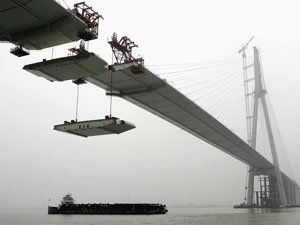 Emerging-market infrastructure shines - Growing middle class in developing
countries drives demand for transport, telecoms
Emerging-market infrastructure shines - Growing middle class in developing
countries drives demand for transport, telecoms
Emerging-market growth has been a bright spot in a stalling global economy this
year, leaving investors salivating about potential investment opportunities in
the developing world. And perhaps no sector has received more attention than
infrastructure development. Powered by a large proportion of the world's
population and rapidly growing economies that translate to higher per capita
incomes, emerging markets are set to be reshaped by historic levels of
urbanisation and consumer demand.
"Now is the time when you should be looking to get a bit more surgical and not
just apply your money when you want to get an emerging-market exposure," said
Nick Thompson, head of non-flow-structured products at Macquarie. "But maybe one
should actually look at some of the sub-sectors within that, and infrastructure
is a star sector within emerging markets." This month, Macquarie Research
Equities introduced an index to track emerging-markets-based infrastructure
companies as a way of equipping investors with a tool to improve their
investments in this sector.
The index, called the Macquarie Emerging Markets Infrastructure and Development
Index, follows the 50 largest emerging-markets infrastructure companies and is
calculated by the FTSE Group. Nine of the companies are from Hong Kong and the
mainland, representing 18.94 per cent of the index as of March 26, according to
a Macquarie website. China Mobile (SEHK: 0941, announcements, news) is tied with
Mexico's America Movil, a telecoms giant, as the index's largest member.
The index highlights the emerging-markets-based infrastructure companies that
provide the materials needed for development, perform the construction, and
manage the finished logistical assets. And with a vast, rising middle class
throughout emerging markets - classified as "Generation A" by Macquarie - the
demand from these regions for telecommunications, roads, rail and electricity is
expected to be unparalleled.
"Once you've got this trend following through, it's more like a supertanker that
cannot be stopped and you must supply the essential services," Mr Thompson said.
Inflation has crept up throughout emerging markets this year, however,
threatening to put the brakes on the rapid economic expansion in these regions.
But there is little likelihood that "all of this could fall over tomorrow
because all of a sudden inflation is rising", said Stewart Ferns, an equity
strategist at Macquarie. "It's true it's a headwind, but this is a mega trend."
And with the world's largest population and an economy that has expanded by
double digits every year since 2003, the mainland is at the top of the list when
it comes to infrastructure development.
"The Chinese growth will continue to be driven by an infrastructure boom and
housing boom," said Dong Tao, Credit Suisse chief economist for non-Japan Asia.
Dr Tao added that the mainland's commitment to infrastructure is plain to see
from, for example, the extensive subway expansion in Shanghai and the massive
plans for bridges and roads in the rest of the country. But mainland
infrastructure stocks have not been immune from this year's equity-market rout.
China Communications Construction (SEHK: 1800), the world's largest builder of
ports, has slumped 28.61 per cent so far this year compared with the benchmark
Hang Seng Index's 18.77 per cent slide. China Railway Construction (SEHK: 1186)
has slid 8.5 per cent since its March trading debut. But with limited downside
in terms of fundamentals, investors may start to snap up these and other
infrastructure stocks, as they are approaching more reasonable valuations.
"In the long run, I'm still positive on this factor because I think after the
Olympic Games, China will expand its infrastructure to help its economy expand
further in the future," said Patrick Yiu Ho-yin, an associate director at CASH
Asset Management.
May 30 2008
Tribulations only serve to revitalize a
great nation
The Chinese nation was almost caught off-guard by the 8.0-magnitude earthquake
in Sichuan Province earlier this month. As a result, an estimated 80,000 people
perished in just a few minutes, and another 15 million lost their homes. For a
nation that has enjoyed three decades of economic boom in peace and stability --
man-made or natural disasters over the years sound too petty if compared -- the
sudden tragedy was just too much for every one to take. Still, in the abyss of
grief, the country moves into reconstruction of the quake-hit regions. It is
also high time for the nation to ponder why the loss could be so huge and what
should be done to prepare for the possibility of another of this kind awaiting
us in future?
In fact, natural disasters of this size have never been foreign for each
generation of Chinese, whose national terrestrial territory covers 9.6 million
square kilometers, let alone the fact that much of its land sits on a
quake-prone belt. Maybe, because the people have been longing for stability so
much and too cautious against arousing disturbance after many years of chaos and
disorder, there had been few such warnings before the quake that the worst of
Mother Nature could occur -- people were just inadequately prepared.
The nation should start from now to realize that its future should not be built
merely on GDP figures, but on its readiness toward off the worst odds of all
natural and human factors. Economists and other scholars have suggested disaster
prevention and relief be integrated into the national economic and social
development plan, and added into troop training and school courses so as to
minimize the damage once disaster occurs.
The quake also helped enhance people's awareness of the risks of natural
disasters, making officials and builders realize that projects should never be
done cursorily; otherwise they will face legal responsibility even if they
luckily escaped collapsed buildings they erected. The central leadership has
noticed the quality of structures falling in the quake, especially vulnerable
school buildings that killed hundreds and thousands of children who were having
classes at the time of the quake.
He Guoqiang, China's top anti-graft official and member of the Standing
Committee of the Political Bureau of the Chinese Communist Party Central
Committee, urged for an "upgraded quake-resistance standard" and "quality first"
in rebuilding quake-damaged schools when he visited the victims. Faced with
strong protests from parents and public queries, the Education Ministry and
local governments have promised to evaluate the construction quality of
collapsed school buildings and "severely punish those responsible if problems
were found."
LESSONS LEARNED - With tens of thousands of
lives lost, the quake proved too dear a cost for the Chinese people. But if
there is anything the Chinese could gain from it, it's the bountiful lessons
both the government and the people have learned and the experiences they have
had. Fourteen minutes after the quake struck, the military sent out the first
rescue team; within two hours Premier Wen Jiabao was on a plane to the
epicenter. The relief headquarter was set up in the same evening in Dujiangyan,
one of the worst-hit cities in Sichuan.
Meanwhile, Chinese media rolled out around-the-clock and nearly-live coverage of
the disaster and the rescue work; the whole of society was mobilized. Chen
Guangbiao, a private business board chairman from the eastern Jiangsu Province,
heading a team of 120 people and 60 excavators, rushed to the quake areas after
an arduous 48-hour journey to help with the rescue work, side by side with the
military.
Military helicopters, field hospitals, satellite images, air-lifting and
air-dropping, scenes reminiscent of those seen only in Hollywood blockbusters,
now appeared in China's TV news reporting, showing in a way the effectiveness of
the country's national mobilization mechanism and also the economic and social
prowess it has gathered in the past 30 years.
Meanwhile, the Chinese people also saw on TV
that President Hu Jintao and Premier Wen braved aftershocks to direct relief
work and console victims in the quake areas; military troops scrambled to rescue
lives in the debris at any cost. "Saving lives is the top priority," that's what
the government said and most importantly, what it did. Many Chinese, including
quake survivors, said they were "proud of the government" when speaking to
foreign and domestic reporters.
Sharing the public sentiment, a young man surnamed Yuan from Ya'an, one of the
worst-hit cities, said he was "moved by and proud of" his city government, which
not only tried hard to rescuelocals, but managed to help other quake areas
without any sign of red tape and local protectionism which used to be common.
After the quake, the Chinese government fulfilled with actions its pledge of
"putting people first," something it had advocated so hard, and beefed up the
governing ideology of openness and transparency. Officials saw this time the
surging of a civil society, found the norm of their actions and the value of
their very existence. The general public also found the traditional values shine
again, such as courage, resolution, reason and sympathy, which had once paled in
people's mind when they were in pursuit of economic benefits.
China's spoiled younger generation, called the "post-1980s," grew up almost
overnight after the quake, becoming a major force of the volunteers in the
rescue and relief work. A young man in Chengdu wrote to a magazine: "Before this
incident, I had no confidence in humanity at all. Now, I found they are still
there, and very strong in everybody's mind. The Chinese nation has a strong
cohesive power."
LAW TESTIFIED BY HISTORY - President Hu may be a mild-speaking person in many
people's eyes, but he was seen on TV yelling out to a group of relief soldiers
that "No hardship will daunt the heroic Chinese people!" Premier Wen also wrote
on a blackboard in a quake-hit school that "Trials and tribulations only serve
to revitalize a great nation." They are not merely words of encouragement, but
also a law testified by history time and again.
Starting from the Opium War in 1840, China's modern history was virtually one of
foreign invasions and famine. The Chinese, including rival warlords,
consolidated their ground and drove invaders away in the end. After New China
was founded in 1949, the Chinese people, who had undergone a century of
humiliation, cherished their independence and territorial integrity so much that
they were always ready to safeguard them at any cost, including giving their
lives.
Some 20 years later, havoc was again wreaked on their lives by a human disaster,
the 10-year Cultural Revolution (1966-1976), which brought their country onto
the verge of a breakdown. But it was also the retrogress and chaos that prompted
the Chinese to work harder in the next three decades to build their nation into
the world's fourth largest economy. The rise of a great nation has never been
smooth. However, the gains and losses from every disaster it experienced and
every mistake it made, will all be cauterized into the nation's historic memory
and to nourish it into further growth.
The Sichuan earthquake, this time, given its great loss and vast social impact,
will not only serve as a turning point on how the Chinese will build their
infrastructure, but also on how they see themselves and how to run the country.
May 19, 2008
"Polluting Enterprises" Required to
Disclose Environmental Information
The Measures for the Disclosure of Environmental Information (for Trial
Implementation) took effect on 1 May 2008. The new rules require environmental
protection departments and polluting enterprises to disclose important
environmental information and provide a platform for public participation in
fighting pollution.
The measures make clear the parties responsible for and the scope of disclosure.
Environmental protection departments at all levels are required to disclose 17
types of government environmental information, including environmental
protection laws, regulations, policies, standards, administrative permission,
and administrative examination and approval. Enterprises that discharge
pollutants in levels that exceed the stipulated standards are required to
disclose four major types of environmental information and may not refuse
disclosure on grounds of keeping commercial secrets. Polluting enterprises in
general are encouraged to disclosure environmental information voluntarily.
Environmental protection departments must disclose government environmental
information in an easily accessible manner within 20 working days from the date
the information first becomes available or is modified, and reply to public
enquiries within 15 working days. Enterprises required to disclose environmental
information should publish information on emissions of major pollutants in
leading local media within 30 days of the publication of the enterprise list by
the environmental protection department.
The new measures also call for the establishment of performance evaluation,
public appraisal and accountability systems for the disclosure of government
environmental information. Environmental protection departments will be called
to account and enterprises will be fined for failing to disclose environmental
information. Members of the public may apply for administrative review or file
an administrative lawsuit if they believe that a specific administrative action
of an environmental protection department has infringed upon their legitimate
interests in its disclosure of government environmental information.
Recognized High-Tech Enterprises Enjoy 15%
Income Tax Rate
The Ministry of Science and Technology, Ministry of Finance and State
Administration of Taxation jointly issued the Administrative Measures for the
Recognition of New and High-Tech Enterprises on 14 April 2008, setting out tax
concessions for new and high-tech enterprises under the Enterprise Income Tax
Law which went into force on 1 January 2008.
To encourage the development of high-tech industries, ¡§high-tech enterprises
requiring special support from the state" are eligible for a reduced tax rate of
15% while the law stipulates a unified rate of 25%. The Administrative Measures
for the Recognition of New and High-Tech Enterprises set the standards for the
recognition of new and high-tech enterprises, underlining a shift from
region-based to industry-based policy.
The measures stress that new and high-tech enterprises should make sustained
efforts to engage in R&D and commercialization of technological achievements,
achieve core proprietary intellectual property rights and develop independent
innovation capability in high-tech areas enjoying special support from the
state. In future, only enterprises bearing the characteristics of new and
high-tech industries and meeting the stipulated criteria will be recognized as
new and high-tech enterprises.
Recognised new and high-tech enterprises are eligible for preferential tax
policies offered by the state both within and outside high-tech development
zones. Geographical boundaries are eliminated and new and high-tech enterprises
nationwide are certified in a unified manner and eligible for tax concessions
offered by the state.
Areas eligible for special support from the state include:
Electronic information technology
Biotechnology and new pharmaceuticals technology
Aeronautic and aerospace technology
New materials technology
High-tech services
Guangdong Issues Guideline for "On-Site
Transformation" of Processing Trade Enterprises
The Hong Kong Special Administrative Region Government's Economic and Trade
Office in Guangdong (GDETO) has learned that Guangdong Customs has implemented
the Customs Guideline for "On-Site Transformation" of Processing Trade
Enterprises (Trial Implementation) to facilitate the "on-site transformation" of
processing trade enterprises.
"On-site transformation" refers to the establishment of a foreign-invested
enterprise by an enterprise originally engaged in processing with supplied
materials commissioned by a foreign company. The new FIE is to be established on
the existing processing site of the enterprise to continue to carry out
processing trade business. Such establishment is necessitated by the change in
business mode of the foreign company. The guideline sets out procedures for the
customs registration of "on-site transformation" of processing trade
enterprises, including handling of non-priced equipment and bonded materials,
transfer of equipment, and formalities for advance lifting of customs
supervision on the equipment.
For details of the guideline in Chinese, please visit GDETO's website at
http://www.gdeto.gov.hk/chi/letter/docs/080418.doc.
May 1, 2008
Guangdong Issues Guideline for "On-Site
Transformation" of Processing Trade Enterprises
The Hong Kong Special Administrative Region Government's Economic and Trade
Office in Guangdong (GDETO) has learned that Guangdong Customs has implemented
the Customs Guideline for "On-Site Transformation" of Processing Trade
Enterprises (Trial Implementation) to facilitate the "on-site transformation" of
processing trade enterprises.
"On-site transformation" refers to the establishment of a foreign-invested
enterprise by an enterprise originally engaged in processing with supplied
materials commissioned by a foreign company. The new FIE is to be established on
the existing processing site of the enterprise to continue to carry out
processing trade business. Such establishment is necessitated by the change in
business mode of the foreign company. The guideline sets out procedures for the
customs registration of "on-site transformation" of processing trade
enterprises, including handling of non-priced equipment and bonded materials,
transfer of equipment, and formalities for advance lifting of customs
supervision on the equipment.
For details of the guideline in Chinese, please visit GDETO's website at
http://www.gdeto.gov.hk/chi/letter/docs/080418.doc.
April 13, 2008
 A call
for celebration By Joan Chen A call
for celebration By Joan Chen
I was born in Shanghai in 1961 and grew up during the Cultural Revolution.
During my childhood, I saw my family lose our house. My grandfather, who studied
medicine in England, committed suicide after he was wrongly accused of being a
counterrevolutionary and a foreign spy.
Those were the worst of times.
Since the Cultural Revolution ended in the late 1970s, however, I have witnessed
unimaginable progress in China. Changes that few ever thought possible have
occurred in a single generation. A communist government that had no ties to the
West has evolved into a more open government eager to join the international
community.
A state-controlled economy has morphed into a market economy, greatly raising
people's standard of living. It's clear that the majority of the Chinese people
enjoy much fuller, more abundant lives today than 30 years ago. Though much
remains to be done, the Chinese government has made rapid progress in opening up
and trying to be part of the international community.
Last month I went to China and spent four weeks visiting Shanghai, Beijing, Hong
Kong and Chengdu. The people I met and spoke with are proud and excited about
the Beijing Games. They believe that the Olympics are a wonderful opportunity to
showcase modern China to the rest of the world. Like many Americans, most
Chinese people are disturbed by the recent events in Tibet. But after watching
the scenes of violence and arson by the rioters, some believe that the
government is doing the right thing in cracking down to restore order.
The Olympic torch just passed through California. In a resolution criticizing
China, Chris Daly, a member of the San Francisco Board of Supervisors, said that
demonstrating against the torch relay would "provide the people of San Francisco
with a lifetime opportunity to help 1.3 billion Chinese people gain more freedom
and rights." To his credit, Mayor Gavin Newsom did not sign Daly's resolution.
This statement could not be further from reality. For one thing, the Chinese are
a proud people. They want freedom and greater rights, but they know they must
fight for them from within. They know that no one can grant them freedom and
rights from afar. The stigma of Western imperialism and the Opium Wars also
remains a strong reminder of the past, and Chinese people do not want their
domestic policies to be dictated by outside powers. They also do not want the
United States to boycott the opening ceremonies of the Games. The U.S. boycott
of the 1980 Games in Moscow and the Soviet boycott of the 1984 Olympics in Los
Angeles accomplished nothing. A U.S. boycott of the opening ceremonies in
Beijing would be counterproductive for relations between the two countries.
For decades, anti-China human rights groups in Washington have spent millions of
dollars denouncing China. To many Chinese, it seems that this lobby is the only
voice that's acceptable or newsworthy in the U.S. media and to the U.S.
government. But times are changing. We need to be open-minded and farsighted. We
need to make more friends than enemies. Remember what a little ping-pong game
did for Sino-U.S. relations in the 1970s? Let's celebrate the Olympics for what
the Games are meant to be — a bridge for friendship, not a playground for
politics.
Joan Chen is an actress and director. She became a U.S. citizen in 1989. She
wrote this commentary for The Washington Post.
April 12, 2008
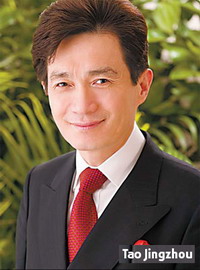 Settling matters through arbitration
Settling matters through arbitration
When it comes to disputes, many Chinese enterprises first think of litigation.
But legal experts suggest arbitration is also an effective and efficient method
to resolve differences. At a recent seminar on international arbitration, local
enterprises were encouraged to make good use of arbitration. The seminar was
jointly organized by the Beijing Arbitration Commission, China International
Economic and Trade Arbitration Commission and Jones Day International Law Firm.
Over 100 participants including senior experts from Chinese and foreign
arbitration institutions, scholars, legal counsel and representatives from
renowned Chinese and foreign enterprises, attended the seminar. As China's
economy continues to grow, there is greater interaction between Chinese and
foreign enterprises and the number and scale of disputes, such as intellectual
property rights, trade and human resources, is likely to grow.
Tao Jingzhou, a partner at Jones Day Beijing office, says arbitration is being
used more widely by the international community as an important tool to resolve
disputes arising from international economic and trade activities. This is
because of the many advantages arbitration brings. These include simple
procedure, high degree of autonomy, easy enforcement, confidentiality, and the
increasing number of professional arbitrators.
Tao says arbitration amounts to nothing more than a private forum, chosen by the
parties, with a decision and award granted by an arbitrator, applying the
procedural rules chosen by the parties. The main advantage of arbitration is the
time factor, Tao says. If properly planned, an arbitration procedure can take
place within a few months, particularly if the parties choose to designate a
fast-track procedure to deal with certain type of disputes.
The parties also have an opportunity to choose their own arbitrator, and
accordingly, may decide to utilize the services of an expert with knowledge of
their particular dispute, rather than a legal expert with little knowledge of
the practical issues in dispute. The parties may even decide to be represented
by experts rather than by legal representatives.
Tao adds confidentiality is also a big advantage.
April 9, 2008
Protesters' behavior sullies their message
- SCMP
The behavior of protesters who have tried to sabotage the Olympic Games
torch relay can only be condemned. Whatever point they were trying to make has
been lost by the reckless and violent manner in which they have disrupted an
event that is about unity and peace.
Democracies provide a plethora of avenues to voice concerns such as those over
Tibet and human rights in China. Hijacking the symbolic start to the world's
foremost sporting occasion is not a valid route. To do so, as happened in Paris
yesterday and London the day before, is, as Beijing Olympic organising committee
member Sun Weide so correctly observed, "disgusting". Those using the occasion
to take China to task must bear firmly in mind that there is a time and place to
make their voice heard.
Demonstrators in Paris and London purposefully ruined the relay by trying to put
the flame out. How this achieves their goal of highlighting alleged human rights
abuses on the mainland is a mystery. The athletes who so proudly represented
their nation as torch-bearers had their moment of glory robbed. Onlooking crowds
who had come to revel in the Olympic spirit similarly lost out. Far from being
the display of free speech that some observers contended them to be, the actions
of Tibetan activists were, instead, a show of the loutish side of the protest
movement.
The consequence was clear as the flame passed through Paris yesterday: the
torch-bearers were kept far from crowds who had turned out to see them by a
cordon of 65 motorcycle police, 100 firemen, 100 police on in-line skates and
nearly 50 vehicles with more than 200 riot police. It would be a shame if such
security became a feature of the relay as it passes in coming days through San
Francisco, New Delhi and other cities where activists have promised protests.
But Paris also showed how protesters can get their message across peacefully.
Athletes involved were wearing buttons reading, "For a better world", while the
city hall was draped with a banner supporting human rights. These may be low-key
ways of pointing out China's deficiencies when it comes to the grievances of
activists, but they still let Beijing know of their concerns in no uncertain
terms.
Demonstrators have the right to make their point, but they must not do so
through disrupting official events, with media-grabbing stunts or boycotts. If
there are to be demonstrations, they must be peaceful and orderly and staged in
an appropriate manner. Police have every right to take firm action against those
who deliberately attempt to disrupt the torch relay.
China is showcasing its developments through staging the Olympics; they are, in
effect, the nation's coming out party. But the Games themselves are grounded in
international togetherness with the sports and the athletes involved firmly at
the centre. Politics have no part in this. To use the occasion to push an
agenda, as Tibetan activists have so far done with the torch relay, is to
denigrate the event and those taking part. Mixing politics with sports is not in
the spirit of the Games.
Multi-entry visa ban until after Games -
Hurdle to mainland trips for frequent travelers
Beijing has stopped issuing multiple-entry visas, risking major inconvenience to
foreigners who travel to the mainland regularly, especially on business. Hong
Kong travel agents say the ban will stay in place until after the Olympic Games.
Travelers are now restricted to single- or double-entry visas valid for 30 days.
Multiple-entry visas that have not expired are still valid.
Andrew Work, executive director of the Canadian Chamber of Commerce, said the
ban would create serious inconvenience for foreigners living and working in Hong
Kong. "This is a real hassle for foreign small- and medium-sized business owners
... it's bound to slow business down and we hope that normal access to the
mainland will be restored soon."
One travel agent who declined to be named said: "People have been asking to
renew their multiple-entry visas but no one can get more than a double-entry
visa. We were told this was because of the Olympics and that the ban would be
lifted in September after the Games had finished." Daryl Bending, of Concord
Travel, said even permanent Hong Kong residents who had previously been given
three-year multiple-entry visas were affected. "No one is being given more than
a double-entry visa. The reason given was the Olympics but there were
suggestions that after the Games things would return to normal," he said.
Agents said they were told of the move on March 27. Hong Kong-based China-visa
agency Forever Bright says on its website the ban will apply until October 17.
The Office of the Foreign Ministry Commissioner in Hong Kong was unavailable for
comment.
Mr Work said: "I found out at a chamber meeting for the chairs of all the
chambers in Hong Kong. It's headed by [Chief Secretary] Henry Tang Ying-yen. At
the end of the meeting someone mentioned the ban on multiple-entry visas. It
took us all by surprise. Even Henry Tang didn't know." A senior source from the
Hong Kong General Chamber of Commerce said: "We have got similar complaints and
this will hinder business activities."
A government spokesman said: "The Hong Kong General Chamber of Commerce recently
raised concern about new visa arrangements implemented by mainland authorities
and the administration is looking into the matter."
Travel agents also said the cost of single- and double-entry visas had risen.
The typical cost of a single-entry visa obtained through a travel agent for a
British passport holder is now HK$850 for a single-entry visa and HK$1,050 for a
double-entry one. At the end of last year, a six-month multiple-entry visa cost
HK$1,080.
Australians, Canadians and most Europeans can expect to pay HK$500 for a
single-entry visa and HK$600 for a double-entry one. Six-month multiple-entry
visas for these nationalities previously cost about HK$450.
The move has surprised Howard Young, the tourism sector legislator. "The ban
will create a lot of inconvenience. I hope it's only temporary," Mr Young said.
Visas are taking longer to process. Paul Porter, a lawyer and regular mainland
visitor, said he had been told a visa now takes four days.
April 1, 2008
 Who are they to judge? Western leaders are using Tibet to politicize the Beijing
Olympics with no regard to their own shortcomings By Michael
Chugani
Who are they to judge? Western leaders are using Tibet to politicize the Beijing
Olympics with no regard to their own shortcomings By Michael
Chugani
It was fine when nations united in condemning the brutality of China's 1989
Tiananmen crackdown. Subsequent global pressure rightfully shone a bright light
on Beijing's terrible human rights behavior. But what we are now seeing is not a
conscience-driven joining of nations to put China right again. What we are
seeing is a ganging up of western leaders to use the unrest in Tibet to
embarrass China in its proudest moment - the staging of the 2008 Olympics.
They are acting as if they are a cabal of crusading white knights whose moral
duty it is to define right and wrong for others. Britain's Prince Charles tells
the Tibetan freedom movement he won't attend the Olympics opening ceremony. The
president of the European Parliament, Hans-Gert Pottering, threatens a
European-Union-wide boycott of the ceremony if Beijing uses force to quell
rioting mobs in Lhasa. French President Nicolas Sarkozy says he, too, may not
go, to protest against Beijing's behavior.
The latest to join this circus was US President George W. Bush - the man who
ordered the occupation of Iraq. Reliant on Beijing to help advance other
American interests, such as reining in North Korea and Iran, Mr Bush says he'll
keep his promise to attend the Olympics, but has lectured the Chinese for
occupying Tibet.
Maybe it is a western fear of a rising China that explains this behavior, or
maybe it's moral outrage - something that western leaders are good at using
selectively - over China's heavy-handed presence in Tibet.
If it is moral outrage, how come we are seeing so little of it in the case of
Israeli heavy-handedness towards the Palestinians? If it is moral outrage, why
did Mr Sarkozy just visit Britain? Isn't the United Kingdom a co-occupier in
Iraq? If it is moral outrage, shouldn't Prince Charles boycott his own country's
staging of the London Olympics in 2012 to protest against the Iraq invasion
under false pretences?
But western leaders, when challenged on their hypocrisy, are always fond of
saying the issues are not alike - the Israeli-Palestinian issue is not the same
as the China-Tibet issue and the Iraq occupation is not the same as the Tibet
occupation. That's like saying it is OK for Israeli troops to use force on
innocent Palestinians but not for Chinese troops to use force on rioting
Tibetans, and it is all right to invade Iraq to rid it of non-existent weapons
of mass destruction but not to seize Tibet and claim it as part of China.
But, even if we accept that the issues are not the same, why then is the Beijing
Olympics the same as the Tibet issue? Why make attendance of the Olympics
ceremony dependent on China's handling of Tibet? One is a sporting event and the
other a long-festering political issue.
Yet we have showbiz celebrities such as Steven Spielberg, Richard Gere and Mia
Farrow linking the Olympics to everything from human rights and Tibet to China's
policy on Darfur. If there is fair play, when the time comes, they should be
calling for a similar boycott of the London Olympics to protest against
Britain's part in the invasion of Iraq, its refusal to give up its remaining
colonies and its silence over America's gulag at Guantanamo Bay. But don't hold
your breath.
China knew the eyes of the world would be on it when it won the right to stage
the 2008 Olympics.
Beijing saw the pride of hosting the Games as a good trade-off for promising
human rights improvements. It may or may not have foreseen the timely Tibet
uprising to embarrass it. But, in any case, shouldn't we trust China for now to
keep its promise to change its behaviour in return for the Olympics prize,
instead of pushing it into a corner and thereby risk turning it into a resentful
beast that sees the west as out to get it? In return for this trust, Beijing can
start by being more open in handling the unrest.
The Olympics belongs to the athletes. Let's keep it that way. Let China have its
day in the sun and, if it breaks its promise to change, there's plenty of time
to deal with that later.
March 26, 2008

 Move to "Go West" reaps encouraging
rewards - The country's "Go West" policy to develop the lagging western regions
is gaining ground, a United Nations report has shown.
Move to "Go West" reaps encouraging
rewards - The country's "Go West" policy to develop the lagging western regions
is gaining ground, a United Nations report has shown.
The heartening signs are largely from government efforts to improve trade and
investment, the UN Economic and Social Commission for Asia and the Pacific (ESCAP)
said in its latest annual survey of the region. The report highlighted trade,
specifically exports, of the western regions showing a more rapid rise than
those of the coastal regions, even though western regions started from lower
levels. "A particularly encouraging trend for China's neighbors is the
relatively rapid export growth seen in many western regions," the survey said.
"The government is encouraging this trend through extensive projects to improve
cross-border transportation."
The country's Xinjiang Uygur autonomous region, which shares borders with
Afghanistan, Kazakhstan, Kyrgyzstan, Mongolia, India, Pakistan, Russia and
Tajikistan, is being seen as China's gateway to Central Asia. The region's trade
with Central Asia has tripled since 2002, reaching a record $9 billion in 2006,
the report said. In the Guangxi Zhuang autonomous region, cross-border trade has
also grown with neighboring Vietnam, rising by close to 50 percent in 2006 to
$1.8 billion. Similarly, Yunnan province's trade links have reportedly expanded
with Laos, Myanmar and Vietnam, while Mongolia and Russia have reported rapid
increases in trade with the Inner Mongolia autonomous region.
The "Go West" policy, started in 1999, is aimed at narrowing per capita gross
domestic product (GDP) income disparities, currently considered among the
highest in the world, the ESCAP reported. Priorities of the western development
strategy include infrastructure construction, environmental protection,
industrial upgrading, human capital accumulation, and science and technology
research. The report added that growth in the western regions was also supported
by greater foreign direct investment and backed by research and development.
"Foreign direct investment, a focus of the 'Go West' policy, increased
substantially in a quarter of the western provinces," the survey added. he ESCAP
said that growth was reported for Tibet, Qinghai, Gansu, Xinjiang, Ningxia,
Guangxi, Chongqing and Yunnan, along with a recent rapid increase in foreign
direct investment in Sichuan, Inner Mongolia and Shaanxi. Research and
development spending also reportedly grew more rapidly in four of the 12 western
regions - Ningxia Hui, Tibet, Inner Mongolia and Xinjiang Uygur - than most
coastal provinces.
These, the ESCAP said, helped final consumption increase more "in a quarter of
the western provinces than in the majority of coastal provinces".
The country will see a moderate slowdown in growth this year, but remained
underpinned by strong domestic demand and government social spending despite a
slowing United States economy, the ESCAP also reported. The report expected an
easing in growth to 10.7 percent from 11.4 percent in 2007 - the fastest for
China in 13 years - as a result of a slowdown in exports and government measures
to cool growth. "Investment continues to be the main driver of growth, remaining
resilient despite government cooling measures and with support from low real
interest rates," the ESCAP said. "A slowdown in exports and the government's
measures to cool the economy are the main reasons for the moderation," the
survey said.
The ESCAP also downplayed any significant impact on China's economy resulting
from a downturn in the US economy due to the ongoing subprime credit crisis. "In
a worse-case scenario - where the United States economy goes into a recession -
the impact on China will not be as great as on other Asia-Pacific countries," it
reported.
In terms of China's overall trade, the country witnessed increasing exports to
the European Union last year, a shift which compensated for a steady fall in
exports to the US - China's second-largest export market, the report said. The
country also witnessed a boom in trade with Africa.
Growth also came in service exports, which rose globally by an average of 16
percent over 1995-2006. "China had the best performance in transport services
exports of all Asia-Pacific countries, growing at 34 percent per year over
2000-2006," the ESCAP reported. However, the country is facing an increasing
challenge from inflation.
Last year, inflation rose dramatically to 4.8 per cent - the highest in a
decade, and three times the 1.5 percent reported in 2006. Higher international
oil and food prices were identified as chief inflationary concerns. "Rising food
prices are a bigger inflationary concern than oil prices because food accounts
for a far higher proportion of consumer spending. Food price inflation
particularly hits low-income households," the ESCAP said in the survey.
The country's fast-paced growth was coming at an increasing cost to the
environment, while the loss of arable land to manufacturing also raises
concerns, the ESCAP warned. "The destabilizing effect of growth on the
environment is becoming more apparent. Air pollution, especially in large
cities, is increasing the incidence of lung disease," it said.
March 18, 2008
Chinese Customs to Implement New
Enterprise Categorization System from 1 April
According to China's General Administration of Customs (GAC), as from 1 April
2008, a new enterprise categorisation system will be implemented under which
consignors and consignees of imports and exports as well as customs agents are
classified into five categories, namely AA, A, B, C and D. Category AA and A
enterprises will be eligible for express customs clearance procedures; category
B will be subject to regular measures; while category C and D enterprises will
be put under strict surveillance. Enterprises meeting the respective criteria
may file their applications with the local customs authorities via the customs
office at the place where they are registered.
For details of the new enterprise categorization system in Chinese, please
visit:
http://www.customs.gov.cn/YWStaticPage/433/4c0797e5.htm
March 8, 2008
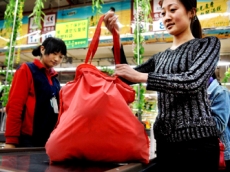
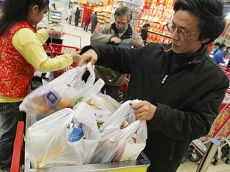 Environmentally-friendly bags to
generate sales - "Bring your own" more common. Environmentally-friendly bags to
generate sales - "Bring your own" more common.
The "plastic bag ban" issued by the State Council calls on the whole of China to
stop producing, selling and using ultra-thin plastic shopping bags after 1 June
2008. Supermarkets, shopping centres, commodities markets and other retail
venues won't be allowed to give away free plastic bags and shoppers will have to
pay for plastic bags if they don't have their own.
While plastic shopping bags are conceived as consumable items, they're also
increasingly seen as a source of pollution on the Mainland. The excessive use
and improper disposal of these bags have resulted in a waste of resources and
environmental damage, authorities conclude.
Yet, there's no denying that supermarkets, shopping centres, commodities markets
and other retail venues rely heavily on plastic shopping bags. A medium-sized
supermarket uses tens of thousands of these bags each day on fruit and
vegetables alone.
In compliance with the government's "plastic bag ban", some supermarkets have
started cutting down on plastic bag consumption and promoting the use of
eco-friendly bags.
Prompted by publicity and guidance, some businesses have already started to take
advantage of the ban. Many shopping centres are offering eco-friendly shopping
bags as gifts with purchases. It turns out that consumers love these eco bags -
and stores have improved their reputation while promoting sales.
Some manufacturers are taking the opportunity to market "handy" shopping bags
that are durable, foldable and easy-to-clean. These bags come in various sizes
and colours, and also have novel and unique designs. Most are made of non-woven
fabrics, paper and new biodegradable materials.
Furthermore, consumers are willing to use environment-friendly shopping bags
that can reflect their age, status and taste.
These small shopping bags could constitute a huge potential market. Hong Kong
enterprises that have a leading edge in innovative design and marketing in the
packaging industry could be looking at plenty of opportunities.
87 Korean Firms Quit Qingdao Without
Paying Workers
In 2007, a total of 87 South Korean firms fled Qingdao. The illegal pullout
started in the second half of 2007 and the exodus led to a credit crisis for
Korean investment in China. This fly-by-night phenomenon is particularly common
in Qingdao, a city with a high concentration of South Korean businesses.
The Chinese and Korean authorities have opened all channels of negotiation to
help Korean firms leave China legally. A team from South Korea's Ministry of
Commerce, Industry and Energy has been dispatched to Qingdao to look into the
matter in the hope of repairing the tarnished image of Korean investment in
China. Chengyang is a district in Qingdao most affected by the illegal pullouts
and it accounts for 67.5% of the fleeing firms. According to Qingdao's foreign
trade and economic cooperation bureau, most of the companies affected are small
operations with an investment of US$300,000-500,000 and employing around 50
workers.
Shandong used to be a paradise for Korean investors due to geographical
proximity. According to China's Ministry of Commerce, there are about 46,000
South Korean firms in the whole of China, with about one third located in
Shandong, including 4,000 in Qingdao. There are over 100,000 South Koreans
living in Qingdao. In light of the importance of Qingdao to Korean firms, the
SME department under South Korea's Ministry of Commerce, Industry and Energy has
set up a representative office in Qingdao, while the city's foreign trade and
economic cooperation bureau also has a Korean section.
According to figures published by the representative office of the SME
department under Korea's Ministry of Commerce, Industry and Energy, 206 Korean
enterprises quit Qingdao without going through proper liquidation procedures
between 2001 and 2007. The number amounted to 87 in 2007 alone. These figures do
not include those in Jiaozhou and Yantai, which are by no means few in number.
Among these Korean firms that exit without proper liquidation, 15% were textile
enterprises and 30% were arts and crafts enterprises, with over 60% of them
being labour-intensive operations.
Super Luxury Hotel to Greet Shanghai World Expo
The management of Dubai's prestigious Burj Al Arab will be managing a
twin-block super-deluxe hotel in Shanghai's Xintiandi in a bid to offer better
supporting facilities to the Shanghai World Expo. Luwan district in Shanghai
took the lead in mapping out and kicking off 12 three-year action plans to
provide an additional 1.5 million sqm of commercial/office space and "luxury
accommodation" for the World Expo.
According to Li Zheng, director of the Luwan district government's research
office, Luwan will strive to upgrade its supporting facilities for the World
Expo by focusing on the construction of modern services clusters and the
improvement of urban living. The building of a super-five-star hotel forms an
important part of this endeavor.
The 27-storey 338-room twin-block hotel, initially named Hantang Hotel, sits on
sections 107 and 108 of Xintiandi. It is already at the interior decoration
stage, with official opening slated for summer 2008. A joint venture between
Shanghai Hotel Investments Ltd and the Shui On Group, the new hotel will be
managed by the world famous Dubai-based Jumeirah Group, which manages many world
renowned properties, including the super-deluxe Burj Al Arab in Dubai.
Luwan will have an additional 1.5 million sqm of commercial/office floor space
by 2010. Forty-two commercial restructuring projects are now underway on Huaihai
Road Central. Seven side streets on Huaihai Road will also undergo
transformation to form the Maoming South Road haute coutur street, Chengdu Road
modern lifestyle street, Yandang Road leisure activity pedestrian street, and
Madang Road classic taste street.
Foreign and Domestic Banks Actively Build QDII Brands
Since the launch of the qualified domestic institutional investor (QDII)
program on the mainland in 2006, various large foreign and domestic banks have
rushed to build their own brands and launch different types of QDII financial
products to meet the increasing demand for wealth management from mainlanders.
As of the end of October 2007, a total of 154 QDII bank products had been
launched by 16 foreign and domestic banks and the sales volume amounted to
Rmb35.196 billion and US$1.012 billion. Of these 154 products, 64 were offered
by 11 domestic banks capturing Rmb29.349 billion and US$0.317 billion in sales,
while 90 were sold by five foreign banks raising Rmb5.848 billion and US$0.695
billion.
Many of these QDII bank products have established a name in the market and have
built a brand in wealth management. The Industrial and Commercial Bank of China
launched the first wealth management product making offshore investment on
behalf of clients on the mainland and built the "Pearl of the Orient" brand.
Among this series, "Pearl of the Orient I" is the first QDII product investing
in offshore stock markets following the liberalization policy and
record-breaking sales have been attained. Other well-known investment product
brands established by domestic banks include "Huideyin" and "Haiyin I" of the
China Construction Bank, and "Delibao" and "Huijutong" of the Bank of
Communications. Investment products offered by foreign banks include "Dynamic
Return Investment" of the Standard Chartered Bank and "Jihuibao" of the Bank of
East Asia.
According to Li Fuan, director of the business innovation and supervision
department under the China Banking Regulatory Commission (CBRC), banks offering
offshore wealth management services are characterised by having a steady client
base, good reputation, extensive operation network, flexible and diversified
product designs, and rich product variety. The many offshore wealth management
products offered by them can meet the various demands of clients.
However, these products also have room for improvement. For instance, the sales
channels and coverage are limited, the marketing effort is not strong enough,
the brand advantage has yet to be formed, manpower support and backup system are
inadequate, etc. Also, policy constraints such as restrictions on investment
types, proportion and minimum amount have stifled the growth of QDII products.
With respect to the demand for wealth management, the vigorous boom in the
capital market in the last two years has greatly boosted the demand of mainland
investors for wealth management. The wealth effect of the stock market has also
caused saving deposits to flow in its direction. According to the statistics of
the People's Bank of China, in October 2007 the level of savings of mainlanders
dropped Rmb506.2 billion, the greatest drop ever in a single month. At the same
time, the trend of mainlanders terminating their insurance policies and
diverting the money to the stock market was obvious. The number of people
investing in securities and fund has continued to rise.
To meet the increasing demand for wealth management, CBRC will continue to
strengthen its support for commercial banks in providing offshore wealth
management services. Efforts will be made to create the conditions for further
liberalizing the investment market, allowing investors to participate more in
the international capital market. CBRC is also planning to extend the scope of
offshore stock market beyond Hong Kong to include other mature stock markets so
as to achieve a rational global distribution of assets for diversification of
risks.
According to Li, CBRC will conduct studies on the QDII business of commercial
banks, collecting information on the banks' development strategies, product
designs and marketing plans in relation to their QDII business. Meanwhile, CBRC
will call on the commercial banks to strengthen their ability in risk and
investment management, and will also continue with its efforts in enhancing
investors' investment experience and risk awareness so as to safeguard their
interests.
It can be expected that the demand for offshore wealth management of mainlanders
and the support of the central government will bring enormous business
opportunities for Hong Kong's professional service sectors such as financial
services, financial accounting, legal services and marketing.
Amid the increasing demand of mainlanders for wealth management, foreign and
domestic banks engaged in QDII business on the mainland have offered a large
variety of financial products but none of them have emerged as the leading
brand. Hong Kong financial institutions, with their rich experience in designing
and marketing financial products, coupled with the fact that Hong Kong is the
first stop of the mainland's QDII offshore wealth management business, have
first-mover advantage in formulating relevant marketing strategies and
developing QDII brands.
QDII can also drive the development of Hong Kong's marketing, accounting and
legal services sectors which can provide professional services for QDII business
such as market consultation, financial and legal services.
As China's QDII business is going to extend to international capital markets
beyond Hong Kong, Hong Kong's financial and other professional services sectors
stand to benefit by assisting the mainland to "go global" via Hong Kong.
March 5, 2008
Super Luxury Hotel to Greet Shanghai World
Expo
The management of Dubai's prestigious Burj Al Arab will be managing a twin-block
super-deluxe hotel in Shanghai's Xintiandi in a bid to offer better supporting
facilities to the Shanghai World Expo. Luwan district in Shanghai took the lead
in mapping out and kicking off 12 three-year action plans to provide an
additional 1.5 million sqm of commercial/office space and "luxury accommodation"
for the World Expo.
According to Li Zheng, director of the Luwan district government's research
office, Luwan will strive to upgrade its supporting facilities for the World
Expo by focusing on the construction of modern services clusters and the
improvement of urban living. The building of a super-five-star hotel forms an
important part of this endeavour.
The 27-storey 338-room twin-block hotel, initially named Hantang Hotel, sits on
sections 107 and 108 of Xintiandi. It is already at the interior decoration
stage, with official opening slated for summer 2008. A joint venture between
Shanghai Hotel Investments Ltd and the Shui On Group, the new hotel will be
managed by the world famous Dubai-based Jumeirah Group, which manages many world
renowned properties, including the super-deluxe Burj Al Arab in Dubai.
Luwan will have an additional 1.5 million sqm of commercial/office floor space
by 2010. Forty-two commercial restructuring projects are now underway on Huaihai
Road Central. Seven side streets on Huaihai Road will also undergo
transformation to form the Maoming South Road haute coutur street, Chengdu Road
modern lifestyle street, Yandang Road leisure activity pedestrian street, and
Madang Road classic taste street.
February 22, 2008
China's new individual tax threshold to go
into effect March 1
China's amended individual income tax law, which raises the tax levy
threshold from 1,600 yuan (about 220 U.S. dollars) a month to 2,000 yuan, will
go into effect on March 1, accompanied by some regulations on its
implementation. Individuals who earn money from contractual operations and
contract to lease businesses will also enjoy a raised tax threshold from 1,600
yuan to 2,000 yuan, according to the regulations.
This was out of consideration that the living costs of those individuals and
their family members had increased, said a joint explanation on the regulations
made by the Legislative Affairs Office of the State Council, Ministry of Finance
and the State Administration of Taxation.
Individual tax payers who have housing in China but work overseas, or live
overseas but earn income in China, will keep their tax threshold of 4,800 yuan a
month unchanged, according to the regulations. This will help reduce the gap
between tax thresholds of different taxpayers, the joint explanation said.
The raised individual tax threshold will reduce government revenues by 30
billion yuan annually, according to official statistics. It will also mean that
70 percent of income earners will be exempt from income tax, against 50 percent
now. The individual income tax cutoff point was raised from 800 yuan a month to
1,600 yuan starting in 2006. This was based on consumption expenditures for
basic living costs at the time.
However, the consumer price index rose several times last year, further
burdening low- and medium-income earners.
February 21, 2008
Guangzhou Likely to Raise Minimum Monthly
Wage to Rmb860
The labor and social security bureau of Guangzhou recently issued a notice
announcing that retrospective from 1 January 2008, with the exception of Huadu,
Panyu, Conghua and Zengcheng, monthly unemployment insurance compensation and
medical subsidies for the unemployed in Guangzhou have been raised to Rmb688 and
Rmb860 respectively. This adjustment has brought the total of the two benefits
to Rmb774/month, an increase of Rmb72. Back pay will date back to 1 January
2008.
The latest adjustment heralds even better news for the employed in Guangzhou ¡V
minimum monthly wage would be raised to Rmb860/month. According to regulations,
standard unemployment insurance compensation usually equals to 80% of local
minimum wage. Hence, the adjustment suggests that minimum monthly wage in
Guangzhou should be raised to Rmb860. According to news report, the new standard
of monthly wage would be effective from 1 April 2008.
It is understood that the labor and social security department of Guangdong has
established a system of making minimum wage adjustments once every two years.
Early this year, it was planned that the minimum wage across the province would
be raised by 12.9% on average on the basis of the 17.8% average increase in the
year before last. If Guangzhou is to raise its current minimum wage of
Rmb780/month to Rmb860/month, the increase falls within the provincial average.
New Rules on Environment and Livelihood
Take Effect in February
The Administrative Measures for the Prevention and Control of Environmental
Pollution by Electronic Waste, Measures for the Administration of Residential
Housing Maintenance Funds and other new regulations took effect on 1 February
2008.
Under the Administrative Measures for the Prevention and Control of
Environmental Pollution by Electronic Waste, units engaged in electronic waste
dismantling must make environmental impact assessment and build pollution
prevention and control facilities in accordance with law. Environmental
protection departments at county level and above must compile and publish a list
of units and individuals engaged in the dismantling of electronic wastes. Any
individuals and units (including individually-owned businesses) not on the list
(including provisional list) are prohibited from engaging in the dismantling,
utilisation and disposal of electronic wastes. The measures also ban the burning
of electronic wastes in the open or the disposal of such wastes by direct
dumping.
According to the Measures for the Administration of Residential Housing
Maintenance Funds, owners of residential and non-residential commodity housing
must make contributions to the maintenance fund based on the floor area owned.
The first installment of such contribution amounts to 5%-8% of the local
construction cost for each sqm owned. Misappropriation of maintenance fund is
punishable by confiscation of illegal proceeds and a fine up to 200% of the
amount misappropriated. Property management enterprises which misappropriate the
maintenance fund may have their business licence revoked if the circumstances of
the offence are serious.
Under the Measures for Land Registration promulgated by the Ministry of Land and
Resources, any transfer of land that is not registered has no legal effect even
if the transfer is made in accordance with law. However, inheritance and gift of
land have legal effect even if the land is not registered, but the land must be
registered when it is further transferred.
February 12, 2008
China Customs Relaxes Control on
Outsourcing Activities of Processing Trade Enterprises
To keep up with the changes in the development of the processing trade, the
General Administration of Customs (GAC) has decided to amend the Measures of the
Customs of the People's Republic of China Regulating Cargoes of Processing
Trade. Amendments include relaxing the restrictions on the contracting out of
processing activities by processing trade enterprises, allowing "operational
enterprises confined by their own production characteristics and conditions" to
commission contracting enterprises to process goods under processing trade for
them upon customs approval and completion of relevant procedures.
Formerly, only "processing trade enterprises confined by their own production
processes" were allowed to contract out such activities. Under the new measures,
processing trade enterprises can contract out their major production processes.
By so doing, processing trade enterprises can have their production processes
carried out in different factories, thereby solving production problems arising
from peak and low seasons and facilitating the relocation of their production
lines.
The amendments were examined and adopted by GAC on 4 January 2008 and
promulgated through Customs Decree No.168. The new measures will come into force
on 1 March 2008.
For details of the above decree in Chinese, please visit:
http://www.customs.gov.cn/YWStaticPage/433/c451612f.htm
February 5, 2008
Base for Overtime Pay Includes Fringe
Benefits and Bonus
According to the labor and wage department of the Guangdong Provincial Labour
and Social Security Office, the correct way of calculating overtime pay in
Guangdong is to take daily wage under normal working hours (8 hours) as the
base. The calculation formula is monthly wage under normal working hours divided
by 20.83, which is the number of working days a month.
The number of working days each month has been reduced from 20.92 to 20.83 when
the Regulations on Public Holidays for National Annual Festivals and Memorial
Days were amended, increasing the number of statutory holidays each year from 10
to 11.
According to the Regulations of Guangdong Province on Payment of Wages
promulgated by the provincial people's congress pursuant to the Labor Law and
other relevant laws, when an employing unit requires employees to work overtime
or extends their working hours, the workers should be paid overtime based on
their normal daily or hourly wage. The overtime pay should be 150% of daily or
hourly wage for working days, 200% of daily or hourly wage for rest days, and
300% of daily or hourly wage for statutory holidays.
As stipulated in the Regulations of Guangdong Province on Payment of Wages,
daily wage is monthly wage divided by the average number of working days each
month prescribed by the state, and hourly wage is daily wage divided by daily
working hours, which may not exceed eight hours.
The Guangdong Provincial Labor and Social Security Office also emphasised that
the base for calculating overtime pay is monthly wage divided by the average
number of working days each month (i.e. 20.83) based on an eight-hour working
day. For example, if an enterprise signs a labor contract with a worker offering
him a monthly package including Rmb1,500 in basic wage, Rmb200 in attendance
bonus and Rmb300 in other fringe benefits, it must take all three parts of the
package and not just the basic wage of Rmb1,500 as monthly wage under normal
working hours in the calculation of this employee's overtime pay. Benefits,
bonus and attendance bonus are also wage and remuneration for work done under
normal working hours and should therefore be included in the base for
calculation. In other words, the overtime paid to this worker should be Rmb2,000
divided by 20.83, and not Rmb1,500 divided by 20.83.
New Rules on Paid Annual Leave
The Regulations on Paid Annual Leave for Employees have finally gone into
effect. The following are some issues of particular concern to Hong Kong
businesses on the mainland. They are advised to have a good grasp of the
regulations as soon as possible to avoid getting into disputes with their
employees.
(1) How many days of leave is an employee entitled to have after working for six
years?
Some units originally offered employees "10 days annual leave after completing
five years of service". But under the new regulations, employees are entitled to
five days of annual leave after working accumulatively for 1-10 years, 10 days
of leave after working accumulatively for 10-20 years, and 15 days of leave
after working for over 20 years. Against this backdrop, how many days of leave
is an employee entitled to have after working for six years?
According to experts, the new paid annual leave regulations cover a wide
spectrum, and employees working in government departments, organisations,
enterprises, public institutions, private non-enterprise entities and
individually-owned businesses are protected by the regulations. The annual leave
mentioned in the regulations refers to a "minimum" standard. In other words,
units may not offer annual leave less than the standard prescribed in these
regulations.
Thus, an employee who has worked in a unit continuously for 1-5 years and does
not fit into the circumstances mentioned in Article 4 of the new regulations is
entitled to five days of paid annual leave provided that the leave regulations
of the unit have not changed. An employee who has worked for six years is still
entitled to 10 days of annual leave under the original leave regulations of the
unit. But if the unit's leave regulations are changed, the employee's leave
entitlement will have to follow the unit's new rules. Under the new regulations,
statutory national holidays and off days are not included in one¡¦s annual
leave. For employees who are entitled to winter and summer vacations according
to law, these will be deducted from their annual leave.
Enterprises are now busy coping with the new regulations. Units with an existing
level of annual leave higher than the new regulations said they would not cut
the days of annual leave for their staff. Other enterprises said that due to the
sudden increase in the number of people entitled to annual leave, they may treat
old and new employees differently, or "strike a balance" between the old and the
new to reduce the impact.
(2) How does "carried forward to the next year" work?
Under the new regulations, annual leave generally may not be carried forward to
the next year. But if any leave balance has to be carried forward to the next
year for production or work reasons, it may be only be carried forward for one
year.
According to experts, this has two levels of meaning. First, annual leave may be
taken in one go or several times within the current year. For example, an
employee may take a few days off in the first half of the year and take another
few days off in the second half of the year. However, one may not "overdraw" on
one's leave and take one's annual leave for next year, the year after next or
the years ahead. Second, a unit that needs to carry forward its employees'
annual leave to the next year may be required to seek approval from the
departments concerned. Detailed rules on this will be published at a later date.
The question of how the number of "years" is to be calculated, whether it is
calculated by calendar years or an employee's "actual years of service", will be
clarified in the implementation rules to be promulgated. As analysed by people
in the industry, the majority of work units may adopt the "actual years of
service" based on the nature of their business or make agreements in labour
contracts signed.
Some enterprises noted that after the promulgation of the new regulations there
are bound to be particular periods of time when more employees are inclined to
take their annual leave. They hope that employees would make applications in
advance according to the nature of their work so management can make
arrangements to prevent work from being affected.
(3) What are the standards for compensation and penalty?
In the case where a unit is unable to let its employees take annual leave for
work reasons, the unit should pay its employees compensation at 300% the daily
wage for each day of annual leave in addition to regular wage and fringe
benefits. As for the standards for daily wage, experts suggested using the same
method as for the calculation of base figures for overtime pay.
Some enterprises have misgivings about certain points of the new regulations.
For example, on the question of "the number of days of unclaimed annual leave",
given the lack of clarifications on "employees not taking their entitled annual
leave according to the arrangement of the employer", some enterprises are
worried that some employees may choose to "claim compensation instead of taking
leave", which is an abuse of the original intention of the legislation to
protect employees' rights. Instead of giving employees their much-needed rest,
this would increase the employer's payroll cost.
In the case where a unit does not give annual leave to its employees and does
not give compensation according to regulations, the personnel department or
labour security department of the local people's government at or above county
level will order it to make corrections within a given time limit. If it refuses
to do so, it will be penalised under relevant provisions of the Labour Law,
Labour Contract Law and Civil Servants Law. On the specific standards of
penalty, experts noted that in spite of calls for the enactment of paid annual
leave regulations in previous labour legislations, rules and standards of
penalty have never been clearly spelled out. A clear picture of the standards
for penalty would only be available after the promulgation of the implementation
rules.
No Age or Gender Limit in Recruitment Ads
Starting from 2008, recruitment ads may not include any limits on the age, sex
or education level of the applicants, or such practice will be considered
employment discrimination. Effective on 1 January, the Employment Promotion Law
creates a level playing field for equal opportunity in employment.
According to Wang Dexiu, deputy director of the Beijing labour and social
security bureau, the Employment Promotion Law stipulates clearly that all
employers and employment agencies must provide all applicants with equal
employment opportunity and employment conditions. Employment discrimination is
prohibited.
In recruitment ads, the right applicants can be sought by listing the type of
work, job nature and scope of suitable candidates under "Job Requirements". But
no age or sex limits must be imposed.
January 30, 2008
China to issue IPR strategy in 2008
After two and a half years of preparation, China plans to release its
national intellectual property rights (IPR) strategy this year, according to the
State Intellectual Property Office.
The strategy will have three stages: information, services and trade, said Tian
Lipu, head of the office, during a conference on Tuesday.
The strategy began to be mapped out in July, 2005. So far, China has drawn up 20
methods to protect IPR, including improving the protection system, strengthening
law enforcement and raising public awareness.
"The strategy is vital to fully implementing the power of the country's
intellectual property rights system and to promote the development of the
country's economy and science," Tian said.
Tian noted that in 2007, China saw significant progress in protecting IPR in
various areas, industries and companies.
Organizations for guiding the strategy were set up in 17 provinces, autonomous
regions and municipalities. Guangdong, Guizhou, Shandong and Shanghai
municipality have already issued their own strategies.
China will set up about 40 service centers for IPR protection. The centers will
provide consultations and financial support for those who can't afford to pursue
cases.
January 29, 2008
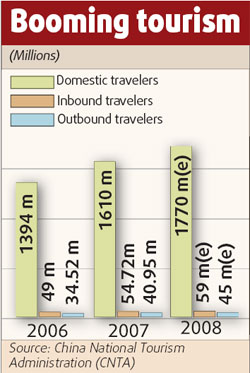 Outbound tourism sector to open
wider Outbound tourism sector to open
wider
The China National Tourism Administration will pilot a project this year to
select joint venture tour operators to handle some outbound business. It is the
first time that the administration has decided to open its outbound business to
joint ventures and foreign investors. Shao Qiwei, head of the administration,
told a conference in Beijing on Friday that it will "steadily promote" the pilot
project, and open the industry wider, but further details were not immediately
available.
Foreign tour agencies and joint ventures are currently allowed to operate only
inbound and domestic travel, and are barred from outbound business, which is the
most lucrative part of the market. Opening the outbound market is not part of
China's commitments to the World Trade Organization. But the opportunities
offered by outbound travel have attracted many foreign operators to China,
according to industry insiders.
In recent years, a few foreign tour firms attracted by China's huge potential
have entered the country as joint ventures or solely funded branches. They
insist on keeping their business in China, even though that means they earn
little or have to suffer losses.
Positive signs began to emerge last year, when the tourism administration
allowed Hong Kong and Macao-funded tour agencies to cater to mainland tourists
in eight provinces and regions bound for the two special administrative regions,
a decision that has not adversely affected domestic Hong Kong and Macao tour
operators.
"There is no need to worry that opening outbound business to foreign firms may
throw the market into disorder. Similar cases, such as allowing in foreign
banks, have proven this will not occur," an industry insider said.
China's tourism sector is believed to have huge potential, as the World Tourism
Organization forecast it would grow into the world's fourth-largest source of
outbound tourists by 2015. By then, 100 million Chinese will travel overseas
annually.
Last year, 40.95 million Chinese traveled overseas, up 18.6 percent from 2006.
The administration forecast that the number of outbound travelers is expected to
increase 10 percent to 45 million this year.
"As our holiday system is improving, China will develop into an enormous tourist
market. The outbound and domestic travel markets will both develop fast," Shao
said.
Chinese tourists' outbound travel destinations have expanded from 20 in 2002 to
the current 134 countries and regions.
The United States is the latest to open its door to China. The first
group of Chinese tourists are expected to make trips there this spring.
January 22, 2008
SAT Launches National Crackdown on
Production and Sale of Fake Invoices
This year, the State Administration of Taxation (SAT) and the Ministry of
Public Security will launch a joint nationwide crackdown on the production and
sale of fake invoices and the illegal issuance of invoices.
The unlawful act of invoice frauds has been moving towards specialization and
going online. In view of this, SAT is determined to tackle the problem by
combining crackdown with prevention.
First, efforts will be made to strengthen control at source and improve the
management mechanism. The local tax authorities will make a thorough inspection
of invoice printing factories, with special attention paid to the purchase,
storage and use of special anti-counterfeiting products and the security
measures for every step of invoice printing. Tax revenue sources will be closely
monitored, while strict management over the collection, purchase and use of
invoice by taxpayers will be enforced to ensure the proper use and flow of
invoices in a legal, standard and orderly manner. Policy incentives will also be
given to taxpayers for the use of tax-control cash registers to promote the
control and management of invoices and tax revenue sources.
Second, a centralized crackdown on the production and sale of fake invoices and
the illegal issuance of invoices will be waged. SAT will join hands with the
Ministry of Public Security to crack down on the production and sale of fake
invoices and the illegal issuance of invoices and to smash criminal dens and
syndicates.
Third, action will be taken to curb the "buyer's market" for the production and
sale of fake invoices and the illegal issuance of invoices. Efforts will be made
to strictly enforce the financial management system and take effective measures
to curb the demand and "market" for the production of fake invoices and the
illegal issuance of invoices. As a general practice, for all income received
from production and business activities, invoices must be issued according to
the relevant regulations. Enterprises and establishments which have obtained
invoices by illegal means or invoices not measuring up to requirements may not
use such invoices to claim cost deductions or as reimbursement vouchers.
Fourth, efforts will be made to improve the relevant laws and administrative
regulations as soon as possible and to increase penalties for invoice-related
violations.
SAT has already submitted the revised draft of the Measures for Invoice
Management to the State Council. It has also suggested to the legislature that
steps should be taken to revise and improve the relevant laws and regulations,
and to tighten the criminal and administrative penalties for such acts as the
buying, carrying, mailing, transporting and peddling of forged invoices and the
transmission of illegal invoice information. This could provide a sound legal
basis for the prevention and crackdown of this type of crimes.
January 17, 2008
China Bans Production and Sale of
Ultra-Thin Plastic Shopping Bags from 1 June
The General Office of the State Council has recently issued a circular on
restricting the production, sale and use of plastic shopping bags. Starting from
1 June 2008, the production, sale and use of plastic shopping bags with a
thickness of less than 0.025 mm (ultra-thin bags) will be banned nationwide.
Supermarkets, shopping malls, commodities markets and other retail venues will
not be allowed to provide free plastic bags and shoppers requiring these plastic
bags will have to pay for them.
The circular also calls on the State Administration of Quality Supervision,
Inspection and Quarantine (AQSIQ) to speed up its work of drawing up national
standards for plastic bags and establishing a product quality supervision
mechanism for plastic shopping bag manufacturers. Enterprises that produce
ultra-thin plastic bags illegally, do not affix (print) the quality
certification logo on the plastic bags they produce as required, or engage in
other illegal or irregular acts, will be ordered to cease production in
accordance with the Product Quality Law and other laws and regulations. The
illegally produced products and ill-gotten gains will be confiscated and the
manufacturers will be fined accordingly.
The National Regulatory Commission for Standardisation has conducted studies on
drawing up the relevant standards since the end of last year. According to
informed sources, the project is fully underway and all the standards will be
ready before the 1 June deadline. The standards will cover product standards as
well as testing standards mentioned in the State Council circular. The
standardisation commission expects to publish a consultation draft for plastic
shopping bag standards before the end of January.
January 10, 2008
Customs-Approved Enterprises May Declare
Imports and Exports in Advance
Is it possible for an enterprise to make customs declaration before the
arrival of the means of transport carrying the import goods or before export
goods have arrived at the customs supervision zone in order to speed up customs
clearance? The General Administration of Customs has recently given the
following reply to this question on its website.
Article 18 of the Measures of the People's Republic of China Governing Customs
Declaration of Import and Export Goods which entered into force in November 2003
stipulates that with the approval of Customs, the consignee/consignor of
import/export goods and customs declaration agents may declare to Customs in
advance after obtaining the bill of lading or cargo manifest data, and
submitting for inspection the relevant papers, approval documents for
import/export cargoes and other documents required by Customs.
Advance customs declaration is an express customs clearance procedure that
allows enterprises to have all papers examined before the arrival of consignment
so that they can pick up their shipment as soon as it arrives. Like other
express customs clearance procedures, advance customs declaration must first be
approved by Customs on the basis of the enterprise's credit position. In
general, advance customs declaration requires that the manifest data for
import/export goods must be sent to Customs and that details such as product
name, specifications and quantities have been verified as correct. However,
express clearance enterprises approved by Customs may also make advance customs
declaration without manifest, but the manifest must be checked and verified at
the time of clearance, which means that the manifest must be sent to Customs
before customs clearance.
According to the same article, the validity of the licence of imports/exports
being declared for inspection and examination in advance should be the date on
which the Customs authority accepts the declaration concerned. According to
Article 13 of the Administrative Measures on the Levying of Customs Duty on
Import and Export Goods, for import goods declared in advance with Customs
approval before arrival, the tax rate in force on the declared date of arrival
of the means of transport carrying the said goods should apply.
Moreover, according to provisions in the Circular of the General Administration
of Customs on Issues Relating to the Advance Customs Declaration of Import Goods
under Temporary Safeguard Measures, goods subject to temporary safeguard
measures are not eligible for advance customs declaration except for the goods
of enterprises entitled to express customs clearance procedures.
The consignee of import goods or its agent may declare the goods to Customs
(both online or on paper) after the shipment and before the arrival of the goods
and after the inbound manifest has been sent to and confirmed by Customs (except
for advance declaration without manifest). For export goods, the consignor of
export goods or its agent may make customs declaration within three days of the
arrival of the goods at the customs supervision zone. In order words, advance
customs declaration is not without time limit. In practice, some enterprises may
make customs declaration a long time in advance, such as six months or even one
year in advance, in order to clear customs before their licence expires. Such
actions are in serious violation of Customs regulations.
January 2, 2008
State Council Announces Transitional
Preferential Policies for Corporate Income Tax
The State Council has recently issued a circular on the transitional
preferential policies for corporate income tax. According to the circular,
following the implementation of the new Corporation Income Tax Law on 1 January
2008, enterprises entitled to lower tax rates under the old law will be given a
five-year grace period before they are required to pay the statutory rate.
Enterprises formerly subject to a preferential corporate income tax rate of 15%
will pay tax at 18% in 2008, 20% in 2009, 22% in 2010, 24% in 2011, and finally
25% in 2012. For enterprises formerly subject to a corporate income tax rate of
24%, they will pay tax at 25% starting from 2008. In the Table on the
Implementation of Transitional Preferential Policies for Corporate Income Tax
annexed to the circular, 30 provisions in tax laws, administrative rules and
relevant documents regarding enterprises entitled to transitional preferential
treatment are listed.
For details of the circular in Chinese, please visit:
http://www.gov.cn/zwgk/2007-12/29/content_847112.htm
|
![]()
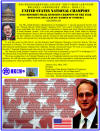 USA Small Business Administration (SBA)
Selected Johnson Choi/HKCHcc
2008 United States
National Champion
USA Small Business Administration (SBA)
Selected Johnson Choi/HKCHcc
2008 United States
National Champion![]()
![]() and follow us
on
and follow us
on
![]()

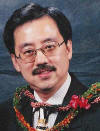
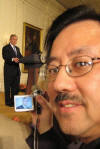
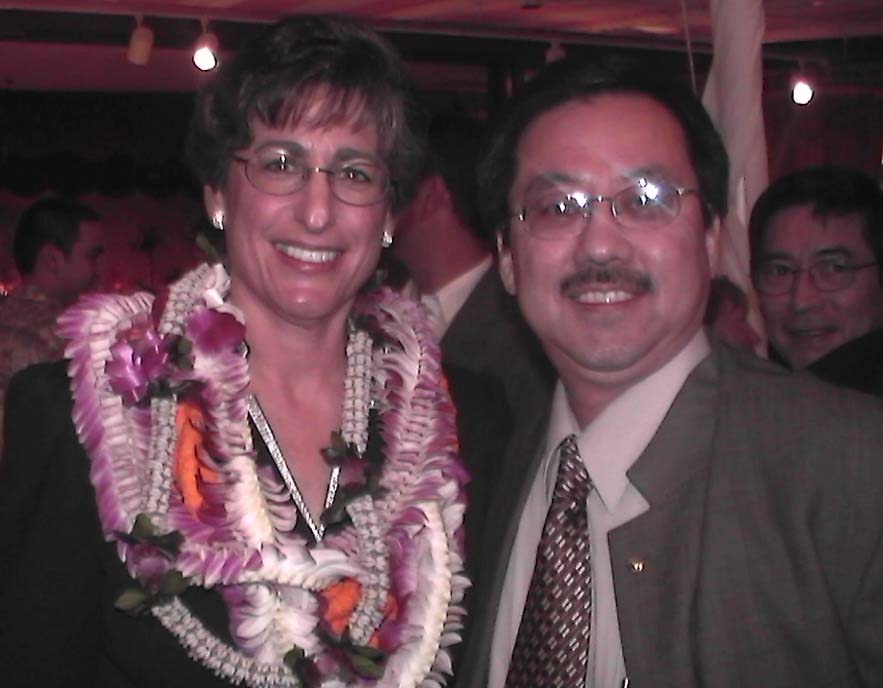
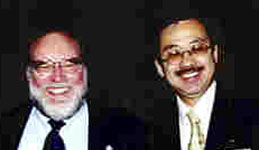

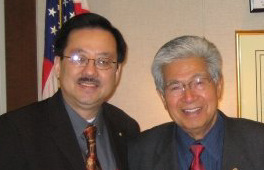


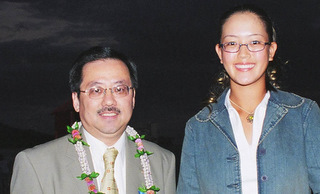
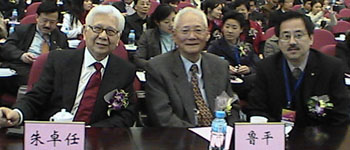




















 AmCham Shanghai launches latest Viewpoint - U.S. Export
Competitiveness in China - on the 2010 Washington, D.C. Doorknock - Please
download report in PDF format:
AmCham Shanghai launches latest Viewpoint - U.S. Export
Competitiveness in China - on the 2010 Washington, D.C. Doorknock - Please
download report in PDF format:

 USCBC Special Report: Hu Jintao State Visit
USCBC Special Report: Hu Jintao State Visit































 The China Greentech Initiative
(CGTI)
The China Greentech Initiative
(CGTI) 







 Lee Kai-fu at the release of his book Weibo Changes Everything in Beijing in February.
Lee Kai-fu at the release of his book Weibo Changes Everything in Beijing in February. 
 Increasing renminbi trade settlements should lead to higher demand for related financial transactions
Increasing renminbi trade settlements should lead to higher demand for related financial transactions  Jing Ulrich: Renminbi to Appreciate 5% in Both 2011 and 2012
Jing Ulrich: Renminbi to Appreciate 5% in Both 2011 and 2012
 Mainland exporters can gain greater bargaining power in using the renminbi as a pricing currency
Mainland exporters can gain greater bargaining power in using the renminbi as a pricing currency Renminbi deposits in Hong Kong are still tiny but, through Hong Kong, the mainland currency can venture out into the world
Renminbi deposits in Hong Kong are still tiny but, through Hong Kong, the mainland currency can venture out into the world 



 China Vanke to invest in housing for elderly
By Peggy Sito
China Vanke to invest in housing for elderly
By Peggy Sito China to be world's top luxury market by 2015 By Minnie Chan
China to be world's top luxury market by 2015 By Minnie Chan  Retail giants square up for rich pickings in China
By James Sinclair
Retail giants square up for rich pickings in China
By James Sinclair A large billboard stands in the lobby of a Beijing training organization advertising various educational programs for high school students to study at overseas universities.
A large billboard stands in the lobby of a Beijing training organization advertising various educational programs for high school students to study at overseas universities.  "The average annual spending on a student's supplementary education for a college entrance exam surged from 2,000 to 3,000 yuan in 2000 to 15,000 yuan nowadays," said Yin Xiong, president of Juren Education Group. These training institutions all believe the market holds great promise.
"The average annual spending on a student's supplementary education for a college entrance exam surged from 2,000 to 3,000 yuan in 2000 to 15,000 yuan nowadays," said Yin Xiong, president of Juren Education Group. These training institutions all believe the market holds great promise. Look out, dollar. Watch it, yen. The yuan is going global By Ed Zhang in Beijing
Look out, dollar. Watch it, yen. The yuan is going global By Ed Zhang in Beijing 
 Duck de Chine is among several innovative Hong Kong-run ventures that are helping to redefine the Beijing dining scene. The 2008 Olympic Games sparked a culinary revolution that is still transforming the once-dull capital. Although Hong Kong restaurateurs are by no means the only ones introducing new concepts to Beijing, they operate some of the most high-profile venues.
Duck de Chine is among several innovative Hong Kong-run ventures that are helping to redefine the Beijing dining scene. The 2008 Olympic Games sparked a culinary revolution that is still transforming the once-dull capital. Although Hong Kong restaurateurs are by no means the only ones introducing new concepts to Beijing, they operate some of the most high-profile venues. "There are just so many more options these days in Beijing, upscale and international-inspired things," says the restaurant and bar manager of Opposite House, Milan Sekulic. "Investors are prepared to put more money into the design to give things a much more contemporary style. The whole feel of the city is becoming more international."
"There are just so many more options these days in Beijing, upscale and international-inspired things," says the restaurant and bar manager of Opposite House, Milan Sekulic. "Investors are prepared to put more money into the design to give things a much more contemporary style. The whole feel of the city is becoming more international." Duck de Chine is among several outlets that Elite runs in a converted machinery factory compound, now known as 1949 - The Hidden City. Diners enter the 60,000 sq ft complex via an art gallery, before making their way through a garden to the Japanese, Mediterranean and Peking duck restaurants. The compound also features a tiny noodle bar that seats just 12 people and, in summer, an outdoor bar.
Duck de Chine is among several outlets that Elite runs in a converted machinery factory compound, now known as 1949 - The Hidden City. Diners enter the 60,000 sq ft complex via an art gallery, before making their way through a garden to the Japanese, Mediterranean and Peking duck restaurants. The compound also features a tiny noodle bar that seats just 12 people and, in summer, an outdoor bar. But Morris, 25, who had studied in Beijing as part of her degree in Chinese studies at Cambridge University, figured there would be a market in the Chinese capital for properly made, prettily packaged cupcakes and relocated to launch her venture.
But Morris, 25, who had studied in Beijing as part of her degree in Chinese studies at Cambridge University, figured there would be a market in the Chinese capital for properly made, prettily packaged cupcakes and relocated to launch her venture. The United States will probably allow huge business opportunities to go to European Union (EU) countries and Japan if it refuses to rescind controls on exports to China as soon as possible, according to Chinese government officials. The comments came at a monthly forum on China-US Economic Relations held by the China Center for International Economic Exchanges (CCIEE) - a high-level business thinktank - on Wednesday.
The United States will probably allow huge business opportunities to go to European Union (EU) countries and Japan if it refuses to rescind controls on exports to China as soon as possible, according to Chinese government officials. The comments came at a monthly forum on China-US Economic Relations held by the China Center for International Economic Exchanges (CCIEE) - a high-level business thinktank - on Wednesday. Hong Kong has been ranked the world’s most
globalized economy in the latest Globalization Index survey by Ernst & Young
Hong Kong has been ranked the world’s most
globalized economy in the latest Globalization Index survey by Ernst & Young Hong Kong’s rule of law, transparency and availability of talent make it an especially attractive base
Hong Kong’s rule of law, transparency and availability of talent make it an especially attractive base Experts discuss the merits of doing business in Hong Kong at the unveiling of the Globalization Index survey
Experts discuss the merits of doing business in Hong Kong at the unveiling of the Globalization Index survey Skype introduces its voice over Internet protocol (VoIP) telephone services on a telecommunication products fair in Nanjing, Jiangsu. Since 2005, Chinese authorities have permitted only China Telecom and China Netcom to operate pilot VoIP services in four cities.
Skype introduces its voice over Internet protocol (VoIP) telephone services on a telecommunication products fair in Nanjing, Jiangsu. Since 2005, Chinese authorities have permitted only China Telecom and China Netcom to operate pilot VoIP services in four cities.
 Traditional Chinese medicine cosmetics have a history of 1,600 years but have only recently started to compete with modern international brands.
Traditional Chinese medicine cosmetics have a history of 1,600 years but have only recently started to compete with modern international brands.  But people like Lu are increasingly turning to traditional Chinese medicine (TCM) cosmetics to sort out their skincare problems, moving away from Western beauty products.
But people like Lu are increasingly turning to traditional Chinese medicine (TCM) cosmetics to sort out their skincare problems, moving away from Western beauty products. The mainland consumer market
is rapidly developing, with short product cycles and fast-changing consumer
preferences
The mainland consumer market
is rapidly developing, with short product cycles and fast-changing consumer
preferences Chinese mainland consumers
are accustomed to buying daily necessities and food from nearby supermarkets and
convenience stores
Chinese mainland consumers
are accustomed to buying daily necessities and food from nearby supermarkets and
convenience stores  International brands have
established their presence in first-tier Chinese mainland cities, making second
and third-tier cities ideal for new brands
International brands have
established their presence in first-tier Chinese mainland cities, making second
and third-tier cities ideal for new brands Track-laying work for the long-anticipated Beijing-Shanghai high-speed railway
stood complete when Railways Minister Liu Zhijun tightened the line's last bolt
on a windy Monday morning. "The project has entered its last stage," Lu Chunfang,
vice-minister of railways, said at a ceremony to celebrate the latest success in
the city of Bengbu, situated in the center of the railway line. Since the
project kicked off on April 18, 2008, some 135,000 workers have toiled hard to
lay 1,318 km of high-quality tracks.
Track-laying work for the long-anticipated Beijing-Shanghai high-speed railway
stood complete when Railways Minister Liu Zhijun tightened the line's last bolt
on a windy Monday morning. "The project has entered its last stage," Lu Chunfang,
vice-minister of railways, said at a ceremony to celebrate the latest success in
the city of Bengbu, situated in the center of the railway line. Since the
project kicked off on April 18, 2008, some 135,000 workers have toiled hard to
lay 1,318 km of high-quality tracks. In the next few months, workers
will race against time to install the railway's power supply, communications and
signal systems, and carry out operation trials to test the line and trains to
ensure the railway can open to traffic next year, Wang Yongping, spokesman of
the Ministry of Railways, said.
In the next few months, workers
will race against time to install the railway's power supply, communications and
signal systems, and carry out operation trials to test the line and trains to
ensure the railway can open to traffic next year, Wang Yongping, spokesman of
the Ministry of Railways, said.
 Tom chief executive Ken Yeung Kwok-mung
said many mainland manufacturers and merchants were looking for more than just a
pure information exchange type of e-commerce platform.
Tom chief executive Ken Yeung Kwok-mung
said many mainland manufacturers and merchants were looking for more than just a
pure information exchange type of e-commerce platform. New
York-based designer Phillip Lim compares his years in fashion to dog years: one
year feels like seven. "It's been such a fast ride I didn't even realise it was
our anniversary," he says, when I remark upon his eponymous label's fifth
birthday. "Yet at the same time it's so intense, I feel like I've been doing
this forever."
New
York-based designer Phillip Lim compares his years in fashion to dog years: one
year feels like seven. "It's been such a fast ride I didn't even realise it was
our anniversary," he says, when I remark upon his eponymous label's fifth
birthday. "Yet at the same time it's so intense, I feel like I've been doing
this forever." A scene from Victoria
Tang's film for Phillip Lim.
A scene from Victoria
Tang's film for Phillip Lim. These clothes are now available in
50 countries worldwide, and his fashion show in the Chinese capital will expand
his exposure beyond the fashionable few who can buy his designs at Lane Crawford
Beijing.
These clothes are now available in
50 countries worldwide, and his fashion show in the Chinese capital will expand
his exposure beyond the fashionable few who can buy his designs at Lane Crawford
Beijing. Chinese mainland authorities recently
announced tighter regulations on foreign representative offices on the mainland
Chinese mainland authorities recently
announced tighter regulations on foreign representative offices on the mainland

 Large, successful players
have moved on from ROs to access the Chinese mainland market
Large, successful players
have moved on from ROs to access the Chinese mainland market  Many foreign firms prefer to go straight
to becoming revenue-handling entities
Many foreign firms prefer to go straight
to becoming revenue-handling entities  China may overtake Japan as the world's second-largest economy this
year, but it remains a developing economy despite its fast pace of growth,
economists said.
China may overtake Japan as the world's second-largest economy this
year, but it remains a developing economy despite its fast pace of growth,
economists said. In 2009, China reported a per capita GDP
of $3,687, as compared to $37,800 for Japan and $46,436 for the US. China ranked
103th worldwide in terms of per capita GDP, according to the World Bank.
In 2009, China reported a per capita GDP
of $3,687, as compared to $37,800 for Japan and $46,436 for the US. China ranked
103th worldwide in terms of per capita GDP, according to the World Bank. None of them gets it exactly right,
argues Massachusetts Institute of Technology political science professor Edward
Steinfeld.
None of them gets it exactly right,
argues Massachusetts Institute of Technology political science professor Edward
Steinfeld. Mainlanders hold a giant
national flag ahead of a flag-raising ceremony in Chongqing . The country has
undergone huge change in the past 20 years as it has opened up to the West and
undertaken massive economic reforms.
Mainlanders hold a giant
national flag ahead of a flag-raising ceremony in Chongqing . The country has
undergone huge change in the past 20 years as it has opened up to the West and
undertaken massive economic reforms. Fireworks during the opening
of the Beijing Olympics, the encouragement of consumerism and the development of
infrastructure to cope with massive trade growth have all contributed to
changing the nation.
Fireworks during the opening
of the Beijing Olympics, the encouragement of consumerism and the development of
infrastructure to cope with massive trade growth have all contributed to
changing the nation. The Governor of the People's Bank of
China (PBC) Yi Gang recently mentioned that China had overtaken Japan to become
the world's second largest economy. Some UK researchers believe that at current
GDP growth rates, China will overtake the U.S. to be the world's top economy
within nine years. The forecasts sparked heated debate worldwide. Some people
think the figures are faked and do not take the forecasts seriously; others
agree that, sooner or later, China will become the world's biggest economic
power.
The Governor of the People's Bank of
China (PBC) Yi Gang recently mentioned that China had overtaken Japan to become
the world's second largest economy. Some UK researchers believe that at current
GDP growth rates, China will overtake the U.S. to be the world's top economy
within nine years. The forecasts sparked heated debate worldwide. Some people
think the figures are faked and do not take the forecasts seriously; others
agree that, sooner or later, China will become the world's biggest economic
power. The author, Yi Xianrong is the director
of the Finance Institute at the Chinese Academy of Social Sciences (CASS).
The author, Yi Xianrong is the director
of the Finance Institute at the Chinese Academy of Social Sciences (CASS). AmCham Shanghai launches 2010 World Expo
Business Series and AmCham Expo Website - AmCham Shanghai is pleased to
announce the AmCham Shanghai 2010 World Expo Business Series, bringing Expo
business opportunities to our members while facilitating the entry of new
businesses to China. The AmCham Shanghai 2010 World Expo Business Series is
supported by the U.S. Foreign Commercial Service, the China Council for the
Promotion of International Trade and the Shanghai Foreign Investment Development
Board. Confirmed speakers include Jeffrey Immelt, chairman and CEO of GE, Dr.
George Buckley,chairman and CEO of 3M and Tom Donohue, president and CEO of the
U.S. Chamber of Commerce. Visit the new AmCham Shanghai Expo site at
AmCham Shanghai launches 2010 World Expo
Business Series and AmCham Expo Website - AmCham Shanghai is pleased to
announce the AmCham Shanghai 2010 World Expo Business Series, bringing Expo
business opportunities to our members while facilitating the entry of new
businesses to China. The AmCham Shanghai 2010 World Expo Business Series is
supported by the U.S. Foreign Commercial Service, the China Council for the
Promotion of International Trade and the Shanghai Foreign Investment Development
Board. Confirmed speakers include Jeffrey Immelt, chairman and CEO of GE, Dr.
George Buckley,chairman and CEO of 3M and Tom Donohue, president and CEO of the
U.S. Chamber of Commerce. Visit the new AmCham Shanghai Expo site at
 Download Power Point Presentation
of the Hangzhou's "Impression Xihu" Produced by Mr. Zhang Yimou who among
producing award winning films worldwide for the past 2 decades, he was the
director for the opening and closing ceremony of the Beijing Olympics 2009
影像西湖
-
張藝謀太厲害了
Download Power Point Presentation
of the Hangzhou's "Impression Xihu" Produced by Mr. Zhang Yimou who among
producing award winning films worldwide for the past 2 decades, he was the
director for the opening and closing ceremony of the Beijing Olympics 2009
影像西湖
-
張藝謀太厲害了
 10-year plan to turn Hainan "aka
Hawaii of Asia" into tourism hub By Toh Han Shih
10-year plan to turn Hainan "aka
Hawaii of Asia" into tourism hub By Toh Han Shih
 Water town awash with sights - Catch the
watery views at Zhouzhuang, only 50 kilometers from Shanghai
Water town awash with sights - Catch the
watery views at Zhouzhuang, only 50 kilometers from Shanghai Representatives from 24 U.S.
businesses in the clean-energy sector visited China in May 2010 and participated
in the administration’s first cabinet-level business development mission, led by
Secretary of Commerce Gary Locke. They experienced firsthand the many
opportunities—and numerous challenges—that await them in this burgeoning market.
Representatives from 24 U.S.
businesses in the clean-energy sector visited China in May 2010 and participated
in the administration’s first cabinet-level business development mission, led by
Secretary of Commerce Gary Locke. They experienced firsthand the many
opportunities—and numerous challenges—that await them in this burgeoning market. Aside from its focus on clean energy,
the visit to China by Secretary Locke was an occasion to mark significant
achievements in two other areas of U.S.–Chinese commercial relations. In Hong
Kong on May 17, Locke and Rita Lau, Hong Kong secretary of commerce and economic
development, signed a memorandum of understanding that supports the marketing
and promotion of wine from both countries. The memorandum follows the 2008
elimination of Hong Kong’s excise tax on wine.
Aside from its focus on clean energy,
the visit to China by Secretary Locke was an occasion to mark significant
achievements in two other areas of U.S.–Chinese commercial relations. In Hong
Kong on May 17, Locke and Rita Lau, Hong Kong secretary of commerce and economic
development, signed a memorandum of understanding that supports the marketing
and promotion of wine from both countries. The memorandum follows the 2008
elimination of Hong Kong’s excise tax on wine. Shanghai must-sees
- If planning a visit to the World Expo, let a prominent resident show you
around its fascinating host city By Susan Jung
Shanghai must-sees
- If planning a visit to the World Expo, let a prominent resident show you
around its fascinating host city By Susan Jung
 US Commerce Secretary Gary Locke
speaks during a ceremony to present the US Department of Commerce's Certificate
of Appreciation to Shanghai Tower Construction & Development Co., Ltd. in
Shanghai May 18, 2010.
US Commerce Secretary Gary Locke
speaks during a ceremony to present the US Department of Commerce's Certificate
of Appreciation to Shanghai Tower Construction & Development Co., Ltd. in
Shanghai May 18, 2010. Crowds of shoppers in Nanjing
Street, Shanghai. Many foreign companies now have little choice but to enter
China as it emerges as the world's key market in the 21st century.
Crowds of shoppers in Nanjing
Street, Shanghai. Many foreign companies now have little choice but to enter
China as it emerges as the world's key market in the 21st century. Edward Tse, chairman of global management
consultants Booz & Co in China, said the great majority of the companies he
deals with regard China as the most important market in the world.
Edward Tse, chairman of global management
consultants Booz & Co in China, said the great majority of the companies he
deals with regard China as the most important market in the world.  Mandarin for a Global Edge - Chinese Language Initiative
Mandarin for a Global Edge - Chinese Language Initiative Chinese language
instruction is exploding in American public schools. In this exclusive Asia
Society video, teachers and politicians explain why studying Mandarin gives kids
a global edge.
Chinese language
instruction is exploding in American public schools. In this exclusive Asia
Society video, teachers and politicians explain why studying Mandarin gives kids
a global edge.
 A recovery in the
export sector is part of the thinking behind the mainland’s stimulus plan
A recovery in the
export sector is part of the thinking behind the mainland’s stimulus plan
 Dr Stephen Roach,
Morgan Stanley Asia Chairman, doubts the mainland’s stimulus package alone can
resolve deeper macroeconomic issues
Dr Stephen Roach,
Morgan Stanley Asia Chairman, doubts the mainland’s stimulus package alone can
resolve deeper macroeconomic issues The mainland is under
international pressure to revalue the renminbi
The mainland is under
international pressure to revalue the renminbi  Sir David Brewer,
Chairman of the China-Britain Business Council, says UK companies are looking
for mainland investment opportunities
Sir David Brewer,
Chairman of the China-Britain Business Council, says UK companies are looking
for mainland investment opportunities Parkson positions itself in the
mid-price market.
Parkson positions itself in the
mid-price market.






 June 16 2009 - Rupert Hoogewerf:
Counting China’s Millionaires
June 16 2009 - Rupert Hoogewerf:
Counting China’s Millionaires



 The Dazhongli project, which property developers describe as Shanghai's
"premium" sector, is where Hong Kong's HKR International and Swire Properties
plan to create a classy leisure and shopping complex amid the relocation of a
historic landmark, belonging to the former Minli Middle School.
The Dazhongli project, which property developers describe as Shanghai's
"premium" sector, is where Hong Kong's HKR International and Swire Properties
plan to create a classy leisure and shopping complex amid the relocation of a
historic landmark, belonging to the former Minli Middle School. Just over two years ago, Wuhan's first
high-end supermarket opened with little fanfare. Zhongbai Warehouse Supermarket,
a local retail operator, decided its new Life in Theatre outlet would bring in
the right kind of discerning shopper. So it opened next to the New World
Department Store on salubrious Jiefang Road.
Just over two years ago, Wuhan's first
high-end supermarket opened with little fanfare. Zhongbai Warehouse Supermarket,
a local retail operator, decided its new Life in Theatre outlet would bring in
the right kind of discerning shopper. So it opened next to the New World
Department Store on salubrious Jiefang Road. The store mainly deals in imported and
high-end specialty foods and other items. Australian T-bone steaks, smoked
mackerel, limited edition Maotai wine and all kinds of imported cheeses abound.
The store mainly deals in imported and
high-end specialty foods and other items. Australian T-bone steaks, smoked
mackerel, limited edition Maotai wine and all kinds of imported cheeses abound. Life in Theatre is actually selling not
just high-end merchandise, but lifestyle.
Life in Theatre is actually selling not
just high-end merchandise, but lifestyle. Students at the Institute for Tourism Studies
in Macau take courses in tourism and hospitality with degree-level programs
available to meet industry demand for skilled managers.
Students at the Institute for Tourism Studies
in Macau take courses in tourism and hospitality with degree-level programs
available to meet industry demand for skilled managers. A
student receives professional training from an executive chef at the IFT.
A
student receives professional training from an executive chef at the IFT.
 China turns to be a hotspot
for hotels' expansion
China turns to be a hotspot
for hotels' expansion









 Yachting sails
into Zhejiang on winds of the US subprime - Voyaging into the Hangzhou market.
Yachting sails
into Zhejiang on winds of the US subprime - Voyaging into the Hangzhou market.
 Creative
Shanghai gets global attention - Brand development advances.
Creative
Shanghai gets global attention - Brand development advances. Mainland maternity boom begets "baby
brands" - Young mothers keep in training.
Mainland maternity boom begets "baby
brands" - Young mothers keep in training. 
 Emerging-market infrastructure shines - Growing middle class in developing
countries drives demand for transport, telecoms
Emerging-market infrastructure shines - Growing middle class in developing
countries drives demand for transport, telecoms A call
for celebration By Joan Chen
A call
for celebration By Joan Chen Settling matters through arbitration
Settling matters through arbitration



 Environmentally-friendly bags to
generate sales - "Bring your own" more common.
Environmentally-friendly bags to
generate sales - "Bring your own" more common. Outbound tourism sector to open
wider
Outbound tourism sector to open
wider